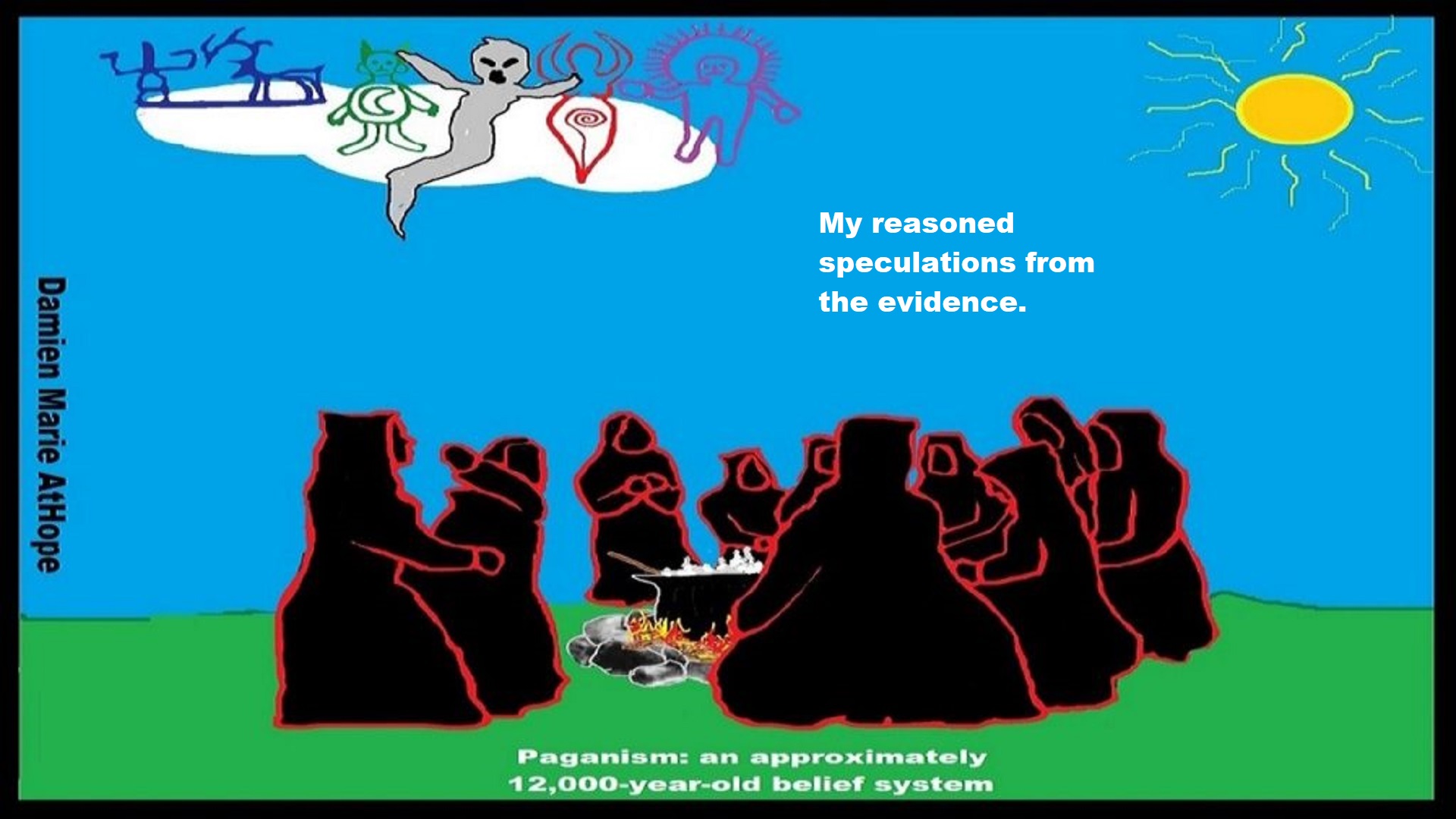Paganism 12,000-4,000 years old
12,000-7,000 years old: related to (Pre-Capitalism)
7,000-5,000 years old: related to (Capitalism) (World War 0) Elite and their slaves!
5,000 years old: related to (Kings and the Rise of the State)
4,000 years old: related to (First Moralistic gods, then the Origin time of Monotheism)
To me, Siberian Shamanism (related to the Ancient North Eurasians and the Mal’ta–Buret’ culture) comes to the Middle East, then in Turkey around the time of agricultural emergence, I think by 12,000 years ago, they had animal Tutelary Deities (A tutelary can be either a deity or a spirit who is a guardian, patron, or protector of a particular place, geographic feature, person, lineage, nation, culture, or occupation). ref
“Gods and goddesses who are often depicted as being animals, having partially animalistic features, or are at least commonly associated with particular wild or domestic animals.” ref
Then I think new religious ideas came in related to Epigravettians and then I think around 11,000/10,000 years ago it influenced the ideas of Female Goddesses (think of the self-created or self-existing single Mesopotamian goddess Nammu who was the creator of everything and all first deities or those she birthed deities aided in the creation of everything).
I also think there may have been an early (8,000/7,000 years ago) Deity Trinity involving a Sky Father commonly sun god and Earth Mother goddess along with a Bird deity of some kind. I think it is likely similar to how the inhabitants of “Hemudu (5500 to 3300 BCE or around 7,500 to 5,300 years ago Neolithic China) that worshiped a sun spirit as well as a fertility spirit. They also enacted shamanistic rituals to the sun and believed in bird totems. A belief in an afterlife and ghosts is thought to have been widespread as well.” ref
“Nammu also read Namma was a Mesopotamian goddess regarded as a creator deity in the local theology of Eridu. It is assumed that she was associated with water. She is also well-attested in connection with incantations and apotropaic magic. She was regarded as the mother of Enki, and in a single inscription she appears as the wife of Anu, but it is assumed that she usually was not believed to have a spouse.” ref
“The Sumerians believed that the universe had come into being through a series of cosmic births such as gods. First, Nammu, the primeval waters, gave birth to Ki (the earth) and An (the sky), who mated together and produced a son named Enlil. Enlil separated heaven from earth and claimed the earth as his domain. Humans were believed to have been created by AnKi or Enki, the son of the An and Ki. Heaven was reserved exclusively for deities and, upon their deaths, all mortals’ spirits, regardless of their behavior while alive, were believed to go to Kur, a cold, dark cavern deep beneath the earth, which was ruled by the goddess Ereshkigal and where the only food available was dry dust.” ref
“In later times, Ereshkigal was believed to rule alongside her husband Nergal, the god of death. The major deities in the Sumerian pantheon included An, the god of the heavens, Enlil, the god of wind and storm, AnKi Enki, the god of water and human culture, Ninhursag, the goddess of fertility and the earth, Utu, the god of the sun and justice, and his father Nanna, the god of the moon. During the Akkadian Empire, Inanna, the goddess of sex, beauty, and warfare, was widely venerated across Sumer and appeared in many myths, including the famous story of her descent into the Underworld.” ref
“Sumerian religion heavily influenced the religious beliefs of later Mesopotamian peoples; elements of it are retained in the mythologies and religions of the Hurrians, Akkadians, Babylonians, Assyrians, and other Middle Eastern culture groups. Scholars of comparative mythology have noticed parallels between the stories of the ancient Sumerians and those recorded later in the early parts of the Hebrew Bible.” ref
- Sumerian Creator Being was a Female, not Male possibly around 6,000 years ago or more
- Sumerian Word for “Sky” or “Heaven” and “Goddess” or “God” May Connect to the Ghassulian Culture “Star”
- Sky Father/Sky Mother “High Gods” or similar gods/goddesses of the sky more loosely connected, seeming arcane mythology across the earth seen in Siberia, China, Europe, Native Americans/First Nations People and Mesopotamia, etc.
“Genealogy of Sumerian and Akkadian Gods from Ancient Iraq.” ref
Paganism (beginning around 12,000 years ago)
Paganism (such as that seen in Turkey: 12,000 years ago). Gobekli Tepe: “first human-made temple” around 12,000 years ago. Sedentism and the Creation of goddesses around 12,000 years ago as well as male gods after 7,000 years ago. Pagan-Shaman burial in Israel 12,000 years ago and 12,000 – 10,000 years old Paganistic-Shamanistic Art in a Remote Cave in Egypt. Skull Cult around 11,500 to 8,400 Years Ago and Catal Huyuk “first religious designed city” around 10,000 years ago.
Paganism is approximately a 12,000-year-old belief system and believe in spirit-filled life and/or afterlife that can be attached to or be expressed in things or objects and these objects can be used by special persons or in special rituals that can connect to spirit-filled life and/or afterlife and who are guided/supported by a goddess/god, goddesses/gods, magical beings, or supreme spirits. If you believe like this, regardless of your faith, you are a hidden paganist.
Around 12,000 years ago, in Turkey, the first evidence of paganism is Gobekli Tepe: “first human-made temple” and around 9,500 years ago, in Turkey, the second evidence of paganism is Catal Huyuk “first religious designed city”. In addition, early paganism is connected to Proto-Indo-European language and religion. Proto-Indo-European religion can be reconstructed with confidence that the gods and goddesses, myths, festivals, and form of rituals with invocations, prayers, and songs of praise make up the spoken element of religion. Much of this activity is connected to the natural and agricultural year or at least those are the easiest elements to reconstruct because nature does not change and because farmers are the most conservative members of society and are best able to keep the old ways.
The reconstruction of goddesses/gods characteristics may be different than what we think of and only evolved later to the characteristics we know of today. One such characteristic is how a deity’s gender may not be fixed, since they are often deified forces of nature, which tend to not have genders. There are at least 40 deities and the Goddesses that have been reconstructed are: *Pria, *Pleto, *Devi, *Perkunos, *Aeusos, and *Yama.
The reconstruction of myths can be connected to Proto-Indo-European culture/language and by additional research, many of these myths have since been confirmed including some areas that were not accessible to the early writers such as Latvian folk songs and Hittite hieroglyphic tablets. There are at least 28 myths and one of the most widely recognized myths of the Indo-Europeans is the myth, “Yama is killed by his brother Manu” and “the world is made from his body”. Some of the forms of this myth in various Indo-European languages are about the Creation Myth of the Indo-Europeans.
The reconstruction of rituals can be connected to Proto-Indo-European culture/language and is estimated to have been spoken as a single language from around 6,500 years ago. One of the earliest ritual is the construction of kurgans or mound graves as a part of a death ritual. kurgans were inspired by common ritual-mythological ideas. Kurgans are complex structures with internal chambers. Within the burial chamber at the heart of the kurgan, elite individuals were buried with grave goods and sacrificial offerings, sometimes including horses and chariots.
The speakers of Pre-Proto-Indo-European lived in Turkey and it associates the distribution of historical Indo-European languages with the expansion around 9,000 years ago, with a proposed homeland of Proto-Indo-European proper in the Balkans around 7,000 years ago. The Proto-Indo-European Religion seemingly stretches at least back around 6,000 years ago or likely much further back and I believe Paganism is possibly an approximately 12,000-year-old belief system.
The earliest kurgans date to 6,000 years ago and are connected to the Proto-Indo-European in the Caucasus. In fact, around 7,000 years ago, there appears to be pre-kurgan in Siberia. Around 7,000 to 2,500 years ago and beyond, kurgans were built with ancient traditions still active in Southern Siberia and Central Asia, which display the continuity of the archaic forming methods. Kurgan cultures are divided archaeologically into different sub-cultures such as Timber Grave, Pit Grave, Scythian, Sarmatian, Hunnish, and Kuman–Kipchak. Kurgans have been found from the Altay Mountains to the Caucasus, Ukraine, Romania, and Bulgaria. Around 5,000 years ago, kurgans were used in the Ukrainian and Russian flat unforested grasslands, and their use spread with migration into eastern, central, and northern Europe, Turkey, and beyond. ref, ref, ref, ref, ref, ref, ref, ref, ref, ref, ref, ref, & ref
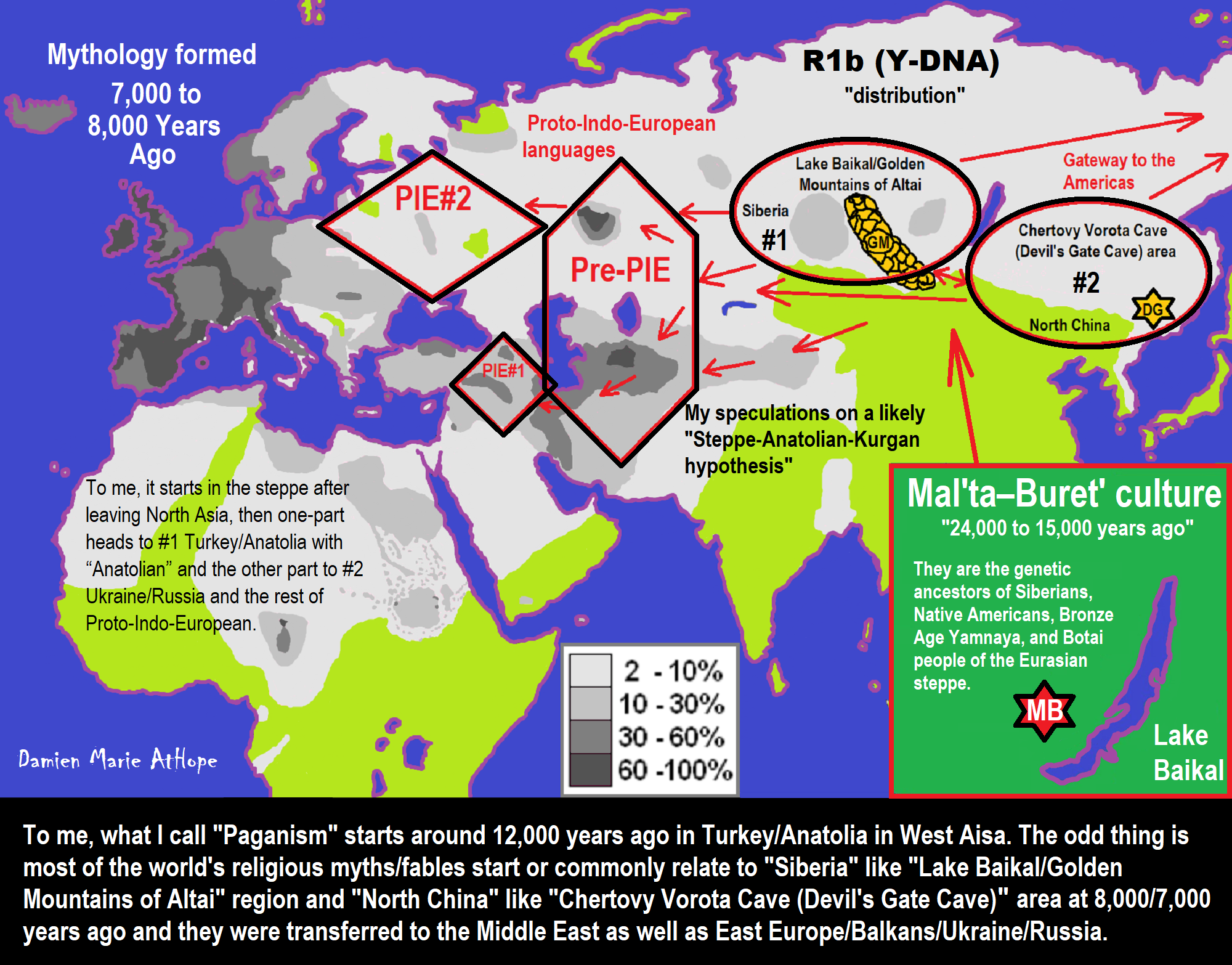
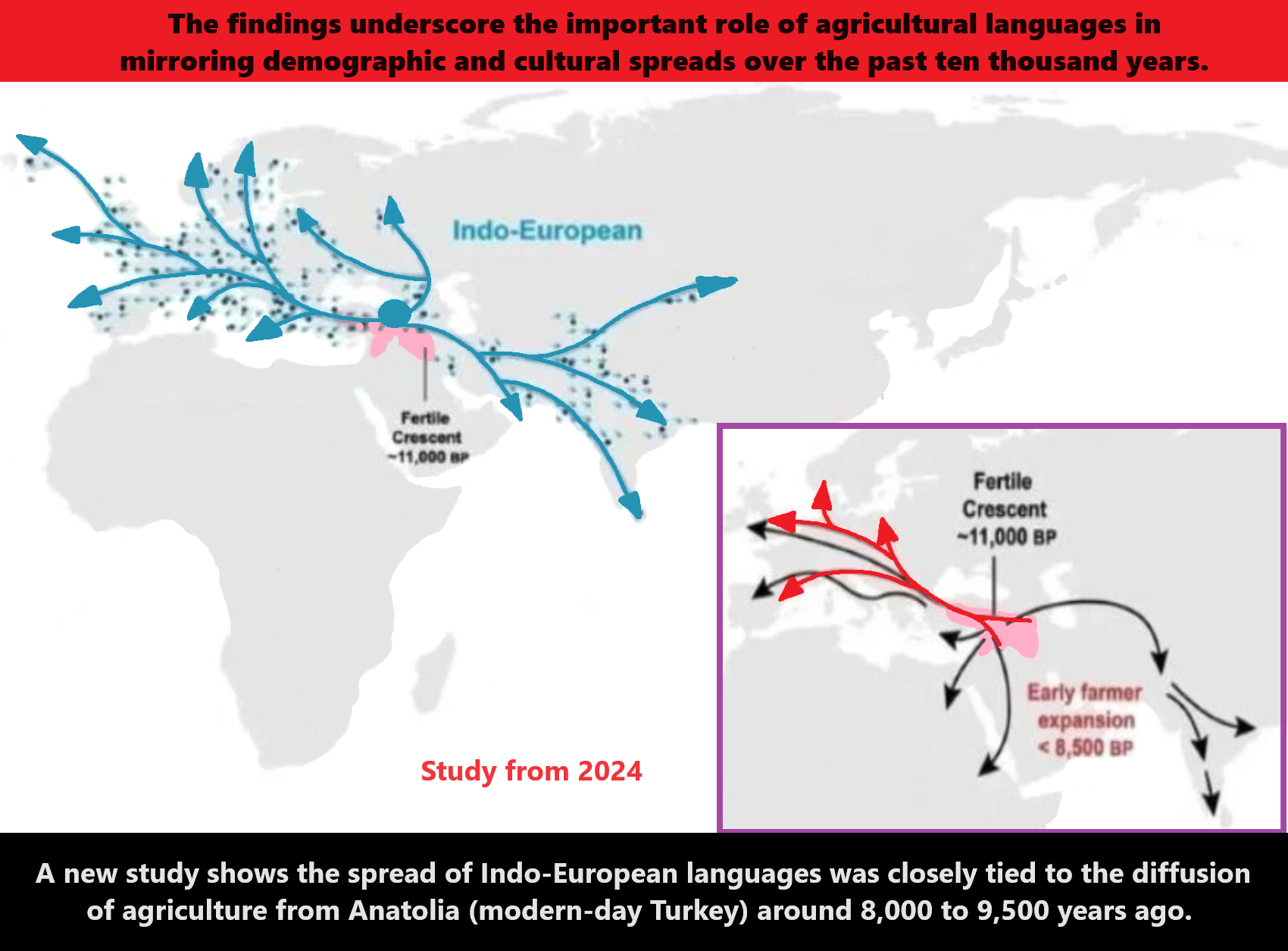
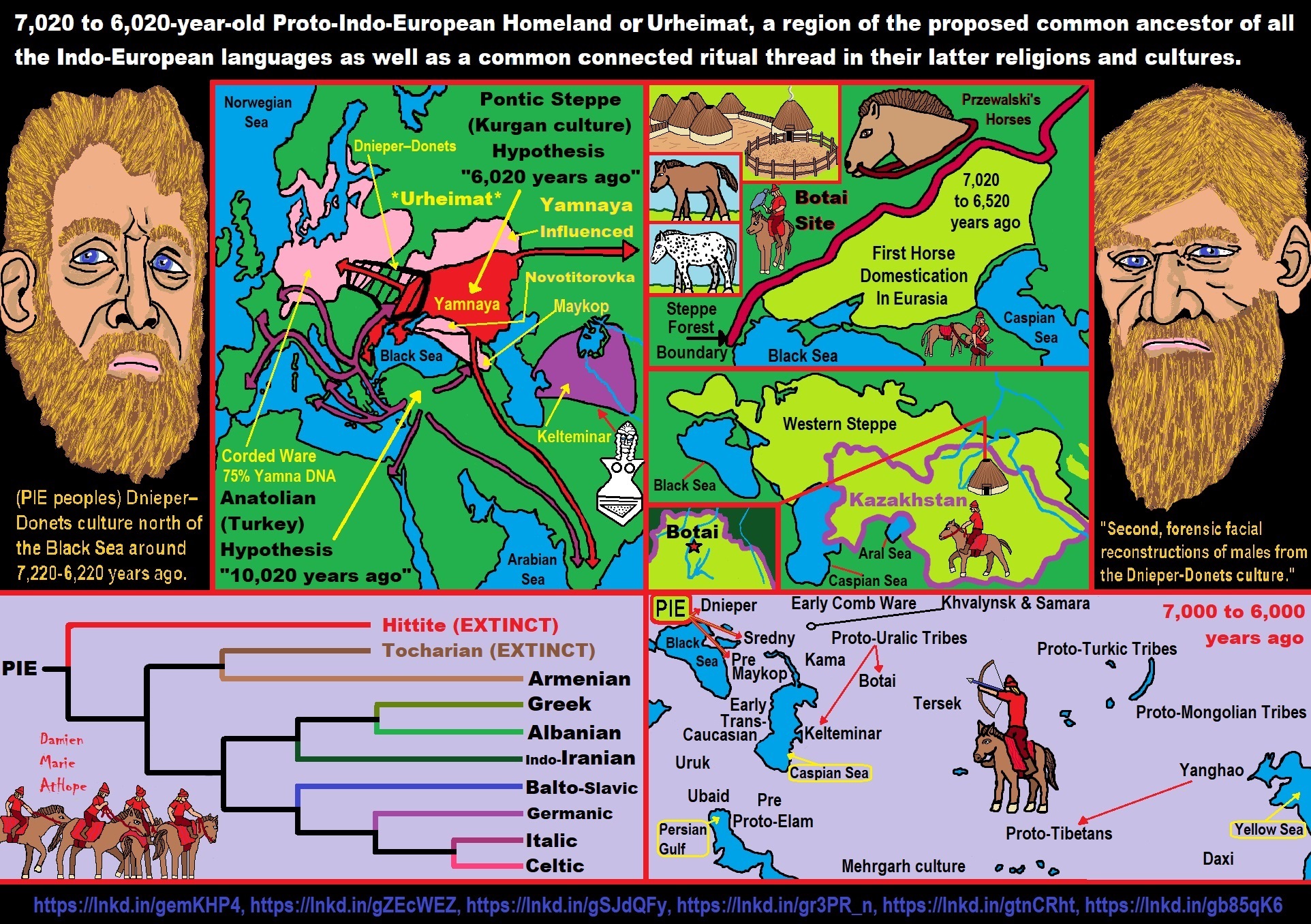
- My Thoughts on Possible Migrations of “R” DNA and Proto-Indo-European?
- Proto-Indo-European (PIE), ancestor of Indo-European languages: DNA, Society, Language, and Mythology
- Indo-European language Trees fit an Agricultural expansion from Anatolia beginning 8,000 – 9,500 years ago?
- 7,020 to 6,020-year-old Proto-Indo-European Homeland of Urheimat or proposed home of their Language and Religion
- Understanding Proto-Indo-Europeans and Paganism Religions
- Hell and Underworld mythologies starting maybe as far back as 7,000 to 5,000 years ago with the Proto-Indo-Europeans?
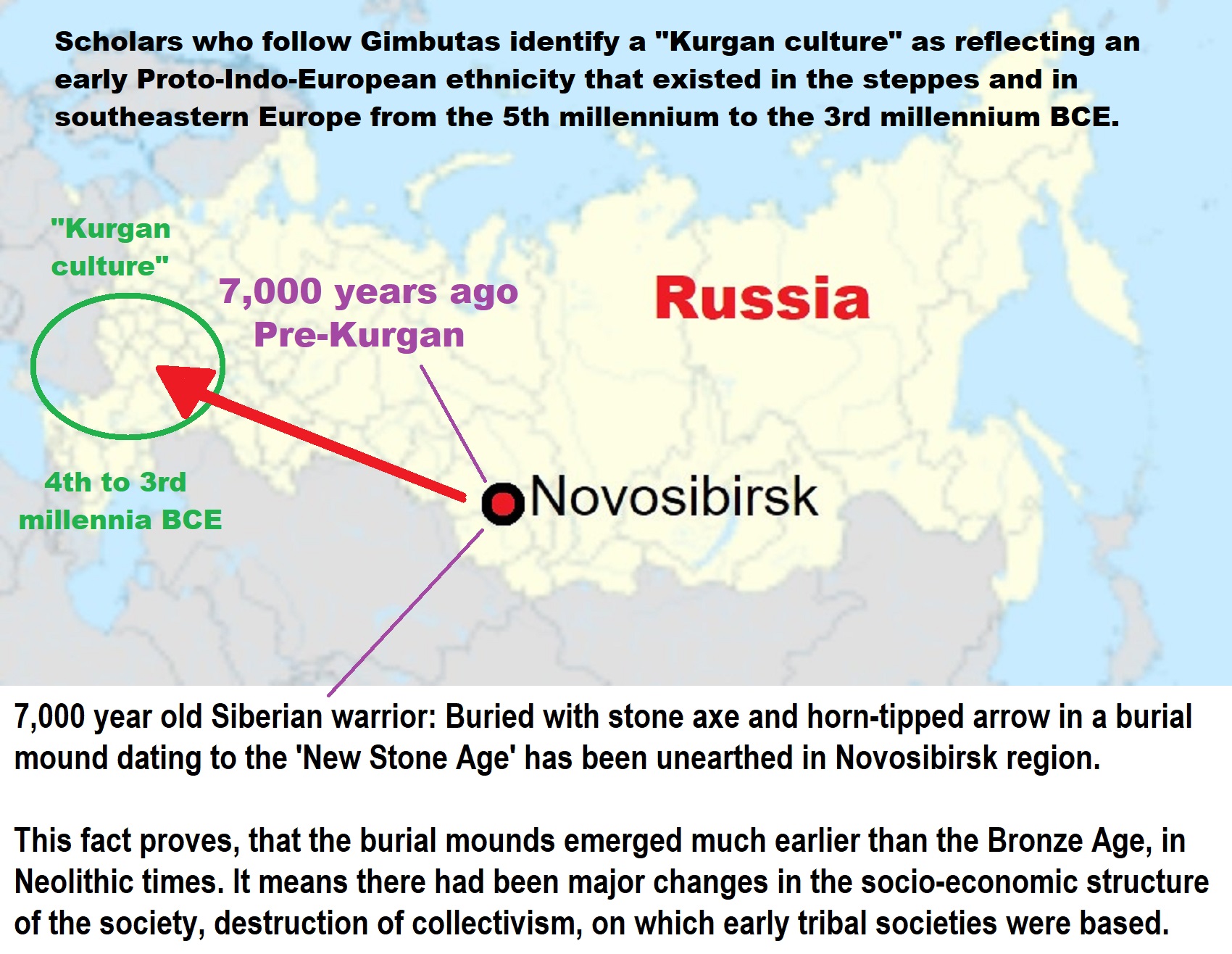
Kurgan Hypothesis
“The Kurgan hypothesis (also known as the Kurgan theory or Kurgan model) or Steppe theory is the most widely accepted proposal to identify the Proto-Indo-European homeland from which the Indo-European languages spread out throughout Europe and parts of Asia. It postulates that the people of a Kurgan culture in the Pontic steppe north of the Black Sea were the most likely speakers of the Proto-Indo-European language (PIE). The term is derived from the Russian kurgan (курга́н), meaning tumulus or burial mound. The Steppe theory was first formulated by Otto Schrader (1883) and V. Gordon Childe (1926), then systematized in the 1950s by Marija Gimbutas, who used the term to group various prehistoric cultures, including the Yamnaya (or Pit Grave) culture and its predecessors. In the 2000s, David Anthony instead used the core Yamnaya culture and its relationship with other cultures as a point of reference.” ref
“Gimbutas defined the Kurgan culture as composed of four successive periods, with the earliest (Kurgan I) including the Samara and Seroglazovo cultures of the Dnieper–Volga region in the Copper Age (early 4th millennium BCE). The people of these cultures were nomadic pastoralists, who, according to the model, by the early 3rd millennium BCE had expanded throughout the Pontic–Caspian steppe and into Eastern Europe. Recent genetics studies have demonstrated that populations bearing specific Y-DNA haplogroups and a distinct genetic signature expanded into Europe and South Asia from the Pontic-Caspian steppe during the third and second millennia BCE. These migrations provide a plausible explanation for the spread of at least some of the Indo-European languages, and suggest that the alternative Anatolian hypothesis, which places the Proto-Indo-European homeland in Neolithic Anatolia, is less likely to be correct.” ref
“Cultures that Gimbutas considered as part of the “Kurgan culture”:
- Bug–Dniester (6th millennium)
- Samara (5th millennium)
- Khvalynsk (5th millennium)
- Dnieper–Donets (5th to 4th millennia)
- Sredny Stog (mid-5th to mid-4th millennia)
- Maikop–Dereivka (mid-4th to mid-3rd millennia)
- Yamnaya (Pit Grave): This is itself a varied cultural horizon, spanning the entire Pontic–Caspian steppe from the mid-4th to the 3rd millennium.
- Usatovo culture (late 4th millennium)” ref
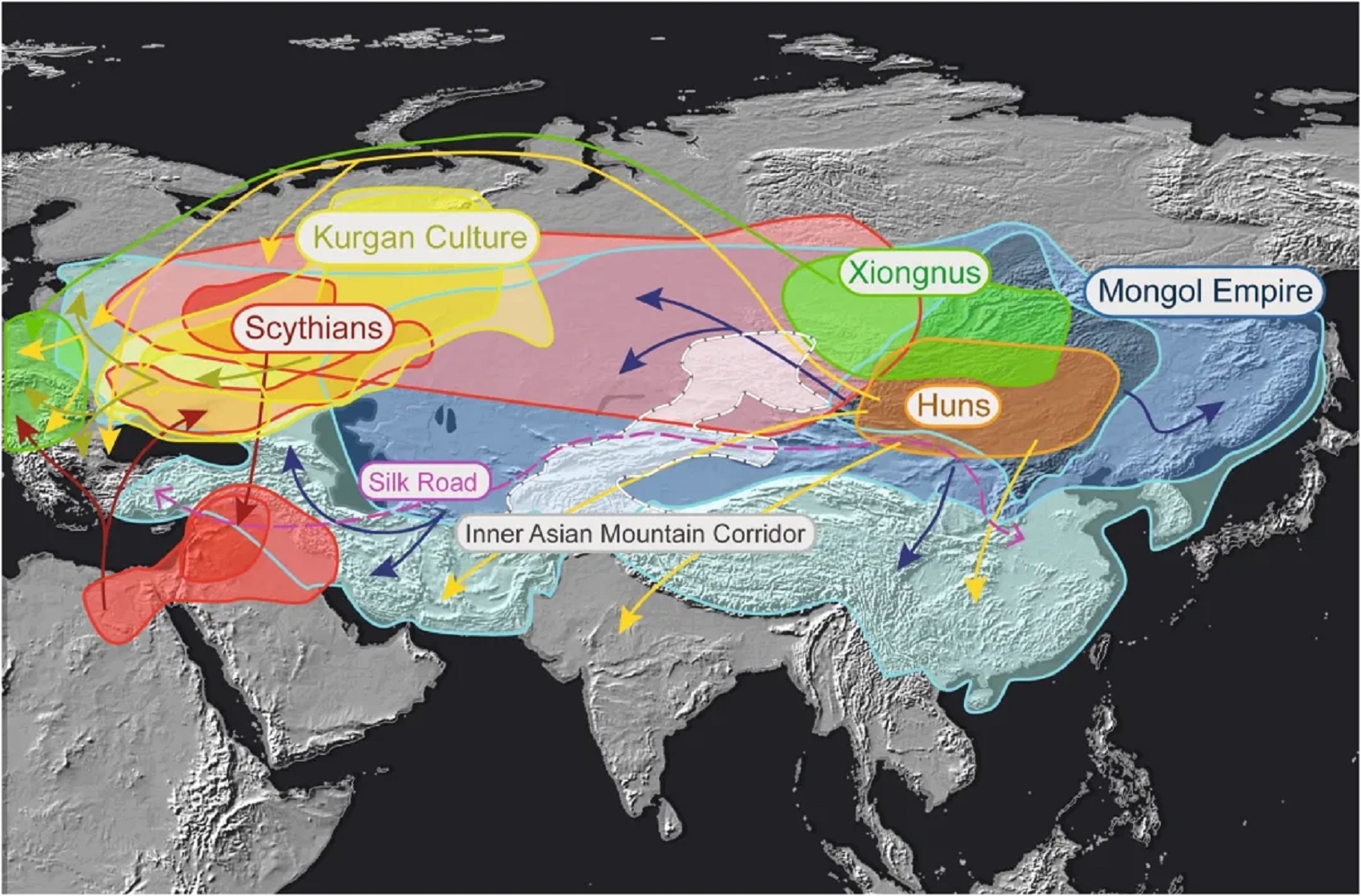
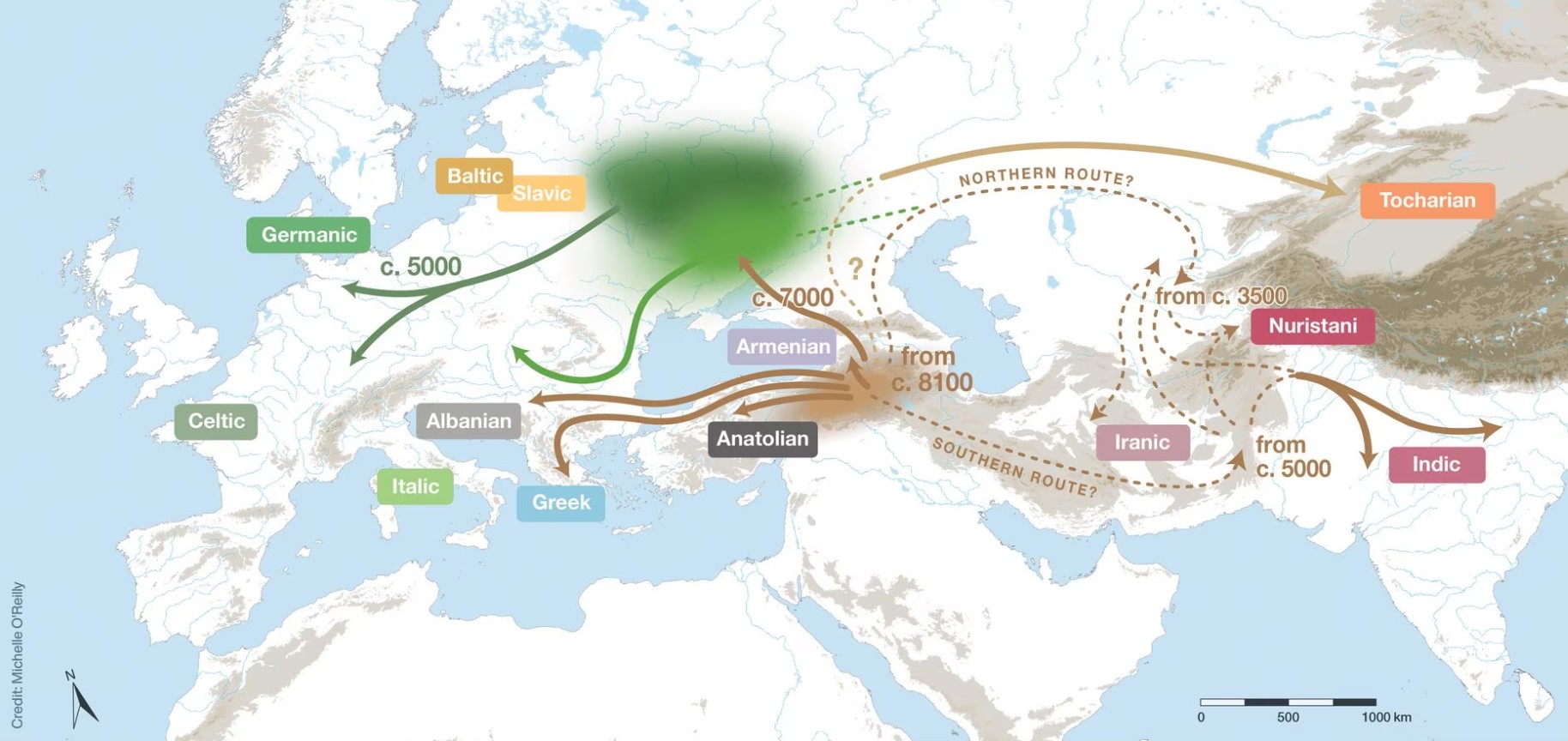
“Approximately 7,000 years ago, the Indo-European linguistic lineage had already split into numerous distinct branches, according to the study published in Science. “This would rule out the steppe hypothesis,” said Heggarty. Around 8,120 years ago, the Proto-Indo-European language likely experienced its initial diversification event, give or take a few centuries. Recent studies of ancient DNA suggest that farmers from the Caucasus region — between the Black Sea and Caspian Sea — migrated towards Anatolia, which supports the Anatolian theory. Hittite, an extinct language spoken by the Anatolian civilization, is another significant branch of the Indo-European family. For decades, a large group of linguists argued that Hittite was the common ancestor of the other Indo-European languages, with some even considering it to be the direct heir of Proto-Indo-European.” ref
“Ancient DNA, on the other hand, has provided compelling evidence in support of the steppe hypothesis. Since 2015, it has become clear that individuals originating from the Pontic steppe, situated to the south and northeast of present-day Russia, Ukraine, and Kazakhstan, migrated to Central Europe approximately 6,000 to 4,500 years ago. Their genetic legacy is evident in both modern Europeans and the indigenous populations of that era. Notably, studies conducted in 2018 and 2019 revealed how these migrant eastern populations replaced a significant proportion of males on the Iberian Peninsula. Furthermore, they brought with them Italic, Germanic, and Celtic languages. It is important to note that when they departed from their original homeland, they likely spoke a common or closely related language descended from Proto-Indo-European. However, as their very slow journey progressed (the Celts took centuries to reach present-day Ireland) and they settled in new territories, language diversification began to emerge.” ref
“The Albanians, Greek-speaking Mycenaeans, and Hittites do not have a dominant genetic signal from the steppe.” ref
Paul Heggarty, researcher at the Max Planck Institute for Evolutionary Anthropology in Germany.
“Heggarty’s team made a significant contribution by shedding light on this question. By combining phylogenetic analysis of cognates with insights from ancient DNA, they found potentially two distinct origins. Expansion initially originated from the southern Caucasus region, resulting in the separation of five major language families approximately 7,000 years ago. “The Albanians, Greek-speaking Mycenaeans and Hittites do not have a dominant genetic signal from the steppe,” said Heggarty. Several millennia later, another wave emerged, led by nomadic steppe herders from the north. This wave not only influenced the development of western branches of the language tree, but it also possibly played a role in the evolution of Slavic and Baltic languages. It even extended its influence to the Indian subcontinent, while giving rise to the now-extinct Tocharian languages in what is present-day Tibet.” ref
Paganism (such as that seen in Turkey: 12,000 years ago)
Haplogroup G2a (Y-chromosomal DNA) and the Seeming Development of Early Agriculture – “Haplogroup G descends from macro-haplogroup F, which is thought to represent the second major migration of Homo sapiens out of Africa, at least 60,000 years ago. Haplogroup G has 303 mutations confirming a severe bottleneck before splitting into haplogroups G1 and G2. G1might have originated around modern Iran around 26,000 years ago. G2 would have developed around the same time in West Asia and haplogroup G2 appear to have been closely linked to the development of early agriculture in the Fertile Crescent part, around 11,500 years before present. G2a branch expanded to Anatolia, the Caucasus, and Europe, while G2b diffused from Iran across the Fertile Crescent and east to Pakistan.
There has so far been ancient Y-DNA analysis from Early Neolithic Anatolia, Iran, Israel, Jordan as well as most Neolithic cultures in Europe (Thessalian Neolithic in Greece, Starčevo culture in Hungary/Croatia, LBK culture in Germany, Remedello in Italy, and Cardium Pottery in south-west France and Spain) and all sites yielded a majority of G2a individuals, except those from the Levant. This strongly suggests that farming was disseminated by members of haplogroup G at least from Anatolia/Iran then moved to Europe. 44 ancient Near Eastern samples, including Neolithic farmers from Jordan and western Iran, and found one G2b sample dating from the Pre-Pottery Neolithic (9,250 years ago) and a G2a1 from the Early Pottery Neolithic (7,700 years ago), both from Iran. The highest genetic diversity within haplogroup G is found in the northern part of the Fertile Crescent, between the Levant and the Caucasus, which is a good indicator of its region of origin.
Çatalhöyük in south-central Anatolia/Turkey was founded by farmers who also brought domesticated goats and sheep. Also around 8,500 years ago, G2a Neolithic farmers arrived in northwest Anatolia and Thessaly in central Greece, as attested by the ancient genomes around the time that it seems cattle domestication was introduced to Çatalhöyük and other sites in Central Anatolia, presumably by trading with their eastern neighbors. Ancient skeletons from the Starčevo–Kőrös–Criș culture (8,000-6,500 years ago) in Hungary and Croatia, and the Linear Pottery culture (7,500-6,500 years ago) in Hungary and Germany, all confirmed that G2a (both G2a2a and G2a2b) remained the principal paternal lineage even after farmers intermingled with indigenous populations as they advanced. G2a farmers from the Thessalian Neolithic quickly expanded across the Balkans and the Danubian basin, reaching Serbia, Hungary, and Romania by 7,800 years ago, Germany by 7,500 years ago, and Belgium and northern France by 7,200 years ago. By 7,800 years ago, farmers making cardial pottery arrived at the Marmara coast in northwest Anatolia with ovicaprids and pigs.
These people crossed the Aegean by boat and colonized the Italian peninsula, the Illyrian coast, southern France and Iberia, where they established the Cardium Pottery culture (5000-1500 BCE). Once again, ancient DNA yielded a majority of G2a samples in the Cardium Pottery culture, with G2a frequencies above 80% (against 50% in Central and Southeast Europe). Nevertheless, substantial minorities of other haplogroups have been found on different Neolithic sites next to a G2a majority, including C1a2, H2, I*, I2a1, I2c, and J2a in Anatolia, C1a2, E-M78, H2, I*, I1, I2a, I2a1, J2 and T1a in Southeast and Central Europe (Starčevo, Sopot, LBK), as well as E-V13, H2, I2a1, I2a2a1 and R1b-V88 in western Europe (Cardium Pottery, Megalithic). H2 and T1a were found in the Pre-Pottery Neolithic Levant and are undeniably linked to the early development of agriculture alongside G2a. That being said, C1a2 was also found in Mesolithic Spain and, as it is an extremely old lineage associated with the first Paleolithic Europeans, it could have been found all over Europe and Anatolia before the Neolithic. E1b1b was also found in the Pre-Pottery Neolithic Levant, but the subclades may not be E-M78 or E-V13 (more likely E1b1b1* or E-M123).
R1b-V88 surely spread from the Near East too, although through a different route, with cattle herders via North Africa, then crossing over to Iberia. The rest probably represent assimilated hunter-gatherers descended from Mesolithic western Anatolian (I*, I2c, J2) and Europeans (E-V13, I*, I1, I2a, I2a1, I2a2). It is interesting to note that many of these lineages, such as C1a2, H2 and I* are virtually extinct anywhere nowadays, and several others are now very rare in Europe (I2c, R1b-V88).” ref
Haplogroup J (mtDNA) and the Seeming Spread of Early Agriculture – “Samples have been identified from various Neolithic sites, including Linear Pottery culture (LBK) in Central Europe, the Cardium Pottery culture in southern France, Megalithic cultures in northern Spain, and the Funnelbeaker culture in Germany and Sweden. All Neolithic samples tested to date belonged to J1*, J1c or J2b1a. One question that follows is: did J1c and J2b1a lineages actually come from the Near East during the Neolithic, or whether they were already in the Balkans and just expanded from there? Both being rare in the Near East today, the second hypothesis might seem more convincing at first. However, the age of J2b1a has been estimated at 11,000 years before present, while the Neolithic started over 12,000 years ago in the Near East. In other words, it could have arrived from the Near East as J2b1* and developed into J2b1a only after reaching Europe, which would explain why this particular subclade is almost exclusively European while all other subclades of J2b1 are mostly Middle Eastern or the eastern Mediterranean. J2b1a would, therefore, have come as a maternal lineage of early agriculturalists alongside the paternal lineage G2a (and perhaps also E1b1b and T1a). J1c, however, is too old (15,000 years) for that scenario.
If it had been part of the Neolithic expansion from the Fertile Crescent, many J1c subclades would be primarily West Asian today, which isn’t the case. The only J1c individuals outside Europe belong to deep clades that clearly originated in Europe or in Anatolia. DNA of Early Neolithic farmers from western Anatolia and from the Starcevo culture in Hungary and Croatia, and found that J1c was present in both cultures, alongside other typical European Neolithic lineages like H5, K1a, N1a, T2, and X2. Of 44 ancient Near Eastern samples, including Neolithic farmers from Jordan and western Iran, and well as Chalcolithic and Bronze Age samples from Armenia and the Levant, but did not find any J1c, apart from a single sample in Neolithic Iran.
This suggests that J1c lineages were probably not found among the very first farmers of the Fertile Crescent but were rather assimilated in neighboring populations further north, notably in Anatolia and Iran, but probably also in the Balkans, which were connected to Anatolia by a land bridge during the glacial and immediate post-glacial periods. Haplogroup J has been found in Bronze Age samples from the Yamna culture (J2b), Corded Ware culture (J1c and J2b1a), the Catacomb culture (J1b1a1), the Unetice culture (J1b1a1), and the Urnfield culture (J1b1), all in Central Europe. The Corded Ware culture is associated with the expansion of Y-haplogroup R1a from the northern Russian steppe, and in light of the continuity with Neolithic samples from Central Europe it can be assumed that J1c and J2b1a maternal lineages were not brought by the newcomers, but absorbed by the male invaders. On the other hand, J1b has never been found in Europe before the Bronze Age and was very probably brought by the Indo-Europeans carrying R1b paternal lineages. Both the Unetice and the Urnfield cultures are thought to have been founded mainly by R1b men.” ref
- Gobekli Tepe: “first human-made temple” around 12,000 years ago.
- Sedentism and the Creation of goddesses around 12,000 years ago as well as male gods after 7,000 years ago.
- First Patriarchy: Split of Women’s Status around 12,000 years ago & First Hierarchy: fall of Women’s Status around 5,000 years ago.
- Natufians: an Ancient People at the Origins of Agriculture and Sedentary Life
- J DNA and the Spread of Agricultural Religion (paganism)
- Paganism: an approximately 12,000-year-old belief system
- Shaman burial in Israel 12,000 years ago and the Shamanism Phenomena
- Need to Mythicized: gods and goddesses
- “36cu0190” a Historic and Prehistoric site in Pennsylvania
- 12,000 – 10,000 years old Shamanistic Art in a Remote Cave in Egypt
- 12,000 – 7,000 Years Ago – Paleo-Indian Culture (The Americas)
- 12,000 – 2,000 Years Ago – Indigenous-Scandinavians (Nordic)
- Norse did not wear helmets with horns?
- Pre-Pottery Neolithic Skull Cult around 11,500 to 8,400 Years Ago?
- Catal Huyuk “first religious designed city”around 10,000 years ago
- 9,000-8500 year old Female shaman Bad Dürrenberg Germany
- Kurgan 6,000 years ago/dolmens 7,000 years ago: funeral, ritual, and other?
- Connected “dolmen phenomenon” of above-ground stone burial structures?
- Stars: Ancestors, Spirit Animals, and Deities (at least back to around 6,000 years ago)
- Evolution Of Science at least by 5,500 years ago
- 5,500 Years old birth of the State, the rise of Hierarchy, and the fall of Women’s status
- “Jiroft culture” 5,100 – 4,200 years ago and the History of Iran
Paganism is approximately a 12,000-year-old belief system and believe in spirit-filled life and/or afterlife that can be attached to or be expressed in things or objects and these objects can be used by special persons or in special rituals that can connect to spirit-filled life and/or afterlife and who are guided/supported by a goddess/god, goddesses/gods, magical beings, or supreme spirits. If you believe like this, regardless of your faith, you are a hidden paganist.
The speakers of Pre-Proto-Indo-European lived in Turkey and it associates the distribution of historical Indo-European languages with the expansion around 9,000 years ago, with a proposed homeland of Proto-Indo-European proper in the Balkans around 7,000 years ago. The Proto-Indo-European Religion seemingly stretches at least back around 6,000 years ago or likely much further back and I believe Paganism is possibly an approximately 12,000-year-old belief system.
At a mound is called Gadachrili Gora, and the Stone Age farmers who lived here 8,000 years ago were grape lovers: Their rough pottery is decorated with bunches of the fruit, and analysis of pollen from the site suggests the wooded hillsides nearby were once decked with grapevines. Combined with the grape decorations on the outside of the jars, ample grape pollen in the site’s fine soil, and radiocarbon dates from 7,800 to 8,000 years ago, the chemical analysis indicates the people at Gadachrili Gora were the world’s earliest winemakers. ref
Starting from 9,500 years ago, a new population began to settle the Balkans and the Danube valley. Evidence shows that the Neolithic newcomers mixed with the indigenous population in Lepenski Vir. Arriving from Asia Minor/Anatolia (modern-day Turkey), the immigrants had a completely different physical appearance and lifestyle. With them, they brought a knowledge of agriculture, first grain crops, and husbandry: sheep, cattle, and goats. Based on the research, Starović concluded that the blending of the population occurred almost immediately, during the first immigrant generation, which was unique as in the other parts of Europe two such different communities would live next to each other at first. He believes that this melting pot was a keystone of human development in Europe. It produced the boom of the Lepenski Vir culture, establishing the “original Balkan Neolithic, the most original occurrence in the entire prehistory in Europe, which founded all we know today – the concepts of village, square, family – which then spread over and overwhelmed the continent”. ref
The culture of Lepenski Vir is around 8,5 millennia old and is located on the right bank of the Danube in the Djerdap gorge (The Iron gates of the Danube) near the town of Donji Milanovac. It was the center of one of the most complex prehistoric cultures. Rich cultural layer reveals the traces of the highly developed culture that had complex social relations and as such was the first in Europe to organize its settlement according to a plan. Trapezoid-base houses with a primitive wooden construction which were organized in the shape of a horseshoe. The buildings surrounded an open space – the first known square, with the central building, probably some kind of a temple or a shrine. Fireplace surrounded by fishlike stone figurines took central place in every house. Stone idols found in Lepenski Vir represent the oldest monumental stone sculptures found in Europe. At first, they only had a head with a strange expression, while in later stages these figurines had anthropomorphic shapes. Besides these figurines, numerous tools and arms made of stone, bone, and antler, pottery and jewelry made of shells and pebbles were found here. Based on these pieces of evidence we can conclude that these first inhabitants of the Danube banks lived at the time of the so-called Neolithic revolution when the first communities started working the land and tamed some animals. The culture of Lepenski Vir developed in the period from 8,500 to 7,500 years ago. ref, ref
The main site consists of several archeological phases starting with Proto-Lepenski Vir, then Lepenski Vir Ia-e, Lepenski Vir II and Lepenski Vir III, whose occupation spanned from 1,500 to 2,000 years, from the Mesolithic to the Neolithic period, when it was succeeded by the Neolithic Vinča culture and Starčevo culture, both upstream the Danube, 135 km (84 mi) and 139 km (86 mi) from Lepenski Vir, respectively. The Vinca culture a Neolithic archaeological culture in Serbia and smaller parts of Romania (particularly Transylvania), dated to the period 7,700–8,500 or 7,300–6,700/6,500 years ago.
The Vinča culture occupied a region of Southeastern Europe (i.e. the Balkans) corresponding mainly to modern-day Serbia (with Kosovo), but also parts of Romania, Bulgaria, Bosnia, Montenegro, Republic of Macedonia, and Greece. This region had already been settled by farming societies of the First Temperate Neolithic, but during the Vinča period sustained population growth led to an unprecedented level of settlement size and density along with the population of areas that were bypassed by earlier settlers. it was thought, on the basis of typological similarities, that Vinča and other Neolithic cultures belonging to the ‘Dark Burnished Ware’ complex were the product of migrations from Anatolia to the Balkans but the Dark Burnished Ware complex appeared at least a millennium before Troy I, the putative starting point of the westward migration. An alternative hypothesis where the Vinča culture developed locally from the preceding Starčevo culture.
Named for its type site, Vinča-Belo Brdo, a large tell settlement. These settlements maintained a high degree of cultural uniformity through the long-distance exchange of ritual items but were probably not politically unified. Various styles of zoomorphic and anthropomorphic figurines are hallmarks of the culture, as are the Vinča symbols, which some conjecture to be the earliest form of proto-writing. Although not conventionally considered part of the Chalcolithic or “Copper Age”, the Vinča culture provides the earliest known example of copper metallurgy. A number of satellite villages belonging to the same culture and time period were discovered in the surrounding area. These additional sites include Hajdučka Vodenica, Padina, Vlasac, Ikaona, Kladovska Skela, and others. Found artifacts include tools made from stone and bones, the remains of houses, and numerous sacral objects including unique stone sculptures.
It is assumed that the people of Lepenski Vir culture represent the descendants of the early European population of the Brno–Předmostí (Czech Republic) hunter-gatherer culture from the end of the last ice age. Archeological evidence of human habitation of the surrounding caves dates back to around 20,000 BC. The first settlement on the low plateau dates back to 11,500–9,200 BC. The late Lepenski Vir (8,300–8,000 years ago) architectural development was the development of the Trapezoidal buildings and monumental sculpture.[1] The Lepenski Vir site consists of one large settlement with around ten satellite villages. Numerous piscine sculptures and peculiar architecture have been found at the site. And the sculptures of this size so early in human history and original architectural solutions, define Lepenski Vir as the specific and very early phase in the development of the prehistoric culture in Europe. ref, ref
An 8,000-YEAR-OLD VEILED MOTHER GODDESS NEAR BULGARIA’S VIDIN ‘PUSHES BACK’ NEOLITHIC REVOLUTION IN EUROPE. The head of the Neolithic Mother Goddess, the earliest deity of Europe’s first sedentary farmers was found along with and other artifacts and structures in the settlement in Mayor Uzunovo, Vidin District, close to the Danube River, in Northwest Bulgaria. Also, in Bulgaria is found one of the oldest funerals in the Balkans – an early Neolithic funeral of a person at the age of 12-13, which dates back to around 8,300-8,150 years ago. The Neolithic settlement at Dzhulyunitsa existed between 8,300 and 7,700 years ago. Bulgaria farming inhabitants of 8,000 years ago deliberately burned individual homes down, perhaps as some sort of sacrifice. It’s likely they followed a religion concerned with fertility and there are graves dating to the end of the sixth millennium BC, with one skeleton buried in a fetal position. Some of the earliest European evidence for farming is found here as the new crops and domestic animals spread from the Near East through modern-day Turkey.
The finds from the Ohoden excavations indicate that the Balkan Peninsula was the center of a prehistoric civilization which spread to the rest of Europe and we can ponder what they spread the settlement, also had a religious shrine of the sun cult. Early Neolithic pits with traces of fire were next to a northern pit, and an 8,000-year-old stone structure set at a right angle and featuring an arch has been discovered. This is one of the earliest stone structures in the Balkans. The shrine is believed to have been a fertility and sun temple as its floor was paved with U-shaped stones directed to the east; it contained dozens of clay and stone disc symbolizing the sun disc, respectively the sun cult, in early agrarian societies. At the Ohoden site with the sanctuary containing a prehistoric altar decorated with huge trophy elk horns placed 2 meters away from a ritual burial of a man. ref, ref, ref, ref, ref, ref
The earliest kurgans date to 6,000 years ago and are connected to the Proto-Indo-European in the Caucasus. In fact, around 7,000 years ago, there appears to be pre-kurgan in Siberia. Around 7,000 to 2,500 years ago and beyond, kurgans were built with ancient traditions still active in Southern Siberia and Central Asia, which display the continuity of the archaic forming methods. Kurgan cultures are divided archaeologically into different sub-cultures such as Timber Grave, Pit Grave, Scythian, Sarmatian, Hunnish, and Kuman–Kipchak. Kurgans have been found from the Altay Mountains to the Caucasus, Ukraine, Romania, and Bulgaria. Around 5,000 years ago, kurgans were used in the Ukrainian and Russian flat unforested grasslands and their use spread with migration into eastern, central, northern Europe, Turkey, and beyond. ref, ref, ref, ref, ref, ref, ref, ref, ref, ref, ref, ref, & ref
Y-DNA G2a, F* and J2 are what we would expect from a source in Anatolia or the Caucasus Mountains or the highlands of Iran, not the Levant or Arabia or even the lowlands of Mesopotamia (although J2 would surely be found in Mesopotamia in significant proportions). The first European farmers probably emerged from the highlands that form the Southern boundaries of Europe and West Asia, rather than from what we would conventionally think of as the “Near East” proper. And rather than being European hunter-gatherers who were assimilated into the first wave of Neolithic farmers in the Balkans, that the Pelasgians (the indigenous inhabitants of the Aegean Sea region and their cultures) may have been the first wave Neolithic farmers in the Balkans (who probably arrived around 9,000-6,000 years ago). ref
The arrival of the Neolithic culture comes from Anatolia between 9.000 and 5.000 years ago, mtDNA data from Early Neolithic farmers of the Starčevo Criş culture in Romania (Cârcea, Gura Baciului, and Negrileşti sites), confirm their genetic relationship with those of the LBK culture (Linienbandkeramik Kultur) in Central Europe, and they show little genetic continuity with modern European populations. On the other hand, populations of the Middle-Late Neolithic (Boian, Zau and Gumelniţa cultures), supposedly the second wave of Neolithic migration from Anatolia, had a much stronger effect on the genetic heritage of the European populations. In contrast, we find a smaller contribution of Late Bronze Age migrations to the genetic composition of Europeans. Based research findings, it has been proposed that permeation of mtDNA lineages from the second wave of Middle-Late Neolithic migration from North-West Anatolia into the Balkan Peninsula and Central Europe represent an important contribution to the genetic shift between Early and Late Neolithic populations in Europe, and consequently to the genetic make-up of modern European populations.
The study of the genomes of a 7,000-year-old farmer from Germany and eight ~8,000-year-old hunter-gatherers from Luxembourg and Sweden have shown that most present-day Europeans derive from at least three highly differentiated populations. Besides, authors have proposed that early European farmers had a ~44% ancestry from a ‘basal Eurasian’ population.
Archaeological data show that the Neolithic expansion from Anatolia was not a single event but was represented by several waves of migrants. In this respect, the Proto-Sesklo culture in Greece, from which directly Starčevo-Criş in the northern Balkans and indirectly LBK in Central Europe originate represents only the first great wave of Neolithisation of Europe. A later great wave of migration from North-West Anatolia led to important cultures of South-Eastern Europe such as Vinča and Boian cultures.
aDNA studies of hunter-gatherers revealed a high genetic homogeneity in the pre-Neolithic groups throughout Europe, whether from Scandinavia, Central Europe or the Iberian Peninsula. The analysis of aDNA from Early European farmer groups of the Linear Pottery Culture (LPC, also known as Linienbandkeramik Kultur or LBK) in Central Europe suggested a genetic discontinuity in Central Europe and favored instead of a process of Neolithic transition through a of population diffusion into and across the area, based on a high frequency of the N1a haplogroup (about 15%) in the LBK farmers, absent in hunter-gatherers in this same region and almost nonexistent (0.2%) in the present-day European populations. Moreover, these first farmers shared an affinity with the modern-day populations from the Near East and Anatolia, supporting a major genetic input from this area during the advent of farming in Europe. Studies of other Neolithic sites in the North of France, Hungary and the Northeast of Iberian Peninsula also supported this view. However, an ancient mtDNA study of a Neolithic site in the Mediterranean region of Europe, namely in the Iberian Peninsula (Spain and Portugal), led to the proposal of a dual model for explaining the Neolithic dispersion process in Europe: DD in Mediterranean area and CD in Central Europe. ref
- “12,000 years ago: Jericho has evidence of settlement dating back to 10,000 BC. Jericho was a popular camping ground for Natufian hunter-gatherer groups, who left a scattering of crescent microlith tools behind them.
- 12,000 years ago: Earliest dates suggested for the domestication of the goat.
- 11,600 years ago: Start of the current Holocene epoch.
- 11,000 -12,00/13,000 years ago (9,000 BC): Earliest date recorded for construction of temenoi ceremonial structures at Göbekli Tepe in southern Turkey, as possibly the oldest surviving proto-religious site on Earth.
- 11,000 years ago: Emergence of Jericho, which is now one of the oldest continuously inhabited cities in the world. Giant short-faced bears and giant ground sloths go extinct. Equidae goes extinct in North America.
- 10,500 years ago: Earliest supposed date for the domestication of cattle.
- 10,000 years ago: The Quaternary extinction event, which has been ongoing since the mid-Pleistocene, concludes. Many of the ice age megafauna go extinct, including the megatherium, woolly rhinoceros, Irish elk, cave bear, cave lion, and the last of the sabre-toothed cats. The mammoth goes extinct in Eurasia and North America, but is preserved in small island populations until ~1650 BC.
- 11,000 – 9,000 years ago: Byblos appears to have been settled during the PPNB period, approximately 8800 to 7000 BC. Neolithic remains of some buildings can be observed at the site.
- 10,000 – 8,000 years ago: The post-glacial sea level rise decelerates, slowing the submersion of landmasses that had taken place over the previous 10,000 years.
- 10,000 – 9,000 years ago: In northern Mesopotamia, now northern Iraq, cultivation of barley and wheat begins. At first they are used for beer, gruel, and soup, eventually for bread. In early agriculture at this time, the planting stick is used, but it is replaced by a primitive plow in subsequent centuries. Around this time, a round stone tower, now preserved to about 8.5 meters high and 8.5 meters in diameter is built in Jericho.
- 9,500–5,900 years ago: Neolithic Subpluvial in North Africa. The Sahara desert region supports a savanna-like environment. Lake Chad is larger than the current Caspian Sea. An African culture develops across the current Sahel region.
- 9,500 years ago: Çatalhöyük urban settlement founded in Anatolia. Earliest supposed date for the domestication of the cat.
- 9,200 years ago: First human settlement in Amman, Jordan; ‘Ain Ghazal Neolithic settlement was built spanning over an area of 15 hectares.
- 9,000 years ago: Jiahu culture began in China.
- 9,000 years ago: large first fish fermentation in southern Sweden.
- 8,200–8,000 years ago: 8.2 kiloyear event: a sudden decrease of global temperatures, likely caused by the final collapse of the Laurentide Ice Sheet, which leads to drier conditions in East Africa and Mesopotamia.
- 8,000-5,000 years ago: development of proto-writing in China, Southeast Europe (Vinca symbols) and West Asia (proto-literate cuneiform).
- 8,000 years ago: Evidence of habitation at the current site of Aleppo dates to about c. 8,000 years ago, although excavations at Tell Qaramel, 25 kilometers north of the city show the area was inhabited about 13,000 years ago, Carbon-14 dating at Tell Ramad, on the outskirts of Damascus, suggests that the site may have been occupied since the second half of the seventh millennium BC, possibly around 6300 BC. However, evidence of settlement in the wider Barada basin dating back to 9000 BC exists.
- 7,500 years ago: Copper smelting in evidence in Pločnik and other locations.
- 7,200–6,000 years ago: 5200–4000 BC:Għar Dalam phase on Malta. First farming settlements on the island.
- 6,100–5,800 years ago: Żebbuġ phase. Malta.
- 6,070–6,000 years ago: Trypillian build in Nebelivka (Ukraine) settlement which reached 15,000—18,000 inhabitants.
- 6,500 years ago: The oldest known gold hoard deposited at Varna Necropolis, Bulgaria.
- 6,000 years ago: Civilizations develop in the Mesopotamia/Fertile Crescent region (around the location of modern-day Iraq). Earliest supposed dates for the domestication of the horse and for the domestication of the chicken, invention of the potter’s wheel.
- 5,900 years ago: 5.9 kiloyear event: a rapid and intense aridification event, which likely started the current Sahara Desert dry phase and a population increase in the Nile Valley due to migrations from nearby regions. It is also believed this event contributed to the end of the Ubaid period in Mesopotamia.
- 5,800 years ago: The Post Track and Sweet Track causeways are constructed in the Somerset Levels.
- 5,800 years ago: Trypillian build in Talianki (Ukraine) settlement which reached 15,600—21,000 inhabitants.
- 5,800–5,600 years ago: Mġarr phase A short transitional period in Malta’s prehistory. It is characterized by pottery consisting of mainly curved lines.
- 5,700 years ago: starts mass graves at Tell Brak in Syria.
- 5,700 years ago: Trypillian build in Maidanets (Ukraine) settlement which reached 12,000—46,000 inhabitants and built 3-story building.
- 5,700 years ago: Minoan culture begins on Crete.
- 5,600–5,200 years ago: Ġgantija phase on Malta. Characterized by a change in the way the prehistoric inhabitants of Malta lived.
- 5,500 years ago: Uruk period in Sumer. The first evidence of mummification in Egypt.
- 5,500 years ago: the oldest known depiction of a wheeled vehicle (Bronocice pot, Funnelbeaker culture)
- 5,300 years ago: Bronze Age begins in the Near East, Newgrange is built in Ireland. Hakra Phase of the Indus Valley Civilisation begins in the Indian subcontinent.
- 5,300–5,000 years ago: Saflieni phase in Maltese prehistory.” ref


To me, Animism starts in Southern Africa, then to West Europe, and becomes Totemism. Another split goes near the Russia and Siberia border becoming Shamanism, which heads into Central Europe meeting up with Totemism, which also had moved there, mixing the two which then heads to Lake Baikal in Siberia. From there this Shamanism-Totemism heads to Turkey where it becomes Paganism.

ref, ref, ref, ref, ref, ref, ref, ref, ref, ref, ref, ref, ref, ref, ref, ref, ref, ref, ref
Here are my thoughts/speculations on where I believe is the possible origin of shamanism, which may have begun sometime around 35,000 to 30,000 years ago seen in the emergence of the Gravettian culture, just to outline his thinking, on what thousands of years later led to evolved Asian shamanism, in general, and thus WU shamanism as well. In both Europe-related “shamanism-possible burials” and in Gravettian mitochondrial DNA is a seeming connection to Haplogroup U. And the first believed Shaman proposed burial belonged to Eastern Gravettians/Pavlovian culture at Dolní Věstonice in southern Moravia in the Czech Republic, which is the oldest permanent human settlement that has ever been found. It is at Dolní Věstonice where approximately 27,000-25,000 years ago a seeming female shaman was buried and also there was an ivory totem portrait figure, seemingly of her.
And my thoughts on how cultural/ritual aspects were influenced in the area of Göbekli Tepe. I think it relates to a few different cultures starting in the area before the Neolithic. Two different groups of Siberians first from northwest Siberia with U6 haplogroup 40,000 to 30,000 or so. Then R Haplogroup (mainly haplogroup R1b but also some possible R1a both related to the Ancient North Eurasians). This second group added its “R1b” DNA of around 50% to the two cultures Natufian and Trialetian. To me, it is likely both of these cultures helped create Göbekli Tepe. Then I think the female art or graffiti seen at Göbekli Tepe to me possibly relates to the Epigravettians that made it into Turkey and have similar art in North Italy. I speculate that possibly the Totem pole figurines seen first at Kostenki, next went to Mal’ta in Siberia as seen in their figurines that also seem “Totem-pole-like”, and then with the migrations of R1a it may have inspired the Shigir idol in Russia and the migrations of R1b may have inspired Göbekli Tepe.
“Migration from Siberia behind the formation of Göbeklitepe: Expert states. People who migrated from Siberia formed the Göbeklitepe, and those in Göbeklitepe migrated in five other ways to spread to the world, said experts about the 12,000-year-old Neolithic archaeological site in the southwestern province of Şanlıurfa.“ The upper paleolithic migrations between Siberia and the Near East is a process that has been confirmed by material culture documents,” he said.” ref
“Semih Güneri, a retired professor from Caucasia and Central Asia Archaeology Research Center of Dokuz Eylül University, and his colleague, Professor Ekaterine Lipnina, presented the Siberia-Göbeklitepe hypothesis they have developed in recent years at the congress held in Istanbul between June 11 and 13. There was a migration that started from Siberia 30,000 years ago and spread to all of Asia and then to Eastern and Northern Europe, Güneri said at the international congress.” ref
“The relationship of Göbeklitepe high culture with the carriers of Siberian microblade stone tool technology is no longer a secret,” he said while emphasizing that the most important branch of the migrations extended to the Near East. “The results of the genetic analyzes of Iraq’s Zagros region confirm the traces of the Siberian/North Asian indigenous people, who arrived at Zagros via the Central Asian mountainous corridor and met with the Göbeklitepe culture via Northern Iraq,” he added.” ref
“Emphasizing that the stone tool technology was transported approximately 7,000 kilometers from east to west, he said, “It is not clear whether this technology is transmitted directly to long distances by people speaking the Turkish language at the earliest, or it travels this long-distance through using way stations.” According to the archaeological documents, it is known that the Siberian people had reached the Zagros region, he said. “There seems to be a relationship between Siberian hunter-gatherers and native Zagros hunter-gatherers,” Güneri said, adding that the results of genetic studies show that Siberian people reached as far as the Zagros.” ref
“There were three waves of migration of Turkish tribes from the Southern Siberia to Europe,” said Osman Karatay, a professor from Ege University. He added that most of the groups in the third wave, which took place between 2600-2400 BCE, assimilated and entered the Germanic tribes and that there was a genetic kinship between their tribes and the Turks. The professor also pointed out that there are indications that there is a technology and tool transfer from Siberia to the Göbeklitepe region and that it is not known whether people came, and if any, whether they were Turkish.” ref
“Around 12,000 years ago, there would be no ‘Turks’ as we know it today. However, there may have been tribes that we could call our ‘common ancestors,’” he added. “Talking about 30,000 years ago, it is impossible to identify and classify nations in today’s terms,” said Murat Öztürk, associate professor from İnönü University. He also said that it is not possible to determine who came to where during the migrations that were accepted to have been made thousands of years ago from Siberia. On the other hand, Mehmet Özdoğan, an academic from Istanbul University, has an idea of where “the people of Göbeklitepe migrated to.” ref
“According to Özdoğan, “the people of Göbeklitepe turned into farmers, and they could not stand the pressure of the overwhelming clergy and started to migrate to five ways.” “Migrations take place primarily in groups. One of the five routes extends to the Caucasus, another from Iran to Central Asia, the Mediterranean coast to Spain, Thrace and [the northwestern province of] Kırklareli to Europe and England, and one route is to Istanbul via [Istanbul’s neighboring province of] Sakarya and stops,” Özdoğan said. In a very short time after the migration of farmers in Göbeklitepe, 300 settlements were established only around northern Greece, Bulgaria, and Thrace. “Those who remained in Göbeklitepe pulled the trigger of Mesopotamian civilization in the following periods, and those who migrated to Mesopotamia started irrigated agriculture before the Sumerians,” he said.” ref

Haplogroup R is seen in several cultures
Haplogroup R possible time of origin about 27,000 years in Central Asia, South Asia, or Siberia:
- Mal’ta–Buret’ culture (24,000-15,000 years ago)
- Afontova Gora culture (21,000-12,000 years ago)
- Trialetian culture (16,000–8000 years ago)
- Samara culture (7,000-6,500 years ago)
- Khvalynsk culture (7,000-6,500 years ago)
- Afanasievo culture (5,300-4,500 years ago)
- Yamna/Yamnaya Culture (5,300-4,500 years ago)
- Andronovo culture (4,000–2,900 years ago) ref
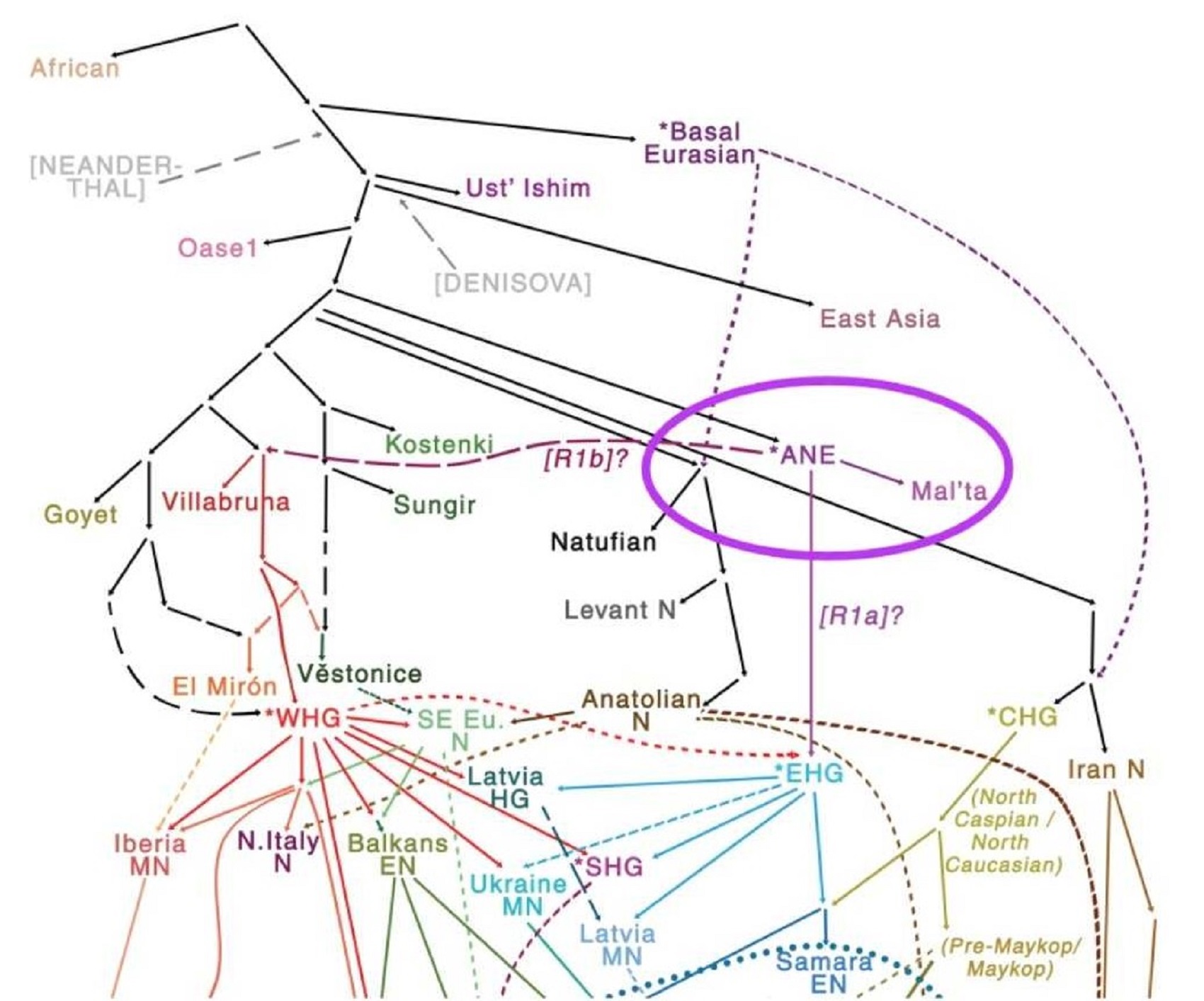
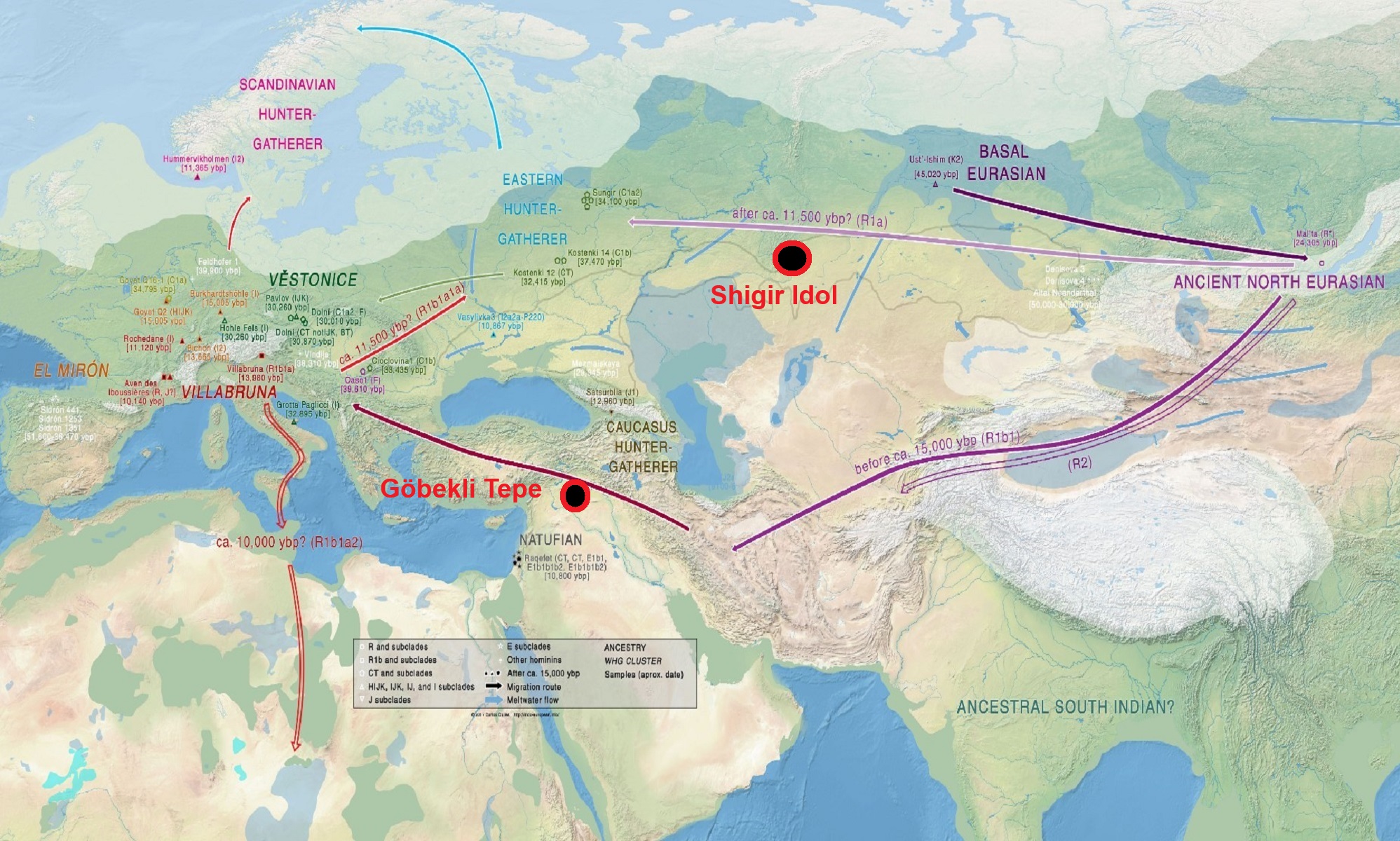
“Migration from Siberia behind the formation of Göbeklitepe: Expert states. People who migrated from Siberia formed the Göbeklitepe, and those in Göbeklitepe migrated in five other ways to spread to the world, said experts about the 12,000-year-old Neolithic archaeological site in the southwestern province of Şanlıurfa.“ The upper paleolithic migrations between Siberia and the Near East is a process that has been confirmed by material culture documents,” he said.” ref
“Semih Güneri, a retired professor from Caucasia and Central Asia Archaeology Research Center of Dokuz Eylül University, and his colleague, Professor Ekaterine Lipnina, presented the Siberia-Göbeklitepe hypothesis they have developed in recent years at the congress held in Istanbul between June 11 and 13. There was a migration that started from Siberia 30,000 years ago and spread to all of Asia and then to Eastern and Northern Europe, Güneri said at the international congress.” ref
“The relationship of Göbeklitepe high culture with the carriers of Siberian microblade stone tool technology is no longer a secret,” he said while emphasizing that the most important branch of the migrations extended to the Near East. “The results of the genetic analyzes of Iraq’s Zagros region confirm the traces of the Siberian/North Asian indigenous people, who arrived at Zagros via the Central Asian mountainous corridor and met with the Göbeklitepe culture via Northern Iraq,” he added.” ref
“Emphasizing that the stone tool technology was transported approximately 7,000 kilometers from east to west, he said, “It is not clear whether this technology is transmitted directly to long distances by people speaking the Turkish language at the earliest, or it travels this long-distance through using way stations.” According to the archaeological documents, it is known that the Siberian people had reached the Zagros region, he said. “There seems to be a relationship between Siberian hunter-gatherers and native Zagros hunter-gatherers,” Güneri said, adding that the results of genetic studies show that Siberian people reached as far as the Zagros.” ref
“There were three waves of migration of Turkish tribes from the Southern Siberia to Europe,” said Osman Karatay, a professor from Ege University. He added that most of the groups in the third wave, which took place between 2600-2400 BCE, assimilated and entered the Germanic tribes and that there was a genetic kinship between their tribes and the Turks. The professor also pointed out that there are indications that there is a technology and tool transfer from Siberia to the Göbeklitepe region and that it is not known whether people came, and if any, whether they were Turkish.” ref
“Around 12,000 years ago, there would be no ‘Turks’ as we know it today. However, there may have been tribes that we could call our ‘common ancestors,’” he added. “Talking about 30,000 years ago, it is impossible to identify and classify nations in today’s terms,” said Murat Öztürk, associate professor from İnönü University. He also said that it is not possible to determine who came to where during the migrations that were accepted to have been made thousands of years ago from Siberia. On the other hand, Mehmet Özdoğan, an academic from Istanbul University, has an idea of where “the people of Göbeklitepe migrated to.” ref
“According to Özdoğan, “the people of Göbeklitepe turned into farmers, and they could not stand the pressure of the overwhelming clergy and started to migrate to five ways.” “Migrations take place primarily in groups. One of the five routes extends to the Caucasus, another from Iran to Central Asia, the Mediterranean coast to Spain, Thrace and [the northwestern province of] Kırklareli to Europe and England, and one route is to Istanbul via [Istanbul’s neighboring province of] Sakarya and stops,” Özdoğan said. In a very short time after the migration of farmers in Göbeklitepe, 300 settlements were established only around northern Greece, Bulgaria, and Thrace. “Those who remained in Göbeklitepe pulled the trigger of Mesopotamian civilization in the following periods, and those who migrated to Mesopotamia started irrigated agriculture before the Sumerians,” he said.” ref
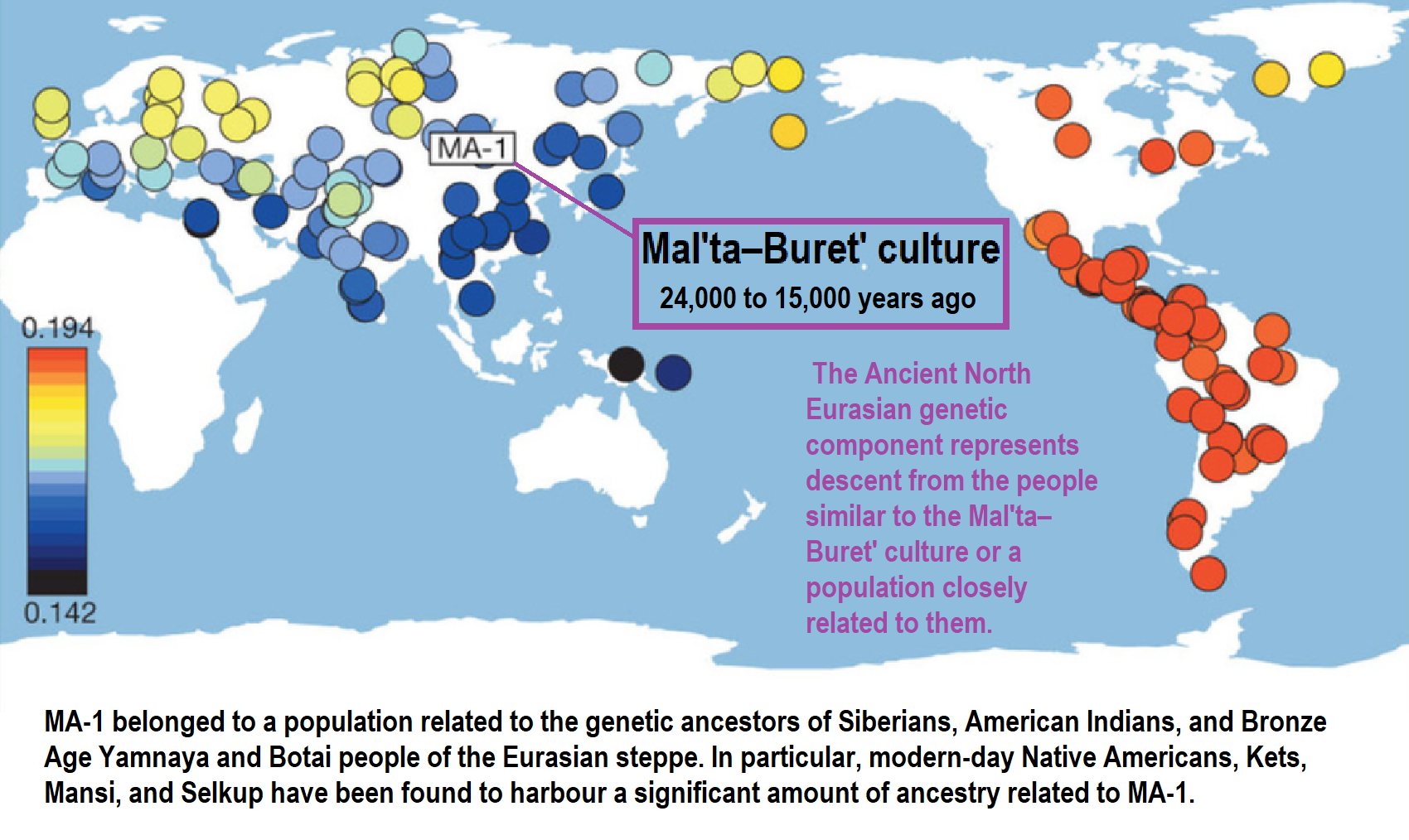
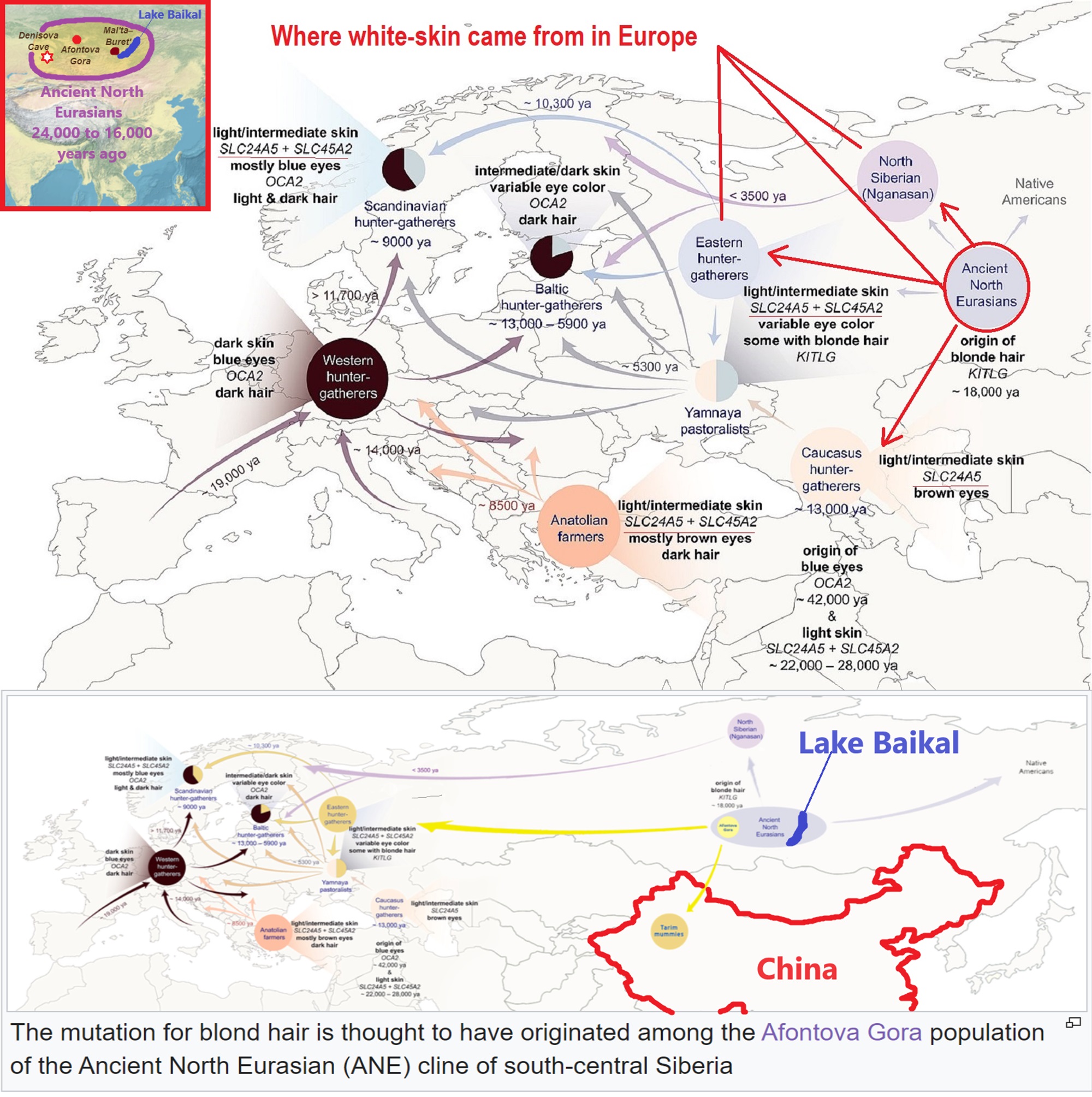
The Arrival of Siberian Ancestry Connecting the Eastern Baltic to Uralic Speakers further East
“Highlights:
-
Increase in hunter-gatherer ancestry in Bronze Age Eastern Baltic genomes
- Genetic input from Siberia to the Eastern Baltic during the transition to Iron Age
- Arrival of Siberian ancestry coincides with the proposed arrival of Uralic languages
- Light eyes, hair, and skin and lactose tolerance become frequent in the Bronze Age” ref
“In this study, we compare the genetic ancestry of individuals from two as yet genetically unstudied cultural traditions in Estonia in the context of available modern and ancient datasets: 15 from the Late Bronze Age stone-cist graves (1200–400 BCE) (EstBA) and 6 from the Pre-Roman Iron Age tarand cemeteries (800/500 BCE–50 CE) (EstIA). We also included 5 Pre-Roman to Roman Iron Age Ingrian (500 BCE–450 CE) (IngIA) and 7 Middle Age Estonian (1200–1600 CE) (EstMA) individuals to build a dataset for studying the demographic history of the northern parts of the Eastern Baltic from the earliest layer of Mesolithic to modern times. Our findings are consistent with EstBA receiving gene flow from regions with strong Western hunter-gatherer (WHG) affinities and EstIA from populations related to modern Siberians. The latter inference is in accordance with Y chromosome (chrY) distributions in present-day populations of the Eastern Baltic, as well as patterns of autosomal variation in the majority of the westernmost Uralic speakers. This ancestry reached the coasts of the Baltic Sea no later than the mid-first millennium BCE; i.e., in the same time window as the diversification of west Uralic (Finnic) languages. Furthermore, phenotypic traits often associated with modern Northern Europeans, like light eyes, hair, and skin, as well as lactose tolerance, can be traced back to the Bronze Age in the Eastern Baltic.” ref
“The Eastern Baltic has witnessed several population shifts since people reached its southern part during the Final Paleolithic ∼11,000–10,000 BCE and its northern part during the Mesolithic ∼9000 BCE. No genetic information is available from Paleolithic populations, but Mesolithic hunter-gatherers of the Kunda and Narva cultures were genetically most similar to Western hunter-gatherers (WHGs) widespread in Europe. A genetic shift toward Eastern hunter-gatherer (EHG) genetic ancestry occurred with the arrival of the Neolithic Comb Ceramic culture (CCC) people ∼3900 BCE. The Late Neolithic (LN) Corded Ware culture (CWC) people of Ponto-Caspian steppe origin brought farming into the Eastern Baltic ∼2800 BCE, contrary to most of Europe, where the Neolithic transition was mediated by Aegean early farmers. Human remains radiocarbon dated to the Early Bronze Age (ca. 1800–1200 BCE) are rare from this region, and no ancient DNA (aDNA) data are currently available. Genetic data from succeeding Bronze Age (BA) layers in Latvia and Lithuania indicate some genetic affinities with modern Eastern Baltic populations but also notable differences.” ref
“In this study, we present new genomic data from Estonian Late Bronze Age stone-cist graves (1200–400 BCE) (EstBA) and Pre-Roman Iron Age tarand cemeteries (800/500 BCE–50 CE) (EstIA). The cultural background of stone-cist graves indicates strong connections both to the west and the east. The Iron Age (IA) tarands have been proposed to mirror “houses of the dead” found among Uralic peoples of the Volga-Kama region. As this time window matches the proposed diversification period of western Uralic languages and the arrival of Proto-Finnic language in the Eastern Baltic from the east, our study considers linguistic, archaeological, and genetic data to inform on this. One of the most notable genetic features of Eastern Baltic populations is a high frequency of Y chromosome (chrY) haplogroup (hg) N3a (nomenclature of Karmin et al.), a characteristic shared mostly with Finno-Ugric-speaking groups in Europe and several populations all over Siberia. The rapid expansion of people carrying these lineages likely took place within the last 5,000 years, but their arrival time in the Eastern Baltic remains unresolved. The gene flow from Siberia to western-Uralic-speaking populations has also recently been inferred using autosomal data. However, available aDNA data have not revealed chrY hg N lineages in Eastern Baltic individuals.” ref
“To characterize the genetic ancestry of people from the so-far-unstudied cultural layers, we extracted DNA from the tooth roots of 56 individuals (Figure 1A; Table S1; STAR Methods). No individuals were included from later IA in Estonia because people were mostly cremated during that period. Individuals morphologically sexed as males were prioritized in sampling to make comparisons using autosomal and both sex chromosomes. We shotgun sequenced all samples and they formed 3 groups: (1) 15 with low endogenous DNA content and resulting coverage, which were excluded from further analyses; (2) 8 with sufficient mtDNA (and in some cases, chrY) coverage for determining hgs, but not for informative autosomal analyses; and (3) 33 that yielded sufficient autosomal data for informative analyses. The 33 individuals included 15 from EstBA, 6 from EstIA, 5 from Pre-Roman to Roman Iron Age Ingria (500 BCE–450 CE) (IngIA), and 7 from Middle Age Estonia (1200–1600 CE) (EstMA) and yielded endogenous DNA ∼4%–88%, average genomic coverages ∼0.017–0.734×, and contamination estimates <4% (Table S1). We analyzed the data in the context of modern and other ancient individuals, including from Neolithic Estonia.” ref
“We identified chrY hgs for 30 male individuals (Tables 1 and S2; STAR Methods). All 16 successfully haplogrouped EstBA males belonged to hg R1a, showing no change from the CWC period, when this was also the only chrY lineage detected in the Eastern Baltic. Three EstIA and two IngIA individuals also belonged to hg R1a, but three EstIA males belonged to hg N3a, the earliest so far observed in the Eastern Baltic. Three EstMA individuals belonged to hg N3a, two to hg R1a, and one to hg J2b. ChrY lineages found in the Baltic Sea region before the CWC belong to hgs I, R1b, R1a5, and Q. Thus, it appears that these lineages were substantially replaced in the Eastern Baltic by hg R1a, most likely through steppe migrations from the east. Although we did not detect N3a chrYs in our BA sample, unlike in BA Fennoscandia, we cannot rule out its presence due to small sample size. However, the frequency should not exceed 0.17 with 95% and 0.25 with 99% confidence. The frequency of hg N3a was significantly higher in our IA than our BA group (Fisher’s exact test p value 0.013). Our results enable us to conclude that, although the expansion time for R1a1 and N3a3′5 in Eastern Europe is similar, hg N3a likely reached Estonia or at least became comparably frequent to modern Estonia only during the BA-IA transition.” ref
“To assess whether the Eastern Eurasian influence indicated by chrY hg N3a is apparent elsewhere in the genome, we first applied principal-component analysis (PCA). We projected ancient genomes from previous studies (Table S3) and this study on two axes inferred using Estonian Biocenter Illumina genotyping array data (EBC-chipDB) of modern Western Eurasian individuals (Table S3) (Figure 1C). A clear shift toward West Eurasian hunter-gatherers is visible between European LN and BA (including Baltic CWC) and EstBA individuals, the latter clustering together with Latvian and Lithuanian BA individuals. EstIA, IngIA, and EstMA individuals project between BA individuals and modern Estonians, partially overlapping with both. We performed ADMIXTURE analysis by projecting aDNA data on worldwide EBC-chipDB modern data (Figures S1C and S1D; Table S3) and present results at K = 9 (Figures 1B, S1A, and S1B; STAR Methods). EstBA individuals are clearly distinguishable from Estonian CWC individuals as the former have more of the blue component most frequent in WHGs and less of the brown and yellow components maximized in Caucasus hunter-gatherers and modern Khanty, respectively. The individuals of EstBA, EstIA, IngIA, EstMA, and modern Estonia are quite similar to each other on average, indicating that the relatively high proportion of WHG ancestry in modern Eastern Baltic populations compared to other present-day Europeans traces back to the BA.” ref
“When comparing Estonian CWC and EstBA using autosomal outgroup f3 and Patterson’s D statistics (Table S3), the latter is more similar to other Baltic BA populations, to Baltic IA and Middle Age (MA) populations, and also to populations similar to WHGs and Scandinavian hunter-gatherers (SHGs), but not to Estonian CCC (Figures 2A and S2A; Data S1). The increase in WHG or SHG ancestry could be connected to western influences seen in material culture and facilitated by a decline in local population after the CCC-CWC period. A slight trend of bigger similarity of Estonian CWC to forest or steppe zone populations and of EstBA to European early farmer populations can also be seen. These differences remain when over 900,000 positions of the ‘1240k’ capture are used instead of ∼500,000 positions of the EBC-chipDB (Figure S2B; Data S1). When comparing to modern populations, Estonian CWC is slightly more similar to Caucasus individuals but EstBA to Baltic populations and Finnic speakers (Figure 2B; Data S1). Outgroup f3 and D statistics do not reveal apparent differences when comparing EstBA to EstIA, EstIA to IngIA, and EstIA to EstMA (Data S1). These results highlight how uniparental and autosomal data can lead to different demographic inferences—the genetic change between CWC and BA not seen in uniparental lineages is clear in autosomal data and the appearance of chrY hg N in the IA is not matched by a clear shift in autosomal profiles.” ref
“We imputed the genotypes of 37 phenotype informative SNVs from the HIrisPlex-S system, two from TLR1, and one from MCM6 gene and a 32-bp deletion (rs333) in the CCR5 gene for Mesolithic and Neolithic individuals from Latvia and Estonia and the individuals of this study. We inferred a sharp increase to >50% in the frequency of the lactase persistence variant (MCM6/rs4988235) in the Baltic area after the LN (Data S2), in line with previous indications of this variant becoming common in Europe in the last 4,000–3,500 years and of its fast increase in populations with steppe ancestry due to local adaptation. In contrast, the rs333, responsible for HIV resistance, which we first detect in a CWC individual, remains at 10%–25% frequency since then (Data S2), comparable to its present-day 14.8% frequency in Estonia. Both TLR1 variants involved in the protection against leprosy were already present in Europe at medium-high frequencies since the Mesolithic (Data S2). Notably, we infer a high proportion (40%–60%) of dark skin pigmentation in the hunter-gatherers and CWC farmers (Data S2). We infer dark skin and blue eyes for two individuals, similarly to another European Mesolithic individual. However, from BA onward, we infer pale or intermediate skin pigmentation for all individuals and an increase in the proportion of blue eyes and lighter shades of hair (Data S2). This is in line with previous suggestions that light skin pigmentation alleles reached high frequencies in Europe only recently.” ref
Conclusions
“We show that a component of possibly Siberian ancestry was added to the gene pool of the Eastern Baltic during the Bronze to Iron Age transition at the latest. This component is present in the autosomes and chrY of many northeastern European Uralic-speaking populations today but arrived in the Eastern Baltic probably later than 3,500 years ago (ya), when it reached Fennoscandia. Considering the archaeological context of the individuals, this seems to have followed the so-called southwestern route from the Volga-Ural region. Notably, the Bronze to Iron Age transition period also coincides with the hypothesized arrival of westernmost Uralic (Finnic) languages in the Eastern Baltic, supporting the idea that the spread of these languages was mediated by IA migrants from the east. The EstBA individuals of this study, as other Baltic BA individuals, display more WHG ancestry compared to both earlier CWC and modern Estonians. Interestingly, we do not detect this change in their uniparental lineages. However, half of the admittedly small EstIA sample and over one-third of modern Estonian men share a hg N3a chrY—common in other Uralic-speaking populations living much further east and not found in the Eastern Baltic earlier—although the autosomes of EstIA individuals only show 3%–5% Siberian ancestry on average. Furthermore, phenotypic characteristics often associated with modern Northern Europeans (light eyes, hair, and skin pigmentation, and lactose tolerance) can be traced back to the Bronze Age in the Eastern Baltic.” ref
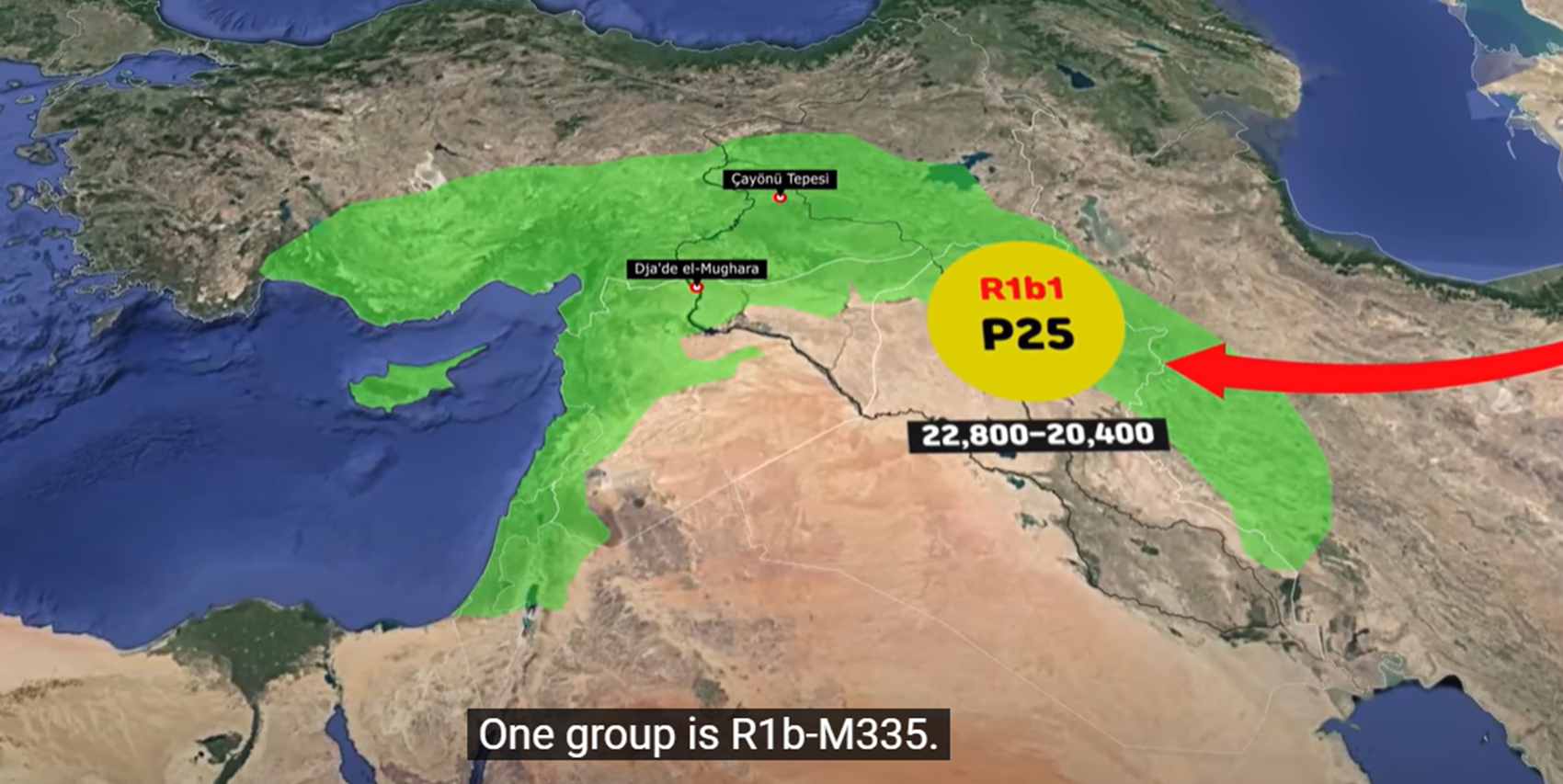
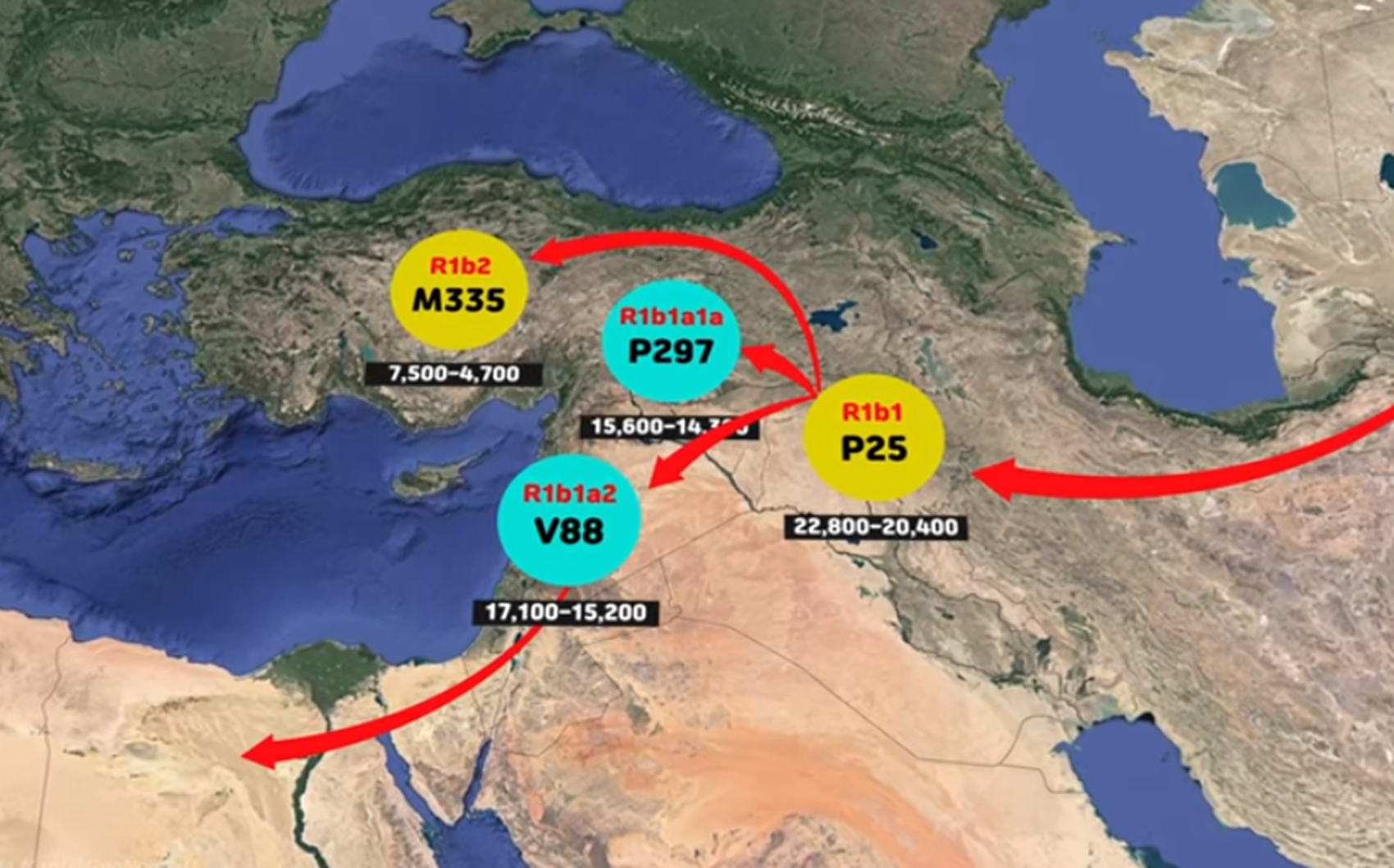
“Haplogroup R* originated in North Asia just before the Last Glacial Maximum (26,500-19,000 years ago). This haplogroup has been identified in the remains of a 24,000 year-old boy from the Altai region, in south-central Siberia (Raghavan et al. 2013). This individual belonged to a tribe of mammoth hunters that may have roamed across Siberia and parts of Europe during the Paleolithic. Autosomally this Paleolithic population appears to have contributed mostly to the ancestry of modern Europeans and South Asians, the two regions where haplogroup R also happens to be the most common nowadays (R1b in Western Europe, R1a in Eastern Europe, Central and South Asia, and R2 in South Asia).” ref
“The oldest forms of R1b (M343, P25, L389) are found dispersed at very low frequencies from Western Europe to India, a vast region where could have roamed the nomadic R1b hunter-gatherers during the Ice Age. The three main branches of R1b1 (R1b1a, R1b1b, R1b1c) all seem to have stemmed from the Middle East. The southern branch, R1b1c (V88), is found mostly in the Levant and Africa. The northern branch, R1b1a (P297), seems to have originated around the Caucasus, eastern Anatolia or northern Mesopotamia, then to have crossed over the Caucasus, from where they would have invaded Europe and Central Asia. R1b1b (M335) has only been found in Anatolia.” ref
“It has been hypothesized that R1b people (perhaps alongside neighboring J2 tribes) were the first to domesticate cattle in northern Mesopotamia some 10,500 years ago. R1b tribes descended from mammoth hunters, and when mammoths went extinct, they started hunting other large game such as bisons and aurochs. With the increase of the human population in the Fertile Crescent from the beginning of the Neolithic (starting 12,000 years ago), selective hunting and culling of herds started replacing indiscriminate killing of wild animals. The increased involvement of humans in the life of aurochs, wild boars, and goats led to their progressive taming. Cattle herders probably maintained a nomadic or semi-nomadic existence, while other people in the Fertile Crescent (presumably represented by haplogroups E1b1b, G, and T) settled down to cultivate the land or keep smaller domesticates.” ref
“The analysis of bovine DNA has revealed that all the taurine cattle (Bos taurus) alive today descend from a population of only 80 aurochs. The earliest evidence of cattle domestication dates from circa 8,500 BCE in the Pre-Pottery Neolithic cultures in the Taurus Mountains. The two oldest archaeological sites showing signs of cattle domestication are the villages of Çayönü Tepesi in southeastern Turkey and Dja’de el-Mughara in northern Iraq, two sites only 250 km away from each others. This is presumably the area from which R1b lineages started expanding – or in other words the “original homeland” of R1b.” ref
“The early R1b cattle herders would have split in at least three groups. One branch (M335) remained in Anatolia, but judging from its extreme rarity today wasn’t very successful, perhaps due to the heavy competition with other Neolithic populations in Anatolia, or to the scarcity of pastures in this mountainous environment. A second branch migrated south to the Levant, where it became the V88 branch. Some of them searched for new lands south in Africa, first in Egypt, then colonizing most of northern Africa, from the Mediterranean coast to the Sahel. The third branch (P297), crossed the Caucasus into the vast Pontic-Caspian Steppe, which provided ideal grazing grounds for cattle. They split into two factions: R1b1a1 (M73), which went east along the Caspian Sea to Central Asia, and R1b1a2 (M269), which at first remained in the North Caucasus and the Pontic Steppe between the Dnieper and the Volga. It is not yet clear whether M73 actually migrated across the Caucasus and reached Central Asia via Kazakhstan, or if it went south through Iran and Turkmenistan. In any case, M73 would be a pre-Indo-European branch of R1b, just like V88 and M335.” ref
“R1b-M269 (the most common form in Europe) is closely associated with the diffusion of Indo-European languages, as attested by its presence in all regions of the world where Indo-European languages were spoken in ancient times, from the Atlantic coast of Europe to the Indian subcontinent, which comprised almost all Europe (except Finland, Sardinia and Bosnia-Herzegovina), Anatolia, Armenia, European Russia, southern Siberia, many pockets around Central Asia (notably in Xinjiang, Turkmenistan, Tajikistan and Afghanistan), without forgetting Iran, Pakistan, northern India and Nepal. The history of R1b and R1a are intricately connected to each others.” ref
The Levantine & African branch of R1b (V88)
“Like its northern counterpart (R1b-M269), R1b-V88 is associated with the domestication of cattle in northern Mesopotamia. Both branches of R1b probably split soon after cattle were domesticated, approximately 10,500 years ago (8,500 BCE). R1b-V88 migrated south towards the Levant and Egypt. The migration of R1b people can be followed archeologically through the presence of domesticated cattle, which appear in central Syria around 8,000-7,500 BCE (late Mureybet period), then in the Southern Levant and Egypt around 7,000-6,500 BCE (e.g. at Nabta Playa and Bir Kiseiba). Cattle herders subsequently spread across most of northern and eastern Africa. The Sahara desert would have been more humid during the Neolithic Subpluvial period (c. 7250-3250 BCE), and would have been a vast savannah full of grass, an ideal environment for cattle herding.” ref
“Evidence of cow herding during the Neolithic has shown up at Uan Muhuggiag in central Libya around 5500 BCE, at the Capeletti Cave in northern Algeria around 4500 BCE. But the most compelling evidence that R1b people related to modern Europeans once roamed the Sahara is to be found at Tassili n’Ajjer in southern Algeria, a site famous pyroglyphs (rock art) dating from the Neolithic era. Some painting dating from around 3000 BCE depict fair-skinned and blond or auburn haired women riding on cows. The oldest known R1b-V88 sample in Europe is a 6,200 year-old farmer/herder from Catalonia tested by Haak et al. (2015). Autosomally this individual was a typical Near Eastern farmer, possessing just a little bit of Mesolithic West European admixture.” ref
“After reaching the Maghreb, R1b-V88 cattle herders could have crossed the Strait of Gibraltar to Iberia, probably accompanied by G2 farmers, J1 and T1a goat herders. These North African Neolithic farmers/herders could have been the ones who established the Almagra Pottery culture in Andalusia in the 6th millennium BCE.” ref
“Nowadays small percentages (1 to 4%) of R1b-V88 are found in the Levant, among the Lebanese, the Druze, and the Jews, and almost in every country in Africa north of the equator. Higher frequency in Egypt (5%), among Berbers from the Egypt-Libya border (23%), among the Sudanese Copts (15%), the Hausa people of Sudan (40%), the the Fulani people of the Sahel (54% in Niger and Cameroon), and Chadic tribes of northern Nigeria and northern Cameroon (especially among the Kirdi), where it is observed at a frequency ranging from 30% to 95% of men. According to Cruciani et al. (2010) R1b-V88 would have crossed the Sahara between 9,200 and 5,600 years ago, and is most probably associated with the diffusion of Chadic languages, a branch of the Afroasiatic languages. V88 would have migrated from Egypt to Sudan, then expanded along the Sahel until northern Cameroon and Nigeria. However, R1b-V88 is not only present among Chadic speakers, but also among Senegambian speakers (Fula-Hausa) and Semitic speakers (Berbers, Arabs).” ref
“R1b-V88 is found among the native populations of Rwanda, South Africa, Namibia, Angola, Congo, Gabon, Equatorial Guinea, Ivory Coast, Guinea-Bissau. The wide distribution of V88 in all parts of Africa, its incidence among herding tribes, and the coalescence age of the haplogroup all support a Neolithic dispersal. In any case, a later migration out of Egypt would be improbable since it would have brought haplogroups that came to Egypt during the Bronze Age, such as J1, J2, R1a or R1b-L23. The maternal lineages associated with the spread of R1b-V88 in Africa are mtDNA haplogroups J1b, U5 and V, and perhaps also U3 and some H subclades (=> see Retracing the mtDNA haplogroups of the original R1b people).” ref
R1b-v88 haplogroup
“According to ancient DNA studies, most R1a and R1b lineages would have expanded from the Pontic Steppe along with the Indo-European languages. Analysis of ancient Y-DNA from the remains from early Neolithic Central and North European Linear Pottery culture settlements have not yet found males belonging to haplogroup R1b-M269. Olalde et al. (2017) trace the spread of haplogroup R1b-M269 in western Europe, particularly Britain, to the spread of the Beaker culture, with a sudden appearance of many R1b-M269 haplogroups in Western Europe ca. 5000–4500 years BP during the early Bronze Age. Two branches of R-V88, R-M18 and R-V35, are found almost exclusively on the island of Sardinia. As can be seen in the above data table, R-V88 is found in northern Cameroon in west central Africa at a very high frequency, where it is considered to be caused by a pre-Islamic movement of people from Eurasia.” ref
R1b1b (R-V88)
“R1b1b (PF6279/V88; previously R1b1a2) is defined by the presence of SNP marker V88, the discovery of which was announced in 2010 by Cruciani et al. Apart from individuals in southern Europe and Western Asia, the majority of R-V88 was found in the Sahel, especially among populations speaking Afroasiatic languages of the Chadic branch. Studies in 2005–08 reported “R1b*” at high levels in Jordan, Egypt and Sudan. Subsequent research by Myres et al. (2011) indicates that the samples concerned most likely belong to the subclade R-V88, which is now concentrated in Sub-Saharan Africa.” ref
“According to Myres et al. (2011), this may be explained by a back-migration from Asia into Africa by R1b-carrying people. Gonzales et al. (2013), using more advanced techniques, indicate that it is equally probable that V88 originated in Central Africa and spread northward towards Asia. The patterns of diversity in African R1b-V88 did not seem to fit with a movement of Chadic-speaking people from the North, across the Sahara to West-Central Africa, but was compatible with the reverse. An origin of V88 lineages in Central Africa, followed by a migration to North Africa. However, Shriner, D., & Rotimi, C. N. (2018), associate the introduction of R1b into Chad, with the more recent movements of Baggara Arabs.” ref
“D’Atanasio et al. (2018) propose that R1b-V88 originated in Europe about 12 000 years ago and crossed to North Africa by about 8000 years ago; it may formerly have been common in southern Europe, where it has since been replaced by waves of other haplogroups, leaving remnant subclades almost exclusively in Sardinia. It first radiated within Africa likely between 8000 and 7000 years ago – at the same time as trans-Saharan expansions within the unrelated haplogroups E-M2 and A-M13 – possibly due to population growth allowed by humid conditions and the adoption of livestock herding in the Sahara. R1b-V1589, the main subclade within R1b-V88, underwent a further expansion around 5500 years ago, likely in the Lake Chad Basin region, from which some lines recrossed the Sahara to North Africa.” ref
“Marcus et al. (2020) provide strong evidence for this proposed model of North to South trans-Saharan movement: The earliest basal R1b-V88 haplogroups are found in several Eastern European Hunter Gatherers close to 10,000 years ago. The haplogroup then seemingly further spread with the Neolithic Cardial Ware expansion, which established agriculture in the Western Mediterranean around 7500 years ago: R1b-V88 haplogroups were identified in ancient Neolithic individuals in central Italy, Iberia and, at a particularly high frequency, in Sardinia. A part of the branch leading to present-day African haplogroups (V2197) is already derived in some of these ancient Neolithic European individuals, providing further support for a North-to-South trans-Saharan movement.” ref
“Early human remains found to carry R1b include:
- Villabruna 1 (individual I9030), a Western Hunter-Gatherer (WHG), found in an Epigravettian culture setting in the Cismon valley (modern Veneto, Italy), who lived circa 14000 years ago and belonged to R1b1a.
- Several males of the Iron Gates Mesolithic in the Balkans buried between 11,200 to 8,200 years ago carried R1b1a1a. These individuals were determined to be largely of WHG ancestry, with slight Eastern Hunter-Gatherer (EHG) admixture.
- Several males of the Mesolithic Kunda culture and Neolithic Narva culture buried in the Zvejnieki burial ground in modern-day Latvia c. 9,500–6,000 years ago carried R1b1b. These individuals were determined to be largely of WHG ancestry, with slight EHG admixture.
- Several Mesolithic and Neolithic males buried at Deriivka and Vasil’evka in modern-day Ukraine c. 9500-7000 years ago carried R1b1a. These individuals were largely of EHG ancestry, with significant WHG admixture.
- A WHG male buried at Ostrovul Corbuli, Romania c. 8,700 years ago carried R1b1c.
- A male buried at Lepenski Vir, Serbia c. 8,200-7,900 years ago carried R1b1a.
- An EHG buried near Samara, Russia 7,500 years ago carried R1b1a1a.
- An Eneolithic male buried at Khvalynsk, Russia c. 7,200-6,000 years ago carried R1b1a.
- A Neolithic male buried at Els Trocs, Spain c. 7,178-7,066 years ago, who may have belonged to the Epi-Cardial culture, was found to be a carrier of R1b1.
- A Late Chalcolithic male buried in Smyadovo, Bulgaria c. 6,500 years ago carried R1b1a.
- An Early Copper Age male buried in Cannas di Sotto, Carbonia, Sardinia c. 6,450 years ago carried R1b1b2.
- A male of the Baalberge group in Central Europe buried c. 5,600 years ago carried R1b1a.
- A male of the Botai culture in Central Asia buried c. 5,500 years ago carried R1b1a1 (R1b-M478).
- 7 males that were tested of the Yamnaya culture were all found to belong to the M269 subclade of haplogroup R1b.” ref
“R1b is a subclade within the “macro-haplogroup“ K (M9), the most common group of human male lines outside of Africa. K is believed to have originated in Asia (as is the case with an even earlier ancestral haplogroup, F (F-M89). Karafet T. et al. (2014) “rapid diversification process of K-M526 likely occurred in Southeast Asia, with subsequent westward expansions of the ancestors of haplogroups R and Q.” ref
“Three genetic studies in 2015 gave support to the Kurgan hypothesis of Marija Gimbutas regarding the Proto-Indo-European homeland. According to those studies, haplogroups R1b-M269 and R1a, now the most common in Europe (R1a is also common in South Asia) would have expanded from the West Eurasian Steppe, along with the Indo-European languages; they also detected an autosomal component present in modern Europeans which was not present in Neolithic Europeans, which would have been introduced with paternal lineages R1b and R1a, as well as Indo-European languages.” ref
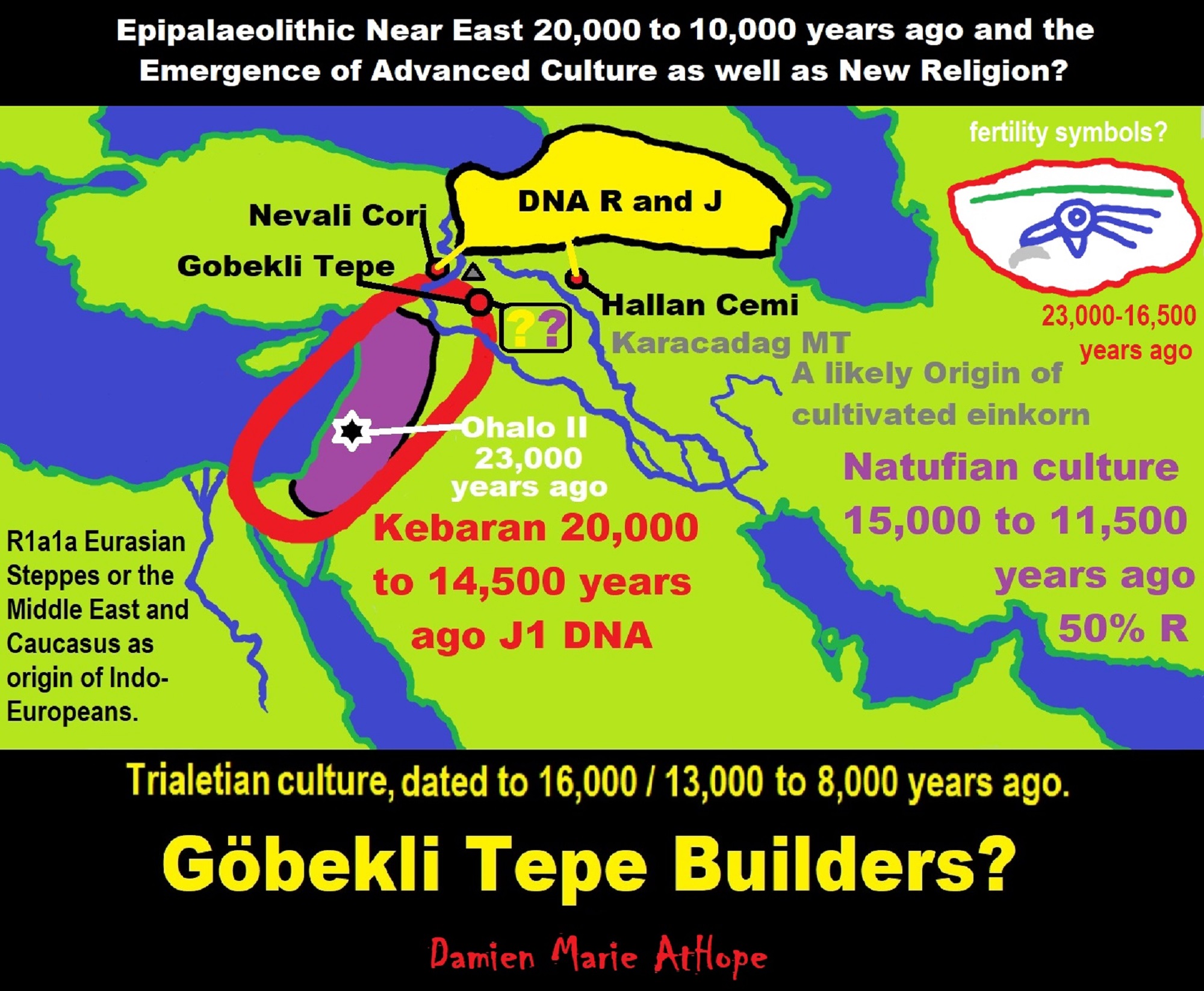
ref, ref, ref, ref, ref, ref, ref
Trialetian culture (16,000–8000 years ago) the Caucasus, Iran, and Turkey, likely involved in Göbekli Tepe. Migration 1?
Haplogroup R possible time of origin about 27,000 years in Central Asia, South Asia, or Siberia:
- Mal’ta–Buret’ culture (24,000-15,000 years ago)
- Afontova Gora culture (21,000-12,000 years ago)
- Trialetian culture (16,000–8000 years ago)
- Samara culture (7,000-6,500 years ago)
- Khvalynsk culture (7,000-6,500 years ago)
- Afanasievo culture (5,300-4,500 years ago)
- Yamna/Yamnaya Culture (5,300-4,500 years ago)
- Andronovo culture (4,000–2,900 years ago) ref
Trialetian sites
Caucasus and Transcaucasia:
- Edzani (Georgia)
- Chokh (Azerbaijan), layers E-C200
- Kotias Klde, layer B” ref
Eastern Anatolia:
- Hallan Çemi (from ca. 8.6-8.5k BC to 7.6-7.5k BCE)
- Nevali Çori shows some Trialetian admixture in a PPNB context” ref
Trialetian influences can also be found in:
- Cafer Höyük
- Boy Tepe” ref
Southeast of the Caspian Sea:
- Hotu (Iran)
- Ali Tepe (Iran) (from cal. 10,500 to 8,870 BCE)
- Belt Cave (Iran), layers 28-11 (the last remains date from ca. 6,000 BCE)
- Dam-Dam-Cheshme II (Turkmenistan), layers7,000-3,000 BCE)” ref

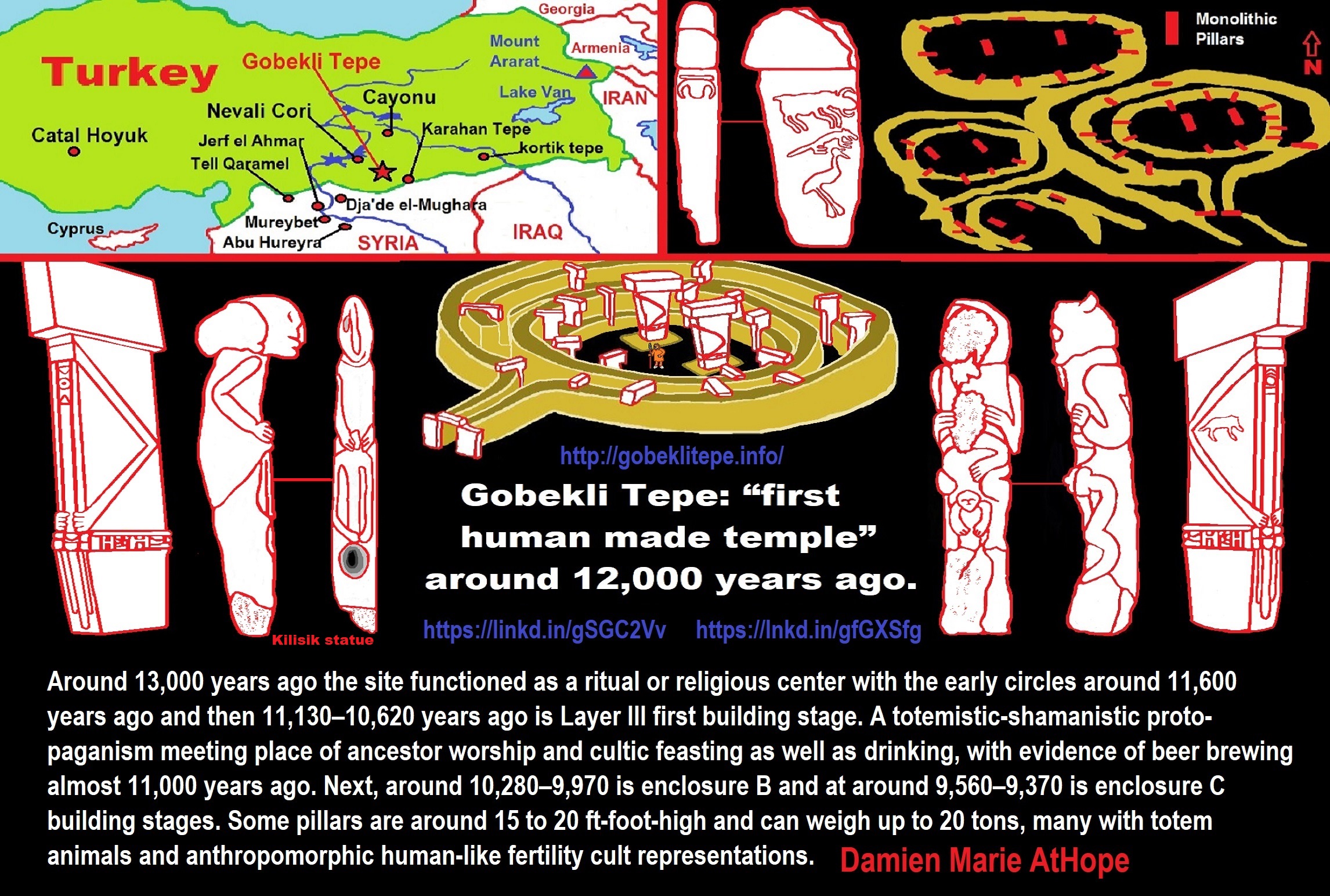
Paganism: an approximately 12,000-year-old belief system
Defining paganism is problematic. Understanding the context of its associated terminology is important.
J DNA and the Spread of Agricultural Religion (paganism)
“Haplogroup J-M304, also known as J*, is a human Y-chromosome DNA haplogroup. It is believed to have evolved in Western Asia.ref Possible time of origin 48,000 years agoref and the main current subgroups J-M267 and J-M172, which now comprise between them almost all of the haplogroup’s descendant lineages, are both believed to have arisen very early, at least 10,000 years ago. Y-DNA haplogroup J1, defined by the SNP mutation M267, is estimated to be approximately 20 thousand years old and is thought to have originated somewhere between Anatolia and Mesopotamia. ref Haplogroup J-M304 is found in its greatest concentration in the Arabian peninsula. Outside of this region, haplogroup J-M304 has a significant presence in North Africa and the Horn of Africa. It also has a moderate occurrence in Southern Europe, especially in central and southern Italy, Malta, Greece, and Albania. The J-M410 subclade is mostly distributed in Anatolia, Greece, and southern Italy. Additionally, J-M304 is observed in Central Asia and South Asia, particularly in the form of its subclade J-M172. J-12f2 and J-P19 are also found among the Herero (8%).ref The basal haplogroup J*(xJ1, J2) is found at its highest frequencies among the Soqotri (71.4%).” ref
“Haplogroup J-M267 defined by the M267 SNP is in modern times most frequent in the Arabian Peninsula: Yemen (up to 76%), Saudi (up to 64%) (Alshamali 2009), Qatar (58%), and Dagestan (up to 56%). J-M267 is generally frequent among Arab Bedouins(62%), Ashkenazi Jews (20%) (Semino 2004), Algeria (up to 35%) (Semino 2004), Iraq (up to 33%) (Semino 2004), Tunisia (up to 31%), Syria (up to 30%), Egypt (up to 20%) (Luis 2004), and the Sinai Peninsula. To some extent, the frequency of Haplogroup J-M267 collapses at the borders of Arabic/Semitic-speaking territories with mainly non-Arabic/Semitic speaking territories, such as Turkey (9%), Iran(5%), Sunni Iraqi Biradari of North India (38%) and Northern Indian Shia (11%) (Eaaswarkhanth 2009). However, it should be noted that some figures above tend to be the larger ones obtained in some studies, while the smaller figures obtained in other studies are omitted. It is also highly frequent among Jews, especially the Kohanim line (46%) (Hammer 2009). ISOGG states that J-M267 originated in the Middle East. It is found in parts of the Near East, Anatolia, and North Africa, with a much sparser distribution in the southern Mediterranean flank of Europe, and in Ethiopia. But not all studies agree on the point of origin. The Levant has been proposed but a 2010 study concluded that the haplogroup had a more northern origin, possibly Anatolia. The origin of the J-P58 subclade is likely in the more northerly populations and then spreads southward into the Arabian Peninsula. The high Y-STR variance of J-P58 in ethnic groups in Turkey, as well as northern regions in Syria and Iraq, supports the inference of an origin of J-P58 in nearby eastern Anatolia. Moreover, the network analysis of J-P58 haplotypes shows that some of the populations with low diversity, such as Bedouins from Israel, Qatar, Sudan, and the United Arab Emirates, are tightly clustered near high-frequency haplotypes. This suggests that founder effects with star burst expansion into the Arabian Desert (Chiaroni 2010).” ref
J-M172
“Haplogroup J-M172 is found in the highest concentrations in the Caucasus and the Fertile Crescent/Iraq and is found throughout the Mediterranean(including the Italian, Balkan, Anatolian and Iberian peninsulas and North Africa) (Giacomo 2003). The highest ever reported concentration of J-M172 was 72% in Northeastern Georgia (Nasidze 2004). Other high reports include Ingush 32% (Nasidze 2004), Cypriots30-37% (Capelli 2005), Lebanese 30% (Wells et al. 2001), Assyrian, Mandean and Arab Iraqis 29.7% (Sanchez et al. 2005), Syrians and Syriacs 22.5%, Kurds24%-28%, Iranians 23% (Aburto 2006), Ashkenazi Jews 24%, Palestinian Arabs 16.8%-25%, Sephardic Jews 29% and North Indian Shia Muslim 18%, Chechens 26%, Balkars 24%, Yaghnobis 32%, Armenians 21-24%, and Azerbaijanis 24%-48%. Some J-M172 haplotypes (as well as some J-M267 ones) belong to the “Cohen Modal Haplotype“. In South Asia, J2-M172 was found to be significantly higher among Dravidian castes at 19% than among Indo-European castes at 11%. J2-M172 and J-M410 is found 21% among Dravidian middle castes, followed by upper castes, 18.6%, and lower castes 14%. (Sengupta 2006) Subclades of M172 such as M67 and M92 were not found in either Indian or Pakistani samples which also might hint at a partial common origin.(Sengupta 2006) According to a genetic study in China by Shou et al., J2-M172 is found with high frequency among Uygurs (17/50 = 34%) and Uzbeks (7/23 = 30.4%), moderate frequency among Pamiris (5/31 = 16.1%), and low frequency among Yugurs (2/32 = 6.3%) and Monguors (1/50 = 2.0%). The authors also found J-M304(xJ2-M172) with low frequency among the Russians (1/19 = 5.3%), Uzbeks (1/23 = 4.3%), Sibe people (1/32 = 3.1%), Dongxiangs (1/35 = 2.9%), and Kazakhs (1/41 = 2.4%) in Northwest China.” ref
- 12,400 – 11,700 Years Ago – Kortik Tepe (Turkey) Pre/early-Agriculture Cultic Ritualism
- Natufians: an Ancient People at the Origins of Agriculture andSedentary Life
- Damien, I was wondering what your thoughts are on Paganism?
- Paganism: an approximately 12,000-year-old belief system
- J DNA and the Spread of Agricultural Religion (paganism)
- Sky Burials: Animism, Totemism, Shamanism, and Paganism
- Paganism, Folk religion, & Ethnic/indigenous religion
- Animism, Totemism, Shamanism, and Paganism
- Stars: Ancestors, Spirit Animals, and Deities (at least back to around 6,000 years ago)
- Understanding Religion Evolution: Animism, Totemism, Shamanism, Paganism & Progressed organized religion
Paganism?
Sedentism and the Creation of goddesses as well as gods
I fall from the treetops like a summer rain of new things that invigorates the mind to thought as if reaching out for a phantom to see what is really true. We light a candle in our mind when we let reason be our master because reason requires its user to change to what is reasoned over what may be preferred. I am a reason-driven “I dare you, to think” kind of philosopher. Simple but when the philosophy thinking is so inarticulate, or such monumental architecture of mental gymnastics erected on top of “reason”, that to most people, not in philosophy, it is just like bla, bla, bla. Lol
It is not a matter of being the only flame but to inspire us all to unify as one, to bring light to all we can. Be an honest thinker who values only reason and evidence as your main helpful guides. Follow an “ethics of belief” and don’t “believe what you like” rather what is justified soundly, thus let “Reason” be your master, and may you master “Reason.” Anger has been easier than care but it is my care I hold as value and it is this care, not some anger, I wish to inspire. In fact, I wish for us all to truly slow down and think, to add the needed care. Yea, we should do the needful, the worthy, and what is true. Reason rules.
No God: No evidence, No intelligence, and No goodness = Valid Atheism Conclusion
1. No evidence, To move past the Atheistic Null Hypothesis: There is no God/Gods (in inferential statistics, a Null Hypothesis generally assumed to be true until evidence indicates otherwise. Thus, a Null Hypothesis is a statistical hypothesis that there is no significant difference reached between the claim and the non-claim, as it is relatively provable/demonstratable in reality in some way. “The god question” Null Hypothesis is set at as always at the negative standard: Thus, holding that there is no God/Gods, and as god faith is an assumption of the non-evidentiary wishful thinking non-reality of “mystery thing” found in all god-talk, until it is demonstratable otherwise to change. Alternative hypothesis: There is a God (offered with no proof: what is a god and how can anyone say they know), therefore, results: Insufficient evidence to overturn the null hypothesis of no God/Gods.
2. No intelligence, Taking into account the reality of the world we do know with 99 Percent Of The Earth’s Species Are Extinct an intelligent design is ridiculous. Five Mass Extinctions Wiped out 99 Percent of Species that have ever existed on earth. Therefore like a child’s report card having an f they need to retake the class thus, profoundly unintelligent design.
3. No goodness, Assessed through ethically challenging the good god assumptions as seen in the reality of pain and other harm of which there are many to demonstrates either a god is not sufficiently good, not real or as I would assert, god if responsible for this world, would make it a moral monster ripe for the problem of evil and suffering (Argument from Evil). God would be responsible for all pain as life could easily be less painful and yet there is mass suffering. In fact, to me, every child born with diseases from birth screams out against a caring or loving god with the power to do otherwise. It could be different as there is Congenital insensitivity to pain (CIP), also known as congenital analgesia, in which a person cannot feel (and has never felt) physical pain.
To me, the “male god” seems to have either emerged or become prominent around 7,000 years ago, whereas the now favored monotheism “male god” is more like 4,000 years ago or so. To me, the “female goddess” seems to have either emerged or become prominent around 11,000-10,000 years ago or so, losing the majority of its once prominence around 2,000 years ago due largely to the now favored monotheism “male god” that grow in prominence after 4,000 years ago or so.
My Thought on the Evolution of Gods?
Animal protector deities from old totems/spirit animal beliefs come first to me, 13,000/12,000 years ago, then women as deities 11,000/10,000 years ago, then male gods around 7,000/8,000 years ago. Moralistic gods around 5,000/4,000 years ago, and monotheistic gods around 4,000/3,000 years ago.
Silence is no virtue, especially against injustice, oppression, or untruths. From our natural only reality, there is no need to hide, for Atheism and a magic-free universe is the truth and theism religion and its supernatural thinking gods are just a lie. Truth deserves to be supported and has no need to remain silent and should instead, inspire its strong championing. I hear this call deep in me to bravely champion the truth of atheism and I do it with pride. To me, Animistic Somethingism: You just feel/think there has to be something supernatural/spirit-world or feel/think things are supernatural/spirit-filled. “Somethingism” is commonly an unspecified belief in an undetermined supernatural reality, stated sometimes as spiritual but not religious, but, to me, is basically unrealized animism. Vague Theism or god Somethingism: just say NO! May I remind you , vague theism, somethingism or “ietsism” is not some Philosophers Stone of Theism removed from strong critique.
So loudly, I will proclaim supernatural, and gods are willful mental illusions, confusions, and lies that are commonly inspired by a life of religious influences, religiously motivated fears, and or religious indoctrination. I laugh at questions like “what would convince you of god” as if I approach thinking differently dependent. As a rationalist I am always moved best by valid and reliable reason and evidence, you know the very stuff, all religions and any supernatural claim always lack in the end. Religion is big on claims but small of real reasoning, full of logical fallacies in thinking, and no evidence to quorate all their delusionary supernatural nonsense and superstitions.
My thoughts on religious progression, and reasoned speculations from the evidence:
Animism (100,000 years ago)
Totemism (50/45,000 years ago)
Shamanism (30/35,000 years ago)
Paganism (13/12,000 years ago)
“Institutional” Progressed Organized Religion (5,000 years ago)
Religion Progression
- Animism (belief in a perceived spirit world) passably by at least 100,000 years ago “the primal stage of early religion”
- Totemism (belief that these perceived spirits could be managed with created physical expressions) passably by at least 50,000 years ago “progressed stage of early religion”
- Shamanism (belief that some special person can commune with these perceived spirits on the behalf of others by way rituals) passably by at least 30,000 years ago
- Paganism “Early organized nature-based religion” mainly like an evolved shamanism with gods (passable by at least 13,000 years ago).
- Institutional religion developed stage of “Progressed Organized Type Religion” as a social institution with official dogma usually set in a hierarchical/bureaucratic structure that contains strict rules and practices dominating the believer’s life.
I classify Animism (animated ‘spirit‘ or “supernatural” perspectives).
I see all religious people as at least animists, so, all religions have at least some amount, kind, or expression of animism as well.
I want to make something clear as I can, as simple as I can, even though I classify Animism (animated and alive from Latin: anima, ‘breath, spirit, life‘ or peoples’ “spiritual” or “supernatural” perspectives. Potentially, in some animism perceives, all things may relate to some spiritual/supernatural/non-natural inclinations, even a possible belief that objects, places, and/or creatures all possess a distinct spiritual essence, and/or thinking things like all things—animals, plants, rocks, rivers, weather systems, human handiwork, and perhaps even words— could be as animated and alive ref) as the first expression of religious thinking or religion, it is not less than, nor is it not equal to any other religion, or religious thinking. I see all religious people as at least animists any way, so everyone is at least animist, how could it be less than other religions as all other religions have at least some amount, kind, or expression of animism. Animism, +? is what I think about all that say they are spiritual or religious in thinking. Regardless if they know it, understand it, or claim it, they all, to me, an animistic-thinker, plus a paganistic, totemistic, and shamanistic-monotheist, calling themselves a Christian, Jew, or Muslim, as an example of my thinking. Animism (is the other-then-reality thinking relates to, thus it is in all such non-reality thinking generally.
Furthermore, I actually am impressed by animist cultures in Africa, others have seen them as primitive or something, help with that, they are revolutionaries with women’s rights, child rights. I mean if I had to choose a religion it would be animism only like in Africa so I don’t look down on them nor any indigenous peoples, who I care about, as well as I am for “humanity for all.” I challenge religious Ideas, and this is not meant to be an attack on people, but rather a challenge to think or rethink ideas, I want what is actually true. May we all desire a truly honest search for what is true even if we have to update what we believe or know. I even have religious friends, as I am not a bigot.
I class religious thinking in “time of origin” not somehow that any are better or worse or more reasoned than others. No, I am trying to help others understand how things happened, so they understand, and for themselves can finally think does the religion they say they believe in, still seems true, as they believed before learning my information and art. I am hoping I inspire freedom of thought and development of heart as well as mind as we need such a holistic approach in our quest for a humanity free for all and supportive of all. Until then, train your brain to think ethically. We are responsible for the future, we are the future, living in the present, soon to be passed, so we must act with passion, because life is over just like that. I am just another fellow dignity being. May I be a good human.
Less Imperialism Worship in Prehistory/History, PLEASE
I love when people of Statism-worship persuasion, love saying, things are so bad and we need to lower the struggle,
I think what the delusion are you talking about, it has always been class war, crazy fucker, you know, for about 7,000 years ago of oppressions forced on us at the end.
Between 7,000-5,000 Years ago, rise of unequal hierarchy elite, leading to a “birth of the State” or worship of power, strong new sexism, oppression of non-elites, and the fall of Women’s equal status
Here are a few of what I see as “Animist only” Cultures:
“Aka people” Central African nomadic Mbenga pygmy people. PRONUNCIATION: AH-kah
“The Aka people are very warm and hospitable. Relationships between men and women are extremely egalitarian. Men and women contribute equally to a household’s diet, either a husband or wife can initiate divorce, and violence against women is very rare. No cases of rape have been reported. The Aka people are fiercely egalitarian and independent. No individual has the right to force or order another individual to perform an activity against his or her will. Aka people have a number of informal methods for maintaining their egalitarianism. First, they practice “prestige avoidance”; no one draws attention to his or her own abilities. Individuals play down their achievements.” ref
“Mbuti People”
“The Mbuti people are generally hunter-gatherers who commonly are in the Congo’s Ituri Forest have traditionally lived in stateless communities with gift economies and largely egalitarian gender relations. They were a people who had found in the forest something that made life more than just worth living, something that made it, with all its hardships and problems and tragedies, a wonderful thing full of joy and happiness and free of care. Pygmies, like the Inuit, minimize discrimination based upon sex and age differences. Adults of all genders make communal decisions at public assemblies. The Mbuti people do not have a state, or chiefs or councils.” ref
“Hadza people”
“The Hadza people of Tanzania in East Africa are egalitarian, meaning there are no real status differences between individuals. While the elderly receive slightly more respect, within groups of age and sex all individuals are equal, and compared to strictly stratified societies, women are considered fairly equal. This egalitarianism results in high levels of freedom and self-dependency. When conflict does arise, it may be resolved by one of the parties voluntarily moving to another camp. Ernst Fehr and Urs Fischbacher point out that the Hadza people “exhibit a considerable amount of altruistic punishment” to organize these tribes. The Hadza people live in a communal setting and engage in cooperative child-rearing, where many individuals (both related and unrelated) provide high-quality care for children. Having no tribal or governing hierarchy, the Hadza people trace descent bilaterally (through paternal and maternal lines), and almost all Hadza people can trace some kin tie to all other Hadza people.” ref
- First, there is the foundation: Superstitionism and Symbolism/Ritualism.
- Second, is the frame and walls: Supernaturalism and Sacralizism/Spiritualism.
- Third, is the roof and finishing elements of the structure: Dogmatism and Myths.
- Fourth, is the window dressing and stylings to the house: decorated with the webs religious Dogmatic-Propaganda.
In the stage of organized religion, one important aspect that is often overlooked because of male-only thinking or by some over-emphasized because of extreme feminism is gender. There are some obvious gender associations in artifacts and possible gender-involved religious beliefs but thoughtful feminist archaeologists do not pounce on every representation of a woman and pronounce that it is a goddess. Around 5,000 years ago there are the full elements seem to be grouping together with its connected set of Dogmatic-Propaganda-Closure belief strains of sacralized superstitionism that took different forms of behavior in different areas of the world.
Interconnectedness of religious thinking Animism, Totemism, Shamanism, and Paganism
So, it all starts in a general way with Animism (theoretical belief in supernatural powers/spirits), then this is physically expressed in or with Totemism (theoretical belief in mythical relationship with powers/spirits through a totem item), which then enlists a full-time specific person to do this worship and believed interacting Shamanism (theoretical belief in access and influence with spirits through ritual), and then there is the further employment of myths and gods added to all the above giving you Paganism (often a lot more nature-based than most current top world religions, thus hinting to their close link to more ancient religious thinking it stems from). My hypothesis is expressed with an explanation of the building of a theatrical house (modern religions development ending with Institutional religion/organized religion).
Primal early superstition starts around 1 million years ago with. Then the development of religion increased around 600,000 years ago with proto superstition and then even to a greater extent around 300,000 years ago with progressed superstition. Around 100,000 years ago, is the primal stage of early religion, the proto stage of religion is around 75,000 years ago, or less, the progressed stage of early religion is around 50,000 years ago and finally after 13,500 years ago, begins with the evolution of organized religion. The set of stages for the development of organized religion is subdivided into the following: the primal stage of early organized religion is 13,000 years ago, the proto stage of organized religion is around 10,000 years ago, and finally the progressed stage of organized religion is around 7,000 years ago with the forming of mythology and its connected set of Dogmatic-Propaganda-Closure belief strains of sacralized superstitionism. In the stage of organized religion, one important aspect that is often overlooked because of male-only thinking or by some over-emphasized because of extreme feminism is gender. There are some obvious gender associations in artifacts and possible gender-involved religious beliefs but thoughtful feminist archaeologists do not pounce on every representation of a woman and pronounce that it is a goddess. Around 5,000 years ago elements seem to be grouping together with its connected set of Dogmatic-Propaganda-Closure belief strains of sacralized superstitionism that took different forms of behavior in different areas of the world.
Promoting Religion as Real is Harmful?
Sometimes, when you look at things, things that seem hidden at first, only come clearer into view later upon reselection or additional information. So, in one’s earnest search for truth one’s support is expressed not as a one-time event and more akin to a life’s journey to know what is true. I am very anti-religious, opposing anything even like religion, including atheist church. but that’s just me. Others have the right to do atheism their way. I am Not just an Atheist, I am a proud antireligionist. I can sum up what I do not like about religion in one idea; as a group, religions are “Conspiracy Theories of Reality.” These reality conspiracies are usually filled with Pseudo-science and Pseudo-history, often along with Pseudo-morality and other harmful aspects and not just ancient mythology to be marveled or laughed at. I regard all this as ridiculous. Promoting Religion as Real is Mentally Harmful to a Flourishing Humanity To me, promoting religion as real is too often promotes a toxic mental substance that can divide a person from who they are shaming them for being human. In addition, religion is a toxic mental substance that can divide a person from real history, real science or real morality to pseudohistory, pseudoscience, and pseudomorality. Moreover, religion is a toxic mental substance that can divide a person from rational thought, critical thinking, or logic. Likewise, religion is a toxic mental substance that can divide a person from justice, universal ethics, equality, and liberty. Yes, religion is a toxic mental substance that can divide a person from loved ones, and religion is a toxic mental substance that can divide a person from humanity. Therefore, to me, promoting religion as real is too often promote a toxic mental substance that should be rejected as not only false but harmful as well even if you believe it has some redeeming quality. To me, promoting religion as real is mentally harmful to a flourishing humanity. Religion may have once seemed great when all you had or needed was to believe. Science now seems great when we have facts and need to actually know.
A Rational Mind Values Humanity and Rejects Religion and Gods
A truly rational mind sees the need for humanity, as they too live in the world and see themselves as they actually are an alone body in the world seeking comfort and safety. Thus, see the value of everyone around them as they too are the same and therefore rationally as well a humanistically we should work for this humanity we are part of and can either dwell in or help its flourishing as we are all in the hands of each other. You are Free to think as you like but REALITY is unchanged. While you personally may react, or think differently about our shared reality (the natural world devoid of magic anything), We can play with how we use it but there is still only one communal reality (a natural non-supernatural one), which we all share like it or not and you can’t justifiably claim there is a different reality. This is valid as the only one of warrant is the non-mystical natural world around us all, existing in or caused by nature; not made or caused by superstitions like gods or other monsters, too many sill fear irrationally.
I know that god-something is is an unjustified and debunked claim of super supernatural when no supernatural any has ever been found to even start such claims. I am quite familiar with a general when and why gods were created. Gods are not in all religions nor their thinking. I believe that all claims of God will fail epistemic qualities need for belief and instead require disbelief in all of them, unless shown real epistemic value.
Every child born with horrific deformities shows that those who believe in a loving god who is in control and values every life is not just holding a ridiculous belief; it is an offensive belief to the compassion for life and a loving morality. Prayer is nothing like hope, as prayer is the Belief in magic and a thing one is believed they are praying to is magical things or beings. Hope is a desire or aspiration, not a Belief in magical things or you have additional beliefs added in that hope.
Religion removed? All its pseudo meaning as well as pseudoscience, pseudohistory, and pseudo-morality. We have real science, realistic history and can access real morality with a blend of philosophy, anthropology, psychology, sociology, and cognitive science. I do not hate simply because I challenge and expose myths or lies any more than others being thought of as loving simply because of the protection and hiding from challenge their favored myths or lies.
My Antireligionism?
I will grant you some religious mythology is quite interesting but I never forget it is simple stories of hope, fear, and magical thinking arising from human ignorance fueled by imagination and presto people believe in things never seen. I hate religion as I hate harm, oppression, bigotry, and love equality, self-ownership, self-empowerment, self-actualization including self-mastery, as well as truth and not only does religion lie, it is a conspiracy theory of reality. I know that god-something is is an unjustified and debunked claim of super supernatural when no supernatural any has ever been found to even start such claims.
I don’t think antireligionism is really anti-friendly-atheism, as it can involve being friendly to people even if it is harsh to religion, positive antireligionism or Anti-Accommodationism is attacking bad thinking and bad behaviors, not just people who believe. Not just an atheist and antitheist, I am a proud anti-religionist. I have greater confidence in science as they often admit errors and I have greater mistrust of religion as they often refuse to accept or admit errors.
What I do not like about religion in one idea, religions as a group are “Conspiracy Theories of Reality,” usually filled with Pseudoscience, Pseudohistory, along with Pseudomorality, and other harmful aspects. An antireligionist generally means opposition to religion, this includes all, every religion or pseudo-religion, YES, I am an atheist and antitheist, who is “Anti” ALL RELIGIONS. But I am against the ideas, not people. We regrettably pay our life debt in our time lost living one moment at a time which seem to group together into what we call a life, so live as there just went another lost moment.
“But Damien, Souls are real because energy does not die!”
My response, That is a logical fallacy as it is not a reasoned jump in logic. Energy leaves all once alive bodies by dissipating heat in the environment then is gone as the once related energy in a now dead body.
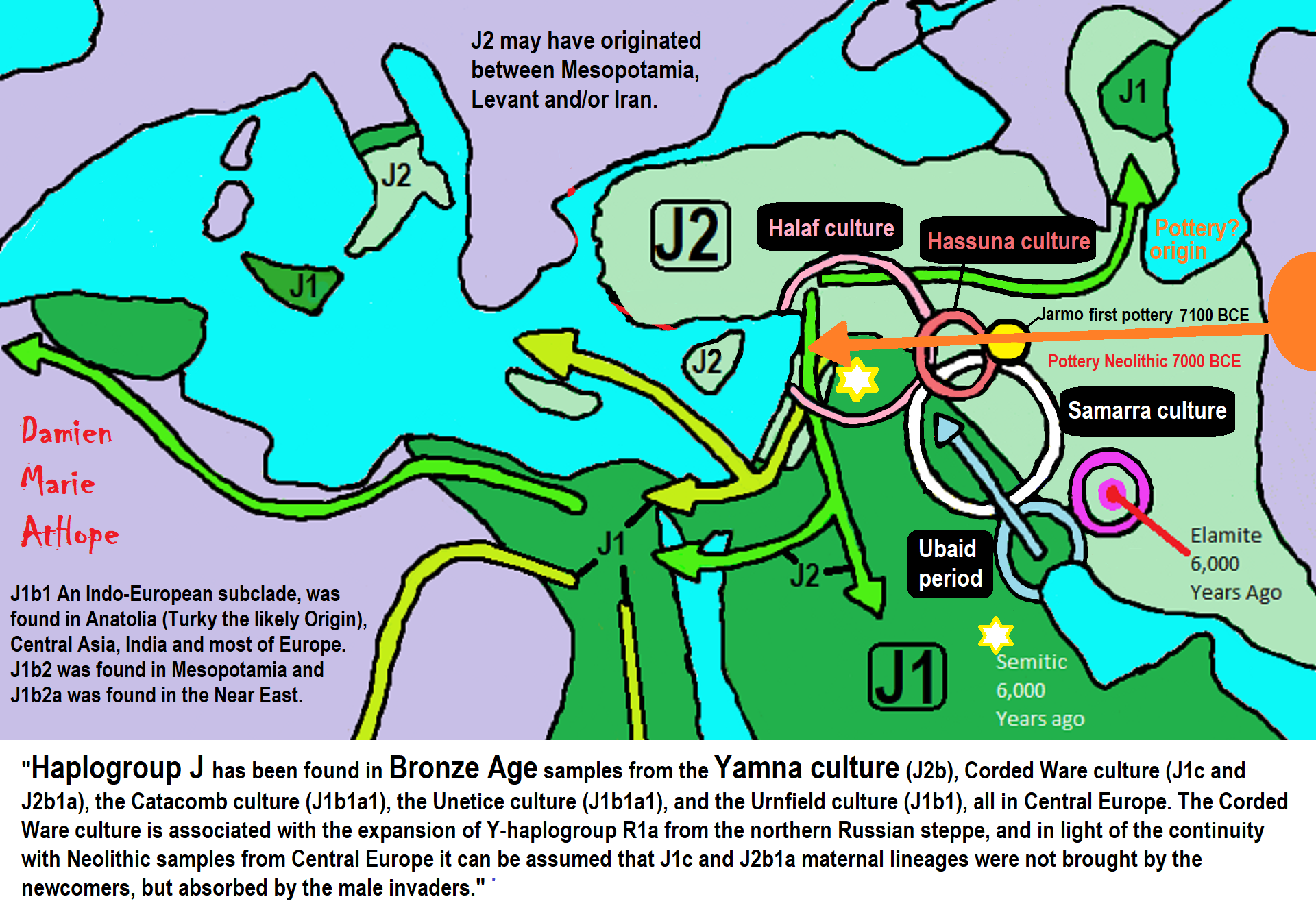

ref, ref, ref, ref, ref, ref, ref, ref, ref, ref, ref, ref, ref, ref, ref, ref, ref
“The shaman is, above all, a connecting figure, bridging several worlds for his people, traveling between this world, the underworld, and the heavens. He transforms himself into an animal and talks with ghosts, the dead, the deities, and the ancestors. He dies and revives. He brings back knowledge from the shadow realm, thus linking his people to the spirits and places which were once mythically accessible to all.–anthropologist Barbara Meyerhoff” ref


ref, ref, ref, ref, ref, ref, ref, ref, ref, ref, ref, ref, ref, ref, ref, ref, ref, ref, ref, ref, ref, ref, ref, ref, ref, ref, ref, ref, ref, ref, ref, ref, ref, ref, ref, ref, ref, ref, ref, ref, ref, ref
Archaeology shows both the common culture and genetics of the earliest Indo-Europeans in Europe were forming from the 8,000-6,020 years ago, due to migration of the Western Baltic Mesolithic population linked with Poland. Scandinavian Hunter-Gatherers: mix of Western and Eastern Hunter-Gatherers beginning around 13,000 years ago.
Baltic Reindeer Hunters: Swiderian, Lyngby, Ahrensburgian, and Krasnosillya cultures 12,020 to 11,020 years ago are evidence of powerful migratory waves during the last 13,000 years and a genetic link to Saami and the Finno-Ugric peoples. Two Different Bone Point Phases: fine-barbed 11,200–10,100 years ago and larger-barbed 9,658–8,413 years ago.

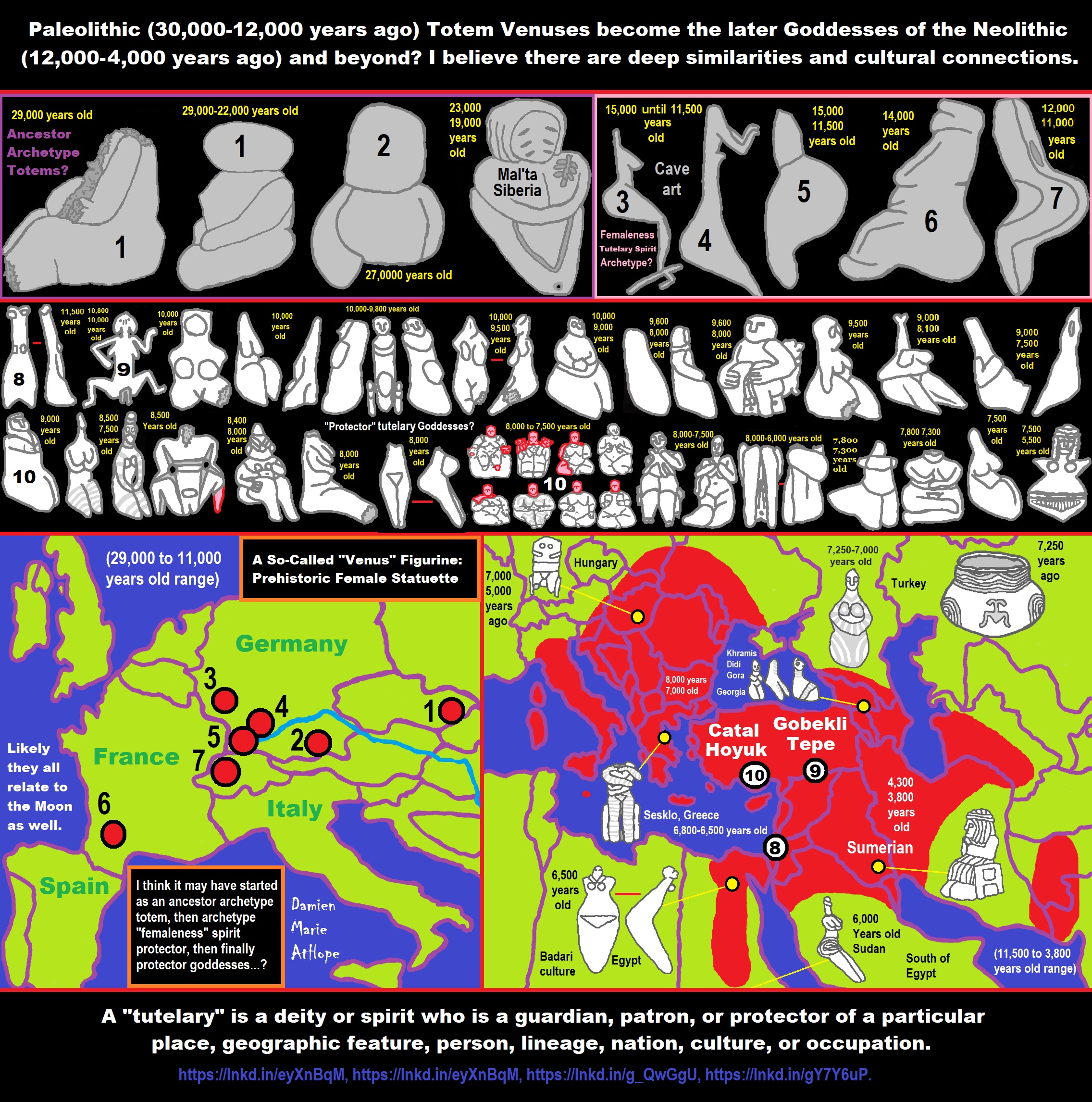


12,400 – 11,700 Years Ago – Kortik Tepe (Turkey) found mound structures, tombs and grave goods as well as ritual art, demonstrating examples of the symbolic bee carved stone ritual objects possibly represents a mythic creature(s). Ritualistic behavior is also found on the bones of ten individuals who exhibit cut marks that seem to indicate deflating along with application of plaster and paint as part of the burial customs has been interpreted by some as corpse purification possibly to help the desist pass to the afterlife. Back to animal veneration, the specific bee idol motif appears early at Hallan Cemi, in southeastern Turkey. Each phase at Kortik Tepe which is also in southeastern Turkey, includes common religio-cultural features particularly true with the burial rites and grave goods.
Similar structures are known at Hallan Çemi, Demirköy in northwest Turkey and the earliest layers of Çayonu in southeastern Turkey. Kortik Tepe is similar to Demirköy and other sites along the Batman River, which is a major tributary of the Tigris River, in southeast Turkey. Kortik Tepe demonstrated changing mortuary practices as time progressed, going from barring people outside the village to inside the village or structures, showing difference but still holding a shared cultural transfer. Even more interesting is how Hallan Cemi, burials of the dead are not found in the site at all, so perhaps a they used a cemetery nearby, which is what happened with Zawi Chemi in northern Iraq, who used a cemetery nearby with 28 burials, 26 of which were associated with a stone platform and existed contemporary Levantine Natufian sites. The Zawi Chemi site had evidence of far-reaching trade connections exhibited in obsidian that was found there but comes from the Lake Van region of southeastern Turkey.
Similarly, the flint and obsidian tools found at Kortik Tepe connecting its culture to contemporary settlements such as Hallan Çemi, Demirköy and Çayönü in the region and in some ways, its seeming religious themes with contemporaries among other Near East cultures and is one of the earliest manifestations of settled life but had obsidian likely from eastern Turkey, already points to the presence of trade in the region. Demirkoy which had way less obsidian that at Hallan Cemi and held less ritualistic significance in general having only two small canid burials and while the human burials maybe found in the Demirkoy site, it held only an occasional artifact and no grave goods. As the Kortik Tepe site progressed the new onsite primary burial continues but started to contain valuable grave goods, often including numerous elaborately decorated stone bowls and multiple strands of stone beads all of which were buried with the dead. (26) Ritual may take many forms such as intoxication which does produce an altered state. Along this line of thinking there is the two stone vessels at Kortik Tepe seems to demonstrate alcohol production similar the finding of six large trough-shaped stone vessels hint at fermenting of grain from Gobekli Tepe in southeastern Turkey.
Turkey interestingly enough is home to both wild wheat and the first cultivated wheat 11,000 years ago originating from the Karacadag mountains in southeast Turkey, not too far from several archeological sites in Turkey with wheat, Cafer Hoyuk around 9600 to 8,200 years ago, Cayonu around 9,500 to 8,700 years ago, and Nevali Cori around 9,200 years ago. The Karacadag mountains with the earliest domestication of grain is near to Göbekli Tepe, possibly linking alcohol fermentation, religion and wheat domestication as use and consumption may have been involved in cultic/shamanistic feast celebrations.
It seems wild wheat was still gathered but not yet cultivated at Hallan Cemi and Demirkoy and Gobekli Tepe. Wheat, which we may currently take for granted was once highly sacralized even somewhat supernaturally deified. Though odd to present thinkers such cultic/shamanistic connection to wheat seems to have held some kind of sacred or ritualistic significance or was used (possibly fermented) practices in how deities related to fertility usually involve wheat like Tammuz, Kybele, Kubaba, Ceres, and Demeter. Tammuz (Turkish “Temmuz”) a Babylonian deity derived from Dumuzid (Sumerian: Zi(d), “faithful, true”) is similar to central Turkey’s people the Hittites whose word for wheat was “Ziz” with cultural connections to a current local Turkish name of wheat, siyez first utilized around 10,000 years ago.
Moreover, from Catal Hoyuk and Cayonu in Turkey we can also trace the early stages of farming and female representations like that at Hacilar may possibly connect to some of the earliest traces of a goddess fertility cult. Catal Hoyuk seems to demonstrate the connected worship of a sacred females maybe a kind of spirit or cultic ancestor or goddess, maybe a mother or fertility figure along with possible sacred bulls. It is thought that possibly the Goddess Kybele originates around the 9000 years ago, which is around the time of the settlement at Hacilar in in southwestern Turkey, where ritual animal shaped vessels can be found dating to at least around 8,600 years ago and almost every house held what seemingly could be goddess figurines.
One such figure reclines dating to as old as 8,000 years ago holds a child and has traces of black paint on her hair and eyes. An innovation around 7,500 years ago seems to have occurred at Hacilar involving the use of obsidian inlay for eyes and in one case for the navel. Similarly, animal vessels (possibly of a deity) continue to be made but start to have images of a seated and dressed female which could reference a goddess and at the same time figurines of animals appear when before they were rare. Further linking goddesses to grain is where some were found which was buried in grain bins such as wheat in Catal Hoyuk.
12,400 – 11,700 Years Ago – Kortik Tepe (Turkey) Pre/early-Agriculture Cultic Ritualism
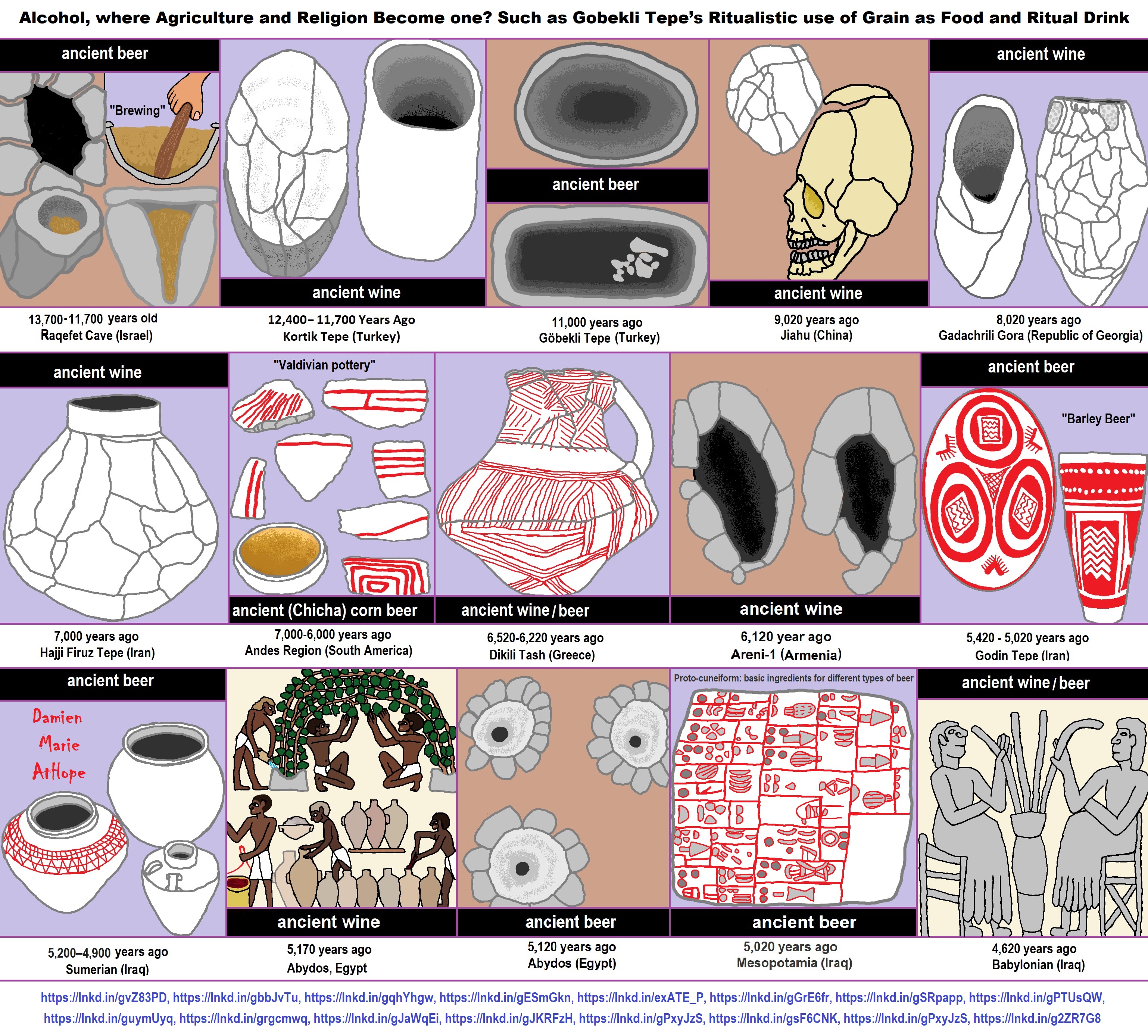
ref, ref, ref, ref, ref, ref, ref, ref, ref, ref, ref, ref, ref, ref, ref
Raqefet Cave
13,000-year-old stone mortars offers the earliest known physical evidence of an extensive ancient beer-brewing operation.
“The find comes on the heels of a July report that archaeologists working in northeastern Jordan discovered the charred remains of bread baked by Natufians some 11,600 to 14,600 years ago. According to the Stanford scientists, the ancient beer residue comes from 11,700 to 13,700 years old. Through laboratory analysis, other archaeological evidence found in the cave, and the wear of the stones, the team discovered that the ancient Natufians used species from seven plant families, “including wheat or barley, oat, legumes and bast fibers (including flax),” according to the article. “They packed plant-foods, including malted wheat/barley, in fiber-made containers and stored them in boulder mortars. They used bedrock mortars for pounding and cooking plant-foods, including brewing wheat/barley-based beer likely served in ritual feasts ca. 13,000 years ago,” the scientists write. “It has long been speculated that the thirst for beer may have been the stimulus behind cereal domestication, which led to a major social-technological change in human history; but this hypothesis has been highly controversial,” the Stanford authors say. “We report here of the earliest archaeological evidence for cereal-based beer brewing by a semi-sedentary, foraging people.” ref
“Beer making was an integral part of rituals and feasting, a social regulatory mechanism in hierarchical societies,” said Stanford’s Wang. The Raqefet Cave discovery of the first man-made alcohol production, the cave also provides one of the earliest pieces of evidence of the use of flower beds on gravesites, discovered under human skeletons. “The Natufian remains in Raqefet Cave never stop surprising us,” co-author Prof. Dani Nadel, of the University of Haifa’s Zinman Institute of Archaeology, said in a press release. “We exposed a Natufian burial area with about 30 individuals, a wealth of small finds such as flint tools, animal bones and ground stone implements, and about 100 stone mortars and cupmarks. Some of the skeletons are well-preserved and provided direct dates and even human DNA, and we have evidence for flower burials and wakes by the graves.” ref
“And now, with the production of beer, the Raqefet Cave remains provide a very vivid and colorful picture of Natufian lifeways, their technological capabilities, and inventions,” he said. Stanford’s Liu posited that the beer production was of a religious nature because its production was found near a graveyard. “This discovery indicates that making alcohol was not necessarily a result of agricultural surplus production, but it was developed for ritual purposes and spiritual needs, at least to some extent, prior to agriculture,” she said. “Alcohol making and food storage were among the major technological innovations that eventually led to the development of civilizations in the world, and archaeological science is a powerful means to help reveal their origins and decode their contents,” said Liu. “We are excited to have the opportunity to present our findings, which shed new light on a deeper history of human society.” ref
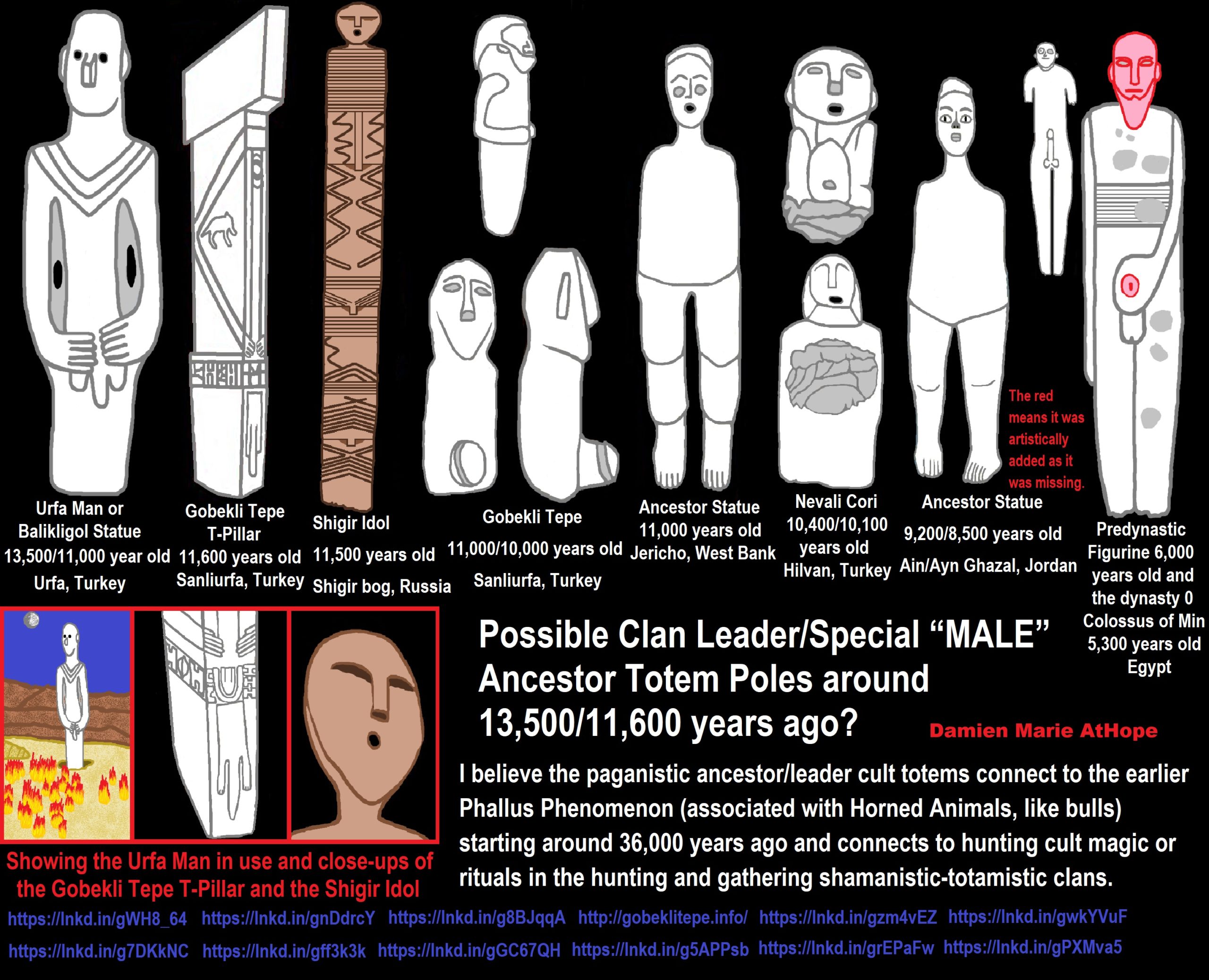
ref, ref, ref, ref, ref, ref, ref, ref, ref, ref, ref, ref, ref
I believe the paganistic ancestor/leader cult totems connect to the earlier Phallus Phenomenon (associated with Horned Animals, like bulls) starting around 36,000 years ago and connects to hunting cult magic or rituals in the hunting and gathering shamanistic-totamistic clans.

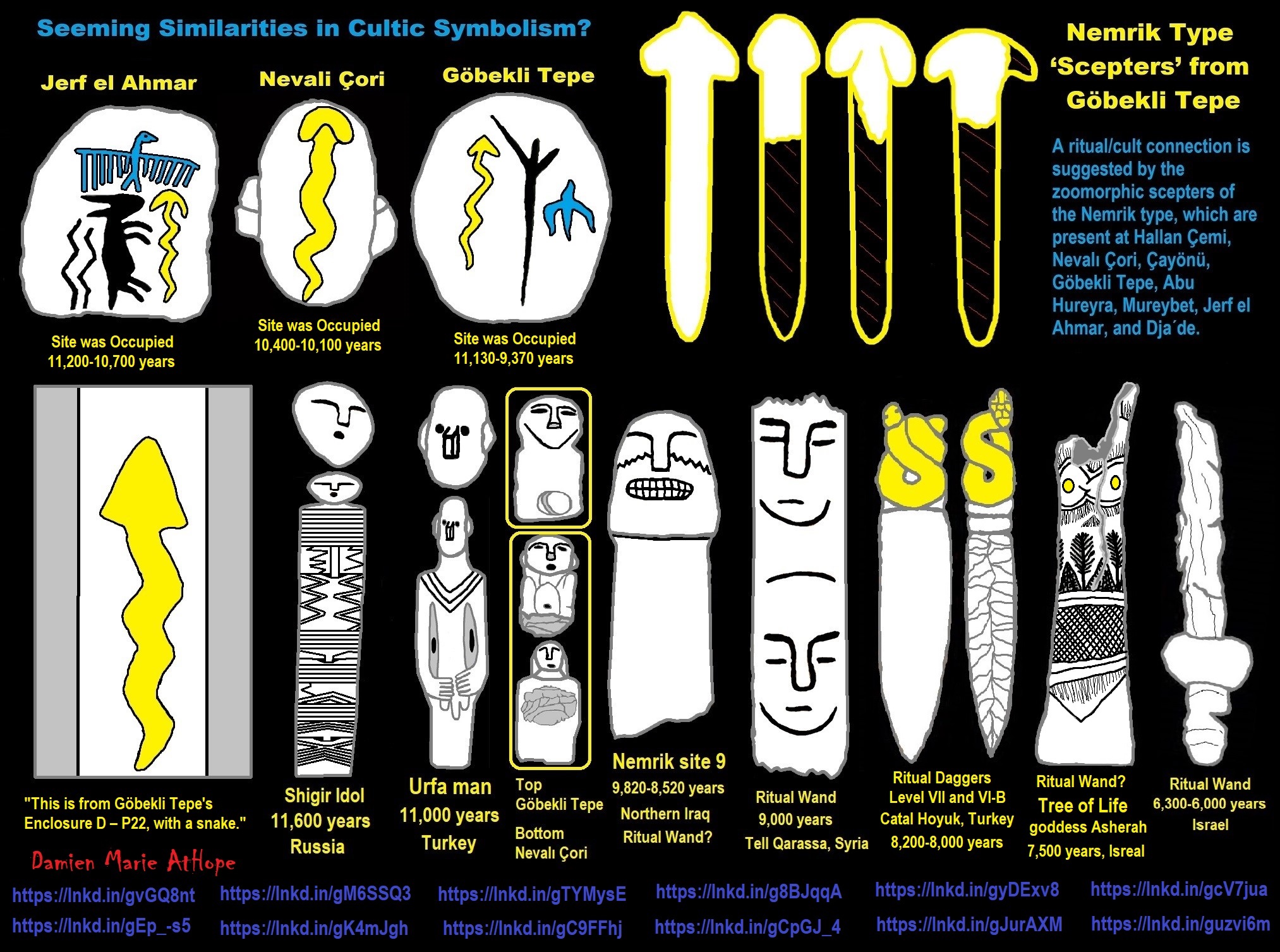
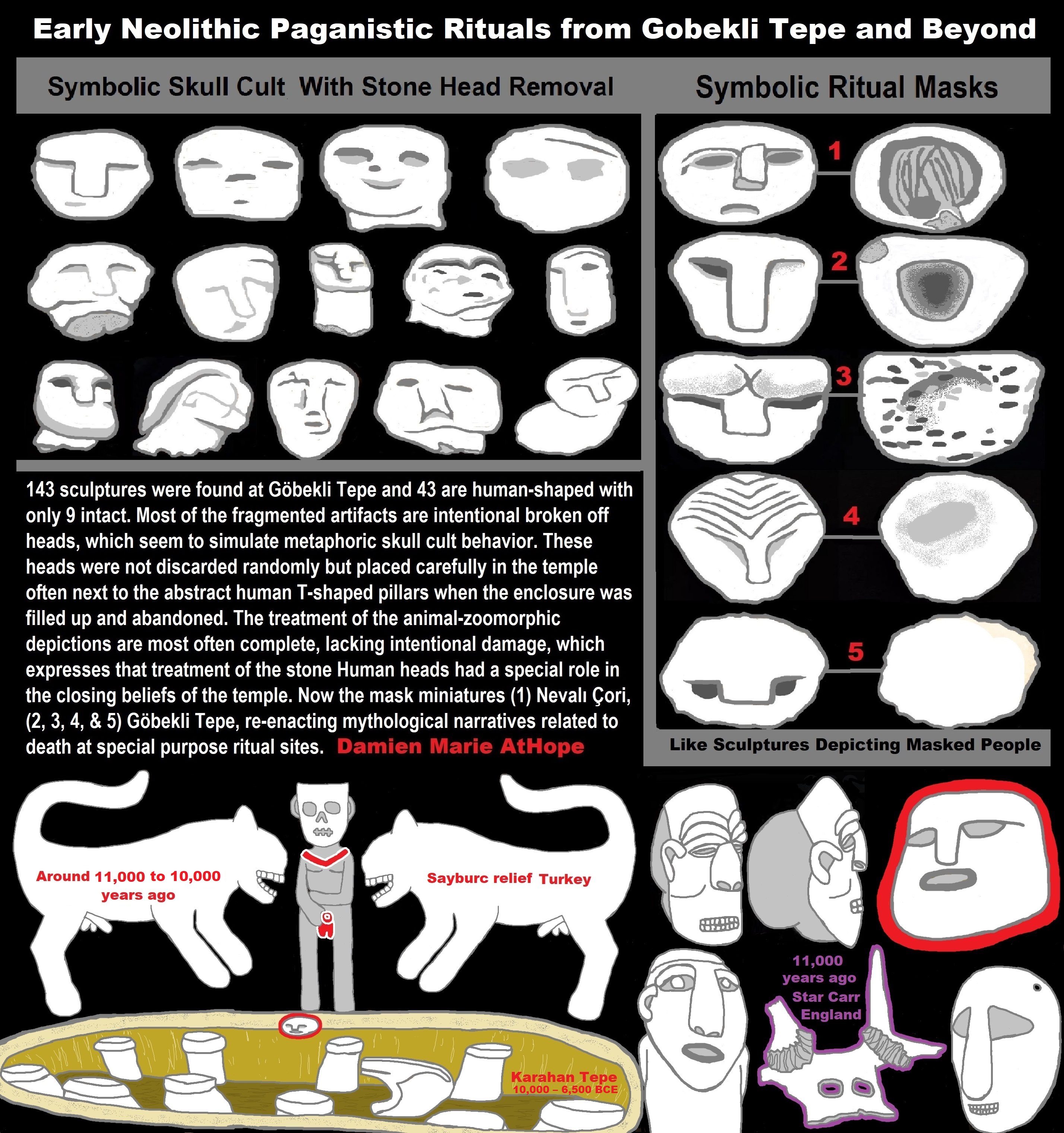
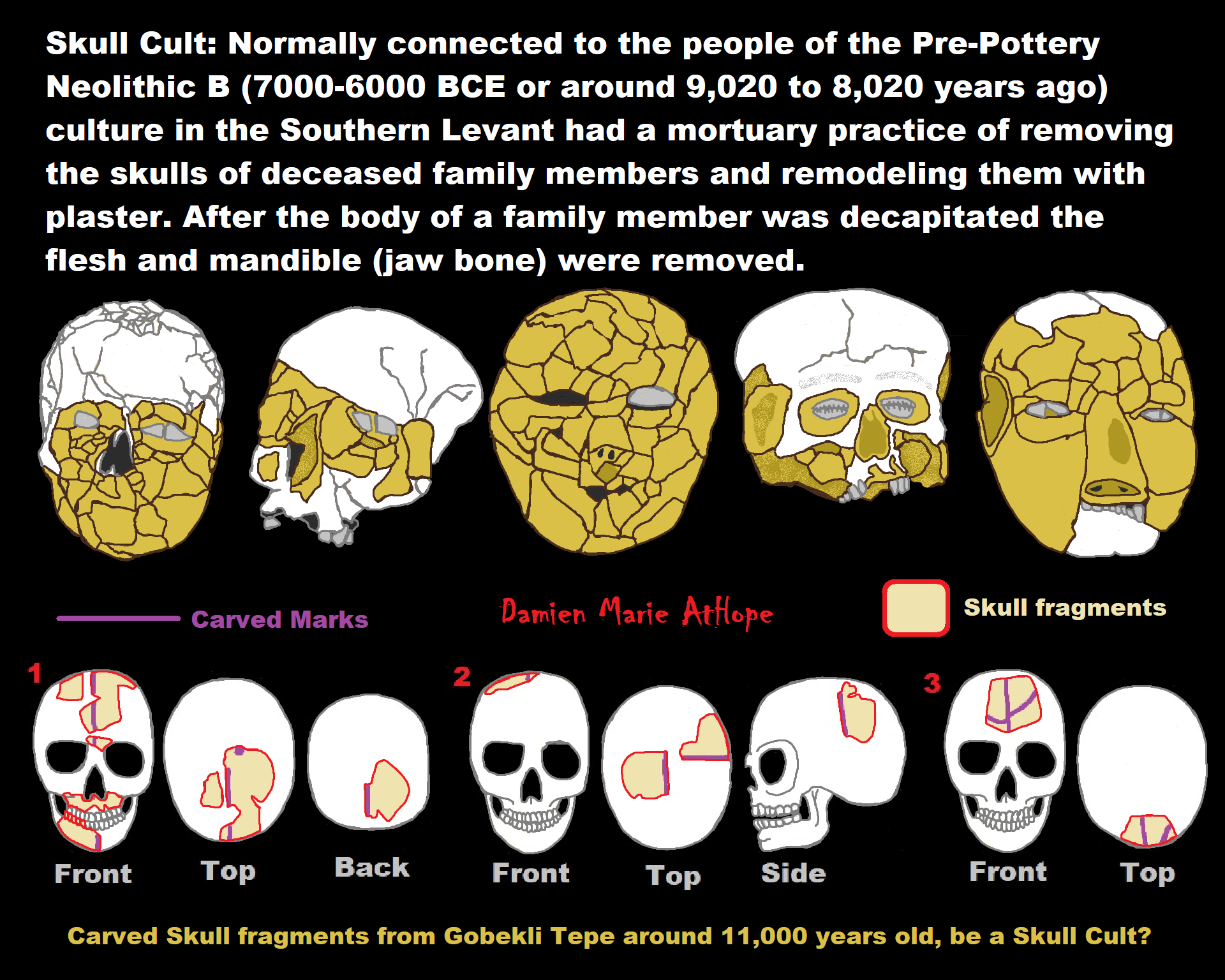
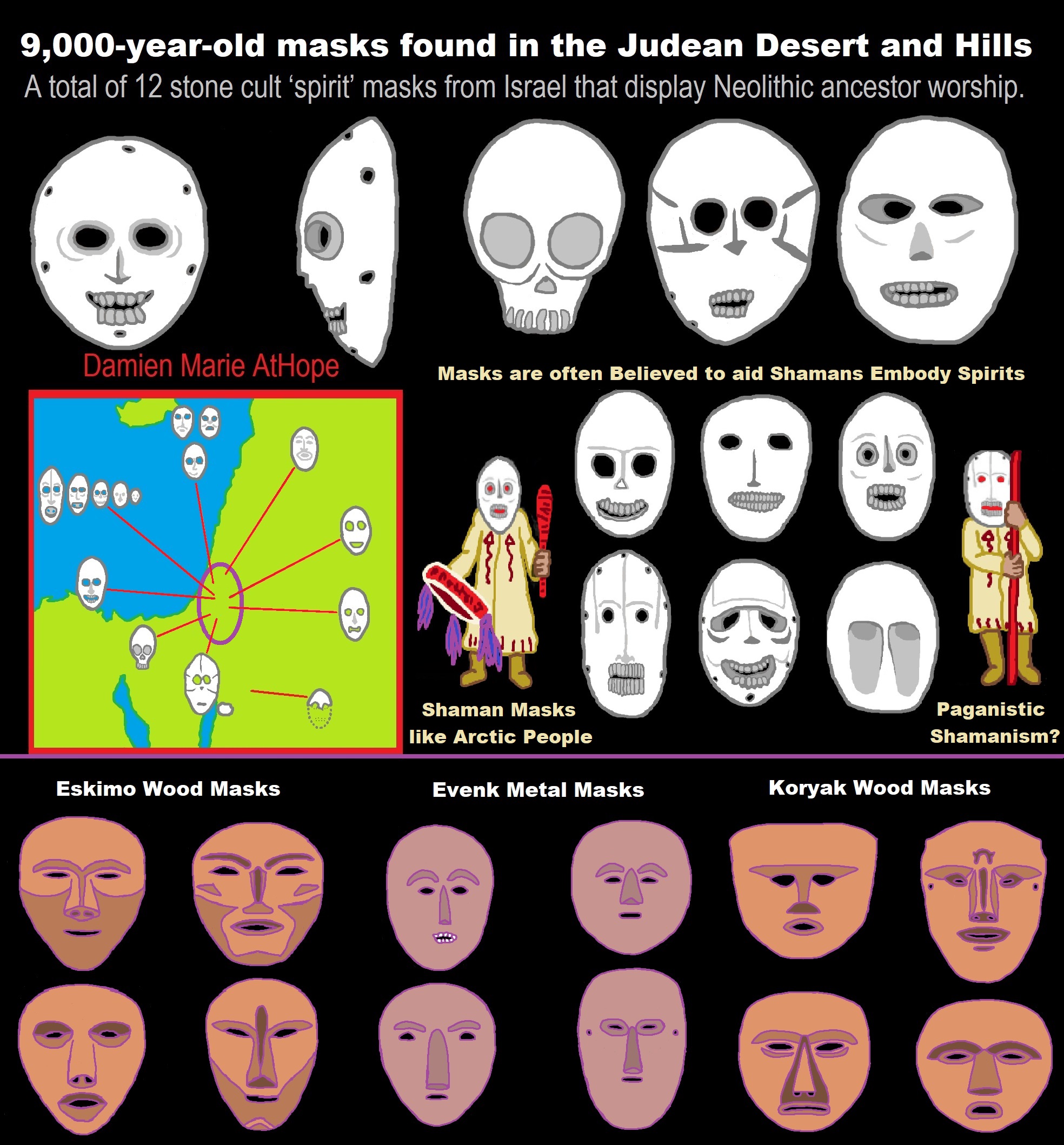

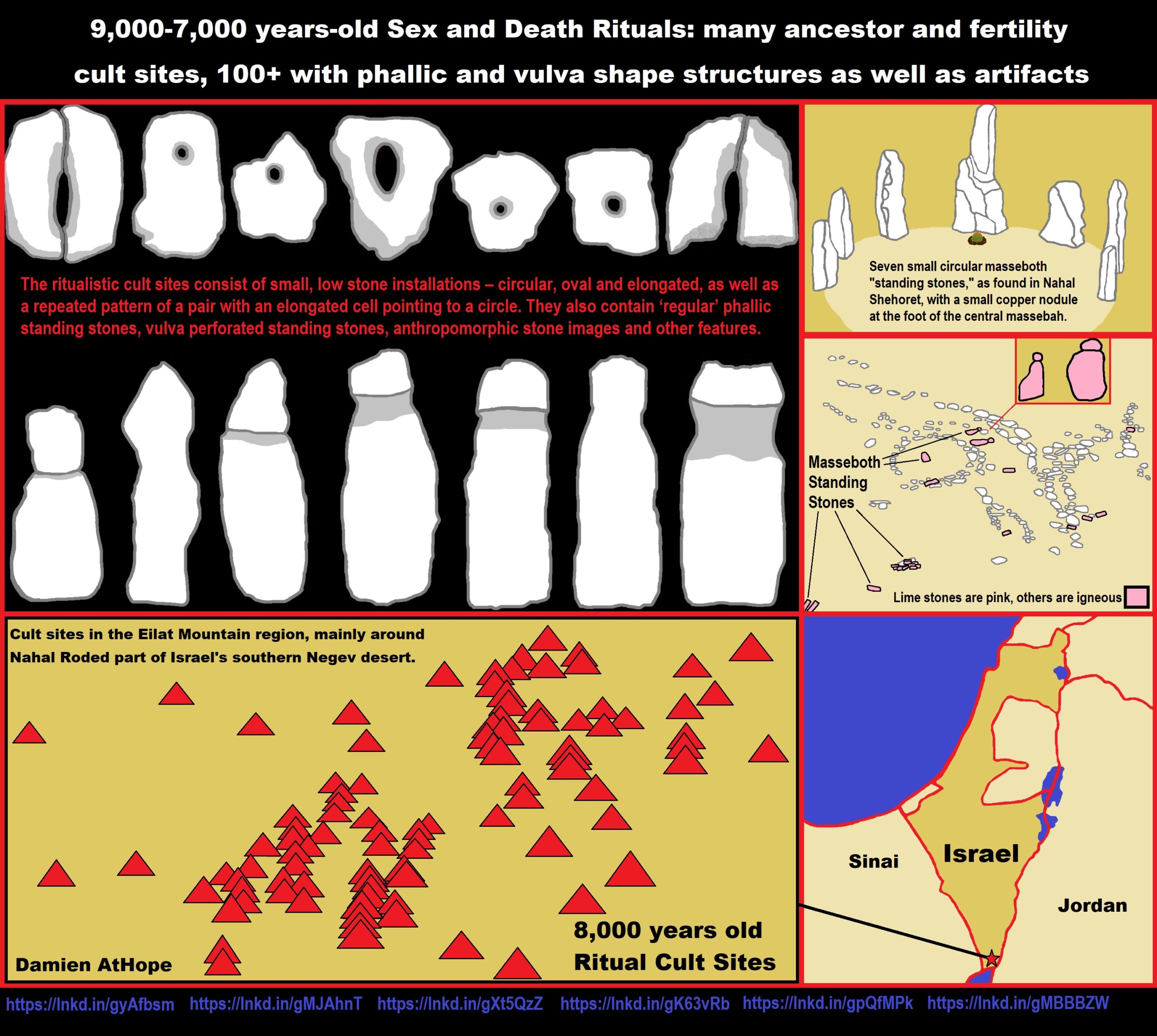
ref, ref, ref, ref, ref, ref, ref, ref, ref, ref, ref
9,000-7,000 years-old Sex and Death Rituals: many ancestor and fertility cult sites, 100+ with phallic and vulva shape structures as well as artifacts in Israel, Jordan, and the Sinai. The cult sites in the Eilat Mountain region, mainly around Nahal Roded part of Israel’s southern Negev desert. Artifacts and radiometric analyses indicate that an organized religion was firmly established in the area 9,120 to 8,900 years ago. The ritualistic cult sites consist of small, low stone installations – circular, oval and elongated, as well as a repeated pattern of a pair with an elongated cell pointing to a circle. They also contain ‘regular’ phallic standing stones, vulva perforated standing stones, anthropomorphic stone images and other features. Sites consist of small, low stone installations – circular, oval and elongated, as well as a repeated pattern of a pair with an elongated cell pointing to a circle. They also contain ‘regular’ phallic standing stones (Masseboth like European Menhir “standing stones”), vulva perforated standing stones, anthropomorphic stone images and other features. As shown in the main picture the seven small circular masseboth “standing stones,” as found in Nahal Shehoret, with a small copper nodule at the foot of the central massebah. Surface collection of flint artifacts include bidirectional blade cores and tools, flakes and ad-hoc tools, suggesting that the sites mainly date to the Pre-Pottery Neolithic B period. Although the majority of these sites is currently recorded in the Eilat mountains, they were also found in other regions of the Negev and in southern Jordan, and therefore they represent a broad phenomenon. Excavations at the Pre-Pottery Neolithic B ritual site of Naḥal Roded 110 in the Southern Negev, Israel, have revealed evidence—unique to this region—for on-site flint knapping and abundant raptor remains. ref, ref, ref, ref, ref, ref, ref, ref, ref, ref, ref
These stone installations may help us understand the very origins of Israelite religion. ref
1. “Regular standing stones (n=126) These are unshaped stone slabs, 10 to 80 cm tall, mostly of limestone, set vertically into the ground. They were usually set individually (75 stone slabs in 31 sites), but were also found as pairs (eight in seven sites), triads (three in three sites) one group of five and three groups of seven (in three sites). They are termed here “regular” for two reasons. One is that they are very common in desert cult installations, second is that they are distinguished from the perforated standing stones which are unique to these sites. Some of the standing stones were found in situ, vertically set or tilted, many were fallen or even broken.”
2. “Small perforated standing stones (n=72) These are stone slabs, up to 15×30 cm, mostly of limestone, with a bi-conical perforation below the top. The perforation was made first by chiseling and then smoothed, otherwise, the stones were unshaped. Seventy two such stones were found in 41 sites. They were rarely found in situ, usually fallen, sometimes broken, scattered or even discarded up to 30 m away from the sites.”
3. “Naturally holed stones (n=126) Limestone objects with natural holes, created by chemical weathering, are quite common on limestone surfaces and usually ignored. However, 126 of these were found in 32 sites built on igneous terrain and dozens were found set vertically into the ground. It is clear, therefore, that they were deliberately brought to the sites from some distance, due to unknown symbolic value related to them.”
4. “Anthropomorphic images (n=79) Anthropomorphic stone images, 12–46 cm high, are naturally elongated stones with a schematic human appearance; 79 images were found in 36 sites. On 26 stone images only a neck was carved by fine pecking, on 18 images the neck was made by minimal flaking, two were finely pecked all over the surface and 33 were unshaped, selected for their natural human silhouette. All but two were found tumbled; some were also broken in two. They were found lying within the installations or beside them, while some were discarded up to 30 m off the sites. Two stone images were found in situ in the circle of a regular pair. One was set upright, the other was buried, with only the very top visible on the surface (outside the core survey area stone images were found in situ in nine sites, in seven of them they were set in pairs).” ref
5. “Stones with elongated perforation (n=20) These are ca. 20×25 cm limestone slabs with a smoothed, elongated or pear-shaped perforation. Four complete ones were found in four sites, two halves and 14 fragments in 11 sites. One of the halves bears an engraving that resembles a snake. 6. Stone Bowls (n=22) Twenty two complete and broken stone bowls were found in 15 sites. They vary in workmanship, from totally natural bowls created by chemical weathering, to carefully shaped ones. Most bowls are made of limestone, 15–45 cm across; a few (fragmented) are of sandstone. It is of interest to note that some of the stone objects were found buried, so that only their very top was discernible on the surface. These included three regular standing stones in three different sites, one perforated standing stone and one anthropomorphic image. In addition, two perforated standing stones were found set with the perforation down and one anthropomorphic stone was incorporated in a vase-shaped installation with the head down. Since buried stones are barely discernible, this phenomenon may be more common in these cult sites.”
Masseboth “Pillars” or “Standing Stones” and in the Singular, Massebah
“On the small ridges there are “Roded type” cult sites characterized by slabs of lime stone which were brought from the seabed sediment range nearby.” ref
“Masseboth dot the landscape of the Bible’s desert lands. It s the Hebrew Bible that calls them masseboth; singular, massebah), usually translated as “pillars” or “standing stones.” They are unmistakably purposeful arrangements of carefully selected crude stones set vertically into the ground, individually or in groups, and are abundant in the desert. The Bible makes it clear that these standing stones had a pervasive, if ambiguous, cultic significance in early Israelite religion. In these shrines masseboth stand alone or in groups—pairs and triads are the most common, but groups of five, seven and nine also occur. Some are only a few inches tall while others are six feet and more. Most face east and many have at their base a carefully placed circular compartment or cell. Other features, such as offering benches, altars of different types and basins sometimes accompany masseboth. In addition to these independent sites, identical groupings of masseboth can be found at hundreds of tumuli (large stone heaps that mark a tomb) and in open-air sanctuaries.” ref
The Emergence of Masseboth and Their Bible Relations
“The earliest masseboth in the Near East are located in the Negev and the southern Jordan deserts and date to the 11th and 10th millennia B.C.E. (around 13,000-11,000 years ago) Masseboth became quite common from the sixth to the third millennia B.C.E. (around 8,000-4,000 years ago) and continued to be erected all through the Biblical period and later. In the fertile, non-desert areas of the Near East, however, they are much less common, especially at prehistoric sites; only in the second millennium B.C.E. (around 4,000-3,000 years ago) do their numbers significantly increase. The Bible and other ancient literature mention two types of masseboth: those representing gods and their abodes and those representing ancestral spirits.” ref
“Archaeology confirms the existence of both types; people in many traditional societies throughout the world still erect stones of the second type for their ancestors. In the ancient Near East the best-known reference to the ancestral massebah comes from The Tale of Aqhat, a narrative inscribed on 15th-century B.C.E. (3,500 years old) cuneiform tablets from Ugarit (on the Mediterranean coast of Syria). In the story, Dan-el, father of Aqhat, repeatedly complains to the gods that he “does not have a son to set up massebah in the temple in his name.” Although the translation of the last two words is controversial, the stone is clearly understood to contain and preserve the ancestral spirit.” ref
“One Biblical example is the story of Jacob at Beth-El. After he awakens from his dream of a ladder ascending to heaven, Jacob takes the stone that served as his pillow and sets it up, declaring, “This stone that I have set up as a pillar (massebah) shall be God’s house” (Genesis 28:22). He probably believed that the stone contained God’s power and spirit. Three inscribed basalt stelae or pillars were discovered near Sefire, Syria. These Sefire inscriptions, record an eighth-century B.C.E. (around 2,800 years ago) treaty between the vassal/king of Arpad and his overlord. The text, the longest intact inscription in Old Aramaic, contains over 100 legible lines. An introductory section invokes several well-known Syrian and Mesopotamian gods as witnesses to the treaty. It then identifies the stone pillars upon which the treaty is inscribed as the “house of god.” ref
“Later Arabian sources apply the same term, “house of god,” to standing stones. Similarly, a ninth-century B.C.E. (around 2,9,00 years old) Assyrian document describing King Tukulti Ninurta’s campaign to the Lebanon coast says that “he camped by the stones in which the great gods are dwelling.” Other masseboth offer variations on this theme. Some, by virtue of their divine authority, serve as witnesses to treaties and covenants; others oversee the fulfillment of vows and treaties, commemorate special events and bequeath divine protection upon territorial borders.” ref
Two Major Characteristics in Masseboth
*First, “in all groupings, the number of stones parallels the number of gods in various Near Eastern inscriptions, artistic representations and mythologies. Thus, a group of stones may represent a known group of gods.” ref
*Second, “a closer look reveals that most clusters of masseboth include stones of different shapes and proportions; moreover, the stones within a group are set in a symmetrical pattern or in some other order related to their shape.” ref
“For example, a group of seven stones at the top of Ma’aleh Jethro, east of the Uvda Valley, is set in a distinct pattern of alternating broad and narrow stones (see “Desert Masseboth: A Gallery of Types”). The stones were brought from some distance and obviously carefully selected, so we must assume some purpose or concept lay behind this arrangement. A similar relationship between broad and narrow stones or tall and short stones is found in other groups. Perhaps a narrow or tall stone represented a god and a broad or shorter stone represented a goddess.” ref
The 7,000 year old Masseboth Leopard Temple of Uvda
Picture Link: ref
“In the Uvda basin in the desert of southern Israel sits a 7,000 year old Temple. Here at the heart of the agricultural revolution, before the written word or any organized religion as we know it today, a small group of people began to settle in one place to cultivate crops and animals. They also began to worship something, perhaps the sun, perhaps their own ancestors, and intriguingly, perhaps the local scourge, the wild leopard. Leopards in Israel are an indigenous subspecies, the Judean Leopard and can still be spotted in the Judean Desert.” ref, ref
A Holy Trinity of Masseboth
“A triad of masseboth attached to a fourth-millennium B.C.E. (around 6,000 years ago) tumulus in Wadi Zalaqa, eastern Sinai, includes a large, broad central stone with a smaller stone on either side. Many sites from various periods contain this arrangement, as do numerous more explicit iconographic equivalents. For example, a carved ivory box lid from Ugarit, Mycenaean in origin, shows a broad-hipped goddess feeding two ibexes, which represent young gods. This same arrangement can be seen in paintings on pottery. A similar triad of Canaanite and Egyptian gods can be seen in a New Kingdom Egyptian stela, in which the Canaanite goddess Qudshu stands on a lion, with the male gods Min and Reshef on either side. Painted jars found at Kuntillet ‘Ajrud in the eastern Sinai show a stylized tree mounted on a lion’s back; like the goddess on the Egyptian stela, the tree is flanked by two ibexes, again symbolizing the young deities. This example, which dates to the ninth or eighth century B.C.E. (around 2,900-2,800 years ago), is especially interesting because, although the tree represents the pagan Asherah,* Israelites apparently drew the picture.” ref
Masseboth Sacred Pairs
Pairs of masseboth are also common and usually follow consistent patterns. An early one fifth to fourth millennium B.C.E. (around 7,000-6,000 years ago) stands at a site near Giv’at Shehoret, north of Eilat. The massebah on the left side, through the viewer’s eye, is tall and narrow, while the one on the right is short and rounded. When seen from the viewpoint of the gods within the stones, however, the shorter one stands to the left of the taller one. Out of 24 sets of paired masseboth found to date, the right stone (from the viewpoint of the stones) is the larger in 22 cases. This pattern also shows up in more explicit depictions of male-female couples, a sure indication that the positioning of the masseboth is not accidental. It was found in 72 percent of 125 couples randomly selected from ancient Near Eastern figurative art (most of the other 28 percent had a reason to stand reversed). Placing the male on the right and the female to his left is comparable to Biblical references of male names before female names (“Adam and Eve”, “Ba’al and Asherah,” etc.).” ref
“Two passages in the Song of Songs also reflect this relationship: The woman says of her lover, “His left arm was under my head, his right arm embraced me” (Song of Songs 2:6, 8:3). Many clay and stone votive plaques vividly echo the imagery of these passages. Another drawing from Kuntillet ‘Ajrud may also correspond to this pattern. Many scholars have attempted to identify two figures on one of the jars found at the site. Some suggest that they are Egyptian deities; others opt for the Israelite God Yahweh and his consort. Above the two figures is a Hebrew inscription that mentions “Yahweh of Samaria and his Asherah.” ref
Bible Goddess Asherah (God’s Wife)
“The word “Asherah” occurs about 40 times in the Hebrew Bible. Scholars wonder if these figures represent Egyptian gods or Yahweh and his consort; they are also unsure whether the Hebrew inscription above the drawing means “Yahweh and his sacred place,” “Yahweh and his symbol” or “Yahweh and his consort.” The pairs of masseboth that we have been examining support the view that the ‘Ajrud figures do represent Yahweh and the goddess Asherah, the former wearing a bull mask and the latter that of a cow. Masseboth from the Biblical period (Iron Age) have been found in at least 36 sites, several of which are surely Israelite. One pair of masseboth found in the eighth- to seventh-century B.C.E. (around 2,800-2,700 years ago) Israelite temple excavated at Arad in the northern Negev displays the same relationship of “male” to “female” and probably represents a pair of deities. At Arad there can be no doubt that the temple is Israelite because on two small ostraca (inscribed potsherds) found there are “Pashhur” and “Mremot,” the names of two Israelite priestly families who served there.” ref
“The recurrent pattern in the positioning of pairs of masseboth and in representations such as the Kuntillet ‘Ajrud drawing lead us to conclude that the pair of masseboth in the Arad temple represents a pair of deities. This means that masseboth were used in an official Israelite temple (and not simply as part of popular Israelite religion, if such a distinction ever existed).** When Yohanan Aharoni excavated the Israelite temple at Arad, he concluded that the Holy of Holies of the temple with its masseboth was eliminated during the religious reform of King Hezekiah late in the eighth century B.C.E. (around 2,800 years ago)with a wall being built on top of it much later, during the Hellenistic period. A remaining point of debate is whether the Babylonians destroyed the Arad temple with its masseboth in 586 B.C.E. (2,586 years ago) or whether Edomites destroyed it a few years earlier when they invaded southern Judah. In either case, the massebothat Arad survived the religious reforms both of Hezekiah in the eighth century B.C.E. (around 2,800-2,700 years ago), and of King Josiah in the seventh century B.C.E (around 2,700-2,600 years ago).” ref
The Bible is Hot and Cold on Sacred Masseboth
“The Bible itself expresses ambivalent or even contradictory attitudes toward masseboth (see “Does the Bible Disapprove of Masseboth?“) In many places, the Bible vehemently denounces the masseboth because they represent pagan cults and polytheism. Thirteen different passages demand their destruction in order to separate Israel from the cult and customs of the Canaanites. The Bible is cold on sacred masseboth, Deuteronomy 12:3-4 reads: “You shall destroy all the places wherein the nations worship their gods … You shall tear down their altars and smash their masseboth and burn their Asherim.” Three other passages absolutely prohibit masseboth: “You shall not erect a massebah that Yahweh your lord hates” (Deuteronomy 16:22; see also Leviticus 26:1; 2 Chronicles 31:1).” ref
“On the other hand, other passages mention masseboth with no condemnation at all. Like the massebah Jacob erected at Beth-El; in a cultic act, he poured oil on the massebah and called it Beth Elohim, “House of God” (Genesis 28:17-18). He then made a vow to Yahweh. The Bible is hot on sacred masseboth, when Jacob, in repetition, returned to Beth-El and God told him that henceforth his name would be Israel, Jacob set up a massebah and poured oil on it (Genesis 35:14). Moses erected twelve masseboth at the foot of Mt. Sinai and made a sacrifice to Yahweh there during the ceremony of signing the covenant between Yahweh and the Israelite people (Exodus 24:4-8). Joshua set up a “great stone” (even gedolah) under the sacred terebinth*** in Yahweh’s sanctuary at Shechem to renew the covenant the people had just made with Yahweh, their God (Joshua 24:26-27).” ref
“When the Philistines were forced to return the Ark of the Covenant that they had captured, the Levites offered sacrifices to Yahweh before “the great stone” at Beth Shemesh (I Samuel 6:14-15). Samuel set up a stone called even ha-ezer (the “stone of help”) in gratitude for God’s help in protecting the Israelites from the Philistines (1 Samuel 7:12). In 1 Kings 3:4 we are told that Solomon sacrificed a thousand burnt offerings at Gibeon. The text makes no mention of a massebah, but we learn elsewhere that there was also a “great stone” at Gibeon (2 Samuel 20:8). In 2 Chronicles 1:3 we find that the Tent of Meeting Moses had made in the wilderness reposed at Gibeon. It is not surprising, therefore, that King Solomon went here to sacrifice at the “large bamah.” There is no hint of condemnation of the “great stone” of Gibeon.” ref
“Despite his aggressive religious reform against the bamot (high places), King Josiah himself renewed the covenant between Yahweh and the people “at the ‘amud” (pillar) (2 Kings 23:3; 2 Chronicles 34:31). This covenant ceremony resembled the covenant at Shechem mentioned above, as well as other Near Eastern examples in which masseboth witness the signing of treaties. Even in the books of the prophets, where we might most expect to find them, there are almost no words of condemnation of the masseboth, great stones or sacred pillars. On the contrary, in a couple of places they even seem to be approved. For example, while condemning Egypt and predicting that someday the Lord will be worshiped there, Isaiah foretells: “In that day, there shall be an altar to Yahweh inside the land of Egypt and a pillar (massebah) to Yahweh at its border” (Isaiah 19:19). One possible exception to approval by the prophets may be a sarcastic comment in Jeremiah, where the prophet castigates the people for worshiping other gods (he does not specifically mention masseboth), “They [the Israelites] said to wood, ‘You are my father,’ to stone, ‘You gave birth to me’” (Jeremiah 2:27).” ref
“Especially surprising is that all these references to masseboth are directly connected with the name of Yahweh and his cult. Moreover, these references survived the Deuteronomistic editing (in Deuteronomy, Joshua, Judges, Samuel and Kings) of the late seventh century B.C.E., even though Deuteronomistic theology demanded devotion to Yahweh alone, only in Jerusalem, and with many strict prohibitions. After all, Deuteronomy tells us that Yahweh “hates” masseboth (Deuteronomy 16:22). It is speculated that masseboth were deeply rooted in the Israelite cult and culture throughout the First Temple period (c. 960-586 B.C.E. around 2,960-2,586 years ago). This was not because of Canaanite influence, but rather because of the common desert origin of both the masseboth cult and the major body of Israelite religion.” ref
Masseboth and Desert Magic
“In the desert almost all masseboth are crude, natural, unhewn stones, while in the fertile lands of the Near East the majority of masseboth are stones that were deliberately shaped. Desert peoples clearly had the technical capability of shaping stones, had they wanted to. Indeed, two out of three masseboth dated to the 11th millennium B.C.E. (around 13,000 years ago-12,000 years ago) were carefully shaped, although the later ones were not. Hence desert massebothreflect a principle enunciated in several Biblical passages: “If you make for me an altar of stones, do not build it of hewn stones; for by wielding your tool upon them you have profaned them” (Exodus 20:22; see also Deuteronomy 27:6; Joshua 8:31; 1 Kings 6:7). Crude stones, shaped by nature or God and not by man, were specifically chosen for cult purposes both for the prehistoric desert people and later for the Israelites. Masseboth are therefore an abstract representation of gods, directly associated with aniconic theology, which bans the portrayal of gods in human or animal form. This followed a desert tradition that later developed in Israel into “programmatic aniconism,” as Tryggve Mettinger has termed it, embedded in Deuteronomistic theology. The aniconism of prehistoric desert religion and of Israel also characterized later Nabatean and Muslim religions, both of which have desert roots.” ref
“Around 89 percent of the desert masseboth face east, which means that they follow a dominant sacred orientation. In the fertile areas, on the other hand, only 38 percent face east. The desert masseboth appear in attached, ordered groups, consistent in numbers and shapes; those in the sown areas are usually detached and inconsistent in numbers, orientation and relative position. Israelite culture and religion had deep roots in the desert, and these desert roots shaped Israelite consciousness, as many studies have shown. Even during the Israelite monarchy a “desert ideal” still prevailed. An interesting episode occurred in the last days of the Judahite kingdom that the Babylonians destroyed in 586 B.C.E. (around 2,586 years ago).” ref
“On instructions from the Lord, the prophet Jeremiah took to the Temple the Rechabites, a group probably originating in the Negev, who had joined the Israelites. The Rechabites are held up as an ideal example of obedience to the law. The text describes them as living in tents, not houses, and without agriculture. Jeremiah offers them wine but they refuse, for that is against their law. Long after leaving the desert they still lived by its ideals. Jeremiah then proclaims to the Israelites in the name of the Lord, “You can learn a lesson about obeying my commands [from the desert Rechabites]” (Jeremiah 35:13). In short, the Rechabites are praised because they preserved the “desert ideal.” Israel’s god Yahweh clearly originated as a desert god. In addition to the theophany at Sinai, various Biblical passages associate Yahweh directly with the desert. For example: “Yahweh came from Sinai; He shone upon them from Seir; He appeared from Mount Paran” (Deuteronomy 33:2; see also Judges 5:4-6; Habakkuk 3:3; Psalms 68:8-9). These are all desert sites.” ref
“Yahweh is associated with the desert even in Egyptian records. Three Egyptian inscriptions found in Egypt and Nubia (modern Sudan), dating to the 14th and 13th centuries B.C.E. (around 3,400-3,300 years ago), mention various districts in the desert. One is “the land of [nomad tribe] Shasu [named] YHW in the land of Seir.” So even before the Israelite Exodus from Egypt (assuming a 13th-century B.C.E. Exodus) some desert tribes in Seir (that is, Sinai, the Negev and Edom) named their territory after Yahweh. In Israel the only sacred orientation was east. The tabernacle faced east; the temple of Arad faced east; and so did the First and Second Temples in Jerusalem. The dominant orientation of desert masseboth, as we have seen, is also east, but in the sown land all over the Near East during all periods both masseboth and temples are oriented in various directions. The sacred eastern orientation, therefore, is only shared by desert masseboth and Israelite cult places.” ref
9,000-7,000 years-old Sex and Death Rituals: Cult Sites in Israel, Jordan, and the Sinai

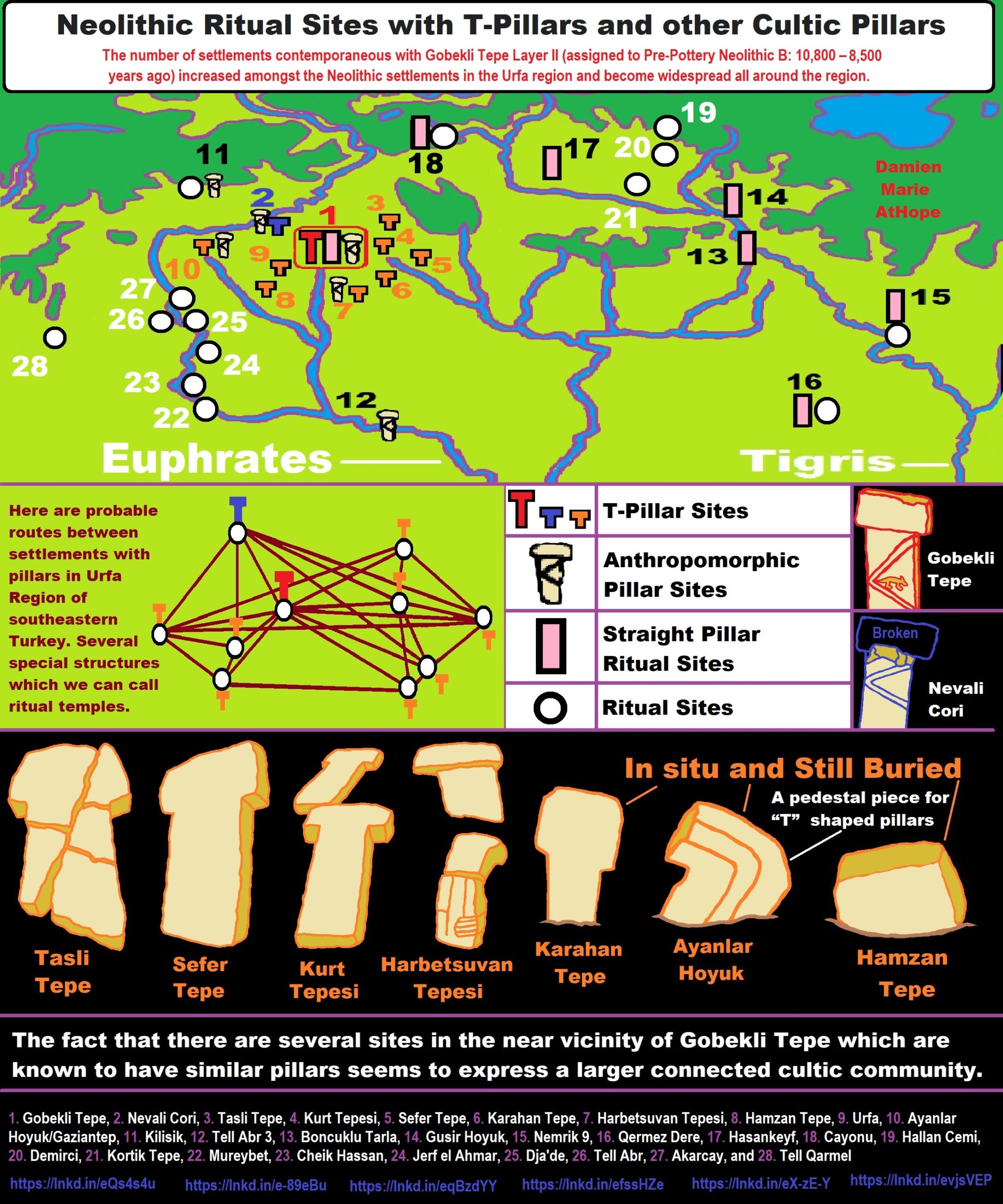
The number of settlements contemporaneous with Gobekli Tepe Layer II (assigned to Pre-Pottery Neolithic B: 10,800 – 8,500 years ago) increased amongst the Neolithic settlements in the Urfa region and become widespread all around the region.
- Gobekli Tepe, 2. Nevali Cori, 3. Tasli Tepe, 4. Kurt Tepesi, 5. Sefer Tepe, 6. Karahan Tepe, 7. Harbetsuvan Tepesi, 8. Hamzan Tepe, 9. Urfa, 10. Ayanlar Hoyuk/Gaziantep, 11. Kilisik, 12. Tell Abr 3, 13. Boncuklu Tarla, 14. Gusir Hoyuk, 15. Nemrik 9, 16. Qermez Dere, 17. Hasankeyf, 18. Cayonu, 19. Hallan Cemi, 20. Demirci, 21. Kortik Tepe, 22. Mureybet, 23. Cheik Hassan, 24. Jerf el Ahmar, 25. Dja’de, 26. Tell Abr, 27. Akarcay, and 28. Tell Qarmel
Göbekli Tepe is not alone, in fact, it is part of a religious/cultural connected ritual culture in the general region. There are several other similar sites with similar T-pillars to Göbekli Tepe or other types of stone pillar providing a seeming connected cult belief or religious culture of pillars seen in the PPNA-PPNB in the northern portion of the Near East.
“The locations of the sites that contain “T” shaped pillars are the main topic that needs more understanding to grasp the larger sociocultural-religious cultural complex in the same general region. Another matter under discussion is to comprehend the differences between the small-scale settlements that contain cult centers and “T” shaped pillars and the larger ones found at Gobekli Tepe layer III. The fact that settlements with “T” shaped pillars contain both the remains of circular domestic buildings and the pillars such as seen at Cayonu and Nevali Cori, which are also known to contain cult and domestic buildings. It is contemplated that such settlements are contemporary with Gobekli Tepe layer II and the cult building known from Nevali Cori based on the similarities and differences of the “T” shaped pillars. In the light of the finds unearthed from the settlements in Şanliurfa region that contain “T” shaped pillars, such settlements should be dated to the end of Late Pre-Pottery Neolithic A (LPPNA) and the Early Pre-Pottery Neolithic B (EPPNB).” ref
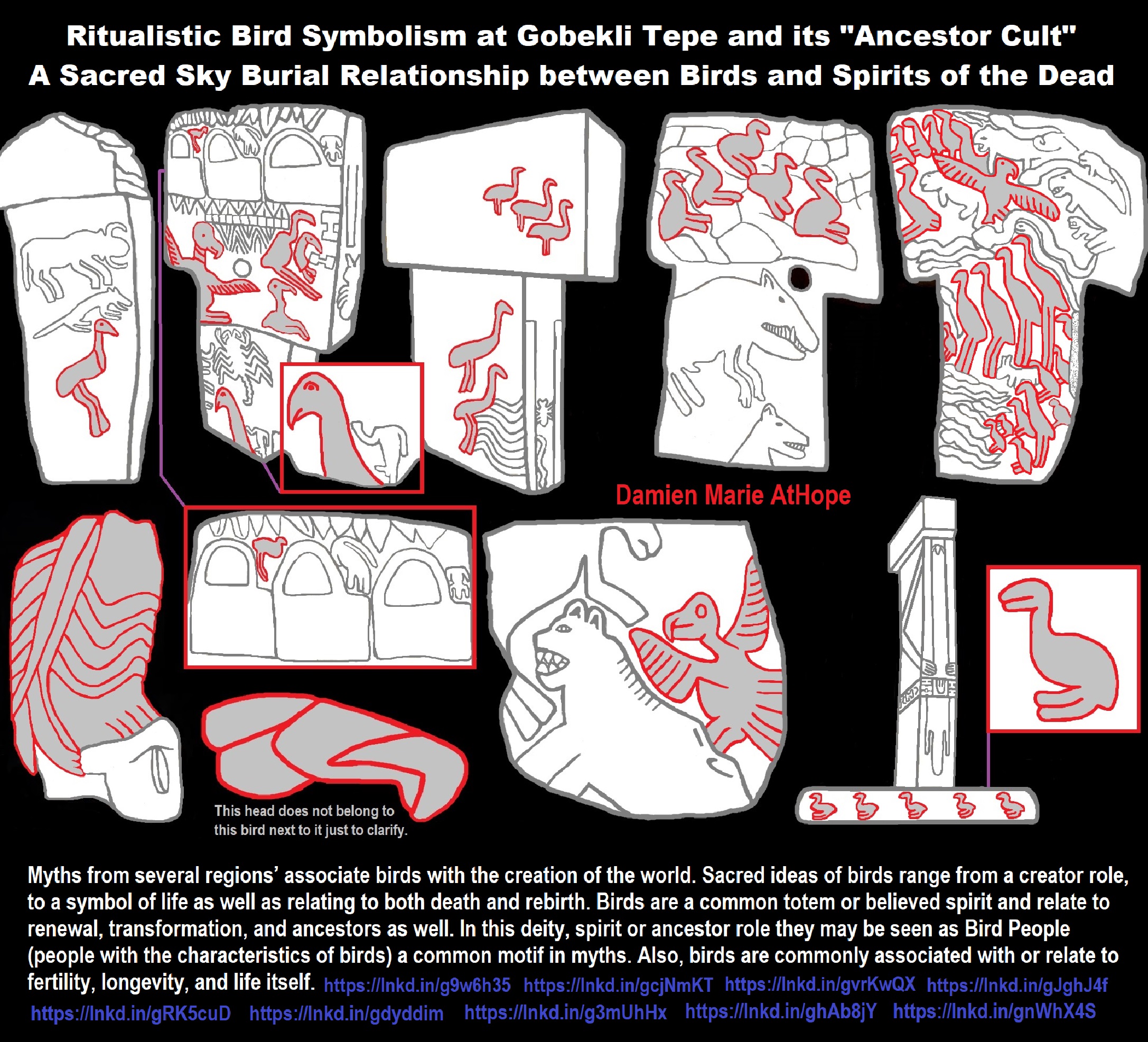
ref, ref, ref, ref, ref, ref, ref, ref, ref, ref, ref, ref, ref, ref, ref, ref, ref
Skulls From 11,500-year Ancestor Cult Found in Oldest Temple in the World
“Carved skulls indicate that Gobekli Tepe, known for enigmatic monumental pillars carved with animals and shapes, was ancestor worship site.” ref
“Ancestor Cult: a ritualistic system of veneration, honor, and propitiation of the spirits of dead ancestors for the purpose of avoiding evil consequences and securing good fortune.” ref
“Ancestor worship: the custom of venerating deceased ancestors who are considered still a part of the family and whose spirits are believed to have the power to intervene in the affairs of the living.” ref
“Veneration of the dead, including one’s ancestors, is based on love and respect for the deceased. In some cultures, it is related to beliefs that the dead have a continued existence, and may possess the ability to influence the fortune of the living. Some groups venerate their direct, familial ancestors. Certain sects and religions, in particular the Roman Catholic Church, venerate saints as intercessors with God, as well as pray for departed souls in Purgatory. In Europe, Asia, Oceania, African and Afro-diasporic cultures, the goal of ancestor veneration is to ensure the ancestors’ continued well-being and positive disposition towards the living, and sometimes to ask for special favors or assistance. The social or non-religious function of ancestor veneration is to cultivate kinship values, such as filial piety, family loyalty, and continuity of the family lineage. Ancestor veneration occurs in societies with every degree of social, political, and technological complexity, and it remains an important component of various religious practices in modern times.” ref
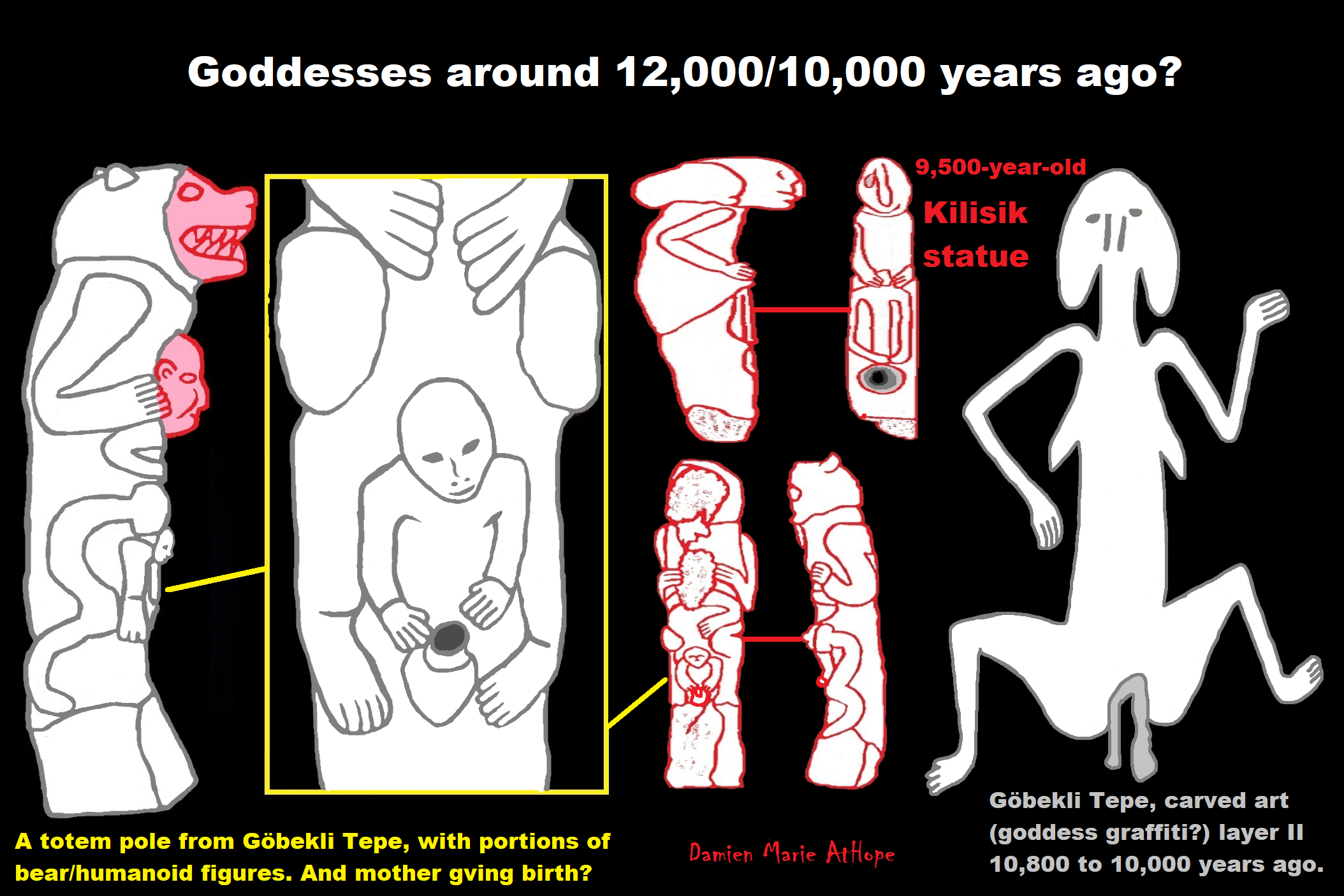

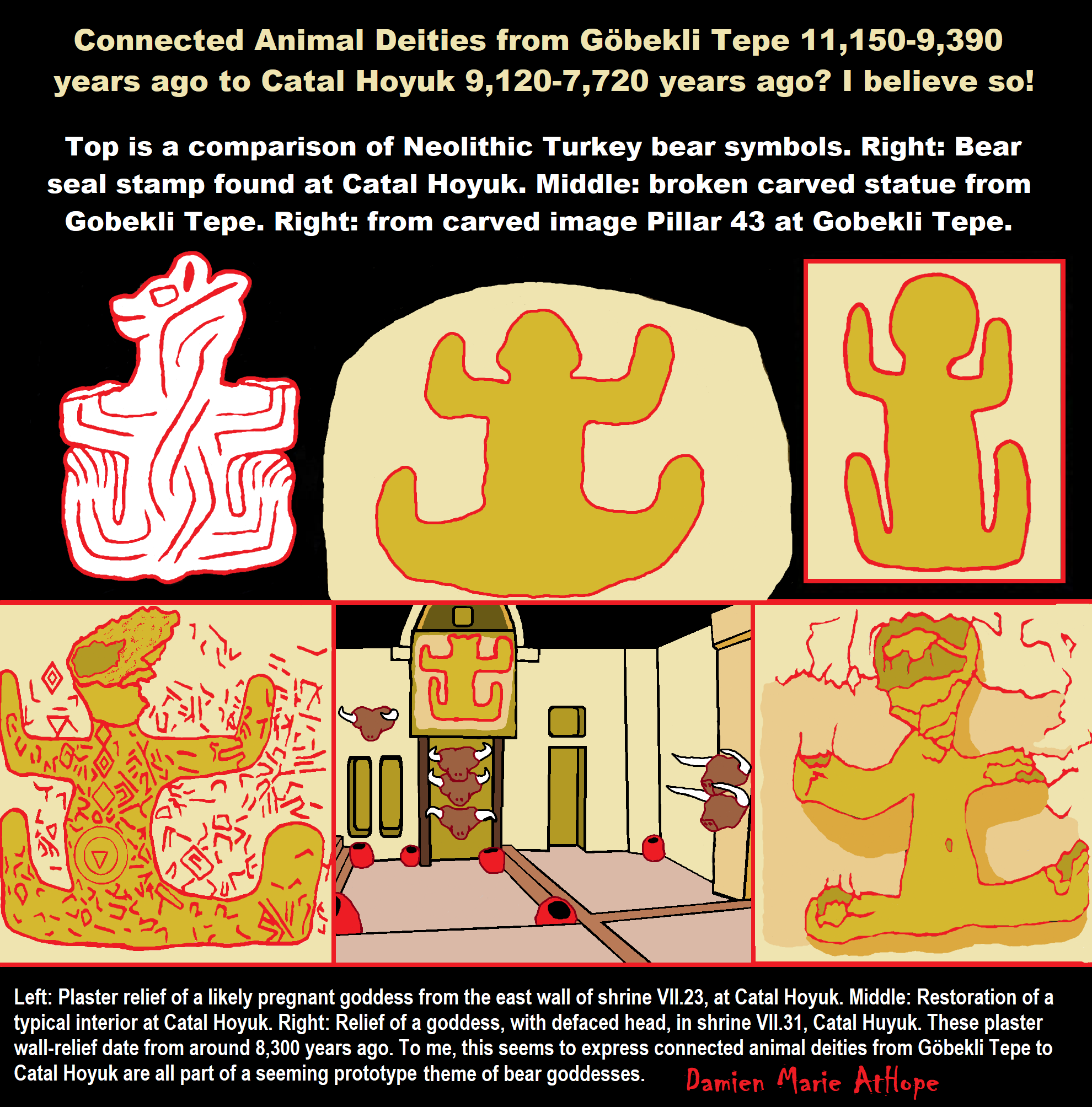
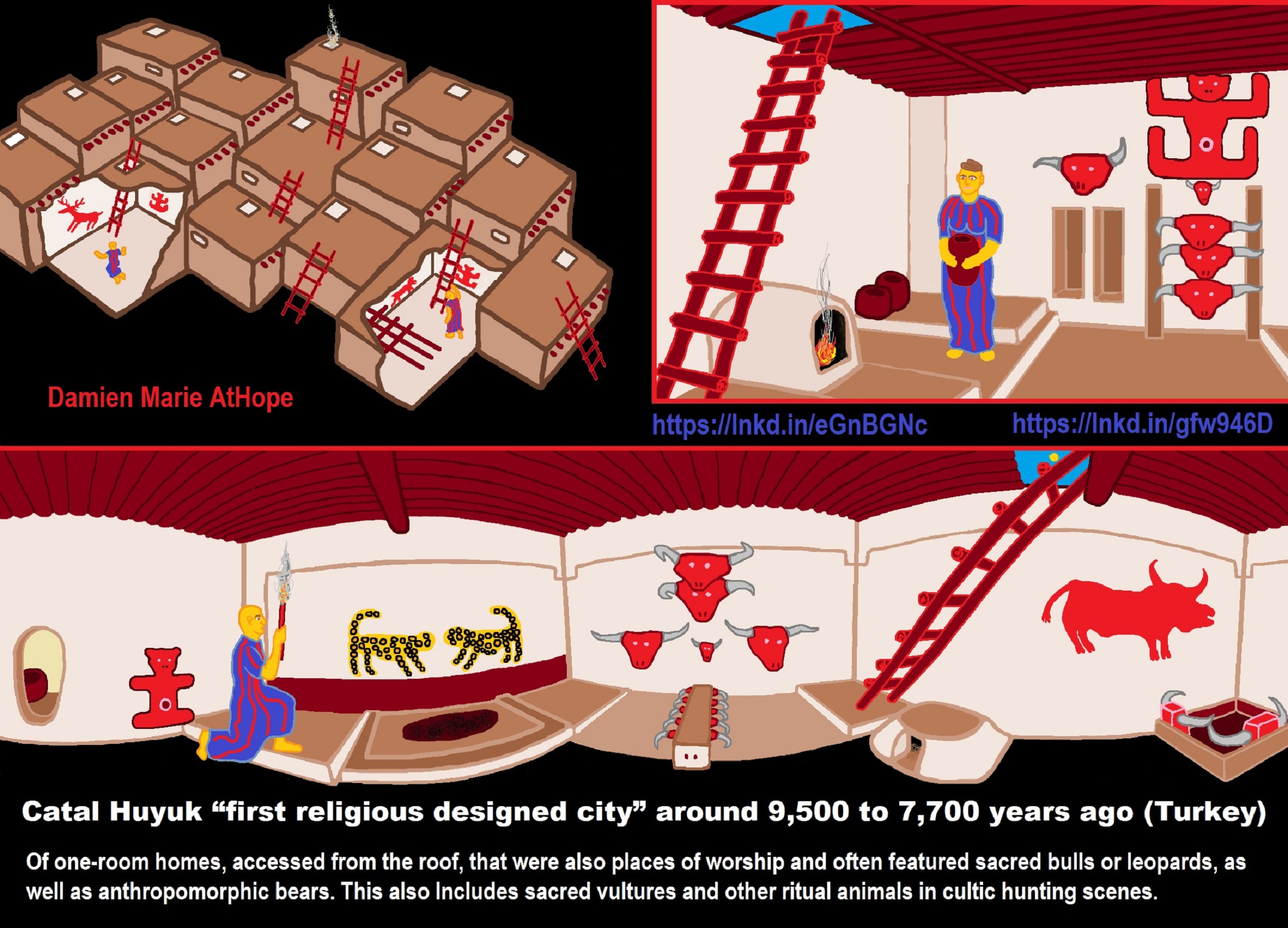
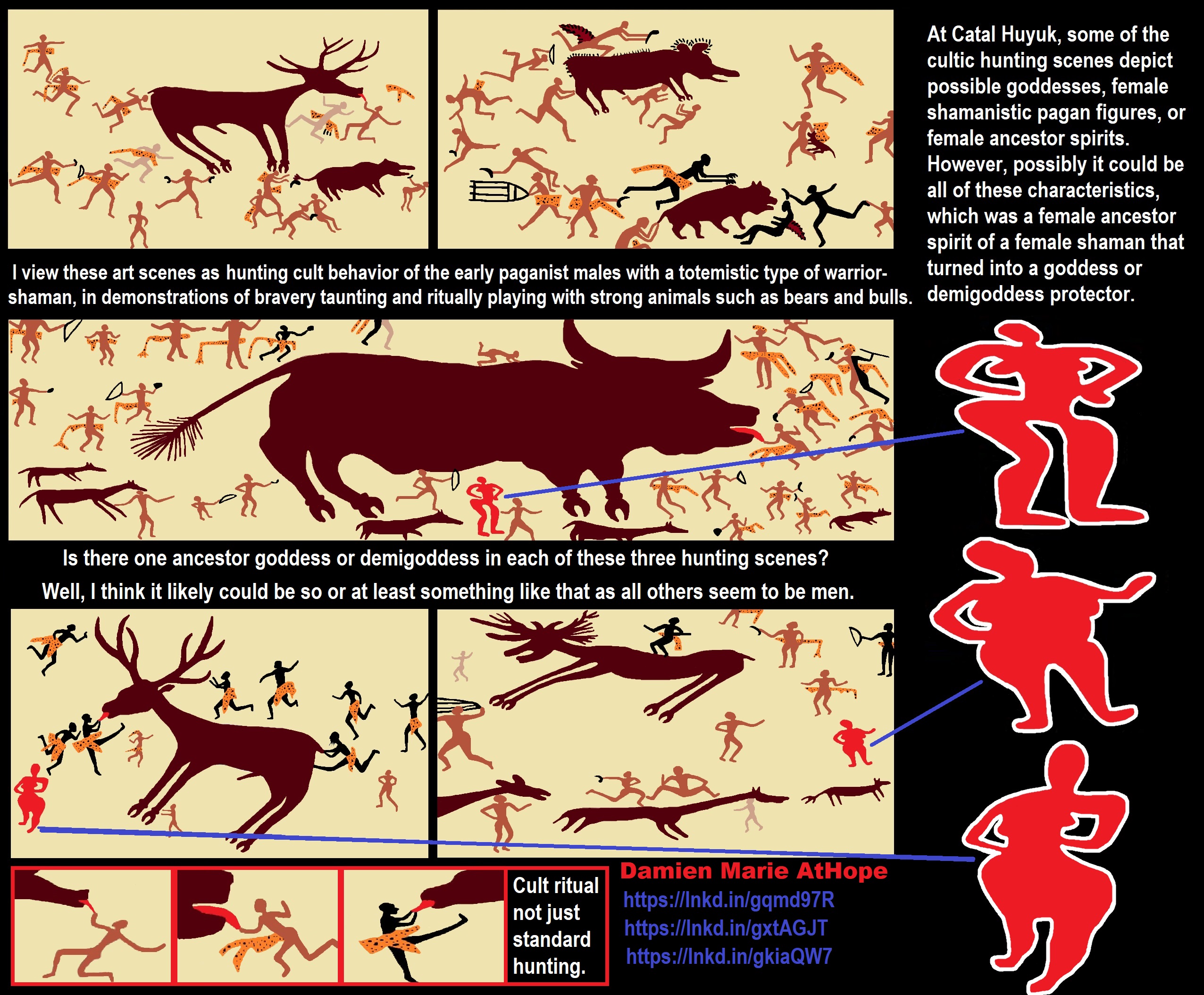
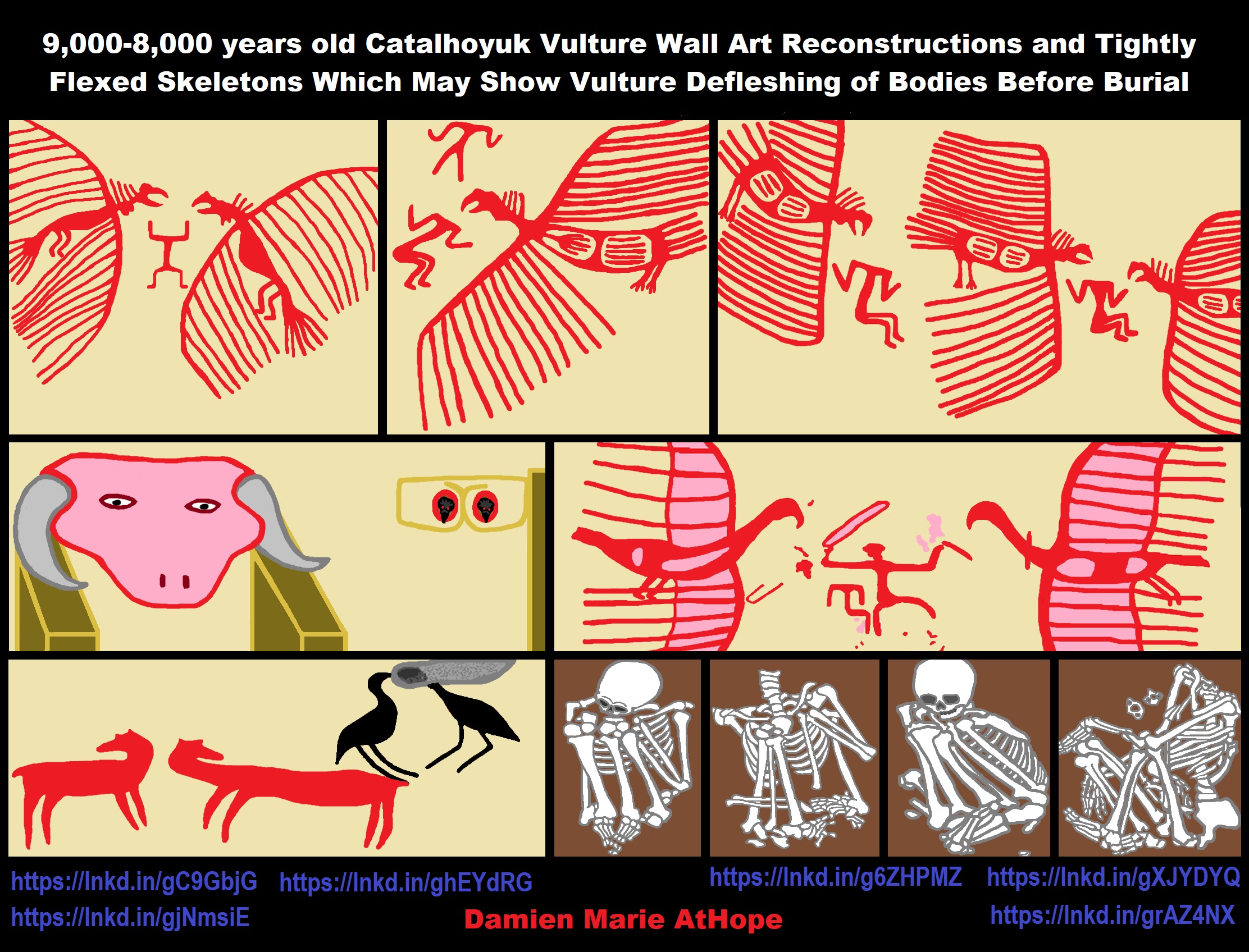

ref, ref, ref, ref, ref, ref, ref, ref
Sky Burials: Animism, Totemism, Shamanism, and Paganism
“In archaeology and anthropology, the term excarnation (also known as defleshing) refers to the practice of removing the flesh and organs of the dead before burial, leaving only the bones. Excarnation may be precipitated through natural means, involving leaving a body exposed for animals to scavenge, or it may be purposefully undertaken by butchering the corpse by hand. Practices making use of natural processes for excarnation are the Tibetan sky burial, Comanche platform burials, and traditional Zoroastrian funerals (see Tower of Silence). Some Native American groups in the southeastern portion of North America practiced deliberate excarnation in protohistoric times. Archaeologists believe that in this practice, people typically left the body exposed on a woven litter or altar.” ref
Ancient Headless Corpses Were Defleshed By Griffon Vultures
Sky burial ( Animal Worship mixed with Ancestor Worship) is a funeral practice where a human corpse is placed on a mountaintop, elevated ground, tree, or constructed perch to decompose while be eaten by scavenging animals, especially birds. This Animal Worship (or Zoolatry) rituals may go back to the Neanderthals who seem to Sacralize birds starting around 130,000 years ago in Croatia with eagle talon jewelry and oldest confirmed burial. Or possible (Aurignacian) “Bird Worship” at Hohle Fels cave, Germany, early totemism and small bird figurine at around 33,000 years old, which had been cited as evidence of shamanism.
As well as possible ‘Bird Worship’ (in the Pavlovian culture/Gravettian culture) part of Early Shamanism at Dolní Věstonice (Czech Republic) from around 31,000-25,000 years ago, which held the “first shaman burial.” The shamanistic Mal’ta–Buret’ culture of Siberia, dating to 24,000-15,000 years ago, who connect to the indigenous peoples of the Americas show Bird Worship. The Magdalenian cultures in western Europe, dating from around 17,000-12,000 years ago have a famous artistic mural with a bird that I think could relate to reincarnation and at least bird symbolism. Likewise, there is evidence of possible ‘Bird Worship’ at Göbekli Tepe (Turkey), dated to around 13,000/11,600-9,370 Years ago with “first human-made temple” and at Çatalhöyük (Turkey), dated to around 9,500-7,700 Years ago with “first religious designed city” both with seeming ancestor, animal, and possible goddess worship.
The Tibetan sky-burials appear to have evolved from ancient practices of defleshing corpses as discovered in archeological finds in the region. These practices most likely came out of practical considerations, but they could also be related to more ceremonial practices similar to the suspected sky burial evidence found at Göbekli Tepe (11,500 years ago) and Stonehenge (4,500 years ago). ref


ref, ref, ref, ref, ref, ref, ref, ref, ref, ref, ref, ref, ref, ref
1. Kebaran culture 23,022-16,522 Years Ago, 2. Kortik Tepe 12,422-11,722 Years Ago, 3. Jerf el-Ahmar 11,222 -10,722 Years Ago, 4. Gobekli Tepe 11,152-9,392 Years Ago, 5. Tell Al-‘abr Ubaid and Uruk Periods, 6. Nevali Cori 10,422 -10,122 Years Ago, 7. Catal Hoyuk 9,522-7,722 Years Ago
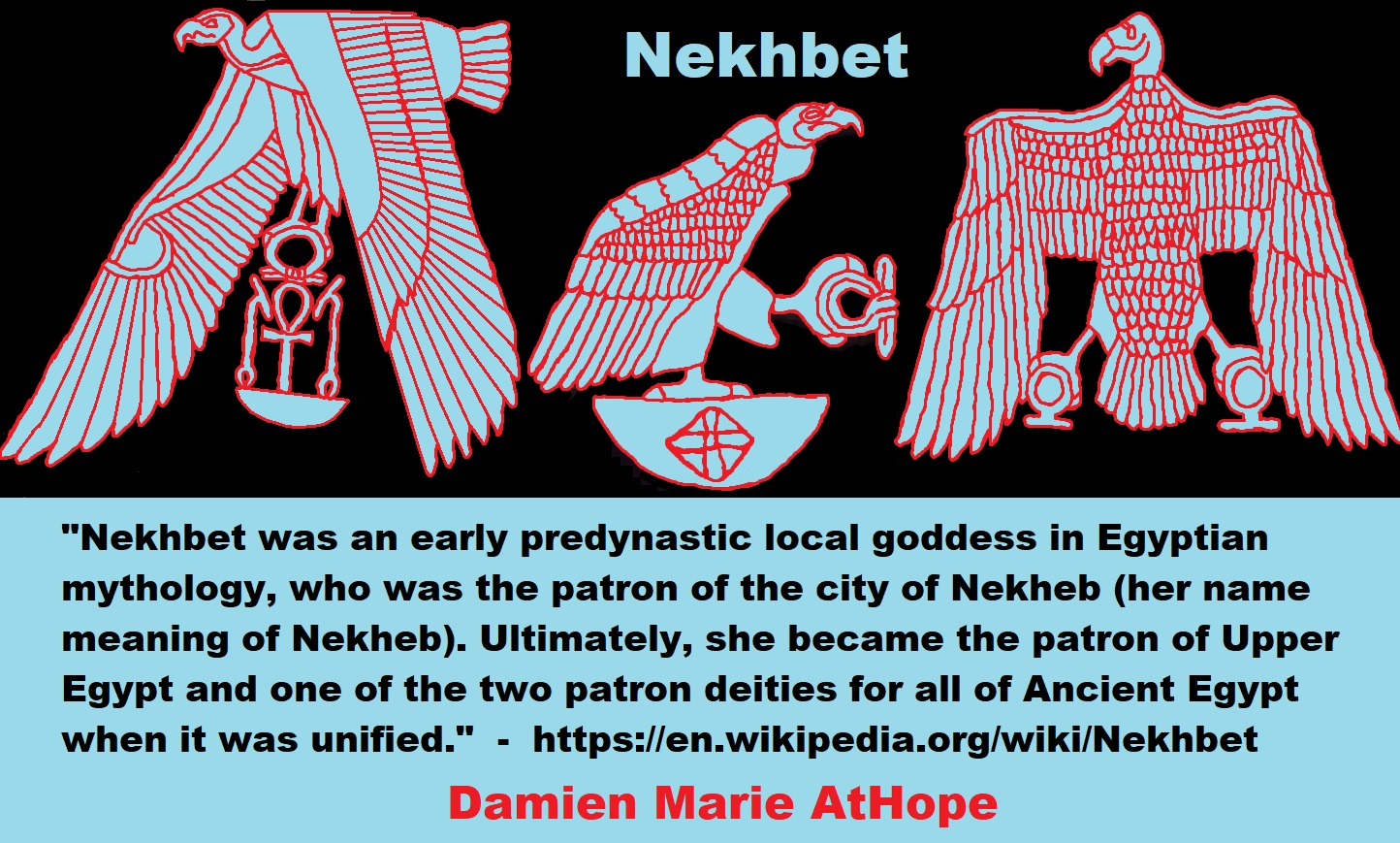
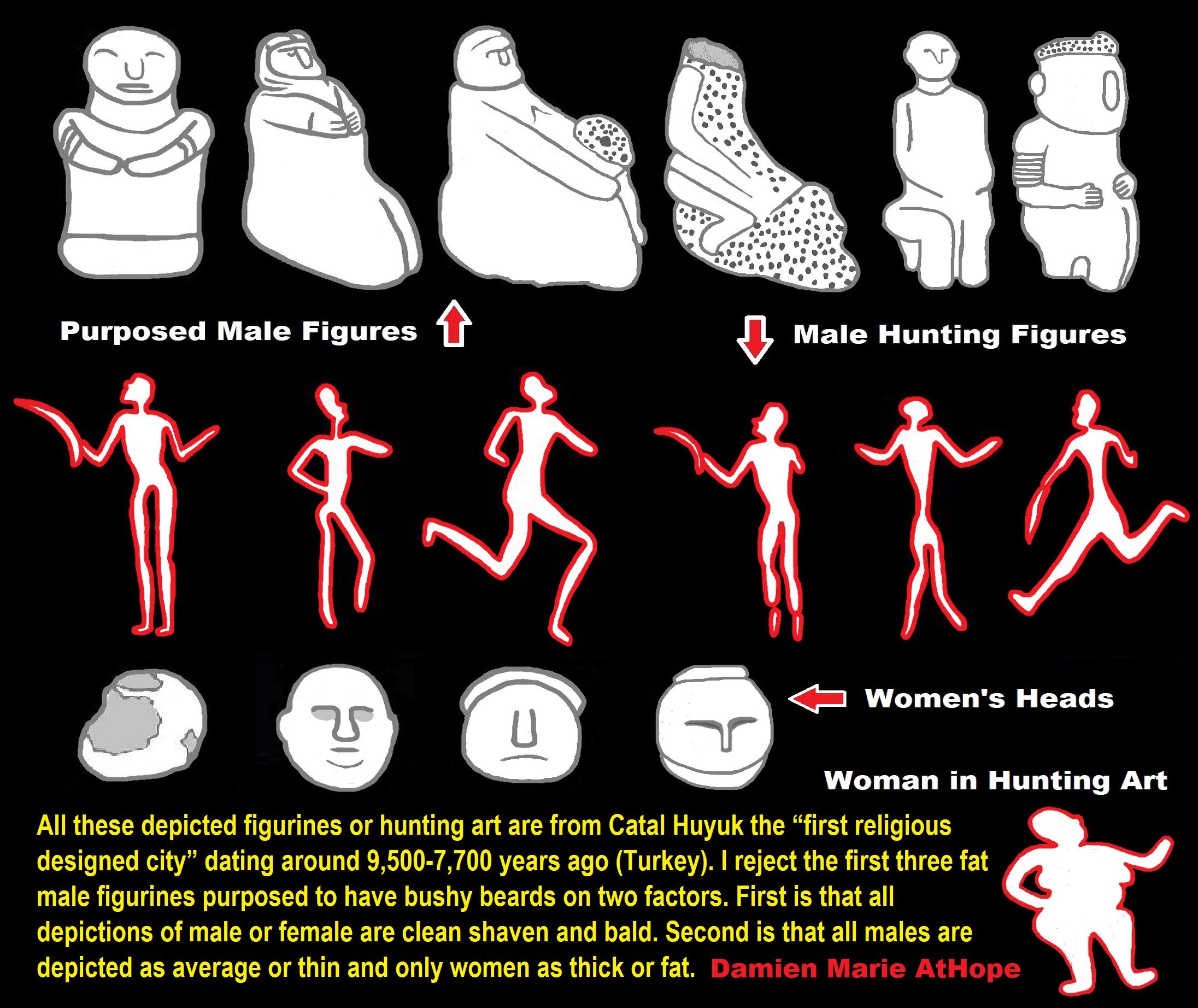

Seated Woman of Çatalhöyük
“The Seated Woman of Çatalhöyük (also Çatal Höyük) is a baked-clay, nude female form, seated between feline-headed arm-rests. It is generally thought to depict a corpulent and fertile Mother goddess in the process of giving birth while seated on her throne, which has two hand rests in the form of feline (lioness, leopard, or panther) heads in a Mistress of Animals motif. The statuette, one of several iconographically similar ones found at the site, is associated to other corpulent prehistoric goddess figures, of which the most famous is the Venus of Willendorf. It is a neolithic sculpture shaped by an unknown artist, and was completed in approximately 6000 BCE.” ref
Kubaba
“Kubaba is the only queen on the Sumerian King List, which states she reigned for 100 years – roughly in the Early Dynastic III period (ca. 2500–2330 BCE) of Sumerian history. A connection between her and a goddess known from Hurro–Hittite and later Luwian sources cannot be established on the account of spatial and temporal differences. Kubaba is one of very few women to have ever ruled in their own right in Mesopotamian history. Most versions of the king list place her alone in her own dynasty, the 3rd Dynasty of Kish, following the defeat of Sharrumiter of Mari, but other versions combine her with the 4th dynasty, that followed the primacy of the king of Akshak. Before becoming monarch, the king list says she was an alewife, brewess or brewster, terms for a woman who brewed alcohol.” ref
“Kubaba was a Syrian goddess associated particularly closely with Alalakh and Carchemish. She was adopted into the Hurrian and Hittite pantheons as well. After the fall of the Hittite empire, she continued to be venerated by Luwians. A connection between her and the similarly named legendary Sumerian queen Kubaba of Kish, while commonly proposed, cannot be established due to spatial and temporal differences. Emmanuel Laroche proposed in 1960 that Kubaba and Cybele were one and the same. This view is supported by Mark Munn, who argues that the Phrygian name Kybele developed from Lydian adjective kuvavli, first changed into kubabli and then simplified into kuballi, and finally kubelli. However, such an adjective is a purely speculative construction.” ref
Cybele
“Cybele (Phrygian: “Kubileya/Kubeleya Mother”, perhaps “Mountain Mother”) is an Anatolian mother goddess; she may have a possible forerunner in the earliest neolithic at Çatalhöyük, where statues of plump women, sometimes sitting, have been found in excavations. Phrygia‘s only known goddess, she was probably its national deity. Greek colonists in Asia Minor adopted and adapted her Phrygian cult and spread it to mainland Greece and to the more distant western Greek colonies around the 6th century BCE. In Greece, Cybele met with a mixed reception. She became partially assimilated to aspects of the Earth-goddess Gaia, of her possibly Minoan equivalent Rhea, and of the harvest–mother goddess Demeter. Some city-states, notably Athens, evoked her as a protector, but her most celebrated Greek rites and processions show her as an essentially foreign, exotic mystery-goddess who arrives in a lion-drawn chariot to the accompaniment of wild music, wine, and a disorderly, ecstatic following.” ref
“Uniquely in Greek religion, she had a eunuch mendicant priesthood. Many of her Greek cults included rites to a divine Phrygian castrate shepherd-consort Attis, who was probably a Greek invention. In Greece, Cybele became associated with mountains, town and city walls, fertile nature, and wild animals, especially lions. In Rome, Cybele became known as Magna Mater (“Great Mother”). The Roman State adopted and developed a particular form of her cult after the Sibylline oracle in 205 BCE recommended her conscription as a key religious ally in Rome’s second war against Carthage (218 to 201 BCE). Roman mythographers reinvented her as a Trojan goddess, and thus an ancestral goddess of the Roman people by way of the Trojan prince Aeneas. As Rome eventually established hegemony over the Mediterranean world, Romanized forms of Cybele’s cults spread throughout Rome’s empire. Greek and Roman writers debated and disputed the meaning and morality of her cults and priesthoods, which remain controversial subjects in modern scholarship.” ref
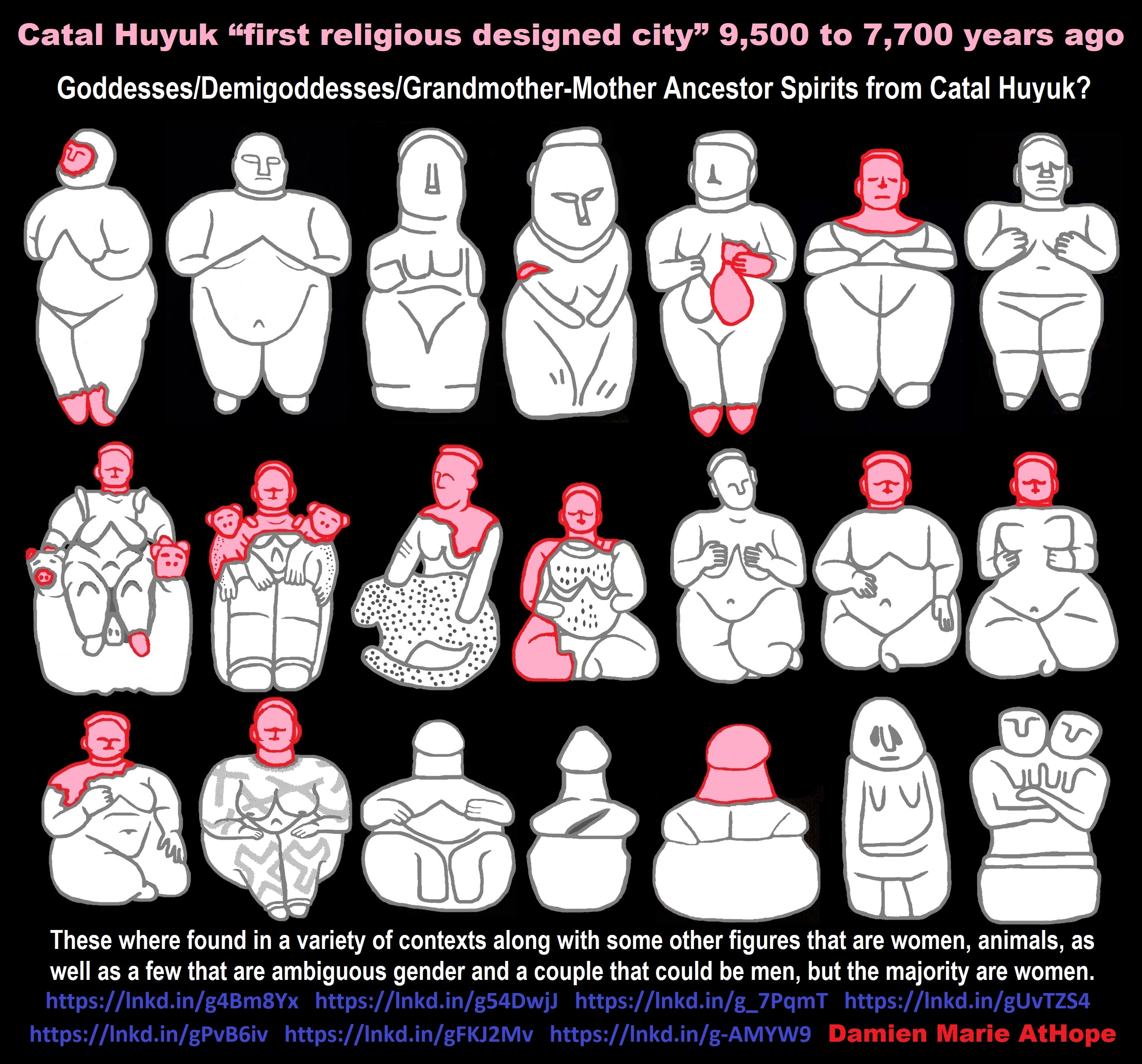
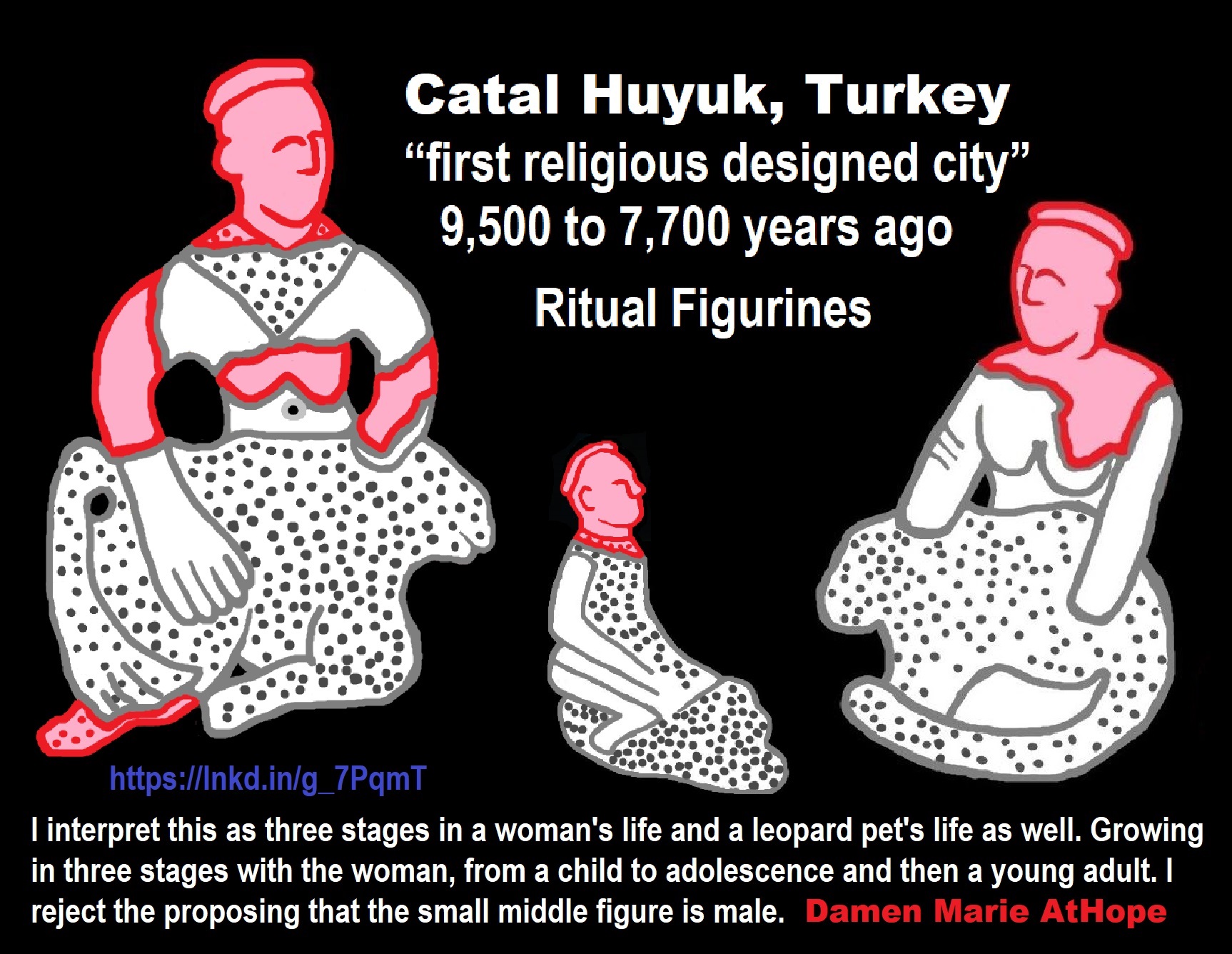

There are other clothing resembling miniskirts that have been identified by archaeologists and historians as far back as 3,390–3,370 years ago. But this is much older. ref
Leopard claw-bone pendant from the Possible Woman Shaman/Priestess burial with the plastered and painted woman’s head in her arms that is several generations removed. She was buried under the floor of the history house (house with multiple burials beyond that of the connected family) with the twin facing leopards at Catal Huyuk. Ref
“From about 7500 B.C.E to 5700 B.C.E., early farmers grew wheat, barley, and peas, and raised sheep, goats, and cattle. At its height, some 10,000 people lived there. Among its more noteworthy features, Çatalhöyük’s inhabitants were obsessed with plaster, lining their walls with it, using it as a canvas for artwork, and even coating the skulls of their dead to recreate the lifelike countenances of their loved ones.” ref
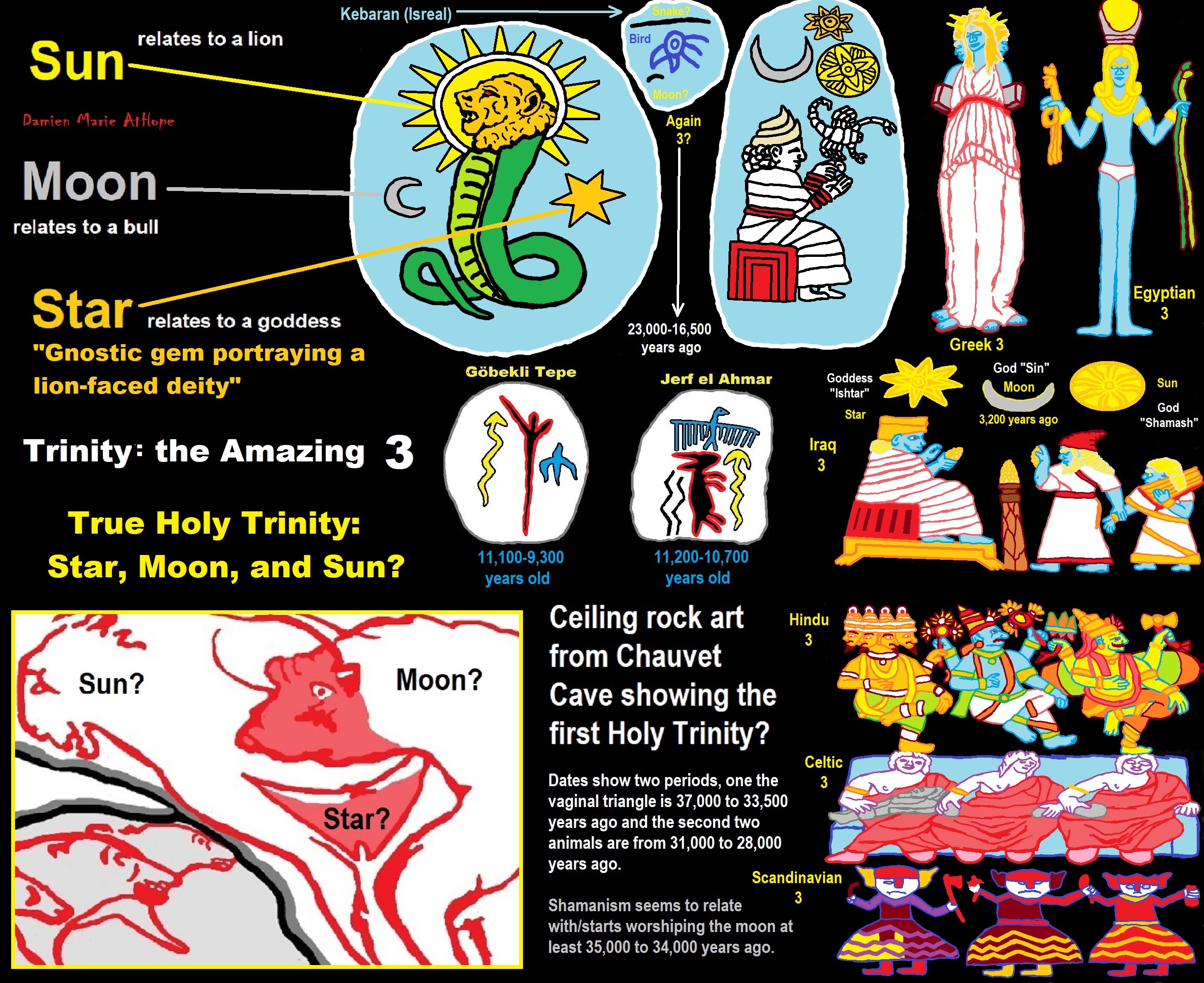



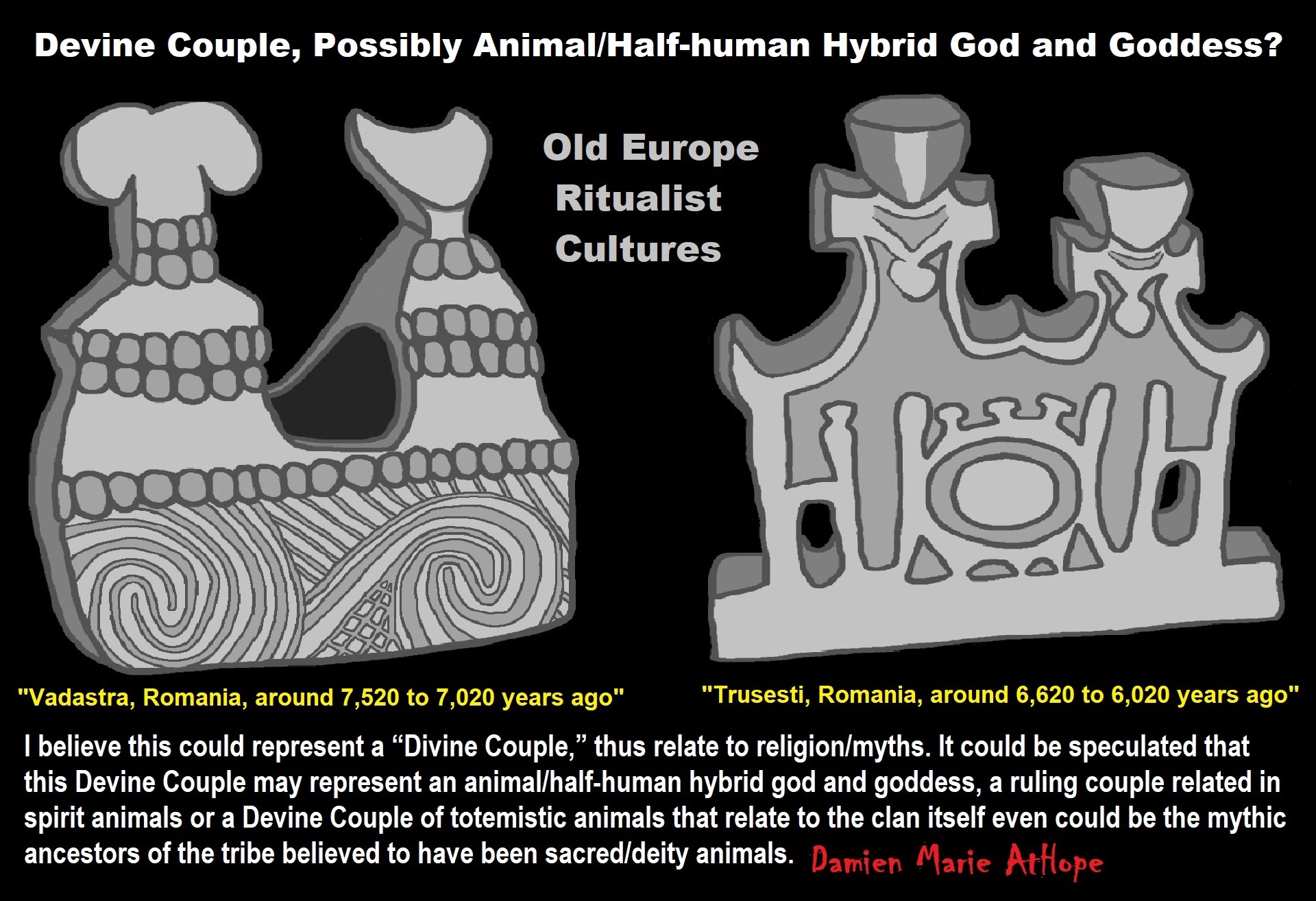
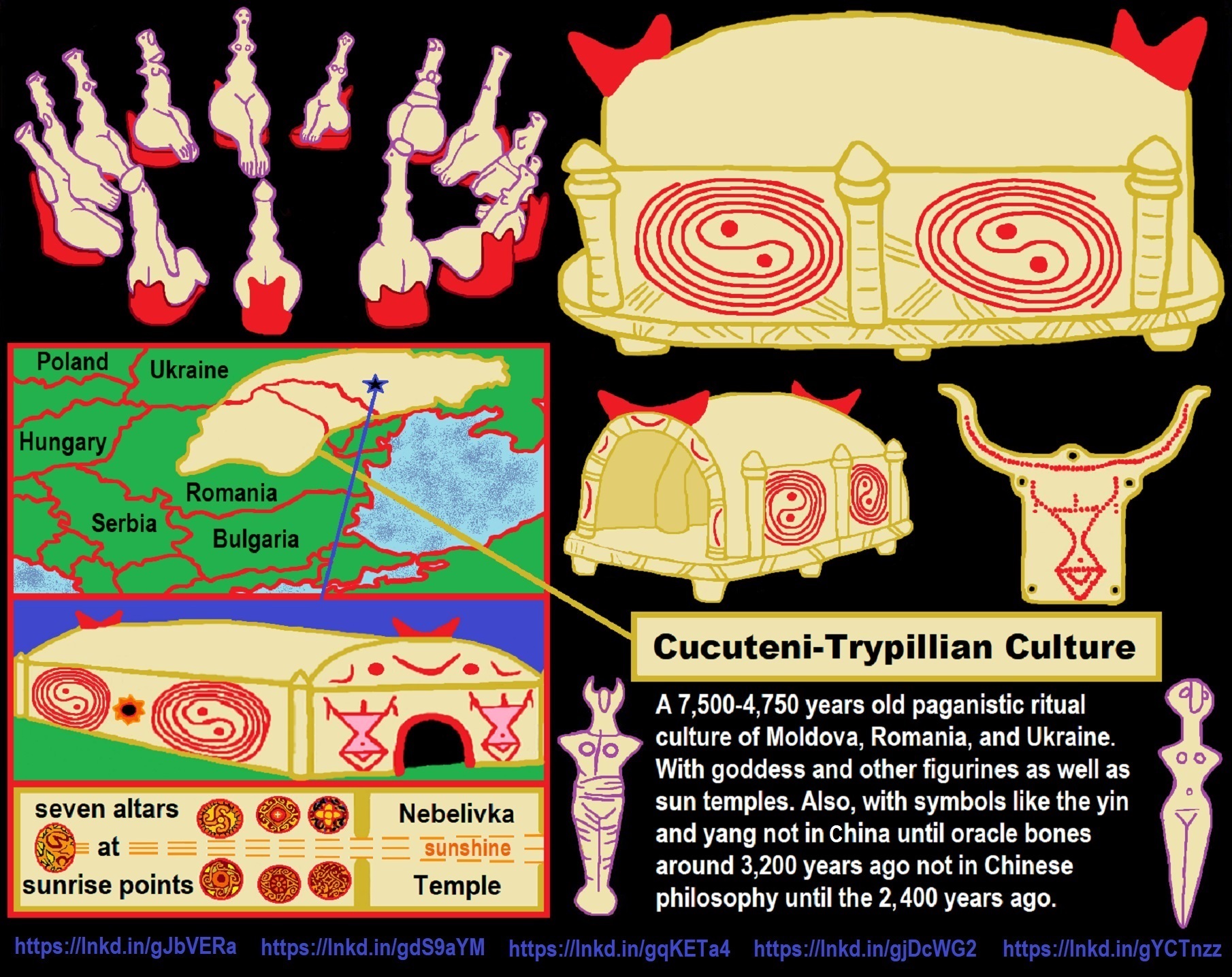
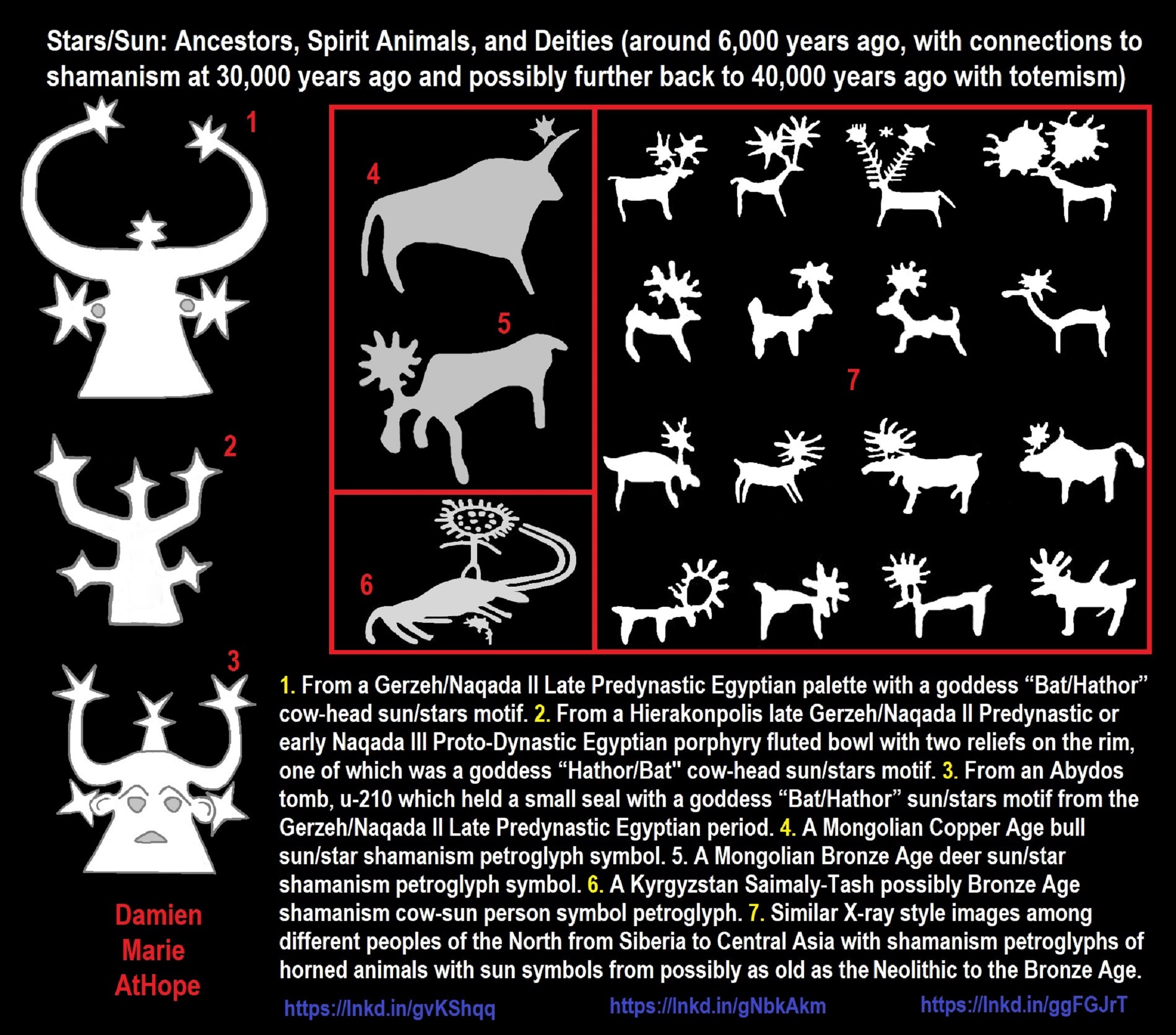
- From a Gerzeh/Naqada II Late Predynastic Egyptian palette with a goddess “Bat/Hathor” cow-head sun/stars motif.
- From a Hierakonpolis late Gerzeh/Naqada II Predynastic or early Naqada III Proto-Dynastic Egyptian porphyry fluted bowl with two reliefs on the rim, one of which was a goddess “Hathor/Bat” cow-head sun/stars motif.
- From an Abydos tomb, u-210 which held a small seal with a goddess “Bat/Hathor” sun/stars motif from the Gerzeh/Naqada II Late Predynastic Egyptian period.
- A Mongolian Copper Age bull sun/star shamanism petroglyph
- A Mongolian Bronze Age deer sun/star shamanism petroglyph symbol.
- A Kyrgyzstan Saimaly-Tash possibly Bronze Age shamanism cow-sun person symbol petroglyph.
- Similar X-ray style images among different peoples of the North from Siberia to Central Asia with shamanism petroglyphs of horned animals with sun symbols from possibly as old as the Neolithic to the Bronze Age. ref, ref, ref
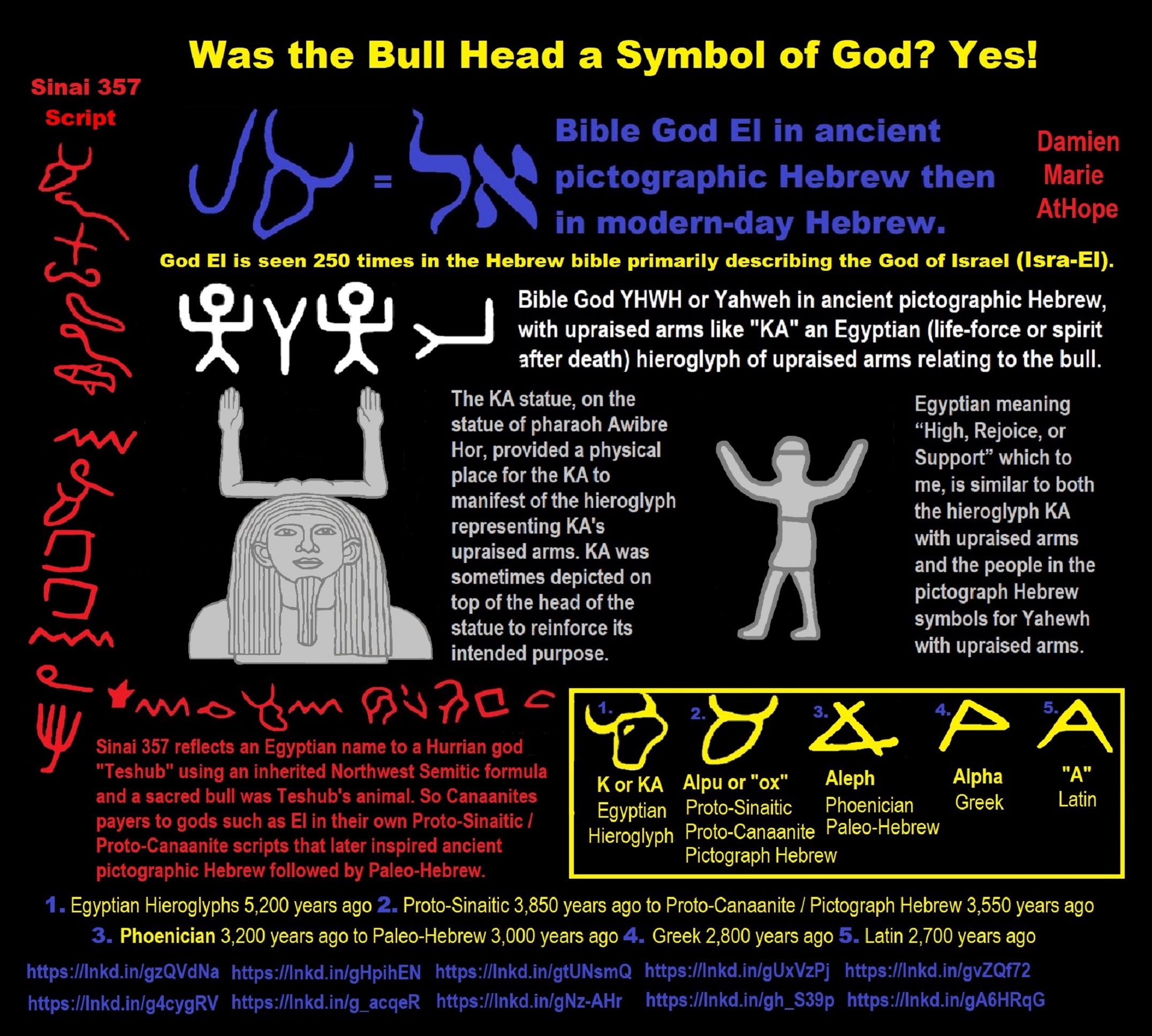
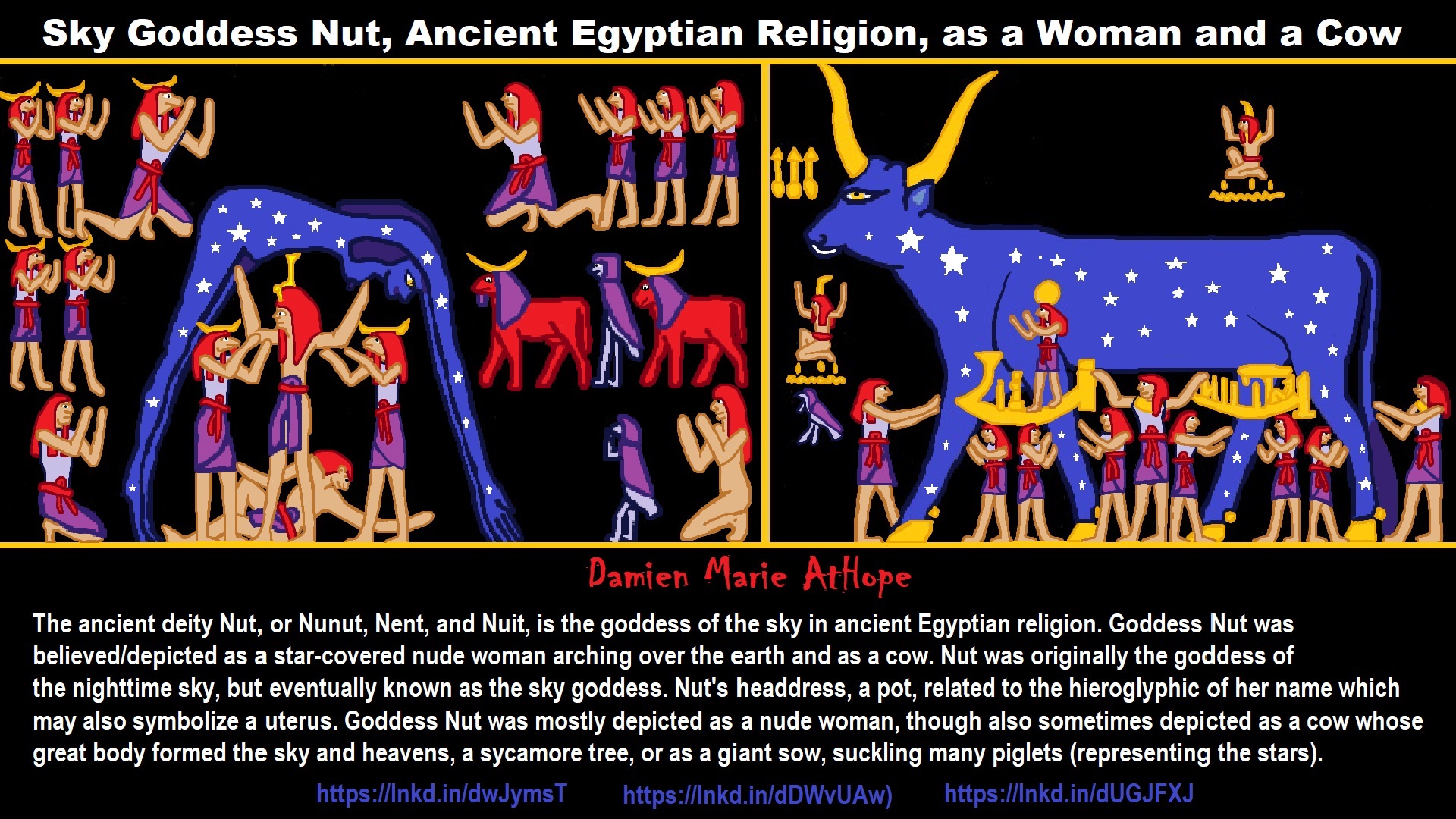

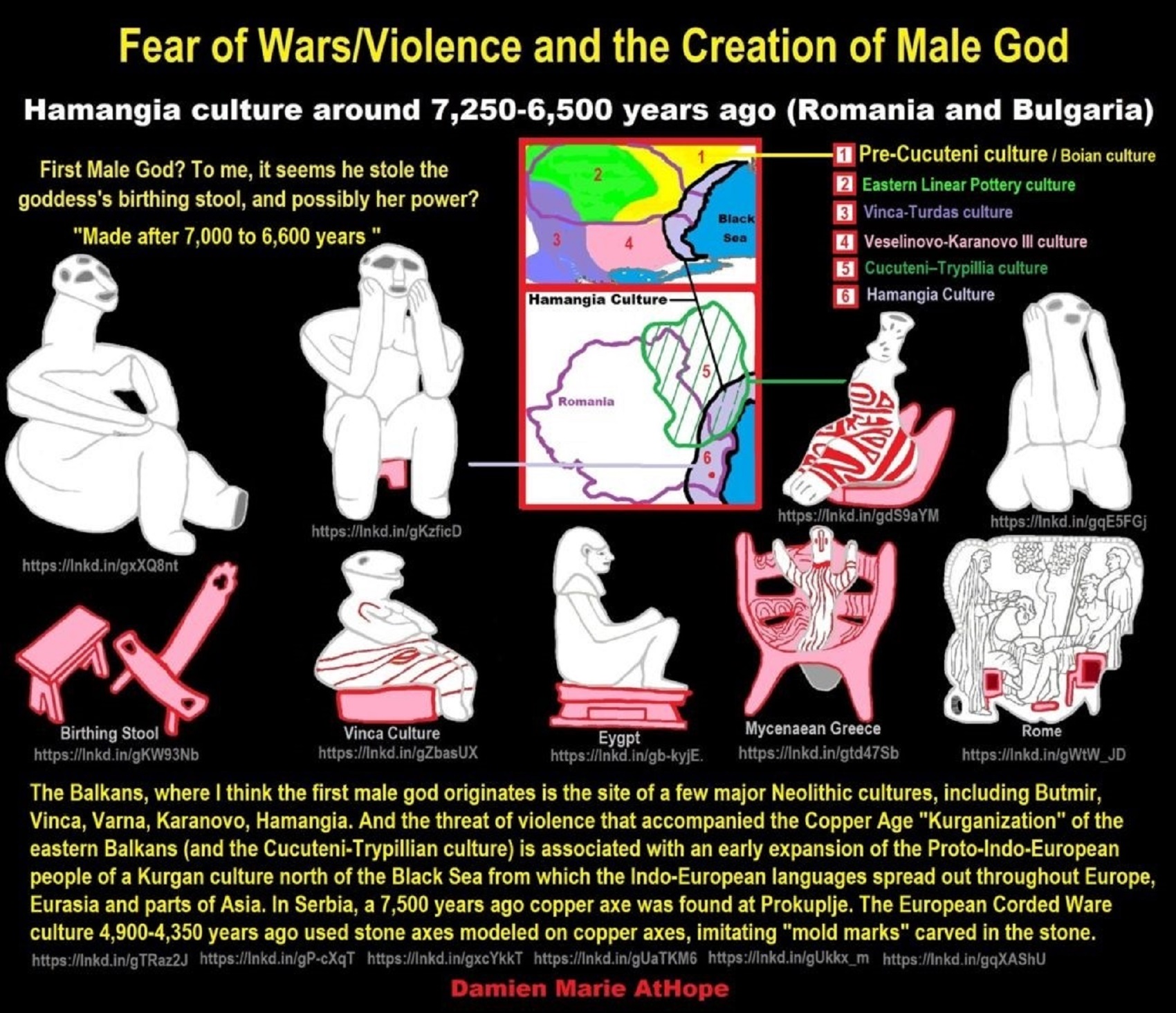
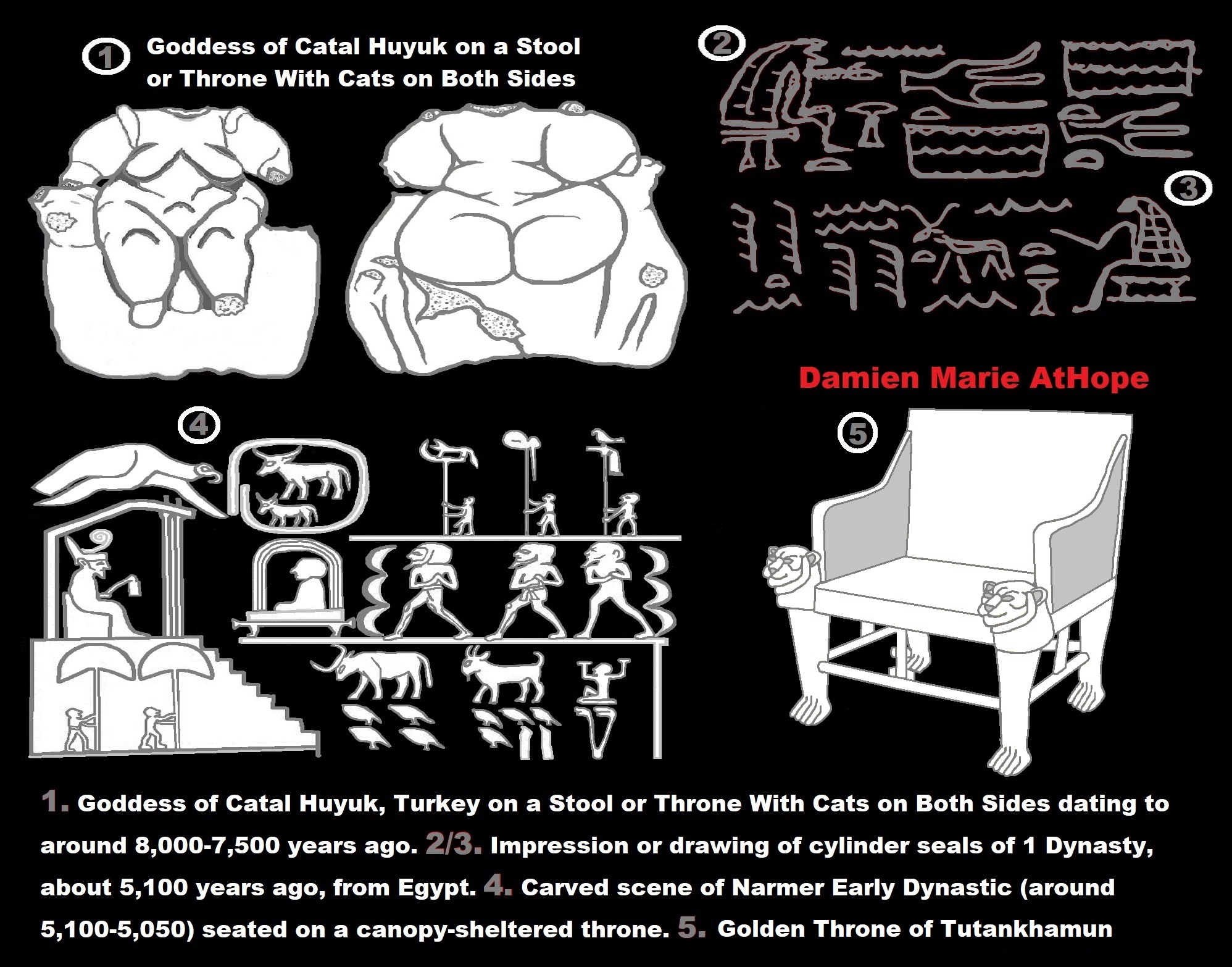
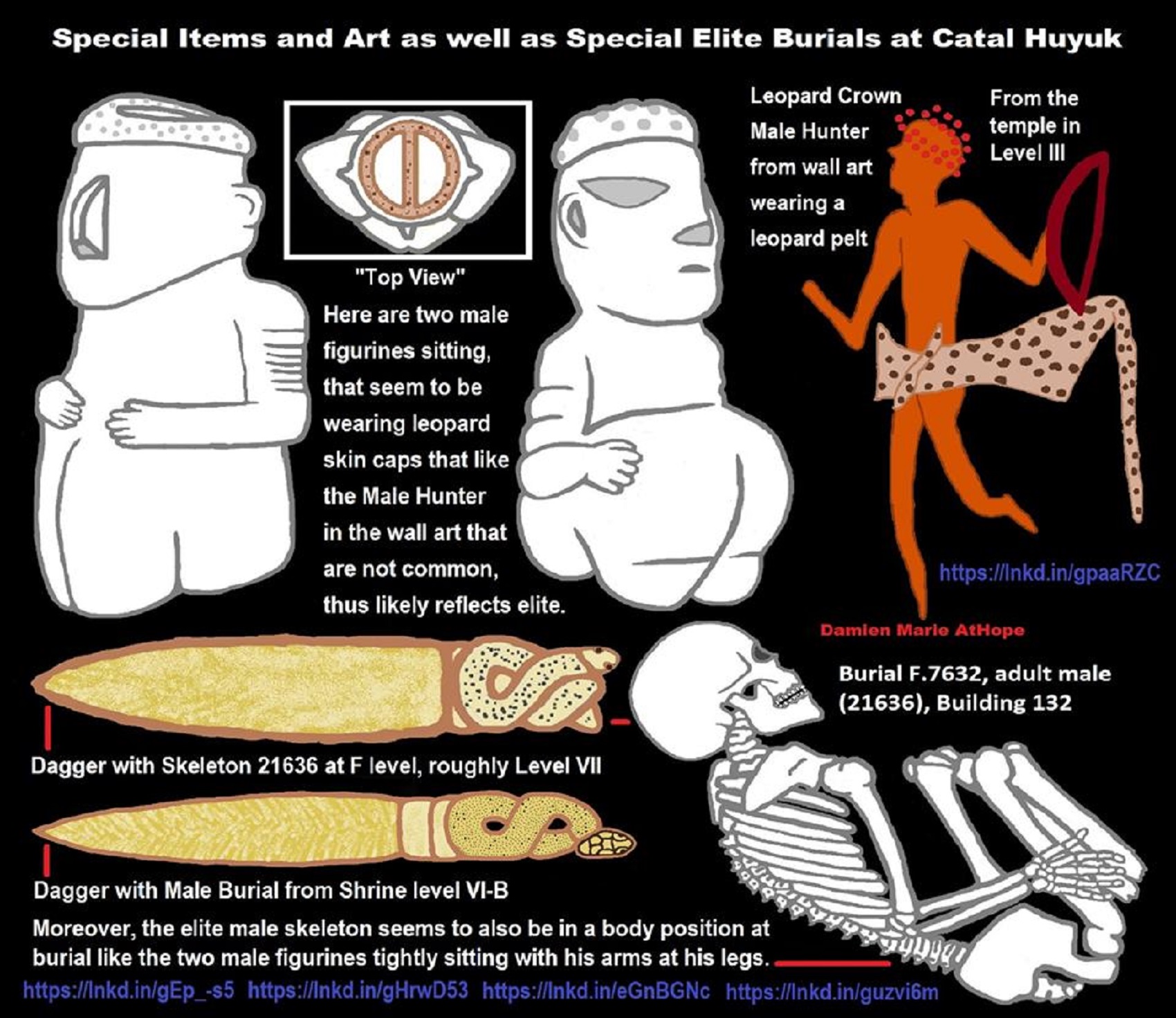

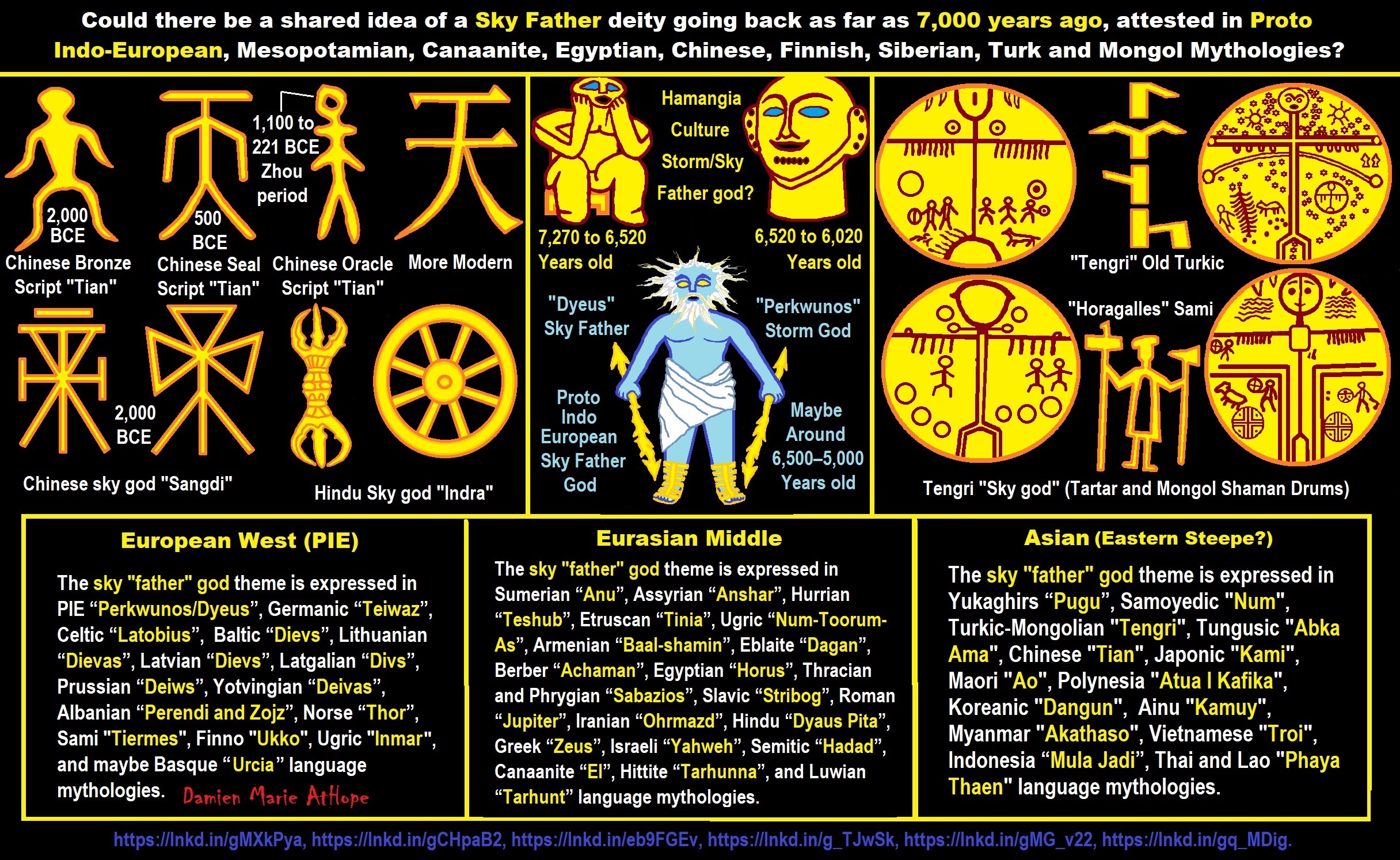
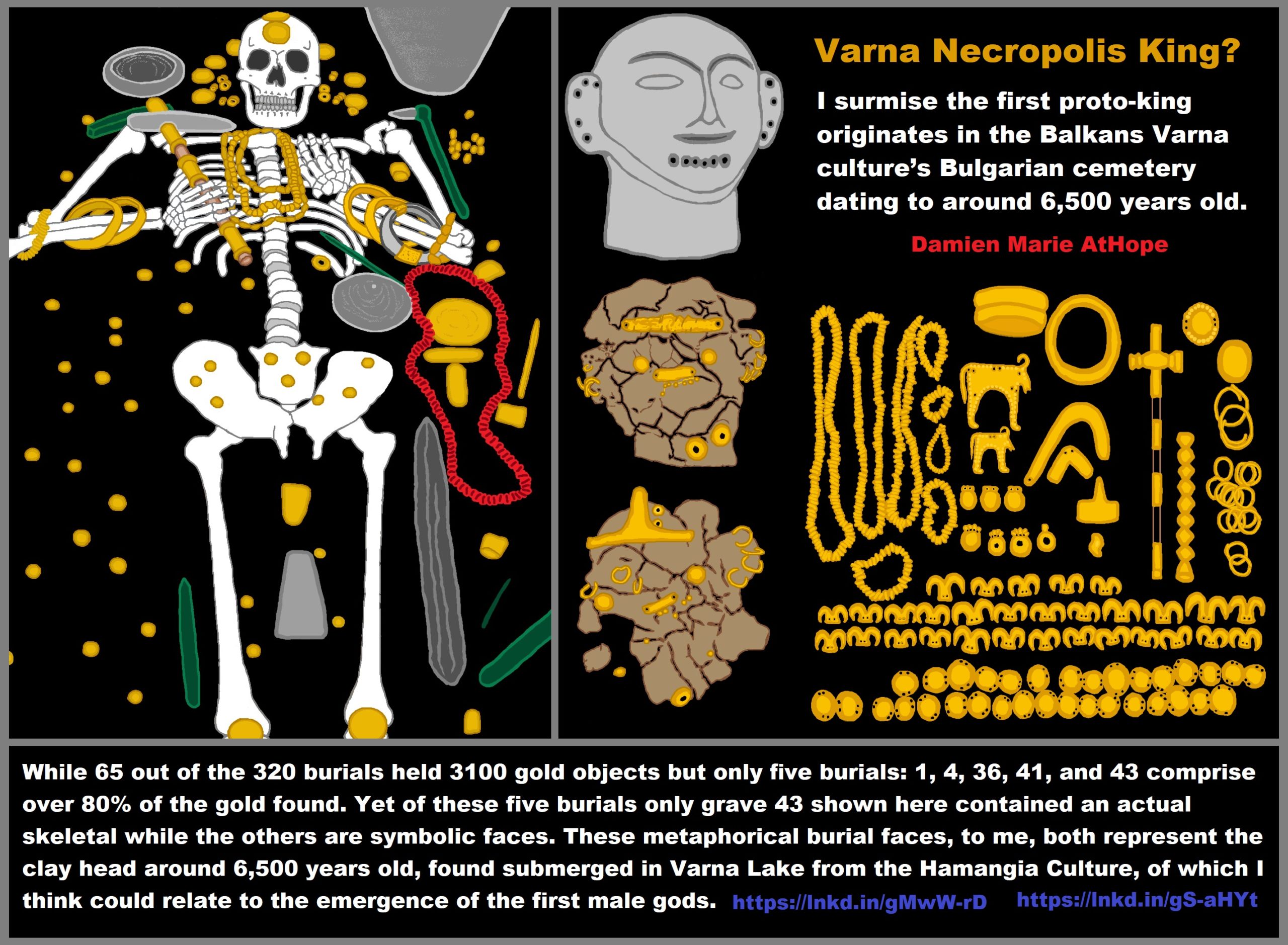
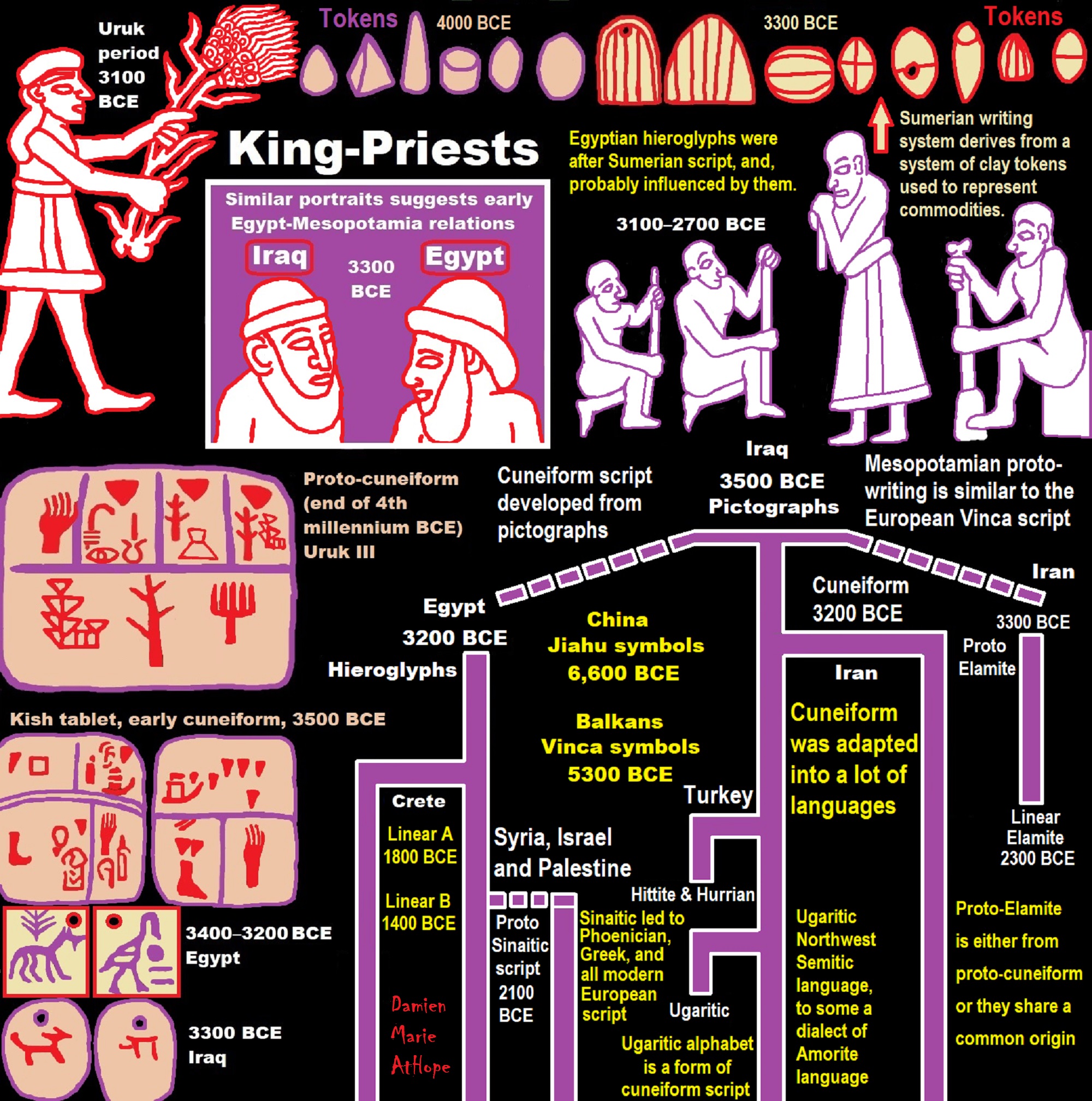
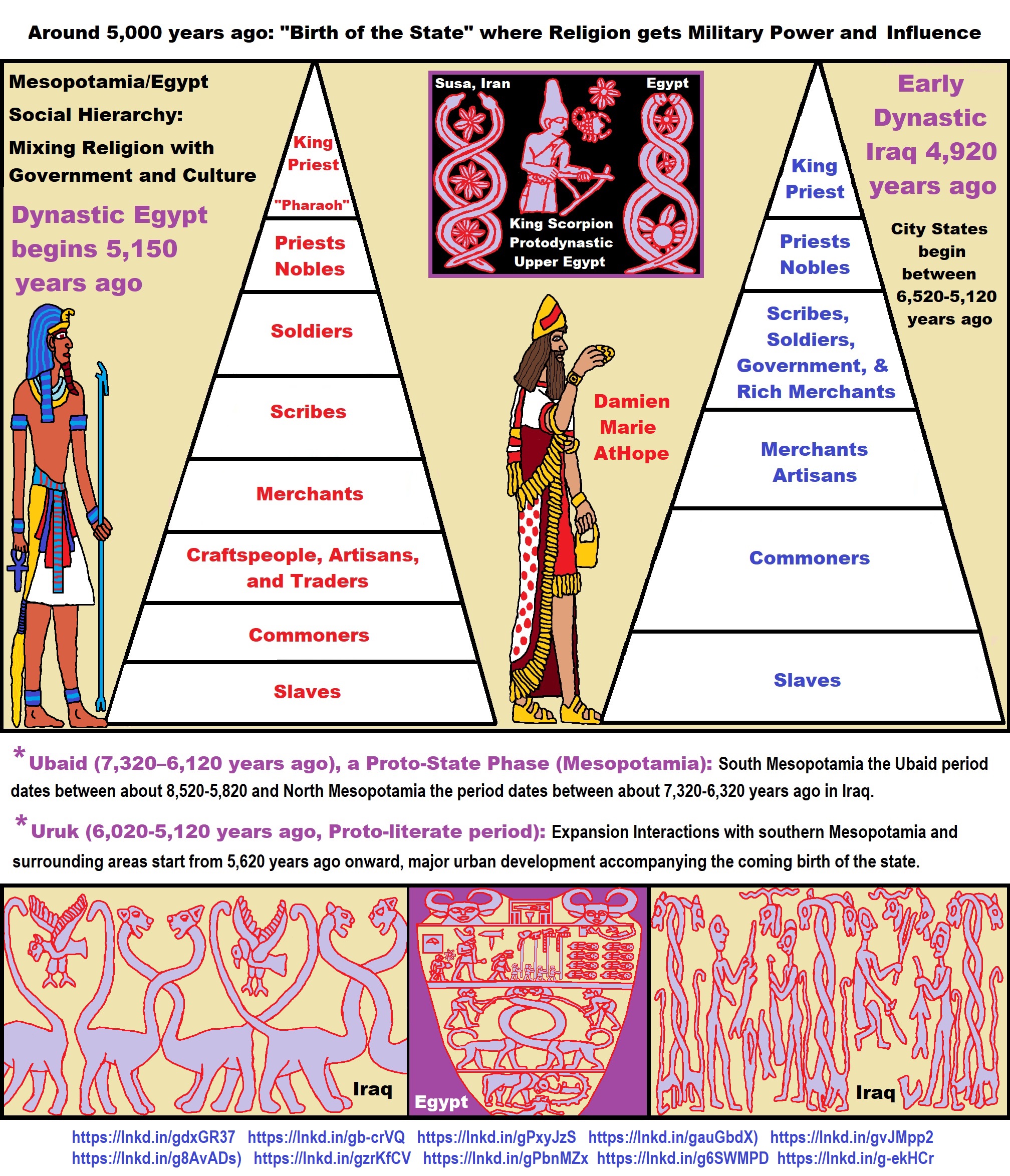

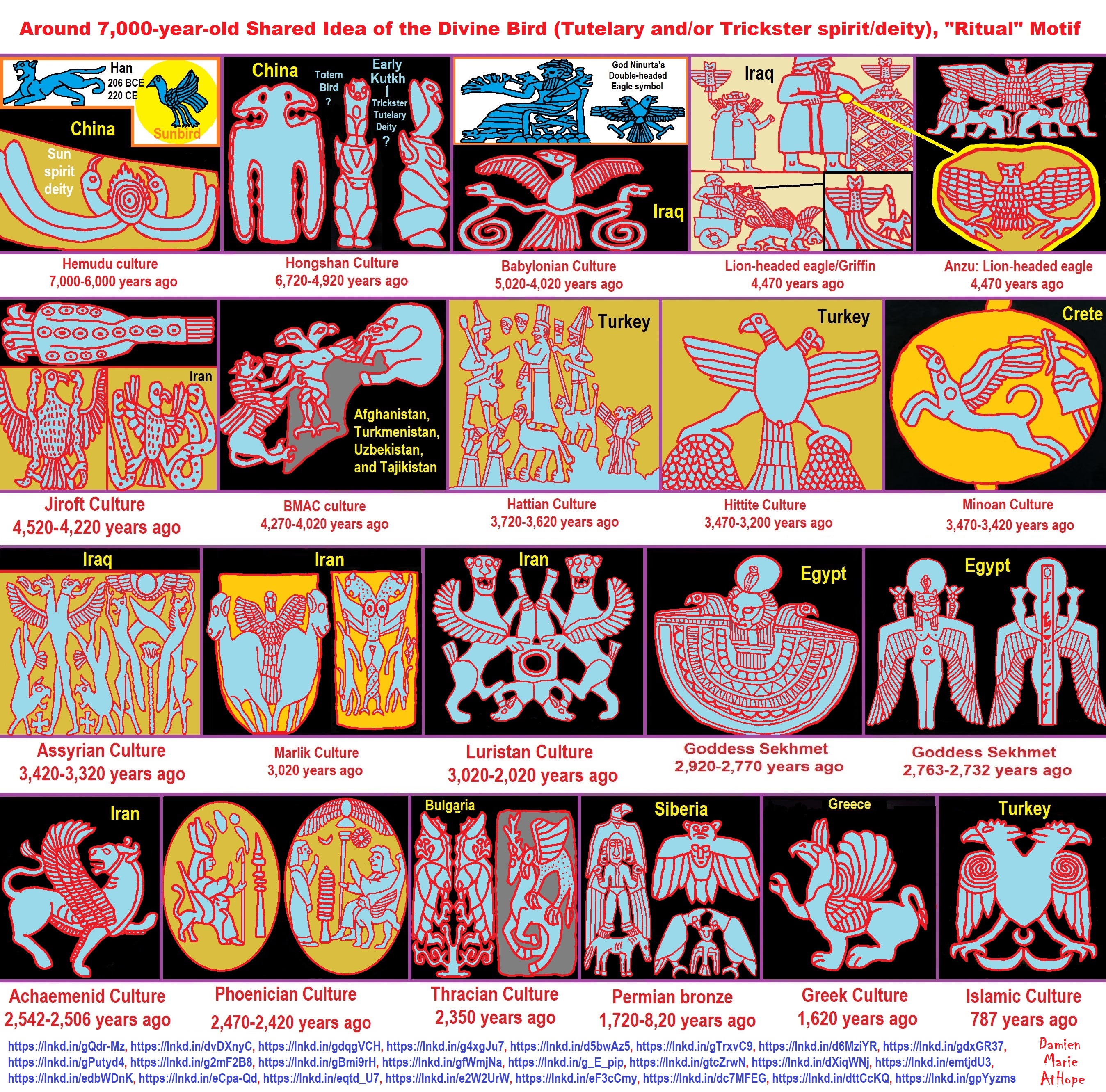
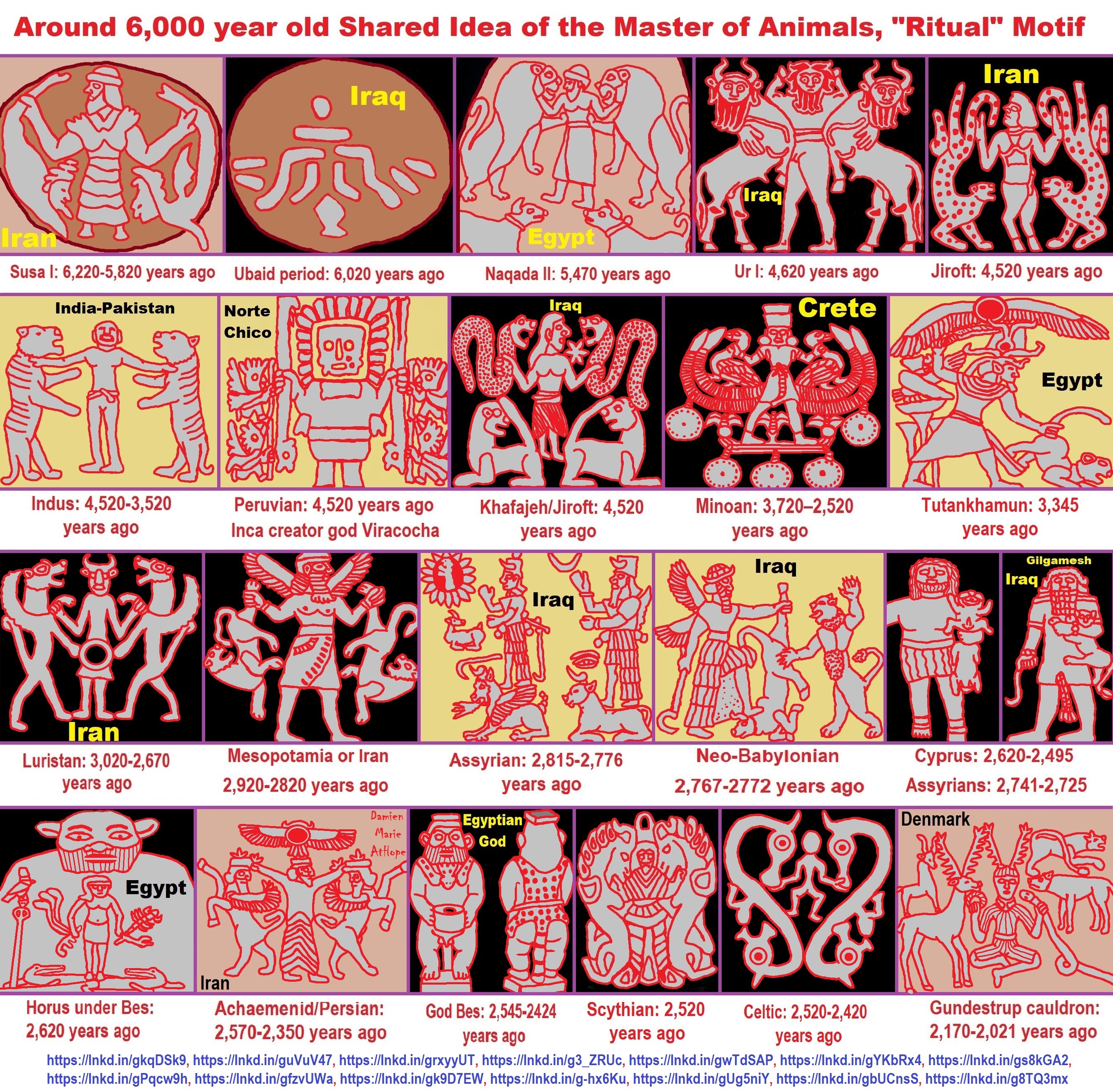

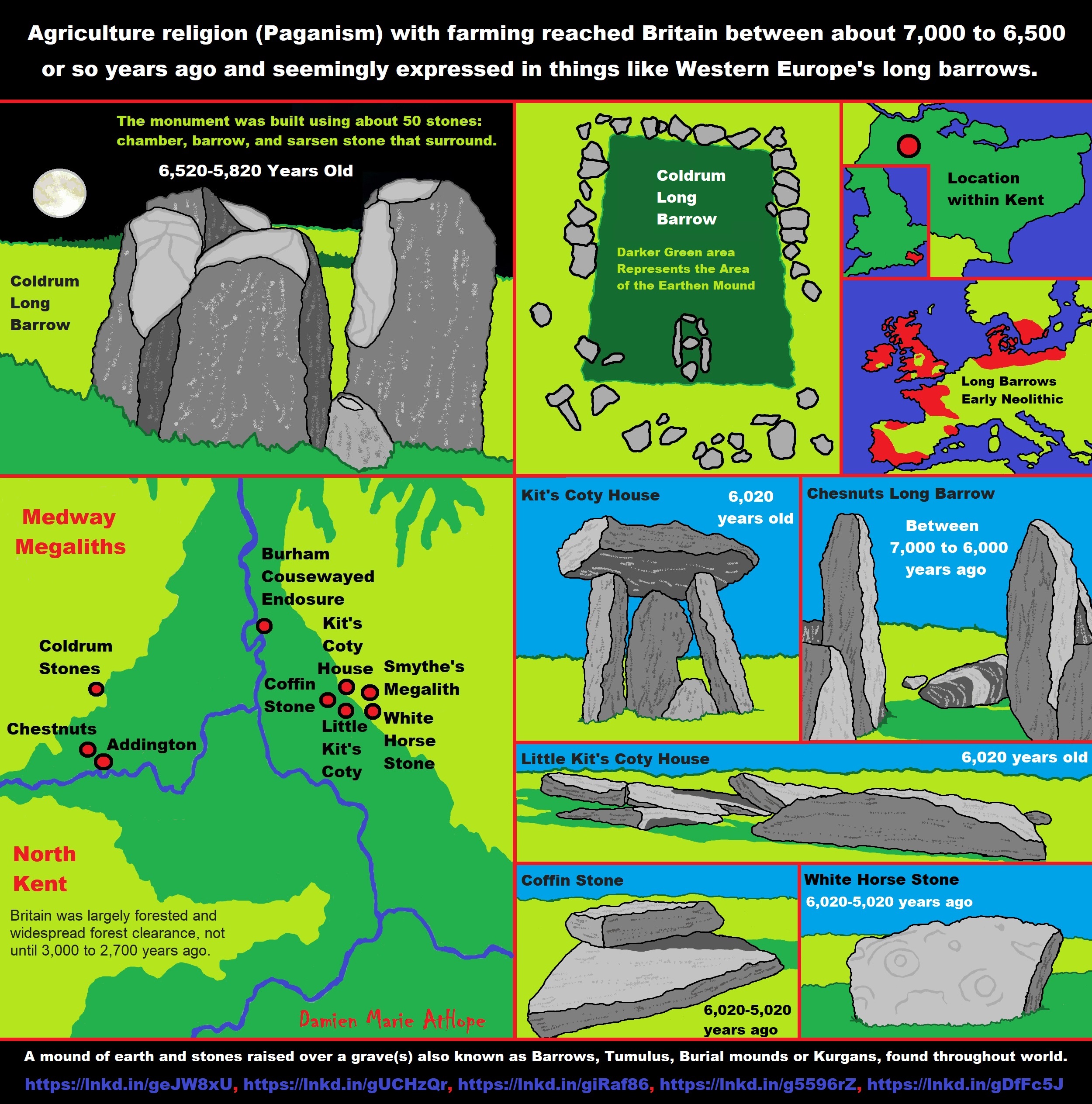


ref, ref, ref, ref, ref, ref, ref
Stonehenge: Paganistic Burial and Astrological Ritual Complex, England (5,100-3,600 years ago)
*Around 5,000 years ago Stonehenge (Britain):
Stonehenge: Paganistic Burial and Astrological Ritual Complex, England.
Stonehenge evolved in several construction phases, 1 (5,100 years ago), 2 (5,000 years ago), 3 I (4,600 years ago), 3 II (4,600-4,400 years ago), 3 III (2400-4,280 years ago), 3 IV (4,280-3,930 years ago), & 3 V (3,930-3,600 years ago). Anatolian/Turkish-farmers built Britain’s famous Stonehenge, as well as current males of Britain, 60-65% have Turkish genetics. Almost as the same as in Ireland where 85 percent of Irish men are descended from farming people that arrived 6,000 years ago. At or around Stonehenge 5,000-4,400 years ago, there were two separate burial rites, either letting the birds feed on bodies or cremation. And a 4,000-year-old burial pit for elite contains 14 females and only 9 males, as well as a chieftain’s grave, held several items including the depicted 4,000-year-old dagger. And a 4,000-year-old child’s grave held the depicted Folkton drums. As well as items from 4,600-3,600 involved gold beads, necklaces, earrings, pendants, and other jewelry show sophisticated burial culture. ref, ref, ref, ref, ref, ref, & ref
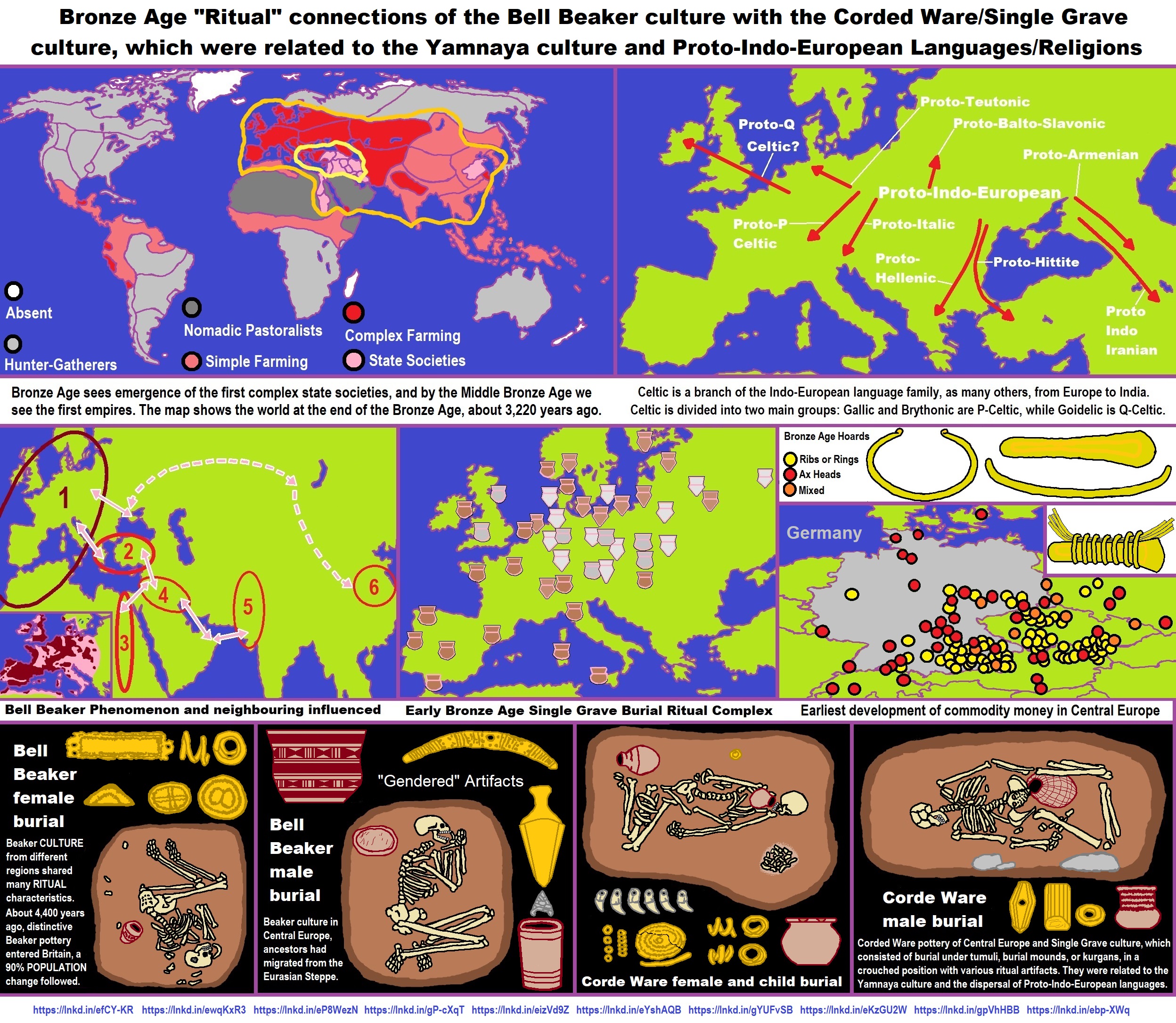
Bronze Age “Ritual” connections of the Bell Beaker culture with the Corded Ware/Single Grave culture, which were related to the Yamnaya culture and Proto-Indo-European Languages/Religions
I see religion as a “theme” of supernatural thinking/beliefs as a honeycomb or connected tree of branching ideas (similar to language or stone tool technology: “a cultural product”), several connected cells all influencing the others, and while they are all different cells that are all part of the whole religion phenomenon. I do not see them as old or new but a cultural product that evolved again and again from several different factors, but the majority was by transfer from cultural diffusion to others, 1. by people movements, and 2. idea transfer not directly connected to people moving to live but through trade and cultural interactions both positive and negative. To me, religion as a phenomenon (IE: several religions or religious ideas not grouped in a fully religious context but still influenced religiously/spiritually) it is several deviations and subsections all loosely connected in many loose ways.
“The Bronze Age (3300–1200 BCE or 5,320-3,220 years ago) marks the emergence of the first complex state societies, and by the Middle Bronze Age (mid-3rd millennium BC) the first empires. By the end of the Bronze Age, complex state societies were mostly limited to the Fertile Crescent and to China, while Bronze Age tribal chiefdoms with less complex forms of administration were found throughout Bronze Age Europe and Central Asia, in the northern Indian subcontinent, and in parts of Mesoamerica and the Andes (although these latter societies were not in the Bronze Age cultural stage).” ref
“Beaker culture was taken up by a group of people living in Central Europe whose ancestors had previously migrated from the Eurasian Steppe.” ref
“The Bell Beaker culture (or, in short, Beaker culture) is an archaeological culture named after the inverted-bell beaker drinking vessel used at the very beginning of the European Bronze Age. Arising from around 2800 BCE or 4,820 years ago, it lasted in Britain until as late as 1800 BCE or 3,820 years ago but in continental Europe only until 2300 BCE or 4,320 years ago, when it was succeeded by the Unetice culture. The culture was widely dispersed throughout Western Europe, from various regions in Iberia and spots facing northern Africa to the Danubian plains, the islands of Great Britain and Ireland, and also the islands of Sicily and Sardinia. The Bell Beaker culture was partly preceded by and contemporaneous with the Corded Ware culture, and in north-central Europe preceded by the Funnelbeaker culture. In its early phase, the Bell Beaker culture can be seen as the western contemporary of the Corded Ware culture of Central Europe. From about 2400 BCE or 4.420 years ago the Beaker folk culture-expanded eastwards, into the Corded Ware horizon. In parts of Central and Eastern Europe, as far east as Poland, a sequence occurs from Corded Ware to Bell Beaker. This period marks a period of cultural contact in Atlantic and Western Europe following a prolonged period of relative isolation during the Neolithic. In its mature phase, the Bell Beaker culture is understood as not only a collection of characteristic artifact types, but a complex cultural phenomenon involving metalwork in copper and gold, archery, specific types of ornamentation, and (presumably) shared ideological, cultural, and religious ideas. A wide range of regional diversity persists within the widespread late Beaker culture, particularly in local burial styles (including incidences of cremation rather than burial), housing styles, economic profile, and local ceramic wares (Begleitkeramik).” ref
“Corded Ware pottery of Central Europe and Single Grave culture, which consisted of burial under tumuli, burial mounds, or kurgans, in a crouched position with various ritual artifacts. They were related to the Yamnaya culture and the dispersal of Proto-Indo-European languages.” ref
“The Corded Ware culture (outdated called Battle Axe culture) comprises a broad archaeological horizon of Europe between c. 3100 – 2350 BCE or 5,120 to 4,370 years ago. Corded Ware culture encompassed a vast area, from the contact zone between the Yamnaya culture and the Corded ware culture in south Central Europe, to the Rhine on the west and the Volga in the east, occupying parts of Northern Europe, Central Europe, and Eastern Europe. The Corded Ware people of Central Europe carried mostly Western Steppe Herder (WSH) ancestry and were closely related to the people of the Yamna culture (or Yamnaya), “documenting a massive migration into the heartland of Europe from its eastern periphery,” the Eurasiatic steppes. The Corded Ware culture may be ancestral to the Proto-Germanic and Proto-Balto-Slavic Indo-European languages in Europe. The eastern Corded Ware Culture also shows genetic affinity with the later Sintashta culture, where the Proto-Indo-Iranian language may have originated. The term Corded Ware culture was named it after cord-like impressions or ornamentation characteristic of its pottery. The term Single Grave culture comes from its burial custom, which consisted of inhumation under tumuli in a crouched position with various artifacts. Battle Axe culture, or Boat Axe culture, is named from its characteristic male grave offering, a stone boat-shaped battle axe.” ref
When did the Celts arrive in Ireland?
“The question has plagued linguists and archaeologists alike for a century. By the 5th century CE., the beginning of Irish historical records, all of Ireland was Celtic speaking; but when had it become so? Theories have ranged widely, from as early as 5000 to as late as 100 BCE or 7,020-2,120 years ago. This article will summarize the present theories, and suggest a resolution. But before these various theories can be examined, the meaning of the term “Celt” must be clarified. “Celtic” was initially a linguistic concept, used solely to refer to the Celtic languages. The earliest recorded versions of Celtic are Gallic and Brythonic, spoken in Gaul and Britain respectively at the time of the Roman conquest, and Goidelic, the language of Ireland by the 5th century CE. The Medieval and Modern Celtic languages are Welsh, Cornish, and Breton, all derived from the early Brythonic spoken in Britain, and Irish, Scots Gaelic, and Manx, which are all derived from Old Irish Goidelic. Gallic appears to have become extinct during the Roman occupation of Gaul—at all events, there is no trace of it by the 5th century CE. when the Western Roman Empire collapsed.” ref
“Celtic is a branch of the great Indo-European language family, as are the Teutonic, Romance, and Balto-Slavonic languages of Europe, classical Greek and Latin, and many others. Indo-European languages, in fact, are found across a huge swath of the Old World, from northwestern Europe to the Indian sub-continent. Many of these languages, of course, are known from many centuries of written sources, and from place-names of considerable antiquity, as well as from their modern versions where these survive. Linguistic analysis has sorted this multiplicity of languages into closer groups and into more distant and disparate relationships, and named the whole huge ‘family’ Indo-European, from its distribution. From the earliest forms of the languages, which are linguistically closer to each other than their later descendants, it has proved possible to reconstruct the ‘skeleton,’ as it were, of the original language from which all were derived: this reconstruction is known as Proto-Indo-European, or *IE (the * indicating a language not known from any written sources, but reconstructed from its surviving descendants).” ref
“Celtic is divided into two main groups. Gallic and Brythonic (and probably the very poorly-known and long-extinct Pictish, so Professor Jackson argues) are P-Celtic, while Goidelic is Q-Celtic. This linguistic terminology identifies the shift from the original kw in *IE to qu in Goidelic and to p in Gallic and Brythonic. Old Irish is the only original Q-Celtic language known, Scots Gaelic and Manx resulting from historical Irish settlement in Scotland and the Isle of Man. Thus our problem in searching for the origins of a Celtic language in Ireland is compounded: Irish is the only native language recorded there, and there is no linguistic clue as to its origin, other than the general one that it is Celtic, and that Celtic is Indo-European. Moreover, Q-Celtic is usually considered to be linguistically more archaic and conservative than P-Celtic.” ref
“Here we introduce the archaeological problem. As in all parts of the world, one concern of archaeologists in Europe has been the attempted correlation of identifiable archaeological cultures and traditions with the languages, language groups, and language families identified by linguistics. In turn, linguistics has turned to archaeology (when and where no documents exist] for assistance. In our specific case, the problem for both archaeologists and linguists is this: since the *IE language is generally agreed to have originated in central and/or eastern Europe during the 4th/3rd millennia BCE., how and when did Q-Celtic find its way to Ireland? Did it once exist on the continent as well, but survived only in Ireland? Or did it develop in Ireland from some earlier introduced Indo-European language? In either case, the time limit is wide: as we have noted already, theories range from 5000 to 100 BCE. for this event—and we must remember that this linguistic ‘event’ may well have been a protracted process.” ref
“Our earliest references to the Celts come from Greek sources of the 6th and 5th centuries BCE. These identify ‘Keltoi’ in central Europe, France, and at least parts of Spain. A growing number of such references in the succeeding centuries testify ever more clearly to Celtic-speaking peoples over much of Europe immediately north of the classical world. And the Roman conquests of Gaul and Britain, in the 1st centuries BCE. and CE. respectively, have left us substantial information of Celtic language, customs, and society in those areas. Archaeologically, this linguistic information correlates closely with the iron-using Hallstatt (ca. 700-500 BCE.) and the succeeding La Tène cultures. Distinctive metal types such as the long iron sword (sometimes copied in bronze), horse-bits, harness parts, and wagon fittings have been used by archaeologists to identify Hallstatt Iron Age culture in central Europe and parts of western Europe.” ref
“The succeeding La Tène culture, named after the find-spot of a large votive deposit on Lake Neuchatel, is renowned for its art style, manifested mainly in fine bronze drinking vessels, personal ornaments, weapons, and helmets, La Tene artists produced their own abstractions based on Hallstatt, Greek and Oriental motifs— acanthus leaves, running scrolls, palmettes and peltas. This was a totally new amalgamation of the art styles of three cultures and resulted in a distinctive, nonrepresentational style. Hallstatt material is found not only in central and Western Europe but also in Britain and Ireland, while La Tène material is even better represented in these areas. Their presence has been presumed to note expansion from the Continent into Britain and Ireland. Could either of these archaeological groups represent Q-Celtic speakers introducing their language to Ireland and imposing it there?” ref
Hallstatt Iron Age
“The archaeological evidence for a Hallstatt invasion of Ireland is, to say the least, sparse. The foreign artifacts consist of approximately twenty-four bronze swords, one iron sword, seven winged scabbard chapes, seven bucket-shaped cauldrons, fifteen to twenty riveted vessels of bronze and one of iron, a fragment of a gold cup, a band and some ribbons of gold, two “flesh hooks” and two shields. This is a rather paltry assemblage on which to base the claim of an invasion. Current archaeological literature dealing with the Hallstatt invasions has begun to question the wisdom of hypothesizing an expansion throughout Europe based solely on metal artifacts. In addition, it is interesting to note that the bronze swords, which are the major portion of the Hallstatt material in Ireland, are insular copies of Continental prototypes.” ref
“It has been postulated that the earliest appearances of the Hallstatt swords in the British Isles were attributable to trade, to traveling sword-smiths, or to princely gifts or exchanges; and that thereafter the imported varieties were quickly copied by local sword-smiths, sometimes with their own modifications so as to develop eventually into purely insular varieties. An alternative explanation for the presence of the Hallstatt material is that it might be due to raiding activities since the largest portion consists of warrior-type equipment with a coastal-riverine distribution. Such distributions are argued as constituting a classic raiding pattern. Whether it be trading or raiding adventurers who account for the presence of Hallstatt material, it is now becoming increasingly apparent that a massive Hallstatt invasion of Ireland in the 7th century BCE. and the subsequent hypothesized language change are very difficult to substantiate.” ref
“The evidence for a La Tène invasion of Ireland, although in number of artifacts more formidable, is still questionable. Etienne Rynne has identified and discussed fifty or so objects which he attributed to the La Tène invasion in the 2nd/1st centuries B.C. In addition, there are swords, spear butts, and horse-bits which he omitted from his paper. Together this material constitutes a considerable corpus of La Tène decorated artifacts in Ireland, and undoubtedly suggests the influence of the continental La Tène culture. The question arises as to precisely what form this influence took; was it, as Rynne proposes, a two-prong invasion of La Tène Celts from Gaul and Britain, or does it represent, as others have suggested, raiding, or trading, or just the adoption of a new art style by the indigenous people? I am inclined to accept the latter version.” ref
“In short, the appearance of a new art style, or even of a whole new metal industry, need not constitute the arrival, en masse, of a new population group. To ascertain the arrival of new population groups into any country it is necessary to substantiate the introduction of a number of indicative material objects and characteristics which constitute the known culture of the “invading people.” Yet in Ireland, the characteristics of the continental La Tène Celts are noticeably lacking: a few fibulae, swords, decorated torques, stones, and horse-bits are already well known, but the large flat cemeteries of the Marne, the wheel-turned or stamped pottery and the “princely tombs” are not evident.” ref
“The art of the Turoe stone has often been cited for its continental parallels, but Professor Duignan’s study indicates that its curvilinear ornament “represents an advanced stage of insular La Tène art” (my emphasis). Barry Raftery has described the Irish La Tène material as undoubtedly insular rather than continental in origin, and goes on to say that the limited burial and settlement evidence available “gives more than a hint of broad cultural stability in the last millennium BCE.” This does not necessarily signify that there were no La Tène Celts present in Ireland. However, it could be interpreted to mean either that a comparatively small number of La Tène people made their way to Ireland or that the new art motifs were introduced through trading. Neither interpretation seems likely to have been responsible for a total language change. There is also a critical linguistic objection to this postulated La Tene introduction of Q-Celtic to Ireland, however: all our information on both continental and British La Tène cultures of the 2nd and 1st centuries BCE. indicates that they were P-Celtic in language.” ref
“The view that Q-Celtic was a late introduction into Ireland thus can be seriously questioned. What alternative hypotheses have been proposed? A number of Indo-European scholars conclude that an archaic form of Celtic was in existence by circa 2000 BCE or around 4,020 years ago. Linguists are not alone in proposing such an early date for the emergence of a Celtic language, Several Celtic specialists have postulated that the Celts emerge as a separate people about 2000 BCE., Goidelic being the earlier form of Celtic, and Gallic (along with Brythonic) a later development. If this theory is tenable then the archaeological evidence should attest to a major population incursion into Ireland at about that time.” ref
“In the later third millennium BCE., the appearance of foreign pottery in considerable quantity strongly suggests the arrival of continental migrants in Britain. These people have been given the makeshift label, the Beaker Folk, due to their distinctive beaker-shaped pottery. Their presence is well attested in Britain, but what of Ireland? Few actual Beaker vessels have been found in Ireland. However, in the last twenty years the “Irish Bowl,” of which there are several hundred known examples, has been recognized as a locally derivative form of Beaker pottery. Thus a Beaker invasion of Ireland can be argued. But from where did this invasion take place?” ref
“The exact location of the Beaker Folk’s homeland is yet to be pinpointed, but the controversies of archaeologists need not concern us here as on two points there is general agreement: that the British and Irish beakers mainly derive from the Low Countries, and that the beaker series of the Low Countries includes a strong component derived from central and eastern European “corded beakers.” These “corded beakers” are part of a cultural complex (Battle-axe/Corded ware/Single grave) that is widely held both by archaeologists and linguists to correspond to that of the speakers of “proto-Indo-European.” ref
“A further aspect of the Beaker-Battle-axe group is their technology. It has been conclusively established by the recent work of Butler and van der Weals that tin-bronze and copper metallurgy were practiced among the Beaker Folk in the Low Countries. Hence, the Beaker Folk immediate continental origin has been located as well as several diagnostic features of their culture. Furthermore, it has been established that there is a definite correlation between the accepted culture of the Indo-European speakers and that of the Beaker Folk in the Low Countries. Can their presence in Ireland be proven?” ref
“The end of the Irish Neolithic is heralded not only by a technological change—the appearance of copper and tin-bronze metallurgy—but also by the arrival of the Beaker culture. Dr. Case has shown that the Beaker Folk were the first metallurgists in Ireland. In spite of the growing number of Beaker finds recorded in Ireland, the classic Beaker burial (i.e. single grave inhumation) with “true” beaker pottery is rare. The only representative group in Ireland which appears to have practiced this burial rite with any frequency was the makers of the Irish Bowl (mentioned above). Although this classic Beaker burial rite occurs infrequently, nonetheless, intrusive cultural elements can be discerned from the presence of the Irish Bowl and from the inclusion of “true Beaker” pottery within Late Neolithic Passage-graves. In short, it is possible to conclude that the joint appearance of various types of Beaker pottery and of innovations such as single inhumations and metalworking may be accepted as evidence of the movement of Beaker communities from the Low Countries to Britain and thence to Ireland.” ref
“The effect that the firm establishment of the Beaker Folk in Ireland had on the country must be discussed. Beaker migrations extended over a long period of time, starting perhaps with a phase of movements between Britain and Ireland, with exchanges of gifts and ideas. Next, settlers arrived in Ireland, with new metal technologies and new pottery types: the `eastern’ group has affinities with British Beaker assemblages, while the ‘western’ group may have come from northwestern France and buried their dead in `Wedge-graves’. The final phase corresponds to the beginning of the Early Bronze Age, and is mainly a continuation of the second phase, with Beaker or Beaker-derived cultures persisting. It is perhaps during this phase that derivative forms of Beaker pottery came into existence, such as the Irish Bowl, Food Vessels, and Collared Urns.” ref
“It is apparent that the Beaker migrations to Ireland were not rapid and all-pervasive. Instead, they spanned hundreds of years and were characterized not only by the introduction of metallurgy and new pottery types but also by cultural interchange and assimilation between “foreign” and “native” populations. The final question which must be raised in regard to the Beaker settlement of Ireland is important—is there continuity of tradition throughout the Bronze Age? It has been noted that many of the features which characterize the Early Bronze Age, such as pottery types, burial, and ritual monuments, and all of the major metallurgical products of this period, can be traced down to about 1400 BCE or 3,420 years ago., but then disappear from the archaeological record.” ref
“From the Middle and Late Bronze Age we have pitifully few settlements, pottery manufacture becomes more and more infrequent, and we become increasingly reliant upon metal types for our knowledge of the period. New metal types do indeed occur but, as noted above, are not the safest basis for promoting the notion of large-scale population movements. In other words, there is no good archaeological reason to propose that any major language change occurred in Ireland through this time. Several archaeologists, perplexed by this, have sought the answer in a change of climate, for which there is evidence. This is a possible solution. Again, historical analogy shows that it is not necessary to conjure up new migrations each time there is some innovation or an apparent break in the archaeological record. The Early Christian period in Ireland witnessed such major cultural changes as the beginning of written records, the emergence of a new art style, and the foundation of many monastic sites. These changes are quite dramatic, but cannot be attributed to invasion. They reflect the external influence and internal social development.” ref
“Thus it can be argued both linguistically and archaeologically that the Beaker Folk appear to have brought an early form of Q-Celtic to Ireland. At this point a question arises which cannot at present be satisfactorily answered; under what circumstances will an indigenous population adopt the language of an incoming group? Tao few studies have dealt with this important aspect of culture change for us to reach any valid conclusions. However, the two most probable causes I have been able to discern are: 1) a massive influx of people and a subsequent takeover of the controls of power (i.e. an invasion) and 2) the indigenous population being “forced” to learn the language of a new dominant group in order to protect their economic, social and legal rights.” ref
“A massive influx and take-over of Ireland by the Beaker Folk? What little evidence is known of their presence in Ireland tends to indicate that their settlement was of a peaceful nature and in no way suggests any hostile intentions. Studies of the Beaker Folk’s migration and settlements suggest considerable cultural interchange, borrowing, and sharing. The evidence from Ballynagilly, Co, Tyrone, indicates that the Beaker Folk established their settlements in close proximity to the indigenous Neolithic population. What seems a likely cause of language change in this instance would be the second alternative cited above.” ref
“Although there existed peaceful interchange between the immigrants and the natives, the Beaker Folk were “socially preeminent.” They appear to have brought metallurgy to Ireland and therefore most likely controlled its production and distribution. This would certainly make them economically “superior.” If economically powerful, the Beaker Folk perhaps also held the upper hand in matters of legal priority and social interaction. It would therefore be advantageous to the native population to adopt the Beaker Folk’s language in order to sustain their social and economic position. I am not envisioning a rapid transition to this language, but instead, one that extended over a long period of time, eventually stabilizing in the unique Goidelic language.” ref
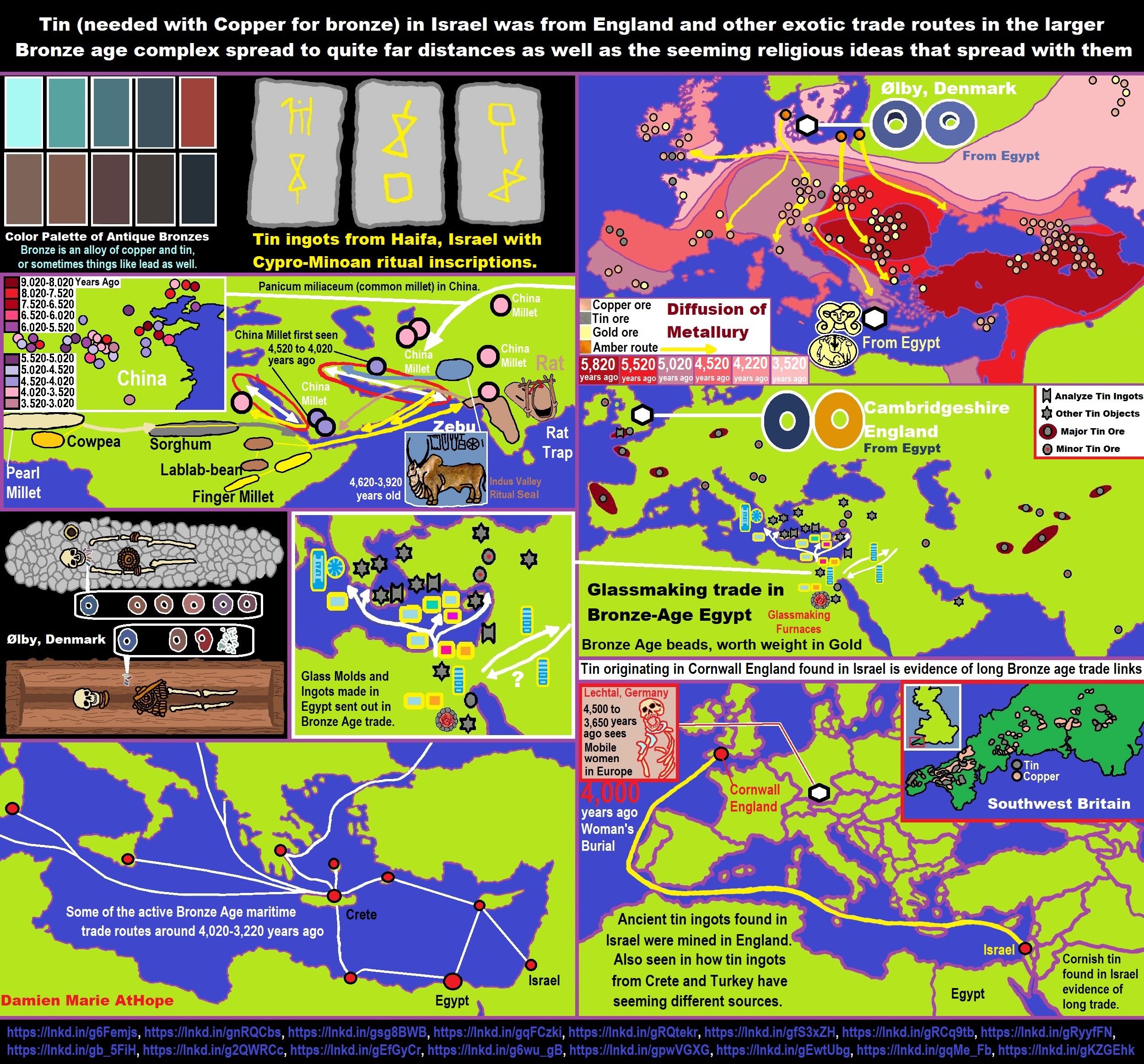
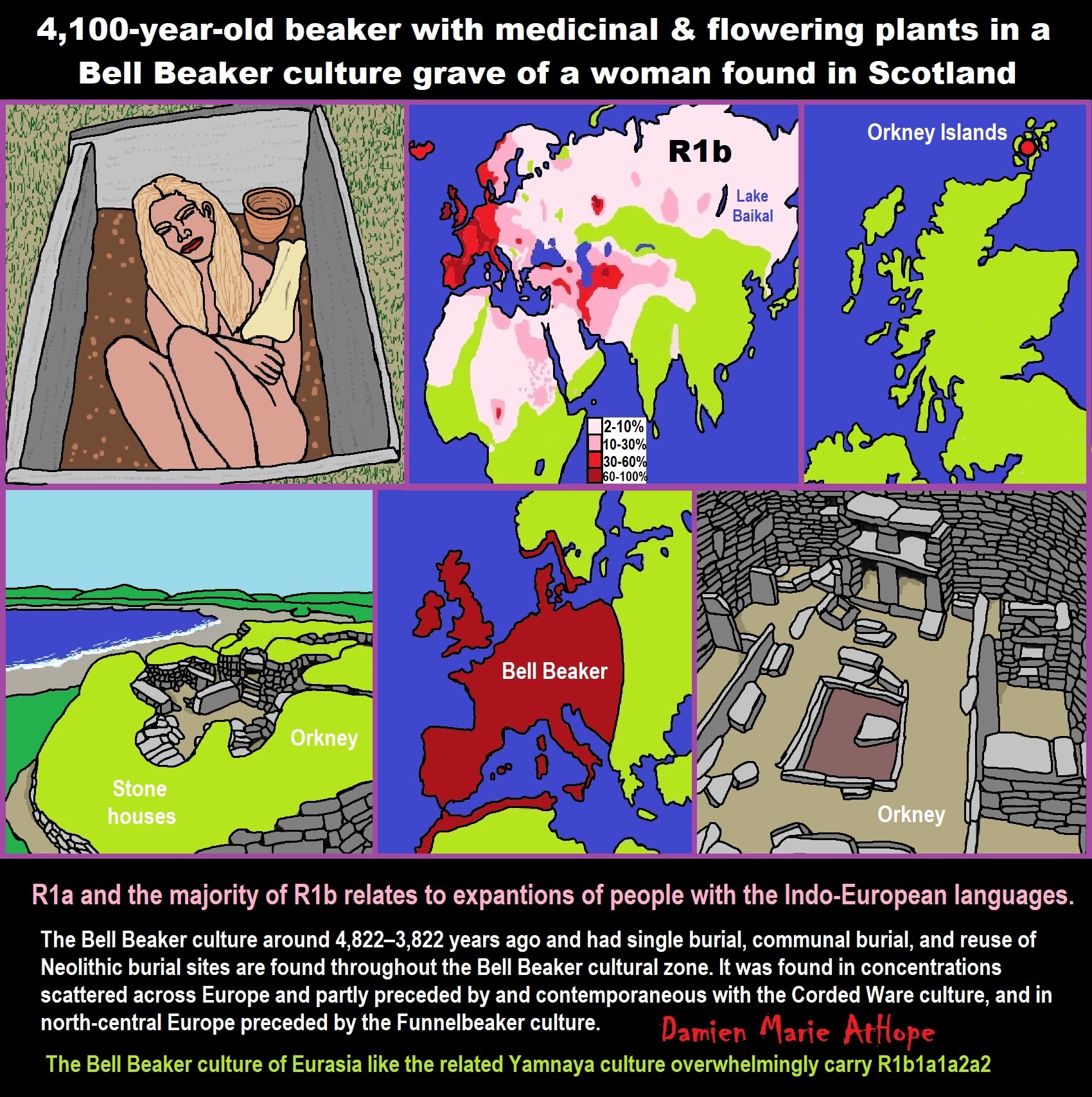

People don’t commonly teach religious history, even that of their own claimed religion. No, rather they teach a limited “pro their religion” history of their religion from a religious perspective favorable to the religion of choice.

Do you truly think “Religious Belief” is only a matter of some personal choice?
Do you not see how coercive one’s world of choice is limited to the obvious hereditary belief, in most religious choices available to the child of religious parents or caregivers? Religion is more commonly like a family, culture, society, etc. available belief that limits the belief choices of the child and that is when “Religious Belief” is not only a matter of some personal choice and when it becomes hereditary faith, not because of the quality of its alleged facts or proposed truths but because everyone else important to the child believes similarly so they do as well simply mimicking authority beliefs handed to them. Because children are raised in religion rather than being presented all possible choices but rather one limited dogmatic brand of “Religious Belief” where children only have a choice of following the belief as instructed, and then personally claim the faith hereditary belief seen in the confirming to the belief they have held themselves all their lives. This is obvious in statements asked and answered by children claiming a faith they barely understand but they do understand that their family believes “this or that” faith, so they feel obligated to believe it too. While I do agree that “Religious Belief” should only be a matter of some personal choice, it rarely is… End Hereditary Religion!

Animism: Respecting the Living World by Graham Harvey
“How have human cultures engaged with and thought about animals, plants, rocks, clouds, and other elements in their natural surroundings? Do animals and other natural objects have a spirit or soul? What is their relationship to humans? In this new study, Graham Harvey explores current and past animistic beliefs and practices of Native Americans, Maori, Aboriginal Australians, and eco-pagans. He considers the varieties of animism found in these cultures as well as their shared desire to live respectfully within larger natural communities. Drawing on his extensive casework, Harvey also considers the linguistic, performative, ecological, and activist implications of these different animisms.” ref

We are like believing machines we vacuum up ideas, like Velcro sticks to almost everything. We accumulate beliefs that we allow to negatively influence our lives, often without realizing it. Our willingness must be to alter skewed beliefs that impend our balance or reason, which allows us to achieve new positive thinking and accurate outcomes.

My thoughts on Religion Evolution with external links for more info:
- (Pre-Animism Africa mainly, but also Europe, and Asia at least 300,000 years ago), (Pre-Animism – Oxford Dictionaries)
- (Animism Africa around 100,000 years ago), (Animism – Britannica.com)
- (Totemism Europe around 50,000 years ago), (Totemism – Anthropology)
- (Shamanism Siberia around 30,000 years ago), (Shamanism – Britannica.com)
- (Paganism Turkey around 12,000 years ago), (Paganism – BBC Religion)
- (Progressed Organized Religion “Institutional Religion” Egypt around 5,000 years ago), (Ancient Egyptian Religion – Britannica.com)
- (CURRENT “World” RELIGIONS after 4,000 years ago) (Origin of Major Religions – Sacred Texts)
- (Early Atheistic Doubting at least by 2,600 years ago) (History of Atheism – Wikipedia)
“Religion is an Evolved Product” and Yes, Religion is Like Fear Given Wings…
Atheists talk about gods and religions for the same reason doctors talk about cancer, they are looking for a cure, or a firefighter talks about fires because they burn people and they care to stop them. We atheists too often feel a need to help the victims of mental slavery, held in the bondage that is the false beliefs of gods and the conspiracy theories of reality found in religions.
Understanding Religion Evolution:
- Pre-Animism (at least 300,000 years ago)
- Animism (Africa: 100,000 years ago)
- Totemism (Europe: 50,000 years ago)
- Shamanism (Siberia: 30,000 years ago)
- Paganism (Turkey: 12,000 years ago)
- Progressed organized religion (Egypt: 5,000 years ago), (Egypt, the First Dynasty 5,150 years ago)
- CURRENT “World” RELIGIONS (after 4,000 years ago)
- Early Atheistic Doubting (at least by 2,600 years ago)
“An Archaeological/Anthropological Understanding of Religion Evolution”
It seems ancient peoples had to survived amazing threats in a “dangerous universe (by superstition perceived as good and evil),” and human “immorality or imperfection of the soul” which was thought to affect the still living, leading to ancestor worship. This ancestor worship presumably led to the belief in supernatural beings, and then some of these were turned into the belief in gods. This feeble myth called gods were just a human conceived “made from nothing into something over and over, changing, again and again, taking on more as they evolve, all the while they are thought to be special,” but it is just supernatural animistic spirit-belief perceived as sacred.
Quick Evolution of Religion?
Pre-Animism (at least 300,000 years ago) pre-religion is a beginning that evolves into later Animism. So, Religion as we think of it, to me, all starts in a general way with Animism (Africa: 100,000 years ago) (theoretical belief in supernatural powers/spirits), then this is physically expressed in or with Totemism (Europe: 50,000 years ago) (theoretical belief in mythical relationship with powers/spirits through a totem item), which then enlists a full-time specific person to do this worship and believed interacting Shamanism (Siberia/Russia: 30,000 years ago) (theoretical belief in access and influence with spirits through ritual), and then there is the further employment of myths and gods added to all the above giving you Paganism (Turkey: 12,000 years ago) (often a lot more nature-based than most current top world religions, thus hinting to their close link to more ancient religious thinking it stems from). My hypothesis is expressed with an explanation of the building of a theatrical house (modern religions development). Progressed organized religion (Egypt: 5,000 years ago) with CURRENT “World” RELIGIONS (after 4,000 years ago).
Historically, in large city-state societies (such as Egypt or Iraq) starting around 5,000 years ago culminated to make religion something kind of new, a sociocultural-governmental-religious monarchy, where all or at least many of the people of such large city-state societies seem familiar with and committed to the existence of “religion” as the integrated life identity package of control dynamics with a fixed closed magical doctrine, but this juggernaut integrated religion identity package of Dogmatic-Propaganda certainly did not exist or if developed to an extent it was highly limited in most smaller prehistoric societies as they seem to lack most of the strong control dynamics with a fixed closed magical doctrine (magical beliefs could be at times be added or removed). Many people just want to see developed religious dynamics everywhere even if it is not. Instead, all that is found is largely fragments until the domestication of religion.
Religions, as we think of them today, are a new fad, even if they go back to around 6,000 years in the timeline of human existence, this amounts to almost nothing when seen in the long slow evolution of religion at least around 70,000 years ago with one of the oldest ritual worship. Stone Snake of South Africa: “first human worship” 70,000 years ago. This message of how religion and gods among them are clearly a man-made thing that was developed slowly as it was invented and then implemented peace by peace discrediting them all. Which seems to be a simple point some are just not grasping how devastating to any claims of truth when we can see the lie clearly in the archeological sites.
I wish people fought as hard for the actual values as they fight for the group/clan names political or otherwise they think support values. Every amount spent on war is theft to children in need of food or the homeless kept from shelter.
Here are several of my blog posts on history:
- To Find Truth You Must First Look
- (Magdalenian/Iberomaurusian) Connections to the First Paganists of the early Neolithic Near East Dating from around 17,000 to 12,000 Years Ago
- Natufians: an Ancient People at the Origins of Agriculture and Sedentary Life
- Possible Clan Leader/Special “MALE” Ancestor Totem Poles At Least 13,500 years ago?
- Jewish People with DNA at least 13,200 years old, Judaism, and the Origins of Some of its Ideas
- Baltic Reindeer Hunters: Swiderian, Lyngby, Ahrensburgian, and Krasnosillya cultures 12,020 to 11,020 years ago are evidence of powerful migratory waves during the last 13,000 years and a genetic link to Saami and the Finno-Ugric peoples.
- The Rise of Inequality: patriarchy and state hierarchy inequality
- Fertile Crescent 12,500 – 9,500 Years Ago: fertility and death cult belief system?
- 12,400 – 11,700 Years Ago – Kortik Tepe (Turkey) Pre/early-Agriculture Cultic Ritualism
- Ritualistic Bird Symbolism at Gobekli Tepe and its “Ancestor Cult”
- Male-Homosexual (female-like) / Trans-woman (female) Seated Figurine from Gobekli Tepe
- Could a 12,000-year-old Bull Geoglyph at Göbekli Tepe relate to older Bull and Female Art 25,000 years ago and Later Goddess and the Bull cults like Catal Huyuk?
- Sedentism and the Creation of goddesses around 12,000 years ago as well as male gods after 7,000 years ago.
- Alcohol, where Agriculture and Religion Become one? Such as Gobekli Tepe’s Ritualistic use of Grain as Food and Ritual Drink
- Neolithic Ritual Sites with T-Pillars and other Cultic Pillars
- Paganism: Goddesses around 12,000 years ago then Male Gods after 7,000 years ago
- First Patriarchy: Split of Women’s Status around 12,000 years ago & First Hierarchy: fall of Women’s Status around 5,000 years ago.
- Natufians: an Ancient People at the Origins of Agriculture and Sedentary Life
- J DNA and the Spread of Agricultural Religion (paganism)
- Paganism: an approximately 12,000-year-old belief system
- Paganism 12,000 years old: related to “Anarchism and Socialism” (Pre-Capitalism)
- Shaman burial in Israel 12,000 years ago and the Shamanism Phenomena
- Need to Mythicized: gods and goddesses
- 12,000 – 7,000 Years Ago – Paleo-Indian Culture (The Americas)
- 12,000 – 2,000 Years Ago – Indigenous-Scandinavians (Nordic)
- Norse did not wear helmets with horns?
- Pre-Pottery Neolithic Skull Cult around 11,500 to 8,400 Years Ago?
- 10,400 – 10,100 Years Ago, in Turkey the Nevail Cori Religious Settlement
- 9,000-6,500 Years Old Submerged Pre-Pottery/Pottery Neolithic Ritual Settlements off Israel’s Coast
- Catal Huyuk “first religious designed city” around 9,500 to 7,700 years ago (Turkey)
- Cultic Hunting at Catal Huyuk “first religious designed city”
- Special Items and Art as well as Special Elite Burials at Catal Huyuk
- New Rituals and Violence with the appearance of Pottery and People?
- Haplogroup N and its related Uralic Languages and Cultures
- Ainu people, Sámi people, Native Americans, the Ancient North Eurasians, and Paganistic-Shamanism with Totemism
- Ideas, Technology and People from Turkey, Europe, to China and Back again 9,000 to 5,000 years ago?
- First Pottery of Europe and the Related Cultures
- 9,000 years old Neolithic Artifacts Judean Desert and Hills Israel
- 9,000-7,000 years-old Sex and Death Rituals: Cult Sites in Israel, Jordan, and the Sinai
- 9,000-8500 year old Horned Female shaman Bad Dürrenberg Germany
- Neolithic Jewelry and the Spread of Farming in Europe Emerging out of West Turkey
- 8,600-year-old Tortoise Shells in Neolithic graves in central China have Early Writing and Shamanism
- Swing of the Mace: the rise of Elite, Forced Authority, and Inequality begin to Emerge 8,500 years ago?
- Migrations and Changing Europeans Beginning around 8,000 Years Ago
- My “Steppe-Anatolian-Kurgan hypothesis” 8,000/7,000 years ago
- Around 8,000-year-old Shared Idea of the Mistress of Animals, “Ritual” Motif
- Pre-Columbian Red-Paint (red ochre) Maritime Archaic Culture 8,000-3,000 years ago
- 7,522-6,522 years ago Linear Pottery culture which I think relates to Arcane Capitalism’s origins
- Arcane Capitalism: Primitive socialism, Primitive capital, Private ownership, Means of production, Market capitalism, Class discrimination, and Petite bourgeoisie (smaller capitalists)
- 7,500-4,750 years old Ritualistic Cucuteni-Trypillian culture of Moldova, Romania, and Ukraine
- Roots of a changing early society 7,200-6,700 years ago Jordan and Israel
- Agriculture religion (Paganism) with farming reached Britain between about 7,000 to 6,500 or so years ago and seemingly expressed in things like Western Europe’s Long Barrows
- My Thoughts on Possible Migrations of “R” DNA and Proto-Indo-European?
- “Millet” Spreading from China 7,022 years ago to Europe and related Language may have Spread with it leading to Proto-Indo-European
- Proto-Indo-European (PIE), ancestor of Indo-European languages: DNA, Society, Language, and Mythology
- The Dnieper–Donets culture and Asian varieties of Millet from China to the Black Sea region of Europe by 7,022 years ago
- Kurgan 6,000 years ago/dolmens 7,000 years ago: funeral, ritual, and other?
- 7,020 to 6,020-year-old Proto-Indo-European Homeland of Urheimat or proposed home of their Language and Religion
- Ancient Megaliths: Kurgan, Ziggurat, Pyramid, Menhir, Trilithon, Dolman, Kromlech, and Kromlech of Trilithons
- The Mytheme of Ancient North Eurasian Sacred-Dog belief and similar motifs are found in Indo-European, Native American, and Siberian comparative mythology
- Elite Power Accumulation: Ancient Trade, Tokens, Writing, Wealth, Merchants, and Priest-Kings
- Sacred Mounds, Mountains, Kurgans, and Pyramids may hold deep connections?
- Between 7,000-5,000 Years ago, rise of unequal hierarchy elite, leading to a “birth of the State” or worship of power, strong new sexism, oppression of non-elites, and the fall of Women’s equal status
- Paganism 7,000-5,000 years old: related to “Anarchism and Socialism” (Capitalism) (World War 0) Elite & their slaves
- Hell and Underworld mythologies starting maybe as far back as 7,000 to 5,000 years ago with the Proto-Indo-Europeans?
- The First Expression of the Male God around 7,000 years ago?
- White (light complexion skin) Bigotry and Sexism started 7,000 years ago?
- Around 7,000-year-old Shared Idea of the Divine Bird (Tutelary and/or Trickster spirit/deity), “Ritual” Motif
- Nekhbet an Ancient Egyptian Vulture Goddess and Tutelary Deity
- 6,720 to 4,920 years old Ritualistic Hongshan Culture of Inner Mongolia with 5,000-year-old Pyramid Mounds and Temples
- First proto-king in the Balkans, Varna culture around 6,500 years ago?
- 6,500–5,800 years ago in Israel Late Chalcolithic (Copper Age) Period in the Southern Levant Seems to Express Northern Levant Migrations, Cultural and Religious Transfer
- KING OF BEASTS: Master of Animals “Ritual” Motif, around 6,000 years old or older…
- Around 6000-year-old Shared Idea of the Solid Wheel & the Spoked Wheel-Shaped Ritual Motif
- “The Ghassulian Star,” a mysterious 6,000-year-old mural from Jordan; a Proto-Star of Ishtar, Star of Inanna or Star of Venus?
- Religious/Ritual Ideas, including goddesses and gods as well as ritual mounds or pyramids from Northeastern Asia at least 6,000 years old, seemingly filtering to Iran, Iraq, the Mediterranean, Europe, Egypt, and the Americas?
- Maykop (5,720–5,020 years ago) Caucasus region Bronze Age culture-related to Copper Age farmers from the south, influenced by the Ubaid period and Leyla-Tepe culture, as well as influencing the Kura-Araxes culture
- 5-600-year-old Tomb, Mummy, and First Bearded Male Figurine in a Grave
- Kura-Araxes Cultural 5,520 to 4,470 years old DNA traces to the Canaanites, Arabs, and Jews
- Minoan/Cretan (Keftiu) Civilization and Religion around 5,520 to 3,120 years ago
- Evolution Of Science at least by 5,500 years ago
- 5,500 Years old birth of the State, the rise of Hierarchy, and the fall of Women’s status
- “Jiroft culture” 5,100 – 4,200 years ago and the History of Iran
- Stonehenge: Paganistic Burial and Astrological Ritual Complex, England (5,100-3,600 years ago)
- Around 5,000-year-old Shared Idea of the “Tree of Life” Ritual Motif
- Complex rituals for elite, seen from China to Egypt, at least by 5,000 years ago
- Around 5,000 years ago: “Birth of the State” where Religion gets Military Power and Influence
- The Center of the World “Axis Mundi” and/or “Sacred Mountains” Mythology Could Relate to the Altai Mountains, Heart of the Steppe
- Progressed organized religion starts, an approximately 5,000-year-old belief system
- China’s Civilization between 5,000-3,000 years ago, was a time of war and class struggle, violent transition from free clans to a Slave or Elite society
- Origin of Logics is Naturalistic Observation at least by around 5,000 years ago.
- Paganism 5,000 years old: progressed organized religion and the state: related to “Anarchism and Socialism” (Kings and the Rise of the State)
- Ziggurats (multi-platform temples: 4,900 years old) to Pyramids (multi-platform tombs: 4,700 years old)
- Did a 4,520–4,420-year-old Volcano In Turkey Inspire the Bible God?
- Finland’s Horned Shaman and Pre-Horned-God at least 4,500 years ago?
- 4,000-year-Old Dolmens in Israel: A Connected Dolmen Religious Phenomenon?
- Creation myths: From chaos, Ex nihilo, Earth-diver, Emergence, World egg, and World parent
- Bronze Age “Ritual” connections of the Bell Beaker culture with the Corded Ware/Single Grave culture, which were related to the Yamnaya culture and Proto-Indo-European Languages/Religions
- Low Gods (Earth/ Tutelary deity), High Gods (Sky/Supreme deity), and Moralistic Gods (Deity enforcement/divine order)
- The exchange of people, ideas, and material-culture including, to me, the new god (Sky Father) and goddess (Earth Mother) religion between the Cucuteni-Trypillians and others which is then spread far and wide
- Koryaks: Indigenous People of the Russian Far East and Big Raven myths also found in Tlingit, Haida, Tsimshian, and other Indigenous People of North America
- 42 Principles Of Maat (Egyptian Goddess of the justice) around 4,400 years ago, 2000 Years Before Ten Commandments
- “Happy Easter” Well Happy Eostre/Ishter
- 4,320-3,820 years old “Shimao” (North China) site with Totemistic-Shamanistic Paganism and a Stepped Pyramid
- 4,250 to 3,400 Year old Stonehenge from Russia: Arkaim?
- 4,100-year-old beaker with medicinal & flowering plants in a grave of a woman in Scotland
- Early European Farmer ancestry, Kelif el Boroud people with the Cardial Ware culture, and the Bell Beaker culture Paganists too, spread into North Africa, then to the Canary Islands off West Africa
- Flood Accounts: Gilgamesh epic (4,100 years ago) Noah in Genesis (2,600 years ago)
- Paganism 4,000 years old: related to “Anarchism and Socialism” (First Moralistic gods, then the Origin time of Monotheism)
- When was the beginning: TIMELINE OF CURRENT RELIGIONS, which start around 4,000 years ago.
- Early Religions Thought to Express Proto-Monotheistic Systems around 4,000 years ago
- Kultepe? An archaeological site with a 4,000 years old women’s rights document.
- Single God Religions (Monotheism) = “Man-o-theism” started around 4,000 years ago with the Great Sky Spirit/God Tiān (天)?
- Confucianism’s Tiān (Shangdi god 4,000 years old): Supernaturalism, Pantheism or Theism?
- Yes, Your Male God is Ridiculous
- Mythology, a Lunar Deity is a Goddess or God of the Moon
- Sacred Land, Hills, and Mountains: Sami Mythology (Paganistic Shamanism)
- Horse Worship/Sacrifice: mythical union of Ruling Elite/Kingship and the Horse
- The Amorite/Amurru people’s God Amurru “Lord of the Steppe”, relates to the Origins of the Bible God?
- Bronze Age Exotic Trade Routes Spread Quite Far as well as Spread Religious Ideas with Them
- Sami and the Northern Indigenous Peoples Landscape, Language, and its Connection to Religion
- Prototype of Ancient Analemmatic Sundials around 3,900-3,150 years ago and a Possible Solar Connection to gods?
- Judaism is around 3,450 or 3,250 years old. (“Paleo-Hebrew” 3,000 years ago and Torah 2,500 years ago)
- The Weakening of Ancient Trade and the Strengthening of Religions around 3000 years ago?
- Are you aware that there are religions that worship women gods, explain now religion tears women down?
- Animistic, Totemistic, and Paganistic Superstition Origins of bible god and the bible’s Religion.
- Myths and Folklore: “Trickster gods and goddesses”
- Jews, Judaism, and the Origins of Some of its Ideas
- An Old Branch of Religion Still Giving Fruit: Sacred Trees
- Dating the BIBLE: naming names and telling times (written less than 3,000 years ago, provable to 2,200 years ago)
- Did a Volcano Inspire the bible god?
- The Amorite/Amurru people’s God Amurru “Lord of the Steppe”, relates to the Origins of the Bible God?
- Dené–Yeniseian language, Old Copper Complex, and Pre-Columbian Mound Builders?
- No “dinosaurs and humans didn’t exist together just because some think they are in the bible itself”
- Sacred Shit and Sacred Animals?
- Everyone Killed in the Bible Flood? “Nephilim” (giants)?
- Hey, Damien dude, I have a question for you regarding “the bible” Exodus.
- Archaeology Disproves the Bible
- Bible Battle, Just More, Bible Babble
- The Jericho Conquest lie?
- Canaanites and Israelites?
- Accurate Account on how did Christianity Began?
- Let’s talk about Christianity.
- So the 10 commandments isn’t anything to go by either right?
- Misinformed christian
- Debunking Jesus?
- Paulism vs Jesus
- Ok, you seem confused so let’s talk about Buddhism.
- Unacknowledged Buddhism: Gods, Savior, Demons, Rebirth, Heavens, Hells, and Terrorism
- His Foolishness The Dalai Lama
- Yin and Yang is sexist with an ORIGIN around 2,300 years ago?
- I Believe Archaeology, not Myths & Why Not, as the Religious Myths Already Violate Reason!
- Archaeological, Scientific, & Philosophic evidence shows the god myth is man-made nonsense.
- Aquatic Ape Theory/Hypothesis? As Always, Just Pseudoscience.
- Ancient Aliens Conspiracy Theorists are Pseudohistorians
- The Pseudohistoric and Pseudoscientific claims about “Bakoni Ruins” of South Africa
- Why do people think Religion is much more than supernaturalism and superstitionism?
- Religion is an Evolved Product
- Was the Value of Ancient Women Different?
- 1000 to 1100 CE, human sacrifice Cahokia Mounds a pre-Columbian Native American site
- Feminist atheists as far back as the 1800s?
- Promoting Religion as Real is Mentally Harmful to a Flourishing Humanity
- Screw All Religions and Their Toxic lies, they are all fraud
- Forget Religions’ Unfounded Myths, I Have Substantiated “Archaeology Facts.”
- Religion Dispersal throughout the World
- I Hate Religion Just as I Hate all Pseudoscience
- Exposing Scientology, Eckankar, Wicca and Other Nonsense?
- Main deity or religious belief systems
- Quit Trying to Invent Your God From the Scraps of Science.
- Archaeological, Scientific, & Philosophic evidence shows the god myth is man-made nonsense.
- Ancient Alien Conspiracy Theorists: Misunderstanding, Rhetoric, Misinformation, Fabrications, and Lies
- Misinformation, Distortion, and Pseudoscience in Talking with a Christian Creationist
- Judging the Lack of Goodness in Gods, Even the Norse God Odin
- Challenging the Belief in God-like Aliens and Gods in General
- A Challenge to Christian use of Torture Devices?
- Yes, Hinduism is a Religion
- Trump is One of the Most Reactionary Forces of Far-right Christian Extremism
- Was the Bull Head a Symbol of God? Yes!
- Primate Death Rituals
- Christian – “God and Christianity are objectively true”
- Australopithecus afarensis Death Ritual?
- You Claim Global Warming is a Hoax?
- Doubter of Science and Defamer of Atheists?
- I think that sounds like the Bible?
- History of the Antifa (“anti-fascist”) Movements
- Indianapolis Anti-Blasphemy Laws #Free Soheil Rally
- Damien, you repeat the golden rule in so many forms then you say religion is dogmatic?
- Science is a Trustable Methodology whereas Faith is not Trustable at all!
- Was I ever a believer, before I was an atheist?
- Atheists rise in reason
- Mistrust of science?
- Open to Talking About the Definition of ‘God’? But first, we address Faith.
- ‘United Monarchy’ full of splendor and power – Saul, David, and Solomon? Most likely not.
- Is there EXODUS ARCHAEOLOGY? The short answer is “no.”
- Lacking Proof of Bigfoots, Unicorns, and Gods is Just a Lack of Research?
- Religion and Politics: Faith Beliefs vs. Rational Thinking
- Hammer of Truth that lying pig RELIGION: challenged by an archaeologist
- “The Hammer of Truth” -ontology question- What do You Mean by That?
- Navigation of a bad argument: Ad Hominem vs. Attack
- Why is it Often Claimed that Gods have a Gender?
- Why are basically all monotheistic religions ones that have a male god?
- Shifting through the Claims in support of Faith
- Dear Mr. AtHope, The 20th Century is an Indictment of Secularism and a Failed Atheist Century
- An Understanding of the Worldwide Statistics and Dynamics of Terrorist Incidents and Suicide Attacks
- Intoxication and Evolution? Addressing and Assessing the “Stoned Ape” or “Drunken Monkey” Theories as Catalysts in Human Evolution
- Sacred Menstrual cloth? Inanna’s knot, Isis knot, and maybe Ma’at’s feather?
- Damien, why don’t the Hebrews accept the bible stories?
- Dealing with a Troll and Arguing Over Word Meaning
- Knowledge without Belief? Justified beliefs or disbeliefs worthy of Knowledge?
- Afrocentrism and African Religions
- Crecganford @crecganford offers history & stories of the people, places, gods, & culture
- Empiricism-Denier?
I am not an academic. I am a revolutionary that teaches in public, in places like social media, and in the streets. I am not a leader by some title given but from my commanding leadership style of simply to start teaching everywhere to everyone, all manner of positive education.



To me, Animism starts in Southern Africa, then to West Europe, and becomes Totemism. Another split goes near the Russia and Siberia border becoming Shamanism, which heads into Central Europe meeting up with Totemism, which also had moved there, mixing the two which then heads to Lake Baikal in Siberia. From there this Shamanism-Totemism heads to Turkey where it becomes Paganism.


Not all “Religions” or “Religious Persuasions” have a god(s) but
All can be said to believe in some imaginary beings or imaginary things like spirits, afterlives, etc.

Paganism 12,000-4,000 years old
12,000-7,000 years old: related to (Pre-Capitalism)
7,000-5,000 years old: related to (Capitalism) (World War 0) Elite and their slaves!
5,000 years old: related to (Kings and the Rise of the State)
4,000 years old: related to (First Moralistic gods, then the Origin time of Monotheism)

ref, ref, ref, ref, ref, ref, ref, ref, ref, ref, ref, ref, ref, ref, ref, ref, ref, ref, ref, ref, ref
Low Gods “Earth” or Tutelary deity and High Gods “Sky” or Supreme deity
“An Earth goddess is a deification of the Earth. Earth goddesses are often associated with the “chthonic” deities of the underworld. Ki and Ninhursag are Mesopotamian earth goddesses. In Greek mythology, the Earth is personified as Gaia, corresponding to Roman Terra, Indic Prithvi/Bhūmi, etc. traced to an “Earth Mother” complementary to the “Sky Father” in Proto-Indo-European religion. Egyptian mythology exceptionally has a sky goddess and an Earth god.” ref
“A mother goddess is a goddess who represents or is a personification of nature, motherhood, fertility, creation, destruction or who embodies the bounty of the Earth. When equated with the Earth or the natural world, such goddesses are sometimes referred to as Mother Earth or as the Earth Mother. In some religious traditions or movements, Heavenly Mother (also referred to as Mother in Heaven or Sky Mother) is the wife or feminine counterpart of the Sky father or God the Father.” ref
“Any masculine sky god is often also king of the gods, taking the position of patriarch within a pantheon. Such king gods are collectively categorized as “sky father” deities, with a polarity between sky and earth often being expressed by pairing a “sky father” god with an “earth mother” goddess (pairings of a sky mother with an earth father are less frequent). A main sky goddess is often the queen of the gods and may be an air/sky goddess in her own right, though she usually has other functions as well with “sky” not being her main. In antiquity, several sky goddesses in ancient Egypt, Mesopotamia, and the Near East were called Queen of Heaven. Neopagans often apply it with impunity to sky goddesses from other regions who were never associated with the term historically. The sky often has important religious significance. Many religions, both polytheistic and monotheistic, have deities associated with the sky.” ref
“In comparative mythology, sky father is a term for a recurring concept in polytheistic religions of a sky god who is addressed as a “father”, often the father of a pantheon and is often either a reigning or former King of the Gods. The concept of “sky father” may also be taken to include Sun gods with similar characteristics, such as Ra. The concept is complementary to an “earth mother“. “Sky Father” is a direct translation of the Vedic Dyaus Pita, etymologically descended from the same Proto-Indo-European deity name as the Greek Zeûs Pater and Roman Jupiter and Germanic Týr, Tir or Tiwaz, all of which are reflexes of the same Proto-Indo-European deity’s name, *Dyēus Ph₂tḗr. While there are numerous parallels adduced from outside of Indo-European mythology, there are exceptions (e.g. In Egyptian mythology, Nut is the sky mother and Geb is the earth father).” ref
Tutelary deity
“A tutelary (also tutelar) is a deity or spirit who is a guardian, patron, or protector of a particular place, geographic feature, person, lineage, nation, culture, or occupation. The etymology of “tutelary” expresses the concept of safety and thus of guardianship. In late Greek and Roman religion, one type of tutelary deity, the genius, functions as the personal deity or daimon of an individual from birth to death. Another form of personal tutelary spirit is the familiar spirit of European folklore.” ref
“A tutelary (also tutelar) in Korean shamanism, jangseung and sotdae were placed at the edge of villages to frighten off demons. They were also worshiped as deities. Seonangshin is the patron deity of the village in Korean tradition and was believed to embody the Seonangdang. In Philippine animism, Diwata or Lambana are deities or spirits that inhabit sacred places like mountains and mounds and serve as guardians. Such as: Maria Makiling is the deity who guards Mt. Makiling and Maria Cacao and Maria Sinukuan. In Shinto, the spirits, or kami, which give life to human bodies come from nature and return to it after death. Ancestors are therefore themselves tutelaries to be worshiped. And similarly, Native American beliefs such as Tonás, tutelary animal spirit among the Zapotec and Totems, familial or clan spirits among the Ojibwe, can be animals.” ref
“A tutelary (also tutelar) in Austronesian beliefs such as: Atua (gods and spirits of the Polynesian peoples such as the Māori or the Hawaiians), Hanitu (Bunun of Taiwan‘s term for spirit), Hyang (Kawi, Sundanese, Javanese, and Balinese Supreme Being, in ancient Java and Bali mythology and this spiritual entity, can be either divine or ancestral), Kaitiaki (New Zealand Māori term used for the concept of guardianship, for the sky, the sea, and the land), Kawas (mythology) (divided into 6 groups: gods, ancestors, souls of the living, spirits of living things, spirits of lifeless objects, and ghosts), Tiki (Māori mythology, Tiki is the first man created by either Tūmatauenga or Tāne and represents deified ancestors found in most Polynesian cultures). ” ref, ref, ref, ref, ref, ref, ref
Mesopotamian Tutelary Deities can be seen as ones related to City-States
“Historical city-states included Sumerian cities such as Uruk and Ur; Ancient Egyptian city-states, such as Thebes and Memphis; the Phoenician cities (such as Tyre and Sidon); the five Philistine city-states; the Berber city-states of the Garamantes; the city-states of ancient Greece (the poleis such as Athens, Sparta, Thebes, and Corinth); the Roman Republic (which grew from a city-state into a vast empire); the Italian city-states from the Middle Ages to the early modern period, such as Florence, Siena, Ferrara, Milan (which as they grew in power began to dominate neighboring cities) and Genoa and Venice, which became powerful thalassocracies; the Mayan and other cultures of pre-Columbian Mesoamerica (including cities such as Chichen Itza, Tikal, Copán and Monte Albán); the central Asian cities along the Silk Road; the city-states of the Swahili coast; Ragusa; states of the medieval Russian lands such as Novgorod and Pskov; and many others.” ref
“The Uruk period (ca. 4000 to 3100 BCE; also known as Protoliterate period) of Mesopotamia, named after the Sumerian city of Uruk, this period saw the emergence of urban life in Mesopotamia and the Sumerian civilization. City-States like Uruk and others had a patron tutelary City Deity along with a Priest-King.” ref
“Chinese folk religion, both past, and present, includes myriad tutelary deities. Exceptional individuals, highly cultivated sages, and prominent ancestors can be deified and honored after death. Lord Guan is the patron of military personnel and police, while Mazu is the patron of fishermen and sailors. Such as Tu Di Gong (Earth Deity) is the tutelary deity of a locality, and each individual locality has its own Earth Deity and Cheng Huang Gong (City God) is the guardian deity of an individual city, worshipped by local officials and locals since imperial times.” ref
“A tutelary (also tutelar) in Hinduism, personal tutelary deities are known as ishta-devata, while family tutelary deities are known as Kuladevata. Gramadevata are guardian deities of villages. Devas can also be seen as tutelary. Shiva is the patron of yogis and renunciants. City goddesses include: Mumbadevi (Mumbai), Sachchika (Osian); Kuladevis include: Ambika (Porwad), and Mahalakshmi. In NorthEast India Meitei mythology and religion (Sanamahism) of Manipur, there are various types of tutelary deities, among which Lam Lais are the most predominant ones. Tibetan Buddhism has Yidam as a tutelary deity. Dakini is the patron of those who seek knowledge.” ref
“A tutelary (also tutelar) The Greeks also thought deities guarded specific places: for instance, Athena was the patron goddess of the city of Athens. Socrates spoke of hearing the voice of his personal spirit or daimonion:
You have often heard me speak of an oracle or sign which comes to me … . This sign I have had ever since I was a child. The sign is a voice which comes to me and always forbids me to do something which I am going to do, but never commands me to do anything, and this is what stands in the way of my being a politician.” ref
“Tutelary deities who guard and preserve a place or a person are fundamental to ancient Roman religion. The tutelary deity of a man was his Genius, that of a woman her Juno. In the Imperial era, the Genius of the Emperor was a focus of Imperial cult. An emperor might also adopt a major deity as his personal patron or tutelary, as Augustus did Apollo. Precedents for claiming the personal protection of a deity were established in the Republican era, when for instance the Roman dictator Sulla advertised the goddess Victory as his tutelary by holding public games (ludi) in her honor.” ref
“Each town or city had one or more tutelary deities, whose protection was considered particularly vital in time of war and siege. Rome itself was protected by a goddess whose name was to be kept ritually secret on pain of death (for a supposed case, see Quintus Valerius Soranus). The Capitoline Triad of Juno, Jupiter, and Minerva were also tutelaries of Rome. The Italic towns had their own tutelary deities. Juno often had this function, as at the Latin town of Lanuvium and the Etruscan city of Veii, and was often housed in an especially grand temple on the arx (citadel) or other prominent or central location. The tutelary deity of Praeneste was Fortuna, whose oracle was renowned.” ref
“The Roman ritual of evocatio was premised on the belief that a town could be made vulnerable to military defeat if the power of its tutelary deity were diverted outside the city, perhaps by the offer of superior cult at Rome. The depiction of some goddesses such as the Magna Mater (Great Mother, or Cybele) as “tower-crowned” represents their capacity to preserve the city. A town in the provinces might adopt a deity from within the Roman religious sphere to serve as its guardian, or syncretize its own tutelary with such; for instance, a community within the civitas of the Remi in Gaul adopted Apollo as its tutelary, and at the capital of the Remi (present-day Rheims), the tutelary was Mars Camulus.” ref
Household deity (a kind of or related to a Tutelary deity)
“A household deity is a deity or spirit that protects the home, looking after the entire household or certain key members. It has been a common belief in paganism as well as in folklore across many parts of the world. Household deities fit into two types; firstly, a specific deity – typically a goddess – often referred to as a hearth goddess or domestic goddess who is associated with the home and hearth, such as the ancient Greek Hestia.” ref
“The second type of household deities are those that are not one singular deity, but a type, or species of animistic deity, who usually have lesser powers than major deities. This type was common in the religions of antiquity, such as the Lares of ancient Roman religion, the Gashin of Korean shamanism, and Cofgodas of Anglo-Saxon paganism. These survived Christianisation as fairy-like creatures existing in folklore, such as the Anglo-Scottish Brownie and Slavic Domovoy.” ref
“Household deities were usually worshipped not in temples but in the home, where they would be represented by small idols (such as the teraphim of the Bible, often translated as “household gods” in Genesis 31:19 for example), amulets, paintings, or reliefs. They could also be found on domestic objects, such as cosmetic articles in the case of Tawaret. The more prosperous houses might have a small shrine to the household god(s); the lararium served this purpose in the case of the Romans. The gods would be treated as members of the family and invited to join in meals, or be given offerings of food and drink.” ref
“In many religions, both ancient and modern, a god would preside over the home. Certain species, or types, of household deities, existed. An example of this was the Roman Lares. Many European cultures retained house spirits into the modern period. Some examples of these include:
- Brownie (Scotland and England) or Hob (England) / Kobold (Germany) / Goblin / Hobgoblin
- Domovoy (Slavic)
- Nisse (Norwegian or Danish) / Tomte (Swedish) / Tonttu (Finnish)
- Húsvættir (Norse)” ref
“Although the cosmic status of household deities was not as lofty as that of the Twelve Olympians or the Aesir, they were also jealous of their dignity and also had to be appeased with shrines and offerings, however humble. Because of their immediacy they had arguably more influence on the day-to-day affairs of men than the remote gods did. Vestiges of their worship persisted long after Christianity and other major religions extirpated nearly every trace of the major pagan pantheons. Elements of the practice can be seen even today, with Christian accretions, where statues to various saints (such as St. Francis) protect gardens and grottos. Even the gargoyles found on older churches, could be viewed as guardians partitioning a sacred space.” ref
“For centuries, Christianity fought a mop-up war against these lingering minor pagan deities, but they proved tenacious. For example, Martin Luther‘s Tischreden have numerous – quite serious – references to dealing with kobolds. Eventually, rationalism and the Industrial Revolution threatened to erase most of these minor deities, until the advent of romantic nationalism rehabilitated them and embellished them into objects of literary curiosity in the 19th century. Since the 20th century this literature has been mined for characters for role-playing games, video games, and other fantasy personae, not infrequently invested with invented traits and hierarchies somewhat different from their mythological and folkloric roots.” ref
“In contradistinction to both Herbert Spencer and Edward Burnett Tylor, who defended theories of animistic origins of ancestor worship, Émile Durkheim saw its origin in totemism. In reality, this distinction is somewhat academic, since totemism may be regarded as a particularized manifestation of animism, and something of a synthesis of the two positions was attempted by Sigmund Freud. In Freud’s Totem and Taboo, both totem and taboo are outward expressions or manifestations of the same psychological tendency, a concept which is complementary to, or which rather reconciles, the apparent conflict. Freud preferred to emphasize the psychoanalytic implications of the reification of metaphysical forces, but with particular emphasis on its familial nature. This emphasis underscores, rather than weakens, the ancestral component.” ref
“William Edward Hearn, a noted classicist, and jurist, traced the origin of domestic deities from the earliest stages as an expression of animism, a belief system thought to have existed also in the neolithic, and the forerunner of Indo-European religion. In his analysis of the Indo-European household, in Chapter II “The House Spirit”, Section 1, he states:
The belief which guided the conduct of our forefathers was … the spirit rule of dead ancestors.” ref
“In Section 2 he proceeds to elaborate:
It is thus certain that the worship of deceased ancestors is a vera causa, and not a mere hypothesis. …
In the other European nations, the Slavs, the Teutons, and the Kelts, the House Spirit appears with no less distinctness. … [T]he existence of that worship does not admit of doubt. … The House Spirits had a multitude of other names which it is needless here to enumerate, but all of which are more or less expressive of their friendly relations with man. … In [England] … [h]e is the Brownie. … In Scotland this same Brownie is well known. He is usually described as attached to particular families, with whom he has been known to reside for centuries, threshing the corn, cleaning the house, and performing similar household tasks. His favorite gratification was milk and honey.” ref



ref, ref, ref, ref, ref, ref, ref, ref, ref, ref, ref, ref, ref, ref, ref, ref, ref
“These ideas are my speculations from the evidence.”
I am still researching the “god‘s origins” all over the world. So you know, it is very complicated but I am smart and willing to look, DEEP, if necessary, which going very deep does seem to be needed here, when trying to actually understand the evolution of gods and goddesses. I am sure of a few things and less sure of others, but even in stuff I am not fully grasping I still am slowly figuring it out, to explain it to others. But as I research more I am understanding things a little better, though I am still working on understanding it all or something close and thus always figuring out more.
Sky Father/Sky God?
“Egyptian: (Nut) Sky Mother and (Geb) Earth Father” (Egypt is different but similar)
Turkic/Mongolic: (Tengri/Tenger Etseg) Sky Father and (Eje/Gazar Eej) Earth Mother *Transeurasian*
Hawaiian: (Wākea) Sky Father and (Papahānaumoku) Earth Mother *Austronesian*
New Zealand/ Māori: (Ranginui) Sky Father and (Papatūānuku) Earth Mother *Austronesian*
Proto-Indo-European: (Dyḗus/Dyḗus ph₂tḗr) Sky Father and (Dʰéǵʰōm/Pleth₂wih₁) Earth Mother
Indo-Aryan: (Dyaus Pita) Sky Father and (Prithvi Mata) Earth Mother *Indo-European*
Italic: (Jupiter) Sky Father and (Juno) Sky Mother *Indo-European*
Etruscan: (Tinia) Sky Father and (Uni) Sky Mother *Tyrsenian/Italy Pre–Indo-European*
Hellenic/Greek: (Zeus) Sky Father and (Hera) Sky Mother who started as an “Earth Goddess” *Indo-European*
Nordic: (Dagr) Sky Father and (Nótt) Sky Mother *Indo-European*
Slavic: (Perun) Sky Father and (Mokosh) Earth Mother *Indo-European*
Illyrian: (Deipaturos) Sky Father and (Messapic Damatura’s “earth-mother” maybe) Earth Mother *Indo-European*
Albanian: (Zojz) Sky Father and (?) *Indo-European*
Baltic: (Perkūnas) Sky Father and (Saulė) Sky Mother *Indo-European*
Germanic: (Týr) Sky Father and (?) *Indo-European*
Colombian-Muisca: (Bochica) Sky Father and (Huythaca) Sky Mother *Chibchan*
Aztec: (Quetzalcoatl) Sky Father and (Xochiquetzal) Sky Mother *Uto-Aztecan*
Incan: (Viracocha) Sky Father and (Mama Runtucaya) Sky Mother *Quechuan*
China: (Tian/Shangdi) Sky Father and (Dì) Earth Mother *Sino-Tibetan*
Sumerian, Assyrian and Babylonian: (An/Anu) Sky Father and (Ki) Earth Mother
Finnish: (Ukko) Sky Father and (Akka) Earth Mother *Finno-Ugric*
Sami: (Horagalles) Sky Father and (Ravdna) Earth Mother *Finno-Ugric*
Puebloan-Zuni: (Ápoyan Ta’chu) Sky Father and (Áwitelin Tsíta) Earth Mother
Puebloan-Hopi: (Tawa) Sky Father and (Kokyangwuti/Spider Woman/Grandmother) Earth Mother *Uto-Aztecan*
Puebloan-Navajo: (Tsohanoai) Sky Father and (Estsanatlehi) Earth Mother *Na-Dene*
ref, ref, ref, ref, ref, ref, ref, ref, ref, ref, ref, ref, ref, ref, ref, ref, ref, ref, ref, ref, ref, ref, ref, ref, ref, ref, ref

Hinduism around 3,700 to 3,500 years old. ref
Judaism around 3,450 or 3,250 years old. (The first writing in the bible was “Paleo-Hebrew” dated to around 3,000 years ago Khirbet Qeiyafa is the site of an ancient fortress city overlooking the Elah Valley. And many believe the religious Jewish texts were completed around 2,500) ref, ref
Judaism is around 3,450 or 3,250 years old. (“Paleo-Hebrew” 3,000 years ago and Torah 2,500 years ago)
“Judaism is an Abrahamic, its roots as an organized religion in the Middle East during the Bronze Age. Some scholars argue that modern Judaism evolved from Yahwism, the religion of ancient Israel and Judah, by the late 6th century BCE, and is thus considered to be one of the oldest monotheistic religions.” ref
“Yahwism is the name given by modern scholars to the religion of ancient Israel, essentially polytheistic, with a plethora of gods and goddesses. Heading the pantheon was Yahweh, the national god of the Israelite kingdoms of Israel and Judah, with his consort, the goddess Asherah; below them were second-tier gods and goddesses such as Baal, Shamash, Yarikh, Mot, and Astarte, all of whom had their own priests and prophets and numbered royalty among their devotees, and a third and fourth tier of minor divine beings, including the mal’ak, the messengers of the higher gods, who in later times became the angels of Judaism, Christianity and Islam. Yahweh, however, was not the ‘original’ god of Israel “Isra-El”; it is El, the head of the Canaanite pantheon, whose name forms the basis of the name “Israel”, and none of the Old Testament patriarchs, the tribes of Israel, the Judges, or the earliest monarchs, have a Yahwistic theophoric name (i.e., one incorporating the name of Yahweh).” ref
“El is a Northwest Semitic word meaning “god” or “deity“, or referring (as a proper name) to any one of multiple major ancient Near Eastern deities. A rarer form, ‘ila, represents the predicate form in Old Akkadian and in Amorite. The word is derived from the Proto-Semitic *ʔil-, meaning “god”. Specific deities known as ‘El or ‘Il include the supreme god of the ancient Canaanite religion and the supreme god of East Semitic speakers in Mesopotamia’s Early Dynastic Period. ʼĒl is listed at the head of many pantheons. In some Canaanite and Ugaritic sources, ʼĒl played a role as father of the gods, of creation, or both. For example, in the Ugaritic texts, ʾil mlk is understood to mean “ʼĒl the King” but ʾil hd as “the god Hadad“. The Semitic root ʾlh (Arabic ʾilāh, Aramaic ʾAlāh, ʾElāh, Hebrew ʾelōah) may be ʾl with a parasitic h, and ʾl may be an abbreviated form of ʾlh. In Ugaritic the plural form meaning “gods” is ʾilhm, equivalent to Hebrew ʾelōhîm “powers”. In the Hebrew texts this word is interpreted as being semantically singular for “god” by biblical commentators. However the documentary hypothesis for the Old Testament (corresponds to the Jewish Torah) developed originally in the 1870s, identifies these that different authors – the Jahwist, Elohist, Deuteronomist, and the Priestly source – were responsible for editing stories from a polytheistic religion into those of a monotheistic religion. Inconsistencies that arise between monotheism and polytheism in the texts are reflective of this hypothesis.” ref
Jainism around 2,599 – 2,527 years old. ref
Confucianism around 2,600 – 2,551 years old. ref
Buddhism around 2,563/2,480 – 2,483/2,400 years old. ref
Christianity around 2,o00 years old. ref
Shinto around 1,305 years old. ref
Islam around 1407–1385 years old. ref

Knowledge to Ponder:
Stars/Astrology:
- Possibly, around 30,000 years ago (in simpler form) to 6,000 years ago, Stars/Astrology are connected to Ancestors, Spirit Animals, and Deities.
- The star also seems to be a possible proto-star for Star of Ishtar, Star of Inanna, or Star of Venus.
- Around 7,000 to 6,000 years ago, Star Constellations/Astrology have connections to the “Kurgan phenomenon” of below-ground “mound” stone/wood burial structures and “Dolmen phenomenon” of above-ground stone burial structures.
- Around 6,500–5,800 years ago, The Northern Levant migrations into Jordon and Israel in the Southern Levant brought new cultural and religious transfer from Turkey and Iran.
- “The Ghassulian Star,” a mysterious 6,000-year-old mural from Jordan may have connections to the European paganstic kurgan/dolmens phenomenon.
“Astrology is a range of divinatory practices, recognized as pseudoscientific since the 18th century, that claim to discern information about human affairs and terrestrial events by studying the apparent positions of celestial objects. Different cultures have employed forms of astrology since at least the 2nd millennium BCE, these practices having originated in calendrical systems used to predict seasonal shifts and to interpret celestial cycles as signs of divine communications. Most, if not all, cultures have attached importance to what they observed in the sky, and some—such as the Hindus, Chinese, and the Maya—developed elaborate systems for predicting terrestrial events from celestial observations. Western astrology, one of the oldest astrological systems still in use, can trace its roots to 19th–17th century BCE Mesopotamia, from where it spread to Ancient Greece, Rome, the Islamicate world and eventually Central and Western Europe. Contemporary Western astrology is often associated with systems of horoscopes that purport to explain aspects of a person’s personality and predict significant events in their lives based on the positions of celestial objects; the majority of professional astrologers rely on such systems.” ref
Around 5,500 years ago, Science evolves, The first evidence of science was 5,500 years ago and was demonstrated by a body of empirical, theoretical, and practical knowledge about the natural world. ref
Around 5,000 years ago, Origin of Logics is a Naturalistic Observation (principles of valid reasoning, inference, & demonstration) ref
Around 4,150 to 4,000 years ago: The earliest surviving versions of the Sumerian Epic of Gilgamesh, which was originally titled “He who Saw the Deep” (Sha naqba īmuru) or “Surpassing All Other Kings” (Shūtur eli sharrī) were written. ref
Hinduism:
- 3,700 years ago or so, the oldest of the Hindu Vedas (scriptures), the Rig Veda was composed.
- 3,500 years ago or so, the Vedic Age began in India after the collapse of the Indus Valley Civilization.
Judaism:
- around 3,000 years ago, the first writing in the bible was “Paleo-Hebrew”
- around 2,500 years ago, many believe the religious Jewish texts were completed
Myths: The bible inspired religion is not just one religion or one myth but a grouping of several religions and myths
- Around 3,450 or 3,250 years ago, according to legend, is the traditionally accepted period in which the Israelite lawgiver, Moses, provided the Ten Commandments.
- Around 2,500 to 2,400 years ago, a collection of ancient religious writings by the Israelites based primarily upon the Hebrew Bible, Tanakh, or Old Testament is the first part of Christianity’s bible.
- Around 2,400 years ago, the most accepted hypothesis is that the canon was formed in stages, first the Pentateuch (Torah).
- Around 2,140 to 2,116 years ago, the Prophets was written during the Hasmonean dynasty, and finally the remaining books.
- Christians traditionally divide the Old Testament into four sections:
- The first five books or Pentateuch (Torah).
- The proposed history books telling the history of the Israelites from their conquest of Canaan to their defeat and exile in Babylon.
- The poetic and proposed “Wisdom books” dealing, in various forms, with questions of good and evil in the world.
- The books of the biblical prophets, warning of the consequences of turning away from God:
- Henotheism:
- Exodus 20:23 “You shall not make other gods besides Me (not saying there are no other gods just not to worship them); gods of silver or gods of gold, you shall not make for yourselves.”
- Polytheism:
- Judges 10:6 “Then the sons of Israel again did evil in the sight of the LORD, served the Baals and the Ashtaroth, the gods of Aram, the gods of Sidon, the gods of Moab, the gods of the sons of Ammon, and the gods of the Philistines; thus they forsook the LORD and did not serve Him.”
- 1 Corinthians 8:5 “For even if there are so-called gods whether in heaven or on earth, as indeed there are many gods and many lords.”
- Monotheism:
- Isaiah 43:10 “You are my witnesses,” declares the LORD, “and my servant whom I have chosen, so that you may know and believe me and understand that I am he. Before me no god was formed, nor will there be one after me.
Around 2,570 to 2,270 Years Ago, there is a confirmation of atheistic doubting as well as atheistic thinking, mainly by Greek philosophers. However, doubting gods is likely as old as the invention of gods and should destroy the thinking that belief in god(s) is the “default belief”. The Greek word is apistos (a “not” and pistos “faithful,”), thus not faithful or faithless because one is unpersuaded and unconvinced by a god(s) claim. Short Definition: unbelieving, unbeliever, or unbelief.

Expressions of Atheistic Thinking:
- Around 2,600 years ago, Ajita Kesakambali, ancient Indian philosopher, who is the first known proponent of Indian materialism. ref
- Around 2,535 to 2,475 years ago, Heraclitus, Greek pre-Socratic philosopher, a native of the Greek city Ephesus, Ionia, on the coast of Anatolia, also known as Asia Minor or modern Turkey. ref
- Around 2,500 to 2,400 years ago, according to The Story of Civilization book series certain African pygmy tribes have no identifiable gods, spirits, or religious beliefs or rituals, and even what burials accrue are without ceremony. ref
- Around 2,490 to 2,430 years ago, Empedocles, Greek pre-Socratic philosopher and a citizen of Agrigentum, a Greek city in Sicily. ref
- Around 2,460 to 2,370 years ago, Democritus, Greek pre-Socratic philosopher considered to be the “father of modern science” possibly had some disbelief amounting to atheism. ref
- Around 2,399 years ago or so, Socrates, a famous Greek philosopher was tried for sinfulness by teaching doubt of state gods. ref
- Around 2,341 to 2,270 years ago, Epicurus, a Greek philosopher known for composing atheistic critics and famously stated, “Is God willing to prevent evil, but not able? Then he is not omnipotent. Is he able, but not willing? Then he is malevolent. Is he both able and willing? Then whence cometh evil? Is he neither able nor willing? Then why call him god?” ref
This last expression by Epicurus, seems to be an expression of Axiological Atheism. To understand and utilize value or actually possess “Value Conscious/Consciousness” to both give a strong moral “axiological” argument (the problem of evil) as well as use it to fortify humanism and positive ethical persuasion of human helping and care responsibilities. Because value-blindness gives rise to sociopathic/psychopathic evil.

“Theists, there has to be a god, as something can not come from nothing.”
Well, thus something (unknown) happened and then there was something. This does not tell us what the something that may have been involved with something coming from nothing. A supposed first cause, thus something (unknown) happened and then there was something is not an open invitation to claim it as known, neither is it justified to call or label such an unknown as anything, especially an unsubstantiated magical thinking belief born of mythology and religious storytelling.


While hallucinogens are associated with shamanism, it is alcohol that is associated with paganism.
The Atheist-Humanist-Leftist Revolutionaries Shows in the prehistory series:
Show two: Pre-animism 300,000 years old and animism 100,000 years old: related to “Anarchism and Socialism”
Show tree: Totemism 50,000 years old: related to “Anarchism and Socialism”
Show four: Shamanism 30,000 years old: related to “Anarchism and Socialism”
Show five: Paganism 12,000 years old: related to “Anarchism and Socialism”
Show six: Emergence of hierarchy, sexism, slavery, and the new male god dominance: Paganism 7,000-5,000 years old: related to “Anarchism and Socialism” (Capitalism) (World War 0) Elite and their slaves!
Prehistory: related to “Anarchism and Socialism” the division of labor, power, rights, and recourses: VIDEO
Pre-animism 300,000 years old and animism 100,000 years old: related to “Anarchism and Socialism”: VIDEO
Totemism 50,000 years old: related to “Anarchism and Socialism”: VIDEO
Shamanism 30,000 years old: related to “Anarchism and Socialism”: VIDEO
Paganism 12,000 years old: related to “Anarchism and Socialism” (Pre-Capitalism): VIDEO
Paganism 7,000-5,000 years old: related to “Anarchism and Socialism” (Capitalism) (World War 0) Elite and their slaves: VIEDO
Paganism 5,000 years old: progressed organized religion and the state: related to “Anarchism and Socialism” (Kings and the Rise of the State): VIEDO
Paganism 4,000 years old: related to “Anarchism and Socialism” (First Moralistic gods, then the Origin time of Monotheism): VIEDO
I do not hate simply because I challenge and expose myths or lies any more than others being thought of as loving simply because of the protection and hiding from challenge their favored myths or lies.
The truth is best championed in the sunlight of challenge.
An archaeologist once said to me “Damien religion and culture are very different”
My response, So are you saying that was always that way, such as would you say Native Americans’ cultures are separate from their religions? And do you think it always was the way you believe?
I had said that religion was a cultural product. That is still how I see it and there are other archaeologists that think close to me as well. Gods too are the myths of cultures that did not understand science or the world around them, seeing magic/supernatural everywhere.
I personally think there is a goddess and not enough evidence to support a male god at Çatalhöyük but if there was both a male and female god and goddess then I know the kind of gods they were like Proto-Indo-European mythology.
This series idea was addressed in, Anarchist Teaching as Free Public Education or Free Education in the Public: VIDEO
Our 12 video series: Organized Oppression: Mesopotamian State Force and the Politics of power (9,000-4,000 years ago), is adapted from: The Complete and Concise History of the Sumerians and Early Bronze Age Mesopotamia (7000-2000 BC): https://www.youtube.com/watch?v=szFjxmY7jQA by “History with Cy“
Show #1: Mesopotamian State Force and the Politics of Power (Samarra, Halaf, Ubaid)
Show #2: Mesopotamian State Force and the Politics of Power (Eridu “Tell Abu Shahrain”)
Show #3: Mesopotamian State Force and the Politics of Power (Uruk and the First Cities)
Show #4: Mesopotamian State Force and the Politics of Power (First Kings)
Show #5: Mesopotamian State Force and the Politics of Power (Early Dynastic Period)
Show #6: Mesopotamian State Force and the Politics of Power (King/Ruler Lugalzagesi)
Show #7: Mesopotamian State Force and the Politics of Power (Sargon and Akkadian Rule)
Show #9: Mesopotamian State Force and the Politics of Power (Gudea of Lagash and Utu-hegal)
Show #12: Mesopotamian State Force and the Politics of Power (Aftermath and Legacy of Sumer)

The “Atheist-Humanist-Leftist Revolutionaries”
Cory Johnston ☭ Ⓐ Atheist Leftist @Skepticallefty & I (Damien Marie AtHope) @AthopeMarie (my YouTube & related blog) are working jointly in atheist, antitheist, antireligionist, antifascist, anarchist, socialist, and humanist endeavors in our videos together, generally, every other Saturday.
Why Does Power Bring Responsibility?
Think, how often is it the powerless that start wars, oppress others, or commit genocide? So, I guess the question is to us all, to ask, how can power not carry responsibility in a humanity concept? I know I see the deep ethical responsibility that if there is power their must be a humanistic responsibility of ethical and empathic stewardship of that power. Will I be brave enough to be kind? Will I possess enough courage to be compassionate? Will my valor reach its height of empathy? I as everyone, earns our justified respect by our actions, that are good, ethical, just, protecting, and kind. Do I have enough self-respect to put my love for humanity’s flushing, over being brought down by some of its bad actors? May we all be the ones doing good actions in the world, to help human flourishing.
I create the world I want to live in, striving for flourishing. Which is not a place but a positive potential involvement and promotion; a life of humanist goal precision. To master oneself, also means mastering positive prosocial behaviors needed for human flourishing. I may have lost a god myth as an atheist, but I am happy to tell you, my friend, it is exactly because of that, leaving the mental terrorizer, god belief, that I truly regained my connected ethical as well as kind humanity.
Cory and I will talk about prehistory and theism, addressing the relevance to atheism, anarchism, and socialism.
At the same time as the rise of the male god, 7,000 years ago, there was also the very time there was the rise of violence, war, and clans to kingdoms, then empires, then states. It is all connected back to 7,000 years ago, and it moved across the world.
Cory Johnston: https://damienmarieathope.com/2021/04/cory-johnston-mind-of-a-skeptical-leftist/?v=32aec8db952d
The Mind of a Skeptical Leftist (YouTube)
Cory Johnston: Mind of a Skeptical Leftist @Skepticallefty
The Mind of a Skeptical Leftist By Cory Johnston: “Promoting critical thinking, social justice, and left-wing politics by covering current events and talking to a variety of people. Cory Johnston has been thoughtfully talking to people and attempting to promote critical thinking, social justice, and left-wing politics.” http://anchor.fm/skepticalleft
Cory needs our support. We rise by helping each other.
Cory Johnston ☭ Ⓐ @Skepticallefty Evidence-based atheist leftist (he/him) Producer, host, and co-host of 4 podcasts @skeptarchy @skpoliticspod and @AthopeMarie
Damien Marie AtHope (“At Hope”) Axiological Atheist, Anti-theist, Anti-religionist, Secular Humanist. Rationalist, Writer, Artist, Poet, Philosopher, Advocate, Activist, Psychology, and Armchair Archaeology/Anthropology/Historian.
Damien is interested in: Freedom, Liberty, Justice, Equality, Ethics, Humanism, Science, Atheism, Antiteism, Antireligionism, Ignosticism, Left-Libertarianism, Anarchism, Socialism, Mutualism, Axiology, Metaphysics, LGBTQI, Philosophy, Advocacy, Activism, Mental Health, Psychology, Archaeology, Social Work, Sexual Rights, Marriage Rights, Woman’s Rights, Gender Rights, Child Rights, Secular Rights, Race Equality, Ageism/Disability Equality, Etc. And a far-leftist, “Anarcho-Humanist.”
I am not a good fit in the atheist movement that is mostly pro-capitalist, I am anti-capitalist. Mostly pro-skeptic, I am a rationalist not valuing skepticism. Mostly pro-agnostic, I am anti-agnostic. Mostly limited to anti-Abrahamic religions, I am an anti-religionist.
To me, the “male god” seems to have either emerged or become prominent around 7,000 years ago, whereas the now favored monotheism “male god” is more like 4,000 years ago or so. To me, the “female goddess” seems to have either emerged or become prominent around 11,000-10,000 years ago or so, losing the majority of its once prominence around 2,000 years ago due largely to the now favored monotheism “male god” that grow in prominence after 4,000 years ago or so.
My Thought on the Evolution of Gods?
Animal protector deities from old totems/spirit animal beliefs come first to me, 13,000/12,000 years ago, then women as deities 11,000/10,000 years ago, then male gods around 7,000/8,000 years ago. Moralistic gods around 5,000/4,000 years ago, and monotheistic gods around 4,000/3,000 years ago.
To me, animal gods were likely first related to totemism animals around 13,000 to 12,000 years ago or older. Female as goddesses was next to me, 11,000 to 10,000 years ago or so with the emergence of agriculture. Then male gods come about 8,000 to 7,000 years ago with clan wars. Many monotheism-themed religions started in henotheism, emerging out of polytheism/paganism.

Damien Marie AtHope (Said as “At” “Hope”)/(Autodidact Polymath but not good at math):
Axiological Atheist, Anti-theist, Anti-religionist, Secular Humanist, Rationalist, Writer, Artist, Jeweler, Poet, “autodidact” Philosopher, schooled in Psychology, and “autodidact” Armchair Archaeology/Anthropology/Pre-Historian (Knowledgeable in the range of: 1 million to 5,000/4,000 years ago). I am an anarchist socialist politically. Reasons for or Types of Atheism
My Website, My Blog, & Short-writing or Quotes, My YouTube, Twitter: @AthopeMarie, and My Email: damien.marie.athope@gmail.com

